Choose Trek
Customise Trek
Suggest me a trek
Rent a gear
Volunteer Program
Blogs & Articles
Discounts & Offers


Chadar Trek Frozen River
Max Altitude
Trekking KM.
26,500 /Person
- +5% GST (Goods and Services Tax)
- Hotel to Hotel
- Centrally heated room & Hot water included
Help & Support
- +91 991 772 4737
- 10:00 hrs to 18:00 hrs Monday - Saturday GMT +5:30 Sunday Closed
- [email protected]
- Cost & Cancellation Terms
- Risk & Respond
How To Reach
Trek essential, important links.
- Trail Type One way trail, The trek starts and ends at Shingra Koma.
- Rail Head No Rail Head
- Airport Leh (Kushok Bakula Rimpochee) Airport
- Base Camp Leh
- Winter Treks (Mid Nov - Mid Feb)
- Snow January & February
- Services from Hotel to Hotel
- Meals Meals while on trek (Veg + Egg)
- Stay Centrally Heated Hotel with hot water & Camping (2 in one tent)
- Region - Ladakh
- Duration - 8 Days
- Grade - Difficult
- Max Altitude - 11100 Ft.
- Approx Trekking Km - 62 Kms.
WHY IS IT A MUST-DO TREK?
The Chadar Frozen Trek , located in the northernmost part of India in the region of Ladakh, is one of the worlds most iconic and challenging treks. The trek takes adventurers on an extraordinary journey along the frozen Zanskar River offering a unique opportunity to explore the starkly beautiful and remote landscapes of Ladakh, complete with breathtaking ice formations and an incredible cultural experience.
The Chadar Trek takes place in the Zanskar region of Ladakh, India. The trek begins near the village of Chilling and extends through the frozen Zanskar River. The Chadar Frozen Trek occurs during the coldest months of the year, typically from January to February when the Zanskar River freezes over. This is the only time when its possible to undertake this unique adventure. Winter temperatures in the Zanskar region can plummet well below freezing, often reaching as low as -30°C (-22°F) during the night.
For those seeking a rare and challenging experience in the Himalayas, Chadar Trek is the ultimate choice.
Frozen Landscape
The trek takes you through a surreal frozen wonderland, where the Zanskar River transforms into a solid ice sheet. Trekking on the Chadar , or frozen riverbed, is a remarkable experience.
Nerak Waterfall
Nerak Waterfall, often referred to as Nerak Waterfall Camp, is a significant milestone on the Chadar Frozen Trek . This awe-inspiring site is a cascade of frozen ice that has formed as a result of the chilling temperatures in the Zanskar region.
Tibb Cave is another remarkable feature along the Chadar Trek . It s a naturally formed overhang in the rocky cliffs along the frozen river. This natural shelter provides trekkers with a respite from the biting cold and wind, offering a place to rest, warm up, and even prepare meals.
Who can participate
- Age; 15 years.
- Experience of any high altitude trek, at least 1 treks of 4,000m/13,100ft.
- The climber must be fit and have sufficient stamina to cover 5 km of distance in 30 minutes without a stress.
- The climber should be able to carry a 12-16 kg backpack.
Health Awareness
- Pulse rate at rest must be in between (60 to 90 beats per minute)
- Blood Pressure Reading must be in between (DIASTOLIC 75 – 85, SYSTOLIC 100 - 130 mm Hg)
- Respiratory rate at rest must be in between (12 to 20 breaths per minute)
- Should not have Liver and kidney issues
- Should not have Diabetes Mellitus, Bronchial Asthma, Epilepsy, Heart problems, Hypertension etc
- No pacemaker implant
- People with the Sinus issues please contact to trek coordinator before booking the trek
- If your BMI is not normal, Please contact our Trek coordinator before Trek booking.
Government Employees {SCL}
Government Employees can avail the benefit of Special Casual Leave (SCL) when you join us for a trekking expedition. As per the rules of the Pay Commission, Special Casual Leave can be availed for up to 30 days in a calendar year for trekking/mountaineering expeditions through a registered organization. Trek The Himalayas is a registered adventure tour operator by Indian Mountaineering Foundation (IMF) and Ministry Of Tourism (MOT) Trekkers have to apply for leave at least 20 days before trek departure date.
- Junior trekkers (below 15 years) should have a company of parent/guardian.
- Trekkers between 15 to 18 years can come solo with the disclaimer form signed by parent/guardian.
- Medical & Disclaimer Form (Mandatory Documents) Click here
- Altitude: Leh 3,500m/11,450 ft.
- Keep your woolen cap and gloves handy at Airport.
- Airport pickup is not included in the cost.
- Orientation & Briefing of the trek at 12:00 noon (Mandatory).
- Check in Hotel (10:00 am | centrally heated room |attached washroom in running condition | hot water in buckets.
- Bring a copy of your ID proof and 2 photographs. Foreigner, a copy of passport and visa.
- Keep the boarding pass with you, it will be needed for permission on the third day.
- The network is available (only post-paid).
- ATM is available.
- Visiting any very high-altitude place or pass is not advisable.
- Consumption of alcohol and smoking is strictly prohibited.
- Spend the day in the room itself to acclimatize.
You will be landing at the Leh airport which is one of the most picturesque airports that you would come across. Just before touchdown time, you’ll be greeted with the entire range of snow-capped peaks that will surely get you wonderstruck. It’s important to keep your warm clothes handy as you’ll feel the sudden drop in temperature as soon as you arrive at the Leh airport. A jacket, woollen gloves, and a woollen cap are a necessity. After reaching the guesthouse you will be given enough time to relax and acclimatize to the conditions. Later in the evening, you can spend some time at the Leh market for any last-minute shopping. It is very important that you get used to the cold temperature in Leh because the temperature will only tend to fall as you start walking on the frozen Zanskar. From the end of January to mid-February, the temperature can be anything between -10 to -15 degrees during the day. It is also important to keep your body hydrated by increasing the intake of fluids that will help to maintain your body temperature.
- Rest + Acclimatization day
- Sightseeing included in the cost ( Hall of Fame, Shey Monastery, Thiskesy Monastery )
- A visit to any very high-altitude place or pass is not advisable
- Consumption of alcohol and smoking is strictly prohibited
- Stay in hotel | centrally heated room | attached washroom in running condition | hot water in buckets
Keeping in mind the health problems that trekkers are facing (AMS), as per the new regulations applied, anyone doing the Chadar Trek should spend at least two days in Leh to get their body fully acclimatized to the weather conditions. It is irrevocable and it is important that it is strictly followed by every trekker. You can spend the day visiting the places around the city. You can also join us while we conduct a small sightseeing session (included in the cost). It is only for 3-4 hours, covering all the major spots of Leh. It is advisable that you avoid visiting places that are at a higher altitude. Crosscheck your essentials before going to bed.
- Wake up early and get ready for medical tests | height & weight, blood pressure and oxygen level.
- Drive/Walk to the Government Medical camp.
- Get your Oxygen and BP reading (There is a long queue due to rush of tourists. It may take 3-4 hours depending on the rush).
- Late afternoon insurance formalities.
- Enjoy evening in Leh.
- Stay in Hotel | centrally heated room |attached wash room in running condition | hot water in buckets.
Today is the big day. This day decides whether you continue further or not. Wake up early and reach the Medical Camp as early as possible. Even though tests take less time, due to tourists rush it gets delayed. In the late afternoon, we shall finish insurance formalities, if any. Your test results are your green card as to whether you will do the Chadar Trek or not so, in case the tests declare you are not fit to go for the Chadar Trek , you will not be allowed. For refund policies please contact our trek coordinator.
- Altitude: Tsomo Paldar 3,200m/10,500 ft.
- Altitude: Shingra Koma 3,150m/10,300
- Breakfast at hotel included in the cost.
- Drive: Shingra Koma 75 km, 3-4 hrs.
- Trek: 3km | 2 hr.
- Gumboots are mandatory.
- Carry two thermos flask of 1 litre each.
- Hot lunch on the way.
- Stay in tents | twin sharing.
- Drive through Gurudwara Pathar Sahib (3,500m/11,500ft), Magnetic Hill (3,350m/11,000ft) and the confluence of the Zanskar and Indus (3,100m/10,200ft).
Note: Walking in gumboots will take a while, so be prepared for some slips and falls! It’s advisable to carry a small backpack which will protect your back at the time of falls.
On this day, you’ll be headed to the first campsite which is Tsomo Paldar via Chilling & Shingra Koma. Shingra Koma is one of the most unique places in Chadar for it is placed at the U bend of Zanskar, forming a wonderful place with lots of views. Today will be one of the most scenic drives which let you witness some of the top spots in Ladakh. Gurudwara Pathar Sahib, Magnetic Hill, and the confluence of the Zanskar and Indus are some of the places where you can make a pit stop for clicking pictures 3-4 hours drive along the Zanskar will get you to Shingra Koma. The car will drop you right where the road ends, this will be your starting point of walking on the Zanskar.
The layer of Chadar may seem thin here, you can also see various rock formations. Walking with gumboots on will definitely be a challenge in the initial stage. Understanding the ice patterns will take time, slowly but steadily you will know which surface is fragile and which is trustworthy. There are multiple ice surfaces that you would come across while walking on the mighty Zanskar. Planting your foot will be important in most cases, you can check for the ice for its steadiness with your walking stick before stepping on it completely. A small and light backpack will help you to manage your body weight in an effective manner. After an hour and a half of walking on the icy surface maintaining your balance you’ll be reaching your first campsite at Tsomo Paldar. This will be your first experience of camping under sub-zero temperatures.
- Altitude: 3,350m/ 10,950 ft.
- Trek 14km | 6-7hr.
- Make sure you fill your thermos with warm water before you leave.
- Pass through a waterfall which never freeze.
- It will be sunny only around 9-10 in the morning.
- Hot Lunch on the way.
- Visit small cave, in that cave the local porters rest for the night.
Chadar is one such trek where you do not gain altitude in quick succession. Slowly but gradually from Tsomo Paldar to Tibb Cave (6-7 hours), you will be gaining an altitude of 400ft. (Tsomo Paldar: 11,400 to Tibb Cave: 11,800). After spending a cold night in the tent at Tsomo Paldar get done with your breakfast that will re-energize your senses in the morning. The much-needed hot cup of tea will be special in such frosty conditions. As you start heading to the next campsite which is Tibb Cave, you’ll see some of the most eye-catching frozen waterfalls. Waterfalls that stand frozen in time. The source of some of these frozen waterfalls is still unknown and there are a lot of myths amongst the villagers. The mighty Zanskar will be flowing all along with you on the trail and the emerald green water will have a soothing effect. You will be served lunch midway to Tibb Cave. After walking for a couple of hours you’ll come across different rock patterns along the way which look like art when the sun rays fall on them making their way from behind the clouds. You will be camping near the Tibb cave which is surrounded by dry sand.
- Altitude: 3,400m/11,100 ft.
- Trek 13 km / 6-7 hrs.
- Attraction Frozen waterfall.
- Nerak is the first village of Zanskar region.
- If we reach Nerak Camp on time, we can go to Nerak village.
- Stay in tent.
As you move on to the most awaited campsite of the trek which is Nerak, the 13 km long trail will take you to the most iconic landmark of the Chadar trek . i.e. the frozen waterfall. The frozen waterfall is a nature’s masterpiece that attracts trekkers from around the world. Hot lunch will be served on your way to Nerak. By far, Nerak will be the coldest of all the campsites on the trek where the temperature goes down to as low as -30 degrees during the night. It will be important that you wear proper clothing in layers to stay safe from the biting cold. If you manage to reach the waterfall on time, there are chances of paying a visit to the Nerak Village as well. You will be camping at a distance of 15-20 minutes from the waterfall.
- Altitude 3,400m/11,100 ft to 3,350m/10,950 ft
- Trek 13 km / 5-6 hrs.
You might have heard stories of how unpredictable the weather patterns can get here on the Chadar trek . There are instances where the formation of Chadar no longer exists on your way back from Nerak. In the same way, you will witness a new layer of Chadar formed in some places. Even though it’s the same route, you’ll be amazed to see how different it appears while coming back. Chadar Trek is the experience of a lifetime that every trekking enthusiast should witness. And then, what if we told you that these eight days of your life are going to be some of the best days you’ve l ived so far and that you’ll cherish these moments till the very end.
Today retrace your steps back to Tibb Cave. You get another last chance to cherish, relive and gather the memories. Wave goodbye to all the locals while you make your way back. Be careful and enjoy your last stay in tents.
- Altitude 3,350m/10,950ft to 3,150m/10,300 ft.
- Trek to Shingra Koma 17 km/ 5-6 hours.
- Drive to Leh 70 km/ 3-4 hours.
- You will reach Leh by the evening.
- Stay in hotel (Centrally heated room) (Running hot water in taps).
Note: Distance, Altitude and Trekking hours are approximate and round off.
Again wake up early for a long walk back. It is not really retracing steps because you may observe a lot has changed. Chadar may have melted, a layer of Chadar may have gotten thin, and wonderful rocks are visible now. Well, that’s the beauty of nature and the Chadar trek. Reach Shingra Koma and get ready to board vehicles. Another bumpy ride and you will arrive in Leh.
- Pick Up Place
The only way to travel is to fly to Kushok Bakula Rimpochi Airport located in Leh. It is just 4 km away from the main city. The airport is well connected to Delhi and also receives flights from Mumbai, Srinagar, Jammu, Chandigarh and other general destinations in India. Even international travellers can fly directly from major cities like Kolkata, Mumbai and Delhi.
Travelling by both the road routes, the Manali-Leh Highway and Srinagar-Leh Highway, is not possible since they are not open in the snowy winters of Ladakh.
The Manali-Leh and Srinagar-Leh highways are generally closed by October-November
Pick up will be done according to flight timings
We will drop you at Leh Airport, Please check out early in the morning because all flights fly in the morning only.
- Cancellation Policy
Inclusion 1. Accommodation : (as per the itinerary). • Guest house (centrally heated room)(attached washroom) in Leh on Day 1, Day 2, Day 3 & Day 8 (twin sharing basis, triple in very rare cases). • Camping during the trek (Day 4 to Day 7). 2. Meals (Veg + Egg): • Day 4 breakfast to day 8 lunch. 3. Trek equipment: • Hight Quality High Altitude Sleeping bag, Mattress, Utensils. • Trekkers tent (twin sharing), Kitchen & Dinning tent, Toilet tent, Ropes. 4. First aid: • Medical kit. • Stretcher. • Oxygen cylinder. 5. Support: • 1 Mountaineering qualified & professional trek Leader. • Guide (Number of guides depending on the group size). • 1 High Altitude chef. • Support staff. 6. Transportation: (as per the itinerary) • Leh (Guest house) to trekking point (Day 4). • Trekking point to Leh (guest house) (Day 8). 7. Hot water • Hot water in buckets on Day 1, Day 2, Day 3 . • Running hot water in taps on Day 8 . 8. Leh Sightseeing is included in the cost (Hall of Fame, Shey Monastery, Thiksey Monastery). 9. Facility of keeping extra luggage at Leh when leaving for the trek. 10. Porters to carry the central luggage. 11. Services from Leh and Leh.
Exclusion: 1. Food in Leh. 2. Any kind of personal expenses. 3. Porter to carry personal luggage. 4. Pre Medical Check-up and Rescue fee, Wildlife/environmental charges, ALTOA NOC, and entry fees upto 6K to 8 K paid to the authority on the spot 5. Pickup and drop from Leh airport 6. Any kind of emergency evacuation charge, hospitalization fee or etc. 7. Any additional cost due to the final decision incurred by the Administrative 8. Insurance: It is mandatory to take high altitude risk insurance before joining this Expedition (as per the ALTOA guidelines) 9. Anything not specifically mentioned under the head.
Things can be provided on demand and availability (participant has to pay extra for these things)
1- Satellite phone/setphone - a type of mobile phone that connects via radio links via satellites orbiting the Earth instead of terrestrial cell sites like cell phones. Therefore, they can operate in most geographic locations on the Earth's surface.
2- Gamow/PAC HAPO Bag (Portable Hyperbaric Bag) - is a unique, portable hyperbaric chamber for the treatment of acute mountain sickness (AMS), also known as altitude sickness.
3- AEDs (Automated External Defibrillators) - are portable life-saving devices designed to treat people experiencing sudden cardiac arrest, a medical condition in which the heart stops beating suddenly and unexpectedly
Insurance is mandatory and can be obtained through TTH or other providers. Non-Indian rates are slightly higher, trek coordinator will share the balance payment link after booking. If you choose not to book through us, we will refund your insurance fee; email us immediately after booking for the refund.
Porter Service Charges: Normally TTH expects to carry your personal luggage on your own, if you don't want to carry your backpack so you can give it to the porter, but you have to inform us in advance and have to pay approx Rs. 5000 for the entire trip (subject to change)/- extra per bag.
The fee can be paid by online transfer/Check deposit/Cash deposit/Demand draft. Instruction for payment will be forwarded along with your confirmation email. When your transfer is done, please e-mail us a confirmation mail with your transfer details, so that we can follow up your reservation efficiently.
Cancellation terms:
For the cancellation of services due to any avoidable/unavoidable reasons, Trek The Himalayas must be notified of the same in writing at [email protected] At the time we receive your written cancellation, refunds based on the total fare are as follows.
Cancellations prior to 25 days from the start of the Trip
Refund options
- 5% deduction of trek fee
- 100% cash voucher for any trip till one year
Cancellation between 24 days and 15 days to the start of the Trip
- 30% deduction of trek fee
- 100% cash voucher for same trip till one year
- 85% cash voucher for any trip till one year
Cancellation between 14 days and 10 days to the start of the Trip
- Book the same trek, in the same season, with any other batch
- 50% deduction of trek fee
- 80% cash voucher for same trip till one year
- 70% cash voucher for any trip till one year
Cancellation less than 9 days to the start of the trek
- Transfer your trek (same trek, same batch) to your friend
- No cash refund
- 20% cash voucher for the same trip till one year
- 10% cash voucher for any trip till one year
In the unlikely event that TTH cancels a trek prior to the scheduled departure date:
While it is extremely rare for TTH to cancel a trek, we understand that unforeseen circumstances or natural disasters may occasionally require us to do so before the scheduled departure. These circumstances could include continuous rain or snow, thunderstorms, snowstorms, landslides, floods, earthquakes, or any other natural calamity that poses a risk to the safety of our trekkers. Additionally, unforeseeable events such as local riots, curfews, pandemics, lockdowns, government orders, or any similar situations that compromise the safety of the trekking experience may also necessitate a cancellation.
In the event of such a cancellation, TTH will provide you with a voucher equivalent to the amount you paid for the trek. This voucher can be redeemed for any of our treks within the next year, allowing you to still enjoy an adventure with us at a later date.
- The issuance of a voucher is not applicable in situations where you are required to descend from the trek for any reason. The trek leader may make the decision to send you down from the trek due to factors such as insufficient fitness level, symptoms of Acute Mountain Sickness (AMS), high blood pressure, exceeding the designated turn-around-time, health concerns, or if you are found smoking, drinking, or violating the rules set for the trek. In such cases, the provision of a voucher does not apply.
In the rare event that TTH shifts a trek:
We would like to emphasize that weather conditions in high-altitude areas are highly unpredictable and can undergo sudden changes at any time, irrespective of the day. Additionally, circumstances beyond our control, such as natural disasters, political unrest, pandemics, and lockdowns, may impact the feasibility of conducting a trek. In cases where we are unable to proceed with an event due to such circumstances that are beyond our direct control, we will make every effort to provide you with an alternative trek that is safer and more suitable.
In such situations, we will issue a voucher to offset the cost difference between the originally scheduled trek and the alternative trek. This voucher can be redeemed at any time within one year from the date of issue. Please note that a refund fee or reimbursement of the cost difference is not applicable in these cases.
- Change of trek batch is dependent on the availability of seats in the batch
- In case of transferring a trek to a friend, he/she should satisfy all the mandatory requirements put forward by TTH
- TTH holds the right to change/cancel the policies, without prior notice
- Cash refund is applicable only in case of bookings made without using any promotional offer code or vouchers
Cash Voucher Terms:
- This is a non-transferable voucher
- The voucher cannot be merged with any other offer of Trek The Himalayas
- The voucher is valid for Trek booked directly with Trek The Himalayas in India
- To avail the voucher please use your register phone number or e-mail id
- All the other Terms of booking a trek with Trek The Himalayas are applicable to the voucher
- Trek The Himalayas holds rights to add/remove any of the Terms and Conditions without prior notice
Itineraries are based on information available at the time of planning and are subject to change. "Trek The Himalayas" reserves the right to change expedition dates, people or itineraries as conditions warrant. If a trip must be delayed or the itinerary changed due to bad weather, road conditions, transportation delays, government intervention, airline schedules, sickness, or other contingency for which TTH or its agents cannot make provision, the cost of delays and/or other changes are the responsibility of the participant. TTH reserves the right to decline, or accept, any individual as a trip member for any reason whatsoever.
- Personal Utilities
- Medical & Disclaimer Form (Mandatory Documents) Read more
- Health Awareness for Trekking in the Himalayas Read more
- Mandatory Documents to bring on a trek Read more
Fitness regime for:
Calculate Your BMI :
Your BMI value is
Congratulations, your body is in good conditions!
- If your BMI is normal, you can plan your fitness regime as mentioned.
- If your BMI is not normal, consult your trusted physician before you plan your fitness regime.
- If you're suffering from any chronic illnesses consult a medical practitioner.

Similar Treks
Audens Col Expedition
Uttarakhand
Bali Pass Trek
Deo tibba peak expedition.
Himachal Pradesh
Dzo Jongo Peak Trek Expedition
Friendship peak expedition, everest base camp trek, kanamo peak trek expedition, kang yatse ii peak trek expedition, manali to leh (khardungla) cycling expedition, pin parvati pass trek, rudragaira peak expedition, rupin pass trek, stok kangri peak trek expedition, yunam peak trek expedition, twin peak - kang yatse ii, dzo jongo, markha valley trek, frequently asked questions.
The Chadar Frozen River Trek is a popular winter trek in the Indian state of Jammu and Kashmir. It involves walking on a frozen river, the Zanskar River, which is transformed into a thick sheet of ice during the winter months. The trek is known for its scenic beauty and challenging terrain, as well as the unique experience of walking on a frozen river.
The best time to do Chadar Frozen River Trek is during the months of January and February when the river is frozen enough to support the weight of trekkers.
Chadar Trek Frozen River is a Difficult Grade Trek.
It is an 8 days long trek.
Yes, altitude-related concerns can be a factor on the Chadar Frozen River Trek . The trek starts at an altitude of around 3,300 meters and reaches a maximum altitude of approximately 3,850 meters . While this may not be extremely high, it is still significant enough to cause altitude-related issues for some trekkers. Altitude sickness, also known as acute mountain sickness (AMS), is a common concern on the Chadar Trek . Symptoms of AMS can include headache, nausea, dizziness, and shortness of breath. Trekkers can take several precautions to avoid AMS, such as acclimatizing properly, drinking plenty of fluids, and taking necessary medications. It is also essential to be aware of frostbite and hypothermia, which can occur due to exposure to cold temperatures and wind on the trek. Trekkers should dress in layers, wear proper gear, and stay warm to prevent these conditions. Overall, while altitude-related concerns are something to keep in mind, with proper preparation and caution, many trekkers are able to successfully complete the Chadar Frozen River Trek without any significant issues.
The Chadar Frozen River Trek is a challenging winter trek that requires specialized gear to ensure the safety and comfort of trekkers in extreme cold and icy conditions. Here are some essential gear items needed for the trek: 1. quality trekking boots with sturdy soles and good traction to provide adequate grip on slippery ice. 2. Warm and waterproof clothing, including thermal layers, fleece jackets, and down jackets, to keep you warm in sub-zero temperatures. 3. Waterproof gloves or mittens and socks to keep your hands and feet dry and warm. 4. A warm hat and a balaclava or a face mask to protect your face from the cold winds. 5. Sunglasses to protect your eyes from the glare of snow and ice. 6. Trekking poles to help maintain balance and stability on the icy terrain. 7. Sleeping bags are rated for sub-zero temperatures to ensure a good night's sleep in the extreme cold. 8. Headlamp or flashlight with extra batteries to navigate in the dark. 9. First aid kit including altitude sickness medication, pain relievers, and basic medical supplies. 10. Backpack with at least 60 liters capacity to carry all your gear and supplies.
During the Chadar Trek , TTH provides all meals, including breakfast, lunch, and dinner. The meals are prepared by a team of experienced cooks, who use fresh and locally sourced ingredients to provide nutritious and tasty food to the trekkers.
While prior trekking experience is not strictly necessary for the Chadar Frozen River Trek , it is highly recommended that trekkers have some level of physical fitness and experience with hiking or trekking in challenging terrain. The trek is considered to be a moderately difficult trek, and the icy conditions can make it even more challenging. It is important to note that the Chadar Trek requires trekkers to walk on a frozen river, which can be slippery and unstable. Trekkers must also navigate through narrow gorges, steep canyons, and frozen waterfalls, which can be physically demanding. Therefore, it is recommended that trekkers engage in regular physical exercise and prepare themselves mentally and physically for the trek. Additionally, trekkers need to be prepared to face extremely cold temperatures, which can drop to as low as -25 degrees Celsius at night. Therefore, it is essential to have appropriate gear and clothing to keep warm and protect against frostbite and hypothermia.
It is recommended that trekkers engage in regular physical exercise and prepare themselves mentally and physically for the trek. Here are some specific physical fitness requirements for the Chadar Frozen River Trek: 1. Cardiovascular endurance: Trekkers need to have good cardiovascular endurance to tackle challenging terrain and high altitude. Regular cardio exercises such as running, cycling, or swimming can help improve endurance. 2. Strength training: Trekkers need to have strong leg and core muscles to maintain balance and stability on the icy terrain. Strength training exercises such as squats, lunges, and planks can help build these muscles. 3. Flexibility: Trekkers need to have good flexibility to prevent muscle strain and injuries. Regular stretching exercises such as yoga or Pilates can help improve flexibility. 4. Mental toughness: The Chadar Trek can be mentally challenging due to the extremely cold temperatures, long hours of walking, and unpredictable weather conditions. Trekkers need to be mentally prepared to face these challenges and stay motivated. It is important to note that the physical fitness requirements for the Chadar Trek can vary depending on the individual's age, health, and fitness level. It is recommended that trekkers consult with a doctor or a fitness trainer before embarking on the trek to assess their physical fitness and determine any necessary precautions or preparations.
It is highly recommended. The Chadar Trek is a challenging trek that requires specialized gear, experienced guides, and support staff to ensure the safety and well-being of trekkers. Hiring an expert trekking organization can provide many benefits, including safety, specialized gear and equipment, and logistics and support.
.png?w=auto&h=400)
Chadar Trek
Chadar trek overview.
Situated in the Leh region of Ladakh, the Chadar trek is one of the most magnificent treks in the Himalayas that allows you to cover a distance of 62 kilometers in just nine days. It is one of the most popular and longest trekking trails that provides a dream come true experience to the trekkers while hiking along the dramatic mountains. The Chadar lake trek feels like a journey to the North Pole as the temperature drops to -30 degrees Celsius, thereby grading it high on the difficulty level.
The Chadar trek Ladakh lets the trekkers walk on a thick layer of ice that covers the Zanskar river. It is not the only reason that draws thrill seekers to this fantastic attraction, but people are attracted to several other fascinating and ethereal sights. This trek brings you close to the natural wonders of the world, such as the frozen Nerak waterfall, white sand, and knee-length snow, and all these beautiful sights in your trekking experience will ignite your senses and will create a mark down your memory lane.
The landscape and the overall experience of the Chadar frozen river trek will also leave an imprint on the heart of the trekkers. So, if you are looking for a remarkable trekking experience, the Chadar trek should be on the top of your bucket list.
Book Chadar Trek Package
Quick facts of chadar trek.
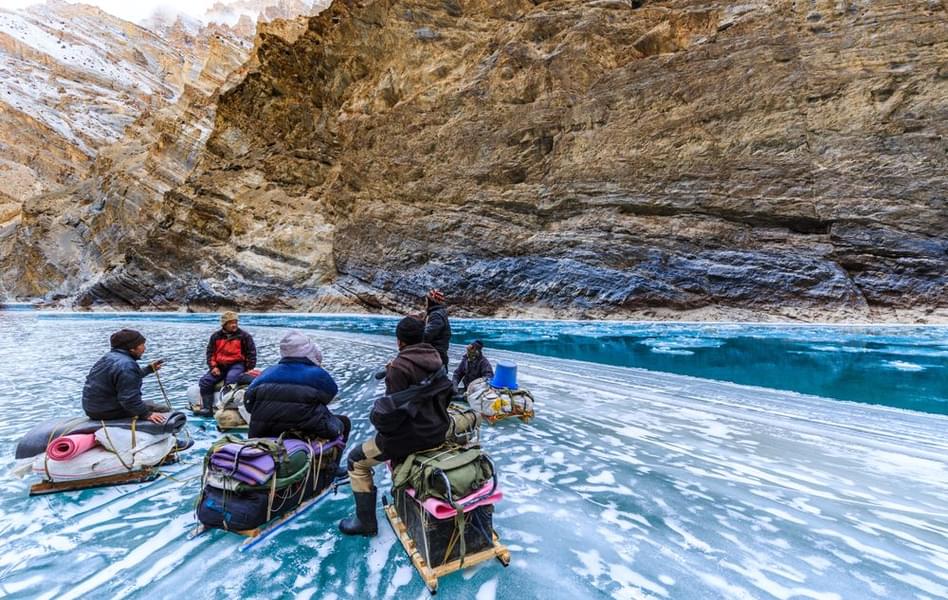
- Maximum altitude: 11150 feet
- Grade: Difficult
- Duration: Nine days
- Trekking distance: 62 kilometers
- Trail type: One-way trail. The trek commences and ends at Shingra Koma.
- Rail head: No rail head
- Airport: Kushok Bakula Rimpochee Airport (Leh)
- Snow Season: January and February
- Service from: Leh Airport to Leh Airport (Transport included)
- Base camp: Leh
- Best season: Winter season (January and February)
- Region: Ladakh
Who can Participate: - Serious trekkers who are fond of experiencing freezing temperatures.- Should have a minimum age of 15 years.- People with enough stamina to cover a distance of five kilometers in just 30 minutes.- Has an experience of at least one high-altitude trek of 5000 meters or 16400 feet.- Should have the capacity to carry a 12 to 16 kg backpack.
Why to Go for Chadar Trek?
Chadar trek is one of the best trekking experiences that you should have at least once in a lifetime. Walking on the frozen sheet of ice on the surface of the river with dramatic snow-capped mountains on either side is indeed a remarkable experience in itself. This trekking experience allows you to witness the Nerak waterfall which is completely iced from top to bottom. There is also a possibility that you may encounter exotic wildlife, like snow leopards, blue sheep, and ibex in the chilling surroundings of your trek. Thus, it is a do-before-you-die adventure that lets you witness the in-depth Zanskari cultures, jaw-dropping scenery, and bone-chilling climates.
Short Itinerary for Chadar Trek
Day 1 : The Chadar trek Ladakh starts with your arrival at Leh. Rest for the day or explore the attractions of Leh.
Day 2 : The second day of your Chadar Lake trek will be your acclimatization day when you will be adapting to the cold weather conditions of the surroundings.
Day 3 : Go to the Government Medical Camp to get all your medical tests done. Complete all your insurance formalities and other documentation work before moving forward for the Chadar winter trek.
Day 4 : It is the actual day of the Chadar trek Ladakh when you will move from Leh to Gyalpo through Chilling and then to Tilad Do.
Day 5 : On the next day, the journey included in the Chadar trek package will continue to the Tibb Cave.
Day 6 : It is an iconic day of the Chadar winter trek as you will reach Nerak from Tibb Cave, where you can witness the Frozen Waterfall that garners the interest of tourists from across the globe.
Day 7 : The seventh day included in the Chadar trek package will be a return day from Nerak to Tibb Cave.
Day 8 : Moving forward, you will return to Shingra Koma through Gyalpo and then take an adventurous ride back to Leh.
Day 9 : It is officially the last day of the Chadar Lake trek when you will be returning to your homes with tons of memories of the trek.
Chadar Trek Detailed Itinerary
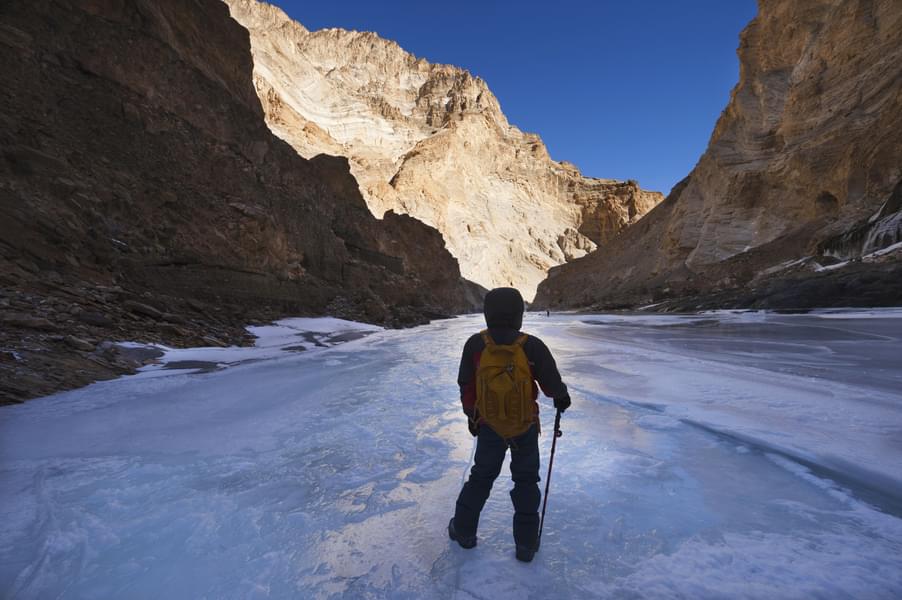
- The Chadar trek commences after you arrive at the Kushok Bakula Rimpochee Airport in Leh.
- On your way to your hotel on the outskirts of Leh, you will experience gorgeous snow-capped mountains that will definitely leave you awestruck with their striking beauty.
- It is advisable to keep your woolen caps and gloves handy as you may feel an immediate drop in temperature when you arrive at the Leh airport.
- After you reach Leh, you can rest for the day and acclimatize to the cold weather conditions.
- The weather in Leh will give you a taste of what it will be like when you go for the Chadar trek.
- In the evening time, you can go window shopping on the streets of Leh market to grab things that you would require in the trekking expedition.
- You are not allowed to start your trekking journey on the same day of your arrival because it is extremely necessary for your body to adapt to the cold weather condition as the temperature may drop even further when you start climbing towards the Zanskar River.
- Now, get back to your rooms and have a good night's sleep to revitalize your body for the trip.
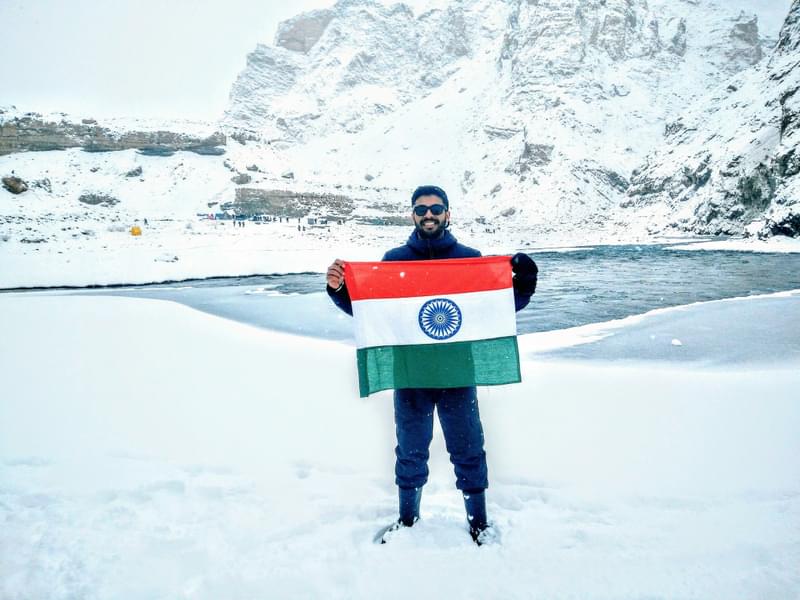
Rest and Acclimatize in Leh
- Considering the health conditions of the trekkers and according to the new regulations, trekkers who are willing to go on the Chadar trek are required to acclimatize their bodies completely to the cold weather conditions in Leh for two days.
- In order to acclimatize, you can either spend the day visiting the nearby attractions of Leh or rest in a centrally-heated room at your hotel.
- Every trekker is advisable not to go to places with higher altitudes on this day.
- The second day gets completed by packing your travel backpack with all the essentials and rest for the day.
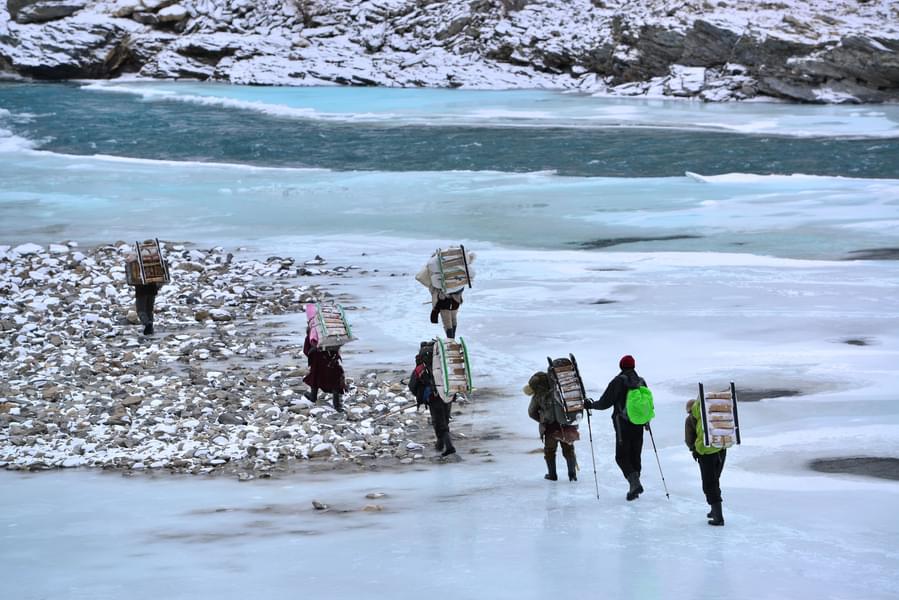
Undergo Medical Checkup in Leh
- The third day is the most significant day of the trek. This day decides whether your body is eligible for continuing the Chadar trek or not.
- For this, you need to wake up early in the morning and drive or walk to the Government Medical Camp.
- You must reach the location as early as possible because the tests get delayed due to the rush of tourists. It will not take more than three to four hours to complete all your checkup depending on the rush.
- After the tests, you must proceed further to finish any insurance formalities, wildlife permits, and other significant documents.
- By any chance, the tests state that you are unfit for the Chadar trek, you can take a physical wild card and select the ‘Flavor of winter Ladakh’ tour without any additional cost.
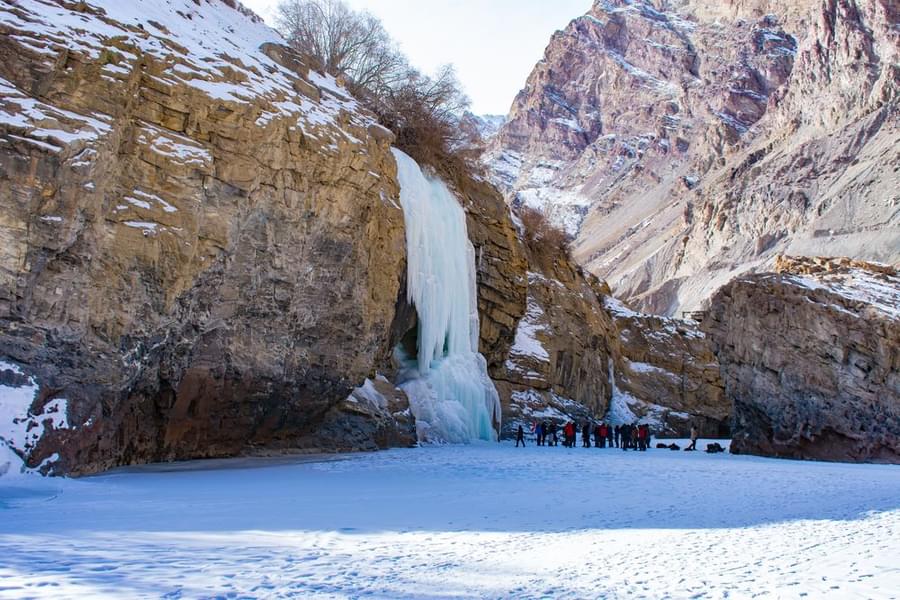
Move from Leh to Gyalpo via Chilling and Tilad do
- This is the actual day of your Chadar trek. On this day, you will head towards your first campsite in Shingra Koma through Chilling.
- The day will start with a drive from Leh that will let you spot some scenic attractions in Ladakh.
- On your way, you will come across plenty of remarkable sights, like Gurudwara Pathar Sahib, Magnetic Hill, and the convergence of the Indus and Zanskar river.
- After a short drive of 90 minutes along the Zanskar River, you will reach Chilling.
- It is the place where the car will drop you at the end of the road. From there, you will start your walk on the Zanskar river.
- Initially, it may be difficult for you to walk on the ice with your gumboots on as the sheet may be thin, but you will understand the ice patterns slowly and gradually.
- It is advisable to plant your foot and walking sheet on the ice to check the steadiness before moving on it wholeheartedly.
- You must also ensure that the weight of your backpack is not heavy so you can carry it yourself effortlessly.
- After a walking struggle of about one and a half hours, you will reach your first campsite at Gyalpo, where you will experience your first sub-zero temperature camping.
- Rest for an overnight sleep in Gyalpo.
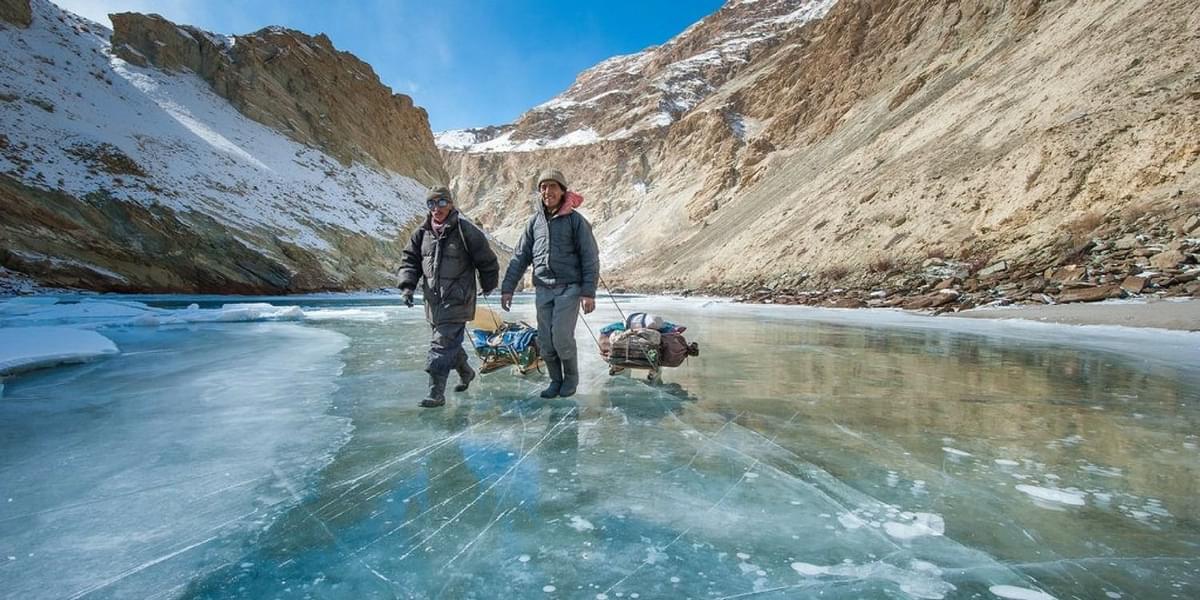
Gyalpo to Tibb Cave
- Chadar trek is one of the treks where you will not be able to see altitudes in quick succession. But, when you slowly move to Tibb Cave from Gyalpo after five to six hours, you will find yourself rising at an altitude of 300 feet.
- After spending a chilling night in your tent at Gyalpo, you are required to have a sumptuous breakfast to regain energy for the further trekking expedition. A hot cup of tea will also revitalize your senses in this cold temperature.
- After breakfast, the trek will resume, and the next campsite is Tibb Cave.
- While trekking, you will come across plenty of attractive frozen waterfalls, but the emerald green water of the Zanskar river will keep on flowing all along the trail.
- Midway to Tibb Cave, you can have your lunch.
- Post lunch, you will continue your trek, where you will discover varied rock patterns that shine uniquely as the rays of the sun fall on them.
- Finally, the day ends when you reach the campsite at Tibb Cave which is completely covered with dry sand.
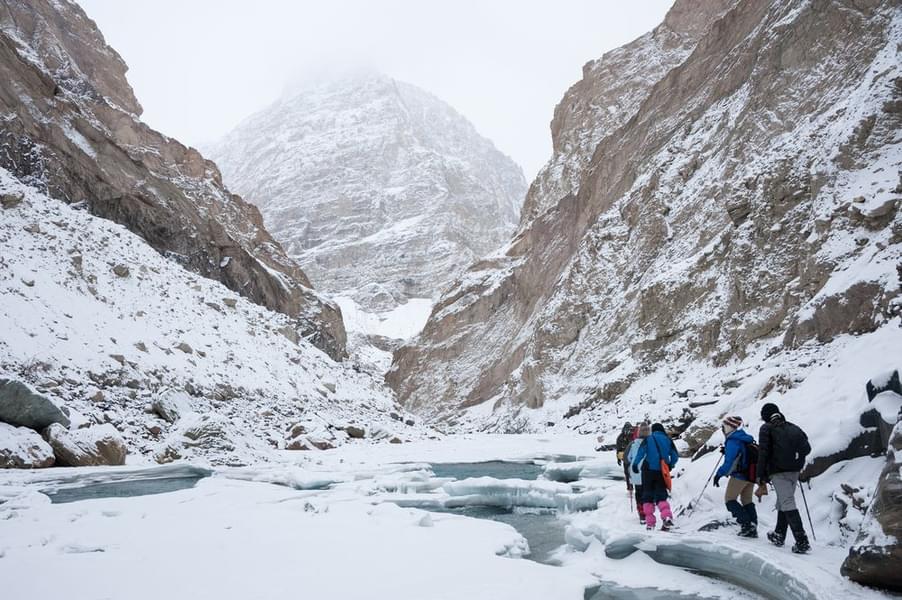
Tibb Cave to Nerak
- The destination of Day 6 will be Nerak, which is a 13 kilometers long trail that takes you to the exemplary landmark of the Chadar trek named the Frozen Waterfall. The Frozen Waterfall is one of the beautiful attractions that garner the interest of tourists from around the globe.
- You will be served with hot lunch on your way to Nerak.
- It is by far the coldest campsite where the temperature drops to -30 degrees Celsius at night. Hence, you must wear appropriate clothing to keep the chilling atmosphere at bay.
- Day 6 ends with reaching Nerak campsite, which is situated around 15 to 20 minutes from the Frozen Waterfall.
- If the trekkers reach the Nerak campsite on time, they can also pay a visit to the Nerak village.
- The day ends with an overnight sleep in the Nerak camp.
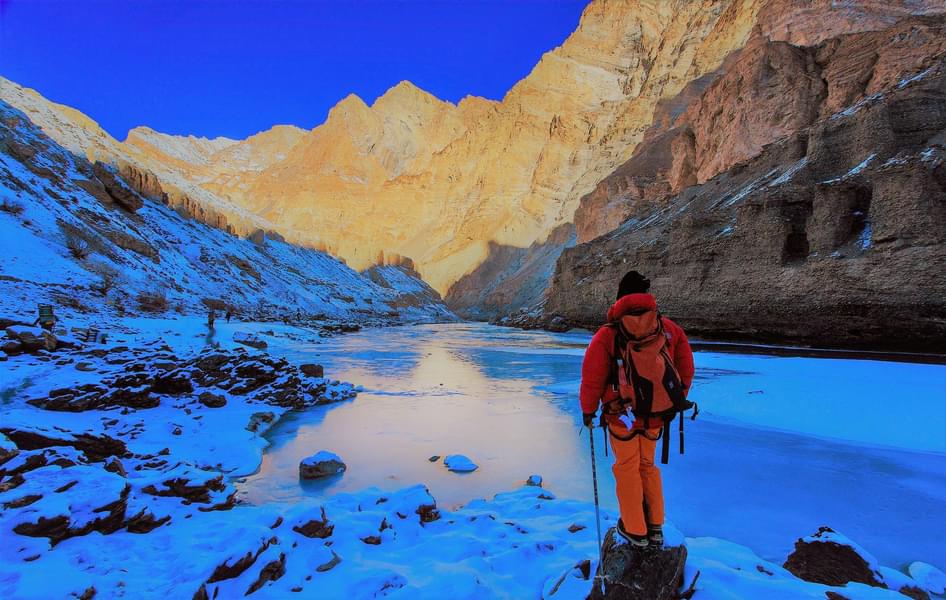
Nerak to Tibb Cave
- Day 7 will be the returning day of your Chadar trek. It is indeed your last chance to embrace and relive the moments on the Zanskar River near the Frozen Waterfall.
- Chadar trek is completely a unique experience in itself. The weather conditions are very unpredictable in this region. You may find that the layer of Chadar has completely vanished from where you have come. However, at the same time, you will find that a new layer has been formed in some other place. Thus, it is advisable to take back all the memories in your backpack before returning from the trek.
- Say goodbye to the locals and start your trek on your way back to the Tibb Cave.
- On your way back, you will find locals negotiating the conventional woolen Gonchas at the Chadar where the monks are returning to Leh from the monastery at Lingshed. You may also find the young students returning to school after their vacation in Leh. This sight of local people is heartwarming to see as they are surviving in such a cold climate yet keep a long smile on their faces.
- You can sign off for the day after reaching Tibb Cave.
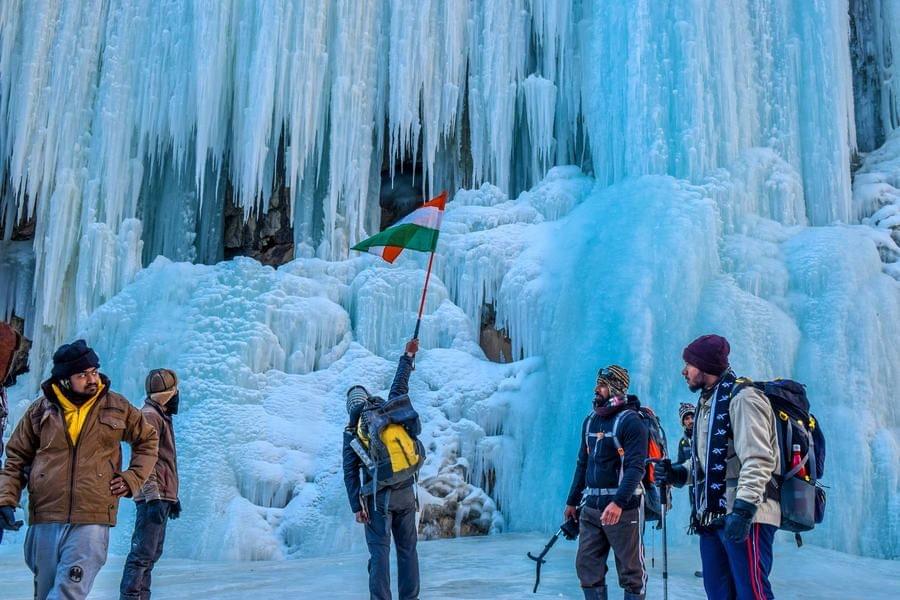
Tibb Cave to Shingra Koma via Gyalpo and then to Leh
- On Day 8, it is time to go back home and you need to wake up early to cover a long distance from Tibb Cave to Shingra Koma.
- While moving down to Shingra Koma, you will discover high walls of mountains rising on the sides of the river that almost looks like a castle.
- You will also notice the steps and footprints of foxes, ibex, or snow leopards on the Chadar trek.
- If you are lucky, you may even spot snow leopards. But you must rest assured that someone will keep a watch on you all the time on your way back to Gyalpo.
- You will not get a chance to retrace the steps while going back as the way might have changed a lot. The layer of chadar has melted and become thin. You may also see the formation of rocks on your way down to Shingra Koma.
- After reaching Shingra Koma, you will be asked to board a bumpy ride back to Leh at around 6.30 pm in the evening.
- You can rest after the tiring day at Leh in the warm guest house and get ready for your way back home on the next day.
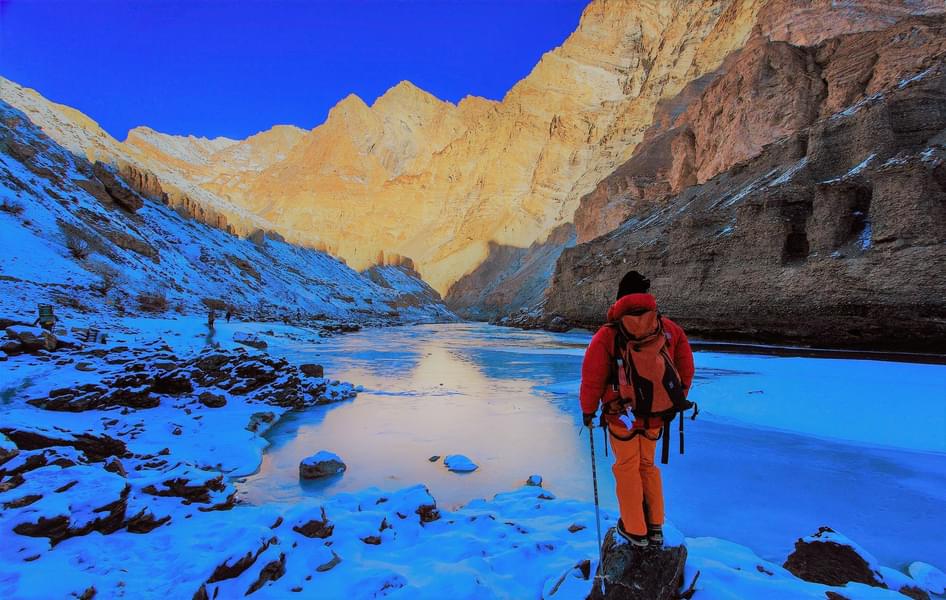
Depart from Leh
- Day 9 will officially be your last day of the Chadar trek as you move back to your home, taking all the memories of the trek with you.
- The day starts with a delicious breakfast, and then you can get ready for checkout from the guesthouse by packing all your belongings.
- Say goodbye to your guesthouse and reach the Leh airport, from where you can head towards your destinations further!
- Your Chadar trek experience ends here.
General Trivia About The Trek
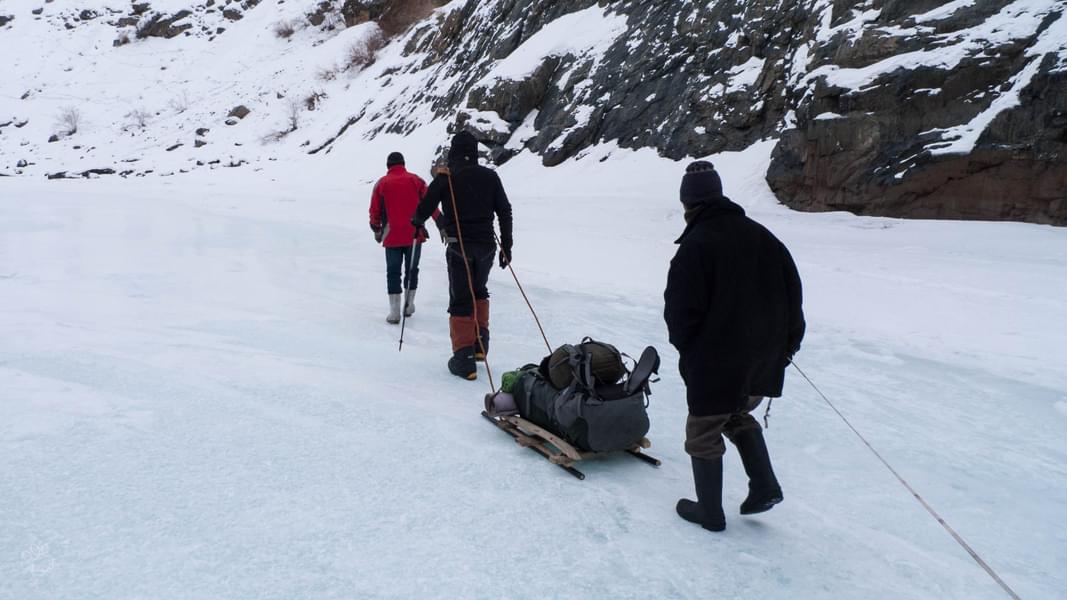
- Chadar trek does not include any kind of ascending and descending paths similar to the other Himalayan treks as you will be walking on a frozen sheet of ice on the Zanskar river all the time.
- Although Himalayan waters are considered safe for drinking, the trekking experts advise purifying the water by boiling it with chlorine tablets during the trek.
- The trade route between Zanskar and Ladakh regions that has existed for more than 1000 years is known as ‘Khado Sanglam’ in the local dialect.
- Zanskar river freezes completely during the months of January and February to form a walkable path of ice.
- There must at least be a group of six to seven people to go on the Chadar trek with a maximum of 15 to 18 people.
- February is considered to be the toughest time to go on the Chadar trek as the fluctuating temperatures during the day and night can cause broken trails along the way.
- The temperature on the Chadar trek drops to as low as -30 degrees Celsius, and thin air keeps flattering your skin at every inch of your walk.
- Chadar trek is unique as it is a complete surprise package of slippery ice sheets, occasional cave stays, unusual campsites, and brisk-changing weather conditions.
- If you are lucky, you may spot an old snow leopard or other wildlife on your trekking expedition.
- Pictures of the beautiful frozen Nerak waterfall are surely a remarkable way to account for the memories.
Know Before You Go to Chadar Trek
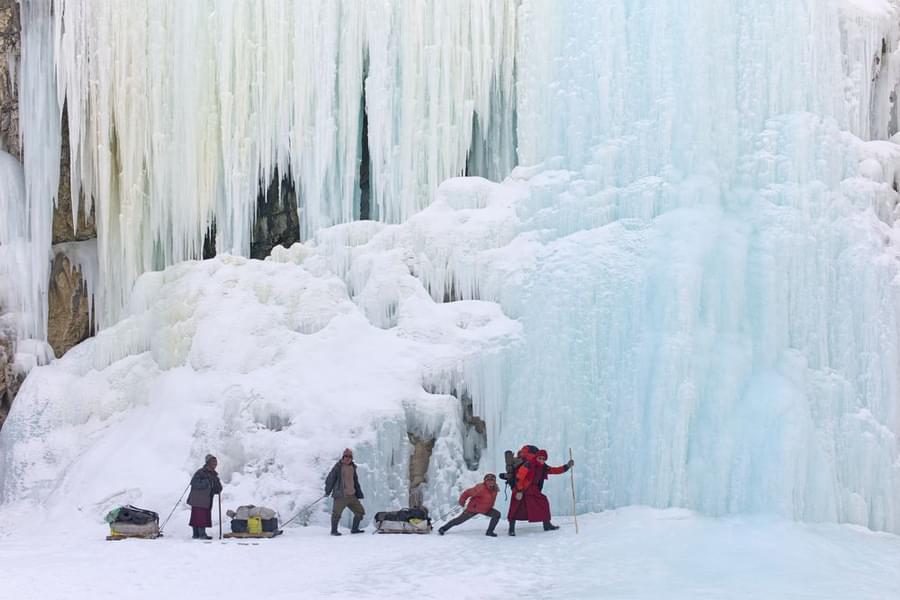
When you are going on a trekking expedition, it is essential to keep the do's and don’ts in mind. These tips will help the trekkers stay connected with their fellow travelers and prevent them in case of an emergency situation. Here are some of the important tips that trekkers should consider on the Chadar frozen river trek:
- Inform your friends and family about the trek and give the number of your trekking organization to them so they can contact you in case of any emergency.
- Wear warm clothes at all times and carry stuff that can keep you warm at all times as the temperature may drop drastically and unexpectedly during your trek.
- Do not forget to carry your first aid kit and all the necessary medications as bruises and cuts are relatively common during treks and hikes.
- Keep yourself hydrated at all times. People are more likely to skip drinking water due to the cold climate.
- Walk actively and carefully as the sheet of ice may be slippery.
- Do not litter everywhere as it is strictly prohibited to throw plastic and biodegradable stuff on the trekking trails.
- Avoid contaminating the waterfalls while bathing with chemical soaps because villagers use this water for drinking purposes.
- Remain polite towards your trek leader and co-trekker at all times.
- Do not skip your meal under any circumstances.
- Always be together with your trekking group, and do not wander anywhere on your own.
- Ensure that you carry all the trekking essentials in your backpack.
- Follow the instructions given by the trekking leader to ensure safety and security at all times.
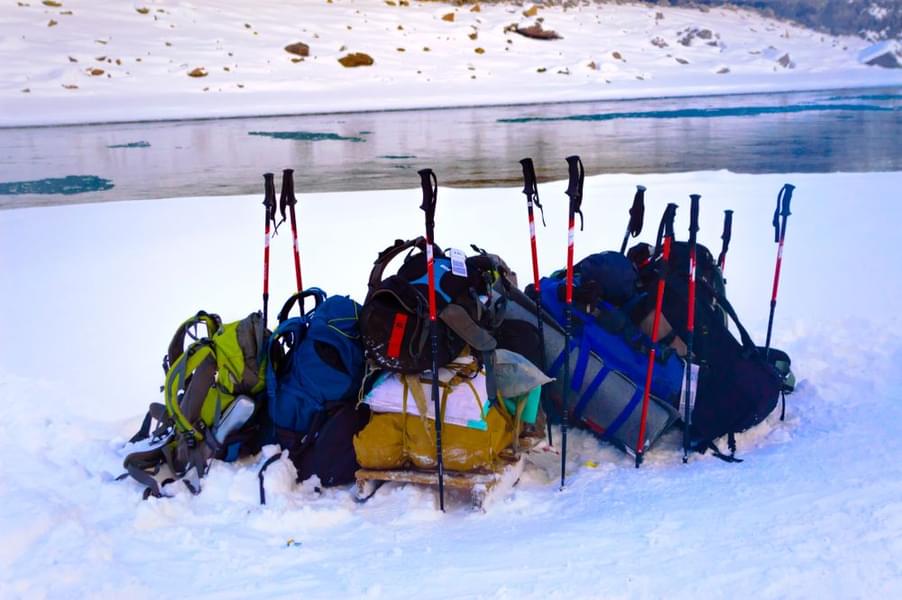
Basic Gear: - Backpack (50 to 60 liters) with appropriate shoulder straps and raincoat- 2 thermos flask water bottles of one liter each- Medical kit after consultation from the doctor- A walking stick- Snacks, like dry fruits, energy bars, electoral / ORS, and much more.
- 1 full sleeves non-cotton T-shirt
- 2 fleece T-shirts
- 1 fleece jacket
- 2 pairs of thermal inners (both upper and lower)
- 1 down feather or hollofil jacket
- 1 pair of fleece or wool gloves
- 1 pair of waterproof gloves
- 1 pair of waterproof jackets and pant
- 1 pair of Windstopper pant
Personal Utilities:
- Antibacterial powder
- Hand sanitizer
- Chapstick or Lip balm
- Moisturizer
- Quick dry towel
- Sunscreen cream
- Toilet paper and wipes
- Toothbrush and toothpaste
Hand Gears:
- 1 balaclava
- 1 head torch
- 1 neck-gaiters
- Dark sunglasses with side cover, UV protected (do not wear contact lenses)
- 1 woolen cap
Foot Gears:
- 6 pairs of cotton socks
- Gaiters (optional)
- Floaters or flip flops (optional)
- 1 pair of gumboots (it is advisable to buy them from Leh)
- 1 pair of trekking shoes (optional yet highly recommended)
- 6 pairs of woolen socks
- Chadar trek route map
- Sleeping bag
- Hot water bag
- Valid ID proofs (passport & driving license) and their copies
- 4 passport size photographs
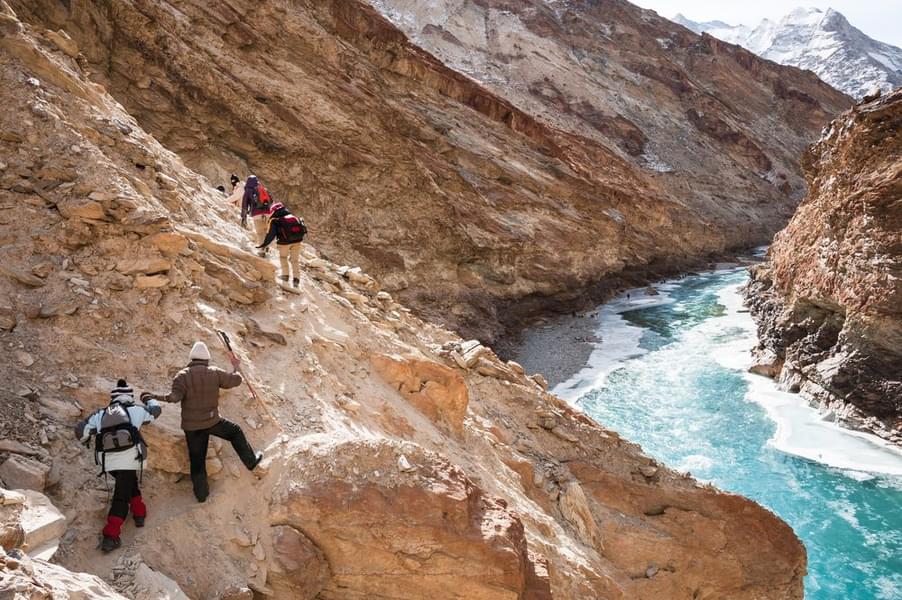
By Air- The easiest way to travel to the starting point of the Chadar trek Ladakh is Kushok Bakula Rimpochee Airport located in Leh. This airport is situated about 4 kilometers from the city's center and receives daily flights from Delhi, Mumbai, Srinagar, Chandigarh, Jammu, and several other places in India. Even if you are traveling from beyond the geographical boundaries of India, you can take a connecting flight from Delhi, Mumbai, and Kolkata to Leh. Go Air, and Air India are some of the airlines that operate frequently on this route. Traveling to Leh by air is an amazing experience, and it makes for a wonderful start for the trekking expedition.
By Train- You can also board a train to Leh. The train used to travel to Leh is New Delhi Jammu Tawi Rajdhani Express, which travels from New Delhi to Jammu. After reaching Jammu, you can take a bus to Srinagar and then to Leh.
By Road- After you reach the Leh airport, you will be traveling through two road routes, namely the Manali-Leh highway and the Srinagar-Leh highway. The visitors will discover beautiful snow-clad mountains and gorgeous roads while driving their way to the hotel. If you are visiting this place in extremely cold conditions (i.e., between October and November), these routes remain closed due to heavy snowfalls. From the airport, your trekking authorities will take you to your hotel so you can relax and start your trek afresh.
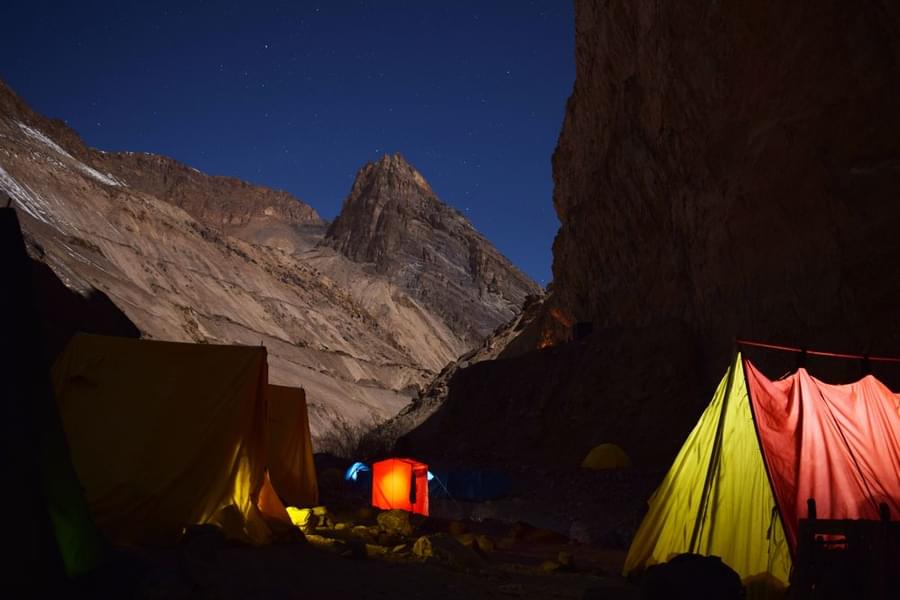
- The best and the only time to go on the Chadar trek is during the winter season, i.e., when the Zanskar river freezes. These winter months of January and February are best suited to admire the natural beauty of the Himalayas that has been preserved for centuries.
- If you are thinking of which month to plan your itinerary for Chadar frozen river trek, it is advisable to do it during the month of February as the ice is the most stable at this time.
- With temperatures ranging between -5 and -25 degrees Celsius, trekkers feel that February is the toughest winter time for Chadar trek.
- The fluctuating temperatures during the day and night in the month of February makes the trekking experience even more difficult as you may encounter broken trails along the way.
- On your trekking expedition, Nerak is the coldest among all the campsites, where the temperature drops down to as low as -30 degrees Celsius at night. You may also get a chance to visit the Nerak Village if you manage to reach the waterfalls on your trek.
- The heavy snowfall of the Pensi La Pass creates a thick sheet of ice on the surface of the Zanskar river and cuts the place from the rest of Jammu and Kashmir.
- Even the locals wait for winters to come so they can create a walkable path of ice and go back home. Hence, the winter season, i.e., January and February are the best months to go on a Chadar trek with your friends.
You May Also Book
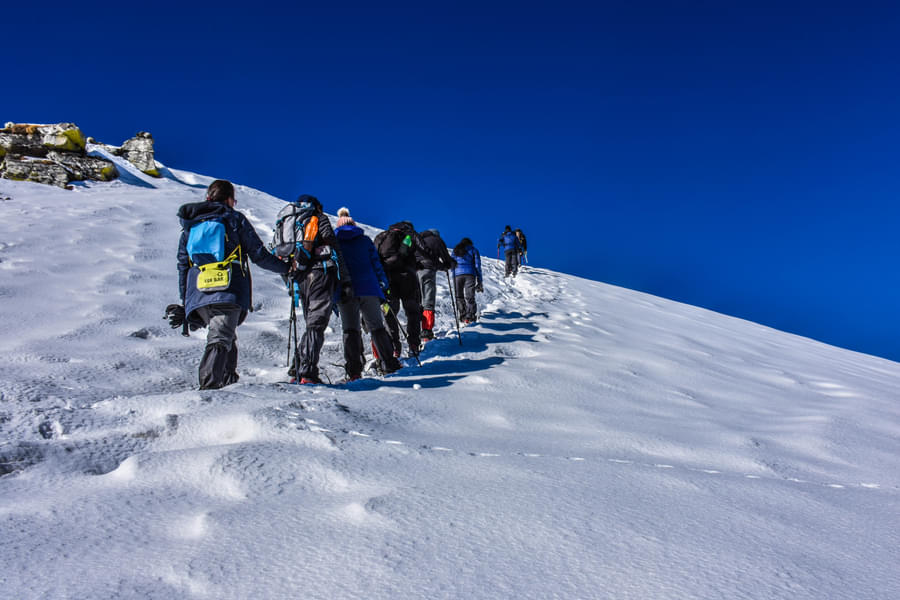
FAQ's of Chadar Lake Trek
How difficult is the chadar trek.
The Chadar trek is regarded to be one of the most difficult treks in India. It gives you a larger-than-life feeling with its extreme weather conditions amidst the natural surroundings. What makes the trek even more difficult is that trekkers are required to walk on the surface of the thick layer of a frozen river. Hence, a trekker should have enough stamina to cover a distance of five kilometers in just 30 minutes is a good fit for the Chadar trek Ladakh.
You can also check your body mass index (BMI) to find if your fitness level matches the difficulty of the trek. If your BMI is normal, you can plan your fitness regime for trekking. On the contrary, if your BMI is not normal, you are required to consult your trusted physician before adopting any fitness regime. Moreover, consultation from a medical practitioner is recommended if you are suffering from any chronic illness.
What are the best months to visit this trek?
The best months to visit the Chadar trek are between the first week of January to the second week of February. During these months, a thick sheet of ice gets formed on the Zanskar river, which makes a great trekking path for adventure lovers.
What is the minimum and maximum age limit of the Chadar trek?
The minimum age limit of the Chadar trek is 13 years, but children between 13 to 17 years of age should always be accompanied by their parents or guardians. For people above 60 years of age, you need to carry a detailed medical certificate that states you are perfectly fit for an adventurous activity like trekking.
What is the cellular network connectivity of the trek?
The cellular network connectivity of the trek is relatively nice upto Leh. But, it becomes difficult to find any network connectivity once you proceed to elevate on your trekking expedition to the Himalayas.
When will there be snow on this Chadar trek?
You will always find snow on this Chadar trek as the trek takes place during the months of January and February when the place experiences extreme snowfall.
What is the cost of the Chadar trek?
The cost of the Chadar trek starts from 17000 to 28000 per person. However, this cost may be subject to change if you may wish to rent a porter or mule. The hospitalization or emergency fees also need to be borne by the trekker apart from the general charges. Hence, you must get all the terms clear with your traveling authority before booking your expedition. On the contrary, if you book your trekking tickets online, you may avail yourself of the additional deals and discounts to make your trip cost-effective.
Is Chadar trek for beginners?
Chadar trek involves walking over a thick sheet of ice on the surface of the Zanskar river. This nine-day trek includes extreme weather conditions with snow all around. It becomes difficult to walk on ice because of the uneven formation. Surviving in the extreme temperatures of -30 degrees Celsius is a remarkable experience in itself. Hence, the Chadar trek is not for beginners as a beginner would not know the knick-knacks of handling the extreme situations of the trek.
What kinds of tents or sleeping bags will be provided to us on the trek?
On the Chadar trek, each trekker is provided with four-season tents and the sleeping bags are rated to prevent people from temperatures between -15 to -20 degrees Celsius.
Are there any toilet facilities on the trek?
No, there are no toilet facilities on the Chadar trek. You need to work in compliance with the rules and regulations of the villagers.
Is it safe for a solo woman traveler to travel in fixed departures?
Yes, it is completely safe for a solo woman traveler to travel in fixed departures. The trekking organization takes complete care of the safety and security of women in the group.
Will I get a certificate of trek completion?
Yes, you will get a certificate of Chadar trek completion once you return from your expedition. This certificate for trek completion will not be available if you return from the trek midway.
More Treks in Himalayas
- Treks in Himachal
- Treks in Uttarakhand
- Treks in Ladakh
- Treks in Nepal
- Treks in North-East
- Treks in Kashmir
.png?w=auto&h=400)
The content and images used on this site are copyright protected and copyrights vests with the respective owners.

Chadar Trek
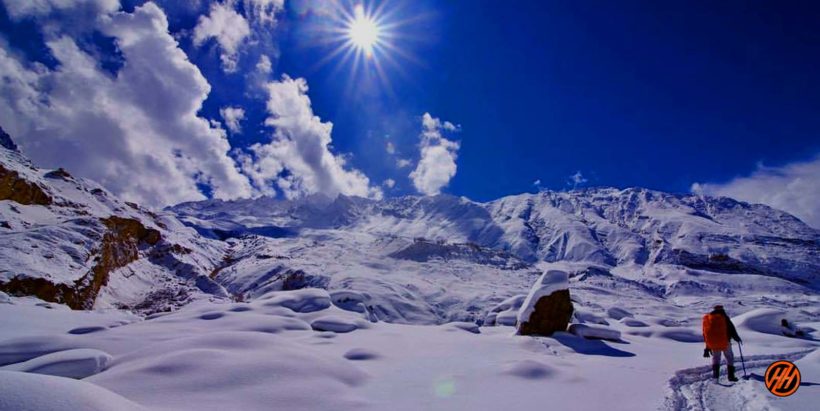
Description
Reviews (2), things to take, available dates, include / exclude, chadar trek in leh – over the zanskar river range of ladakh-2024- complete information, itinerary, costs date.
Your trek journey started with Himalayan Hikers , beautiful mountain town of Leh, all our trekker reach Leh by flight this is best option to you reach to Leh, altitude is 11400 feet above sea level, the trek beautiful Zanskar River which liws totally frozen during the December to Feb, Peak Winters Trek , So, probably the best time to do Chadar Trek is February because the ice remains harsh and stable. Trek starts from the freezing point of Zanskar River and that is Chilling.
Therefore, the “Chadar trek” is also known as “The Frozen River Trek”. This Trek is over a frozen river in the Zanskar region of Ladakh and it is different from all other treks in the Himalayas.
The snow appears as a thick sheet of snow, therefore, it is called “Chadar trek” and it is one of the trickiest treks in the world which is done in peak winter months. On this trek explore the Zankari culture and get to know about it in close proximity and the main highlight of this Frozen River Trek is a completely frozen waterfall “Nerak”.
The Chadar Trek is a popular winter trek in the Zanskar region of Ladakh, India. Here are some highlights of the trek:
- Trekking on the frozen Zanskar River: The highlight of the Chadar Trek is the experience of walking on the frozen Zanskar River, which transforms into a thick sheet of ice during the winter months.
- Breathtaking views: The trek offers breathtaking views of the frozen landscape, towering mountains, and the gushing river beneath the ice.
- Cultural experience: The trek also offers a unique cultural experience, as trekkers get to interact with the local Zanskaris and witness their way of life in the harsh winter conditions.
- Adventure: The Chadar Trek is a challenging trek that requires physical endurance and mental toughness. Trekking on the slippery ice, crossing icy-cold streams, and camping in freezing temperatures make it an adventure of a lifetime.
- Photography opportunities: The trek offers numerous opportunities for photography enthusiasts to capture stunning landscapes and unique cultural experiences.
Overall, the Chadar Trek is a must-do trek for adventure and nature lovers who are up for a challenging winter trekking experience.
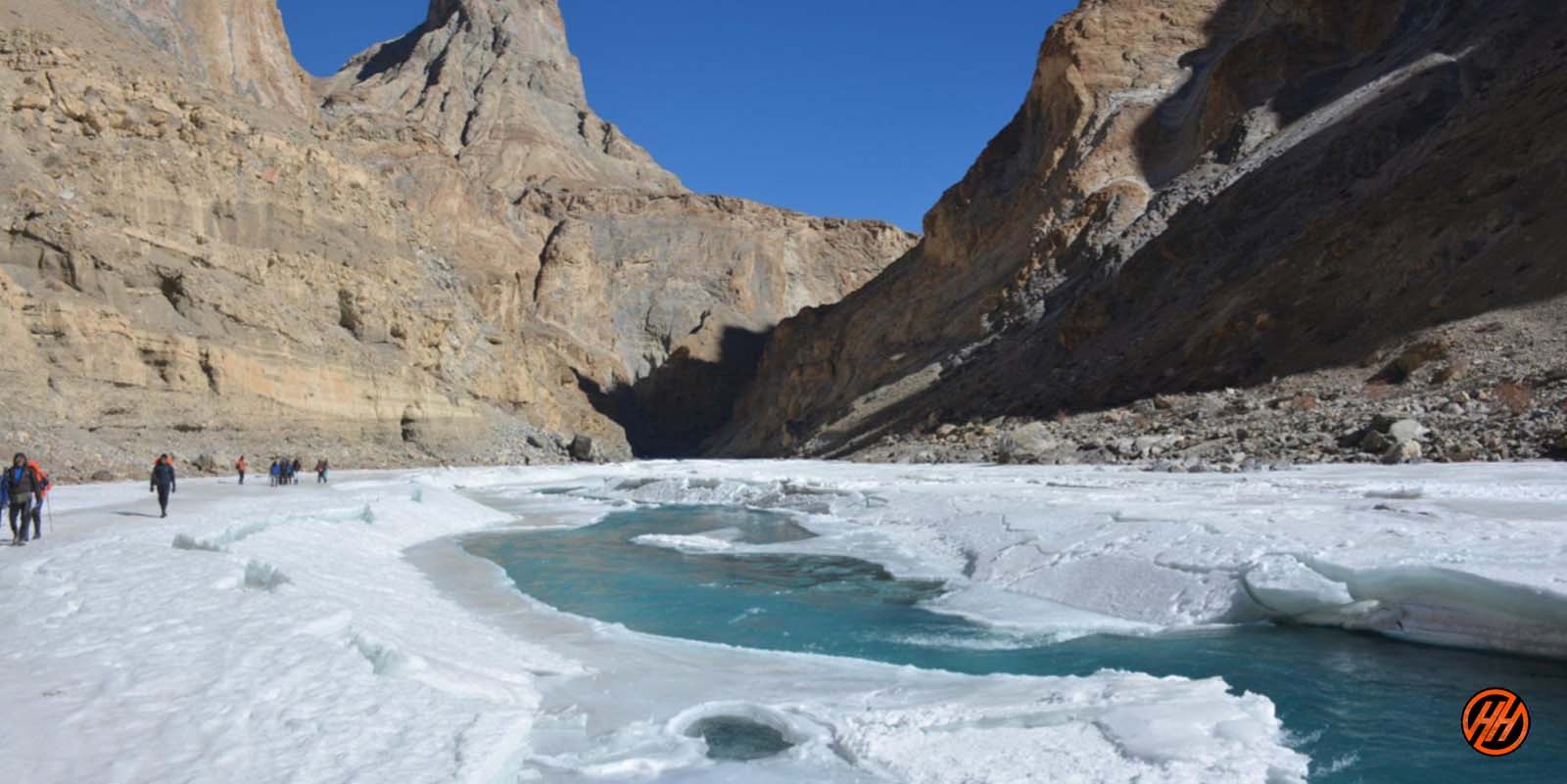
Ice Covering and Freezing Cold in Chadar Trek
The Chadar trek is over a frozen river and the ice can turn dangerous sometimes but can also be safe the other times. But, it is important to find a safe path over the perilous sheet of ice.
During the trek, you do not camp here at the meadows or the forest clearings but inside the caves which are present along the banks or you set up the tents at stable ice.
Here, the temperature remains chilly and freezing (-20) and falls down at night, so keep warm layers to protect the body against chilly cold and prevent the freezing of blood.
Best Time to Visit Chadar Trek
The best time to do the Chadar Trek is during the winter months, from January to February, when the Zanskar River freezes and forms a thick sheet of ice that is suitable for trekking. During this time, the weather is cold and dry, with clear blue skies and minimal precipitation.
It is important to note that the timing of the trek also depends on the weather conditions and the formation of the ice sheet. It is essential to have experienced guides and a reliable trekking organization to provide up-to-date information on the ice conditions and weather forecast.
Additionally, it is recommended to plan the trek in advance and book with a reputable trekking organization like Himalayan Hikers Trekking Organization to ensure availability and to have the necessary permits and logistics in place.
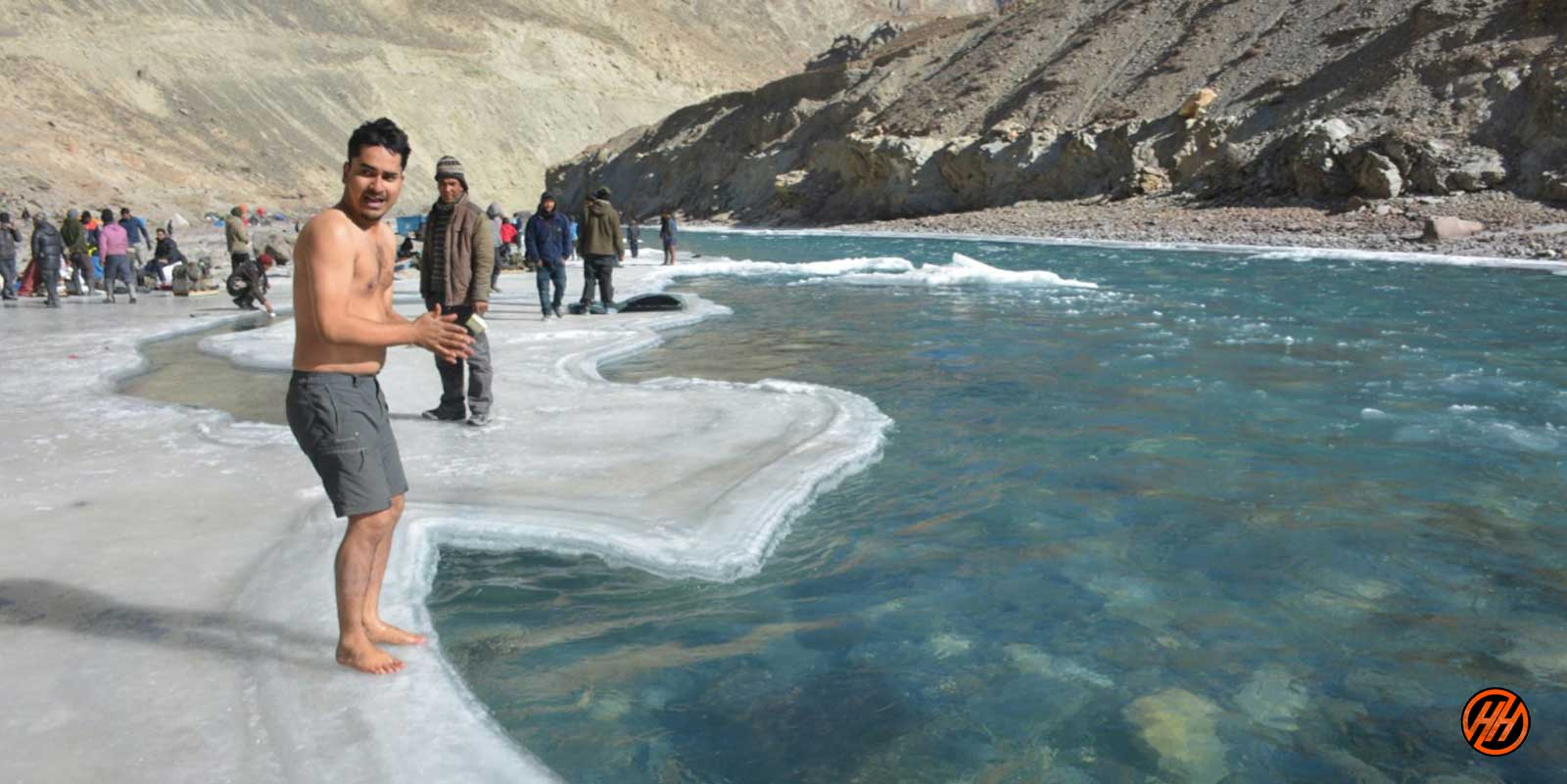
Be Aware During Chadar Trek (Not for Beginners)
You need to be very aware of the stability of ice and conditions below the feet for a safe trek. Sometimes the ice isn’t stable and the choices go wrong so walk carefully if suddenly a crack appears to go fast to the place where the ice is
So, choose a camping spot wisely after properly analyzing the area.
Here are some tips to do Chadar Trek –
Analyze the ice sheet conditions.
Avoid the cracks in the ice.
Walk carefully on the slippery areas.
Run immediately to a stable area if a sudden crack appears under your feet.
Walk on the places with a coating of snow.
Choose camping spots wisely.
Alcohol and smoking are not allowed in during the trek
Level- Difficult
During the trek, proper conditioning & training of body required
Need proper gear & clothing for sub-zero temperature
Shoes are the single most important equipment.
High Altitude requires proper acclimatization. Of base camp Leh
Beautiful landscapes so carry good photo gear & Extra battery backup.
Travel headlight
The backpack should not exceed 12 kg.
Long Gumboots are mandatory to all trekker
About Leh – Ladakh – The Land of High Passes
Area: 98,000sq km
Altitude: 7,500m Max.
Population: 250,000
Religion: Buddhism, Islam. Hindu
Geographical Status: Cold Desert
Across the Kashmir Valley and over the famous Zoji La pass lies Ladakh, the Land of High Passes. It is a magical land, so completely different from the green landscape of some other parts of the Himalayas. It is nature at its extreme. A land of freezing winds and blazing sunlight, Ladakh is a cold desert lying in the rainshadow of the Great Himalayas and other smaller ranges. Little rain and snow reaches this dry area, where the natural forces have created a fantastic landscape.
Ladakh forms part of the state of Jammu and Kashmir in India. Parts of Ladakh are under the illegal occupation of Pakistan and China. The border of Ladakh touches those of Afghanistan, Pakistan, China, the Kashmir Valley (India) and Himachal Pradesh (India). This region is made up of two administrative districts — Leh District, with its headquarters at Leh, and Kargil District, with its headquarters at Kargil –and covers a total area of about 59,000 square kilometers.
Ladakh is at an average elevation of 2,700 m to 4,200 m. The aridity of this region is due to its location in the rainshadow area of the Great Himalayas, elevation and radiation of heat from the bare soil. The most striking physical feature of Ladakh, however, is the parallelism of its mountain ranges. The region is extremely dry, with an annual rainfall as low as 10cubic centimeter.
In Ladakh, large rivers and their tributaries have carved deep gorges far below their steep banks. However, their water is not of much use as the terraced fields lie high above the gorges.
Until the advent of the aircraft, Ladakh could only be reached over dangerous, high passes. The Zoji La pass connecting Ladakh to Kashmir is at 14,000 ft and is the lowest approach from the west. The southeast approach has to cross the 18,200 ft high Tanglang La. And to the north lie the Saser La and Karakoram passes, gateways to Central Asia from where trading caravans used to come for many centuries.
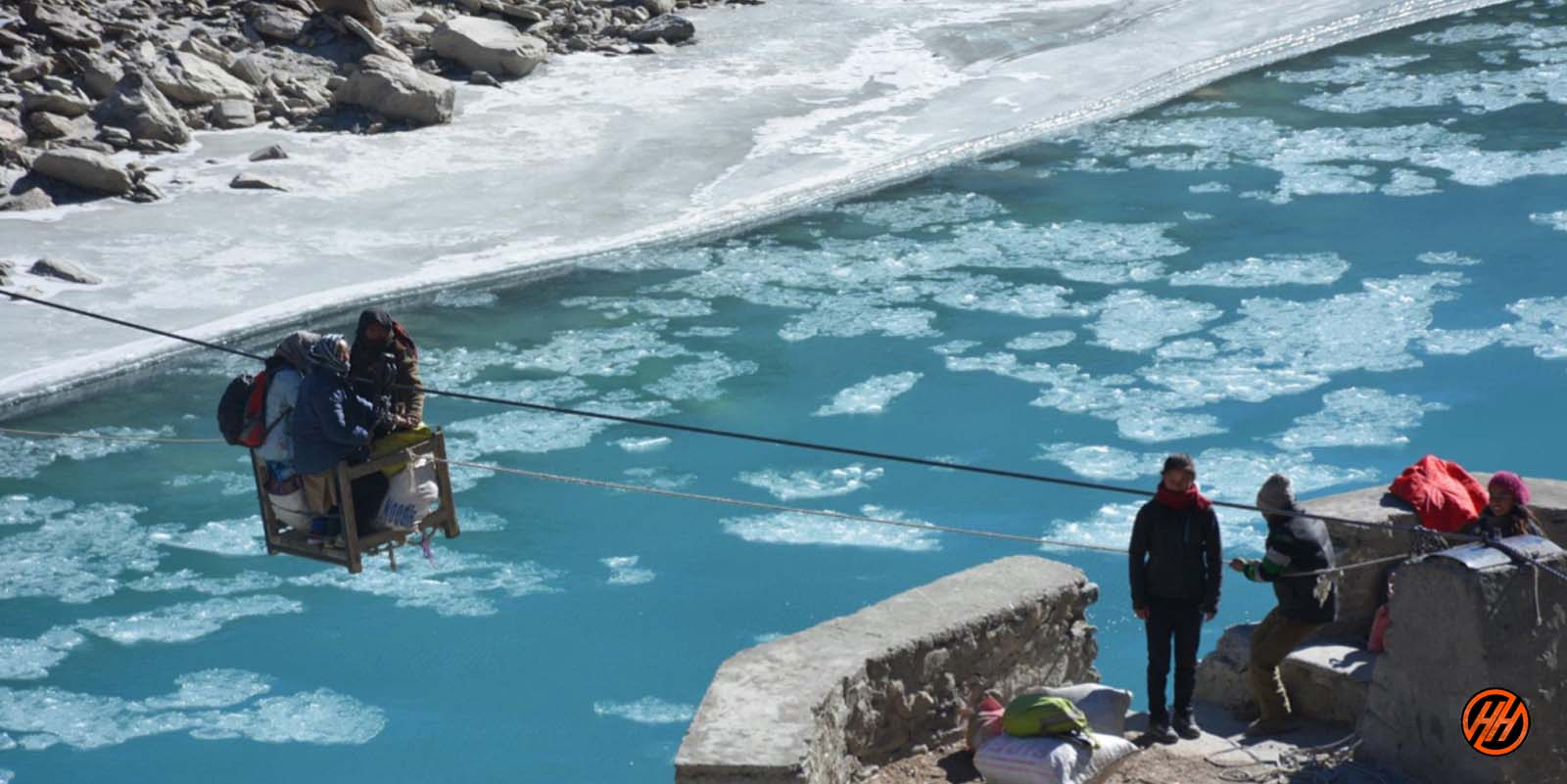
Altitude we are going to cover in Chadar Trek
Leh – 3500 Meters
Tsomo Paldar camp – 3200 Meters
Tibb Cave camp – 3300 Meters
Nerak camp – 3400 meters
The temperatures during the Chadar Trek
The temperatures during the Chadar Trek can be quite cold, as it takes place during the winter months when the region is covered in snow and ice. The average temperatures during the trek range from -10°C to -20°C (14°F to -4°F) during the day, and can drop to as low as -30°C (-22°F) at night. However, it is important to note that temperatures can vary depending on the weather conditions, altitude, and time of day.
It is crucial to have proper clothing and gear to stay warm during the trek, including warm base layers, a down jacket, insulated pants, waterproof gloves, and a warm hat. Additionally, it is important to stay hydrated and eat nutritious food to maintain energy levels and stay warm. Experienced trekking organizations like Himalayan Hikers Trekking Organization provide detailed information on what to wear and pack for the Chadar Trek to ensure a safe and comfortable trekking experience.
ATM Point & Mobile connectivity in Chadar Trek
ATM POINT: Hi trekker ATM available is Leh Withdraw money before your journey,
Mobile Connectivity: There will be available all networks only postpaid
Key Points of Chadar Trek
Duration: – 08 Nights 09 Days from Leh to Leh
Base camp: – Leh
Winter Temperature:- Day -5°C to -15°C) Night – 12° C to -20° C
Chadar trek – Altitude: – 11400 feet
Best Time: – Jan or Feb
Trek Level: – Difficult
Trek distance: – On foot 57 Km – By taxi 140 km
Group Size: – minimum of 05 people maximum of 15 people
Temperature
The winter temp. touches as low as minus 30 degree (Leh & Kargil) and minus 60 degree in (Drass) subzero temp. prevails from December to February throughout Ladakh, whereas, zero degree temp. is experienced during rest of winter months. This results in freezing of all conceivable water resources. During summers the maximum temp. increases from 20 degree C to 38 degree C in July and August
Clothing: Light/Medium woolens in summers to Heavy woolens in winter
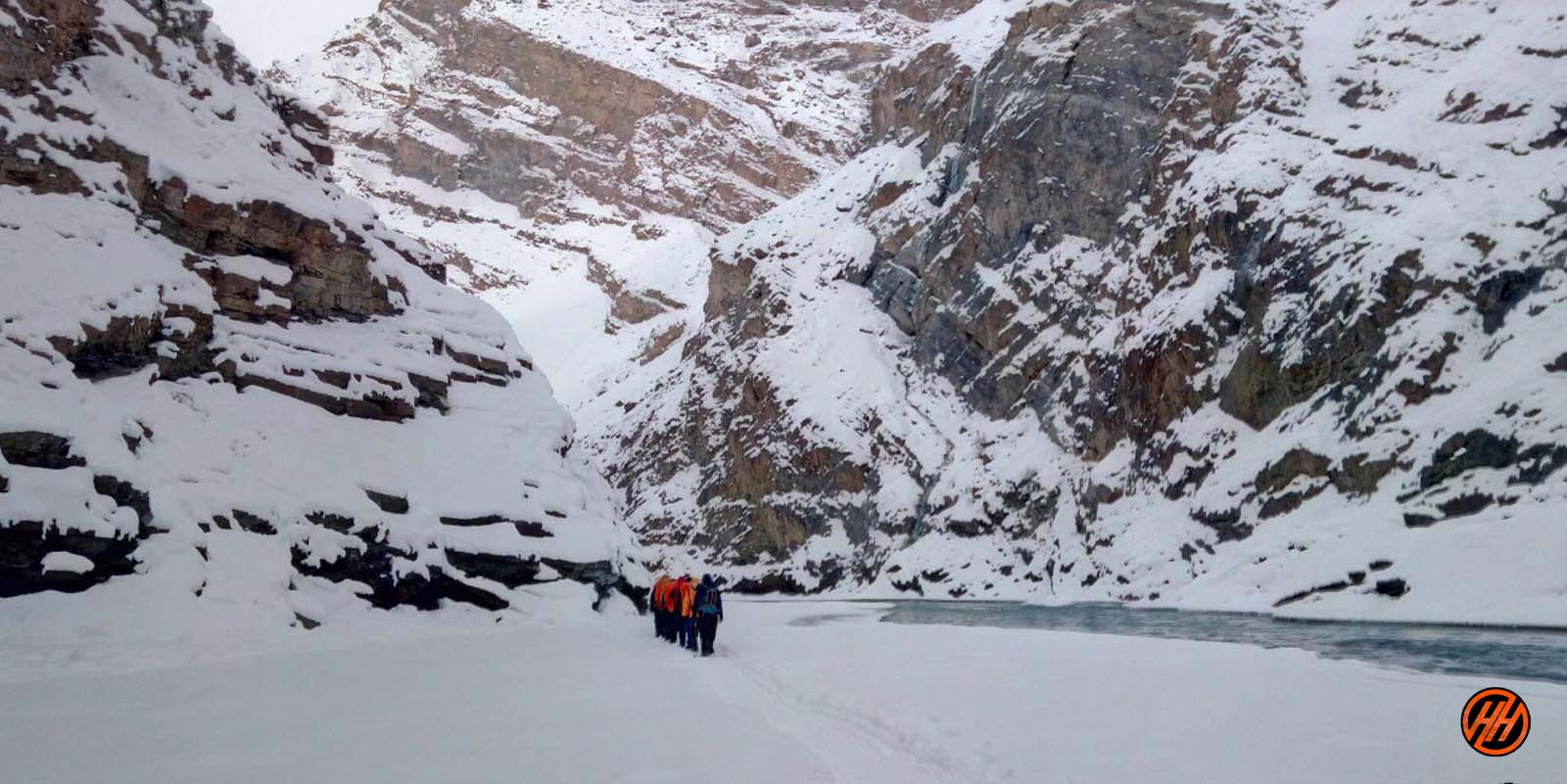
Languages Spoken
Ladakhi is the main language of Ladakh. Other languages spoken are Balti, Shina, Brokshat and Changshat. In hotels and restaurants, staffs speak English and Hindi, while tourist guides are well versed with the language.
Key Points about Chadar Trek
– Level: Difficult (so first-timers trekkers should avoid)
– Proper conditioning & training of body required
– Group size minimum of 05 maximum of 15 people
– Need proper Expedition gear & clothing for sub-zero temperatures?
– Shoes are the single most important equipment
– High Altitude requires proper acclimatization
– Phones don’t work on the trek, we are provide to you Radio Walkie Talkie for Communication
– Beautiful landscape so carry good photo gear (I couldn’t carry my best equipment)
– Travel light (my backpack was heavy at about 12 kg to 15 Kg )
– Keep an extra day in your itinerary for attempt to Chadar trek summit account for bad weather
– Alcohol and smoking is not allowed in during the Chadar Trek Expedition
Difficulty level
Because the top is relatively high in elevation, we strongly recommend a reasonable level of physical fitness. The arduous journey of Chadar trek winter hiking with longer distances and ascending elevations to be covered in a short span of time would require acclimatization. We advise trekkers to physically and mentally prepare themselves prior to this trek. Throughout the course, all groups will be guided by our experts for trekking equipment and any impending terrain.
Any medical assistance that is required will be provided at any point of the journey; however, trekkers must consult their professional care before beginning any trek. We also strongly advise trekkers to learn about altitude sickness and to notify our teams as soon as any symptoms appear.
Short Itinerary of Chadar Trek
Day 1:- Arrival at Leh – pickup to you from Airport drive to Hotel check in Rest and Acclimatization overnight stay Hotel
Day 2:- Trek Planning and Briefing – Acclimatization and Preparation- meet us our Himalayan Hikers Guide overnight stay
Day 3:- Medical Test Day in Leh
Day 4:- Drive from Leh to Bakula (70 km) (2 hours) same Day Trek Bakula to Shingra Koma 2/3 Hours overnight stay Camp
Day 5:- Trek from Shingra Koma to Tibba (16 km) (6/7 Hours) overnight stay Camp
Day 6:- Trek from Tibba to Nerak Waterfall (12 km )( 6/7 Hours) overnight stay Camp
Day 7:- Trek from Nerak to Tibba (16km ) (6/7 hours) overnight stay Camp
Day 8:- Trek from Tibba to Bakula (12 km) (6/7 hours) Same day Drive to Leh Hotel
Day 9:- After breakfast Depart from Leh
permit and passport.
Tourist don’t require permit for Leh, however, all foreigners are required to be registered at Drass, Rumtse and Serchu if they are travelling overland. Those traveling by air get themselves registered at airport. Tourists are required to get permit for restricted areas like Tsomoriri, Tsokar and Pangong Lakes, Dhahanu and Nubra Valley, which can be obtained from District Magistrate, Leh, through Travel Agents at Leh.
Avoid acute mountain sickness
Acute mountain sickness can occur to any one at an altitude above 10,000 ft. above sea level, therefore, make it sure to take complete rest on the day of arrival.
How to Reach Leh or ladakh
Overland Approach
Overland Approach – The overland approach to Ladakh from Kashmir Valley via Kargil is approx. 434 Km, which remains open for traffic from early June to November. The most dramatic part of this road journey is the ascent up the 11,500 feet / 3,505 m high Zoji-La, the pass in the Great Himalayan Wall that serves as the gateway to Ladakh. The J & K State Road Transport Corporation (J&K SRTC) operates regular Deluxe and Ordinary bus services between Srinagar and Leh on this route with an overnight halt at Kargil. Taxis (cars and jeeps) are also available at Srinagar for the journey. Groups can charter Deluxe and A-class buses for Leh, Kargil or Padum (Zangskar) from the J & K SRTC at Srinagar.
Manali to Leh – Since 1989, the 473 km. Manali-Leh road has been serving as the second overland approach to Ladakh. Open for traffic from around mid-June to early October. This high road traverses the upland desert plateau of Rupsho, altitude ranges from 3,660m to 4,570m. A number of high passes fall enroute among which the highest one known as Taklang-La is world’s second highest motorable pass at an altitude of 17,469 feet/5,235m. Himachal Pradesh Tourism, HRTC and J & K SRTC operate daily Deluxe and Ordinary bus services between Manali and Leh. The bus journey between Leh and Manali takes about 19 hours or two days with an overnight halt in camps at Serchu or Pang. Shared taxis are also available both from Leh and Manali
Road Distances
Srinagar-Leh 434 Km
Manali-Leh 473 Km
Srinagar-Kargil 204 Km
Delhi-Leh 1047 Kms
Leh-Kargil 234 Km
Kargil-Padum (Zanskar) 240 Km
Leh-Deskit (Nubra Valley)118 Kms.
Credit Cards & ATM Machine
Credit cards are accepted by very few hotels and tour operators but there will be 2.5% service charge. The Jammu and Kashmir Bank and State Bank of India has placed ATM Machine in Leh. The State Bank of India accepts visa and mastero but this ATM is not very reliable. J&K Bank ATM is more reliable but accepts only Mastero.
Indian Airlines www.indian-airlines.nic.in operates regular flights to Leh from Delhi (fare USD 135), Four flights in a week from Jammu and once in a week from Chandigarh and twice from Srinagar. Jet Airways www.jetairways.com also operates daily flights between Leh-Delhi (fare USD 143).
Internal Transport
The cheapest way to travel within the region is by public buses, which ply on fixed routes according to fixed time schedules. The most comfortable and convenient though expensive mode of travel, however, is by taxi, which are available for hire on fixed point-to-point tariff. For visits to the newly opened areas of Nubra, Dah-Hanu, Tsomoriri, Tsokar and Pangong Lakes. It is mandatory to engage the services of a registered/recognized travel agency for making all the requisite arrangements including internal transport. Detailed information about bus schedules, taxi tariff, travel agencies can be obtained from the Tourist Office or Local travels guide “Reach Ladakh”, available at Book Shops.
Leh is the headquarter of Leh District, and the largest town of the region. It is located to the north of the Indus River at an elevation of 3600m above the sea level. The town is dominated by the nine-storey Namgyal Palace and Namgyal Tsemo (victory peak), built by Tashi Namgyal on his victorious in reunification of the Upper and Lower Ladakh. Leh became the capital of Stod (upper Ladakh) during the reign of king Graspa Bum- Lde,who ruled Ladakh from 1400 to 1430 AD. In the later period, Leh became an important center for trade in Central Asia. Leh remained merely a headquarter of Ladakh district until 1974, when Ladakh was opened for foreign tourists. Since then period Leh became the centre for tourism related activities in the region.
Fact File
Leh provides medium and lower class accommodation, with hundreds of guesthouses and hotels, which can suite every budget. Restaurants offer good multicuisine for a reasonable price. There are number of tour Operator/Travel Agents around the town, which look after traveler’s requirements.
Tour of Buddhist monasteries can be organized in one or two days, as all the famous monasteries are within a drive of one or two days from Leh. For information on monasteries please check monastery section of this web site.
There are several reasons why you may consider going on the Chadar Trek with the Himalayan Hikers Trekking Organisation:
- Experienced guides: Himalayan Hikers Trekking Organization has experienced guides who are familiar with the trek and the local area. They can provide valuable insights into the local culture and help ensure your safety during the trek.
- Safety measures: The Chadar Trek is a challenging trek that requires proper safety measures. Himalayan Hikers Trekking Organization takes safety seriously and provides necessary safety equipment like crampons, ropes, and ice axes, as well as a medical kit.
- Logistics: Organizing a trek like the Chadar Trek can be challenging, especially in a remote region like Zanskar. Himalayan Hikers Trekking Organization takes care of logistics like transportation, accommodation, and food, making the trek a hassle-free experience.
- Reputation: Himalayan Hikers Trekking Organization has a good reputation for organizing treks in the Himalayan region. They have received positive reviews from trekkers who have gone on their treks, making them a reliable choice for the Chadar Trek.
- Support staff: In addition to experienced guides, the Himalayan Hikers Trekking Organization also has a support staff to help with logistics and camp setup. This ensures that you can focus on the trek and enjoy the experience without worrying about the details.
Overall, going on the Chadar Trek with the Himalayan Hikers Trekking Organization can provide a safe and enjoyable trekking experience with the necessary support and guidance.
Day 1 : Reach Leh by Air today is your Reporting day in our hotel (3500 Meter) – night stay hotel
Today arrive Leh, a great tourist attraction. And, the only way you can arrive Leh in winters is by flight, catch the glimpse of snow-capped Himalayas while flying high.
Reach Leh and experience the drastic change in temperature with a touch of cold breeze on your face. Acclimatize and have enough rest today, spend your night comfortably in a hotel.
Day 2 : Rest Day for Acclimatization explore some time Shey Monastery and Thiksey monastery and hall of fame Leh market night stay hotel
Most trekkers go through Altitude Sickness and because of this health issue the government of Ladakh made a rule i.e. anyone who is going for Chadar Trek will spend two days in Leh for proper Acclimatization.
This rule is strictly followed by everyone visiting this place.
Today you can go to the nearby areas, there is a market you can go there. The temperature further will fall when you start trekking over frozen Zanksar, make your body used to the cold temperature.
Stay in a hotel and check all the important things required for your trek.
Day 3 : All trekker wake up early morning or get ready for medical check –up – after lunch our team working insurance working enjoy overnight Leh – night stay hotel
As the rule of Ladakh Government medical check- up of the trekkers in “Tourist Information Center” is mandatory. After the approval you can go for the Chadar Trek and then the trekkers will get their permits and important documents from ALTOA and Wildlife Department.
If you don’t get approved by the officer for Chadar Trek then you can go on “Ladakh Tour” at no extra cost.
Day 4 : Pickup from Leh Drive to Tsomo Paldar by tax
Trek Distance – 73 km – 8/9 Hours journey
Mode of journey – By taxi – 70 km – On foot – 03 km
Altitude – Tsomo Paldar – 3200 Meters
Night Stay – our Camp – on twin/three share basis
Starting of this trek is Shingra Koma, drive through some picturesque places of Ladakh and en route see some place i.e. Magnetic Hill, Gurudwara Pathar Sahib and Indus and Zanskar’s confluence.
Drive is along the Zanskar River and after one and a half hour reach Chilling, the freezing point of Zanskar.
Start your trek over frozen Zanskar, it will be challenging in the starting of the trek to walk with heavy gumboots. Walk carefully and check with the help of your hiking pole if the ice is stable before stepping on it.
Tsomo Paldar is your campsite for today which lies at the river bend surrounded by gigantic peaks and rock faces. Setup your tents after analyzing the place and stability of ice properly.
Day 5 : Trek from Tsomo Paldar camp to Tibb Cave camp.
Trek Distance – 15 km – 6/7 Hours journey
Mode of journey – On foot
Altitude – Tibb Cave – 3300 Meters
You will gain altitude steadily on this trek. Wake up in chilly cold and have hot cup of tea, coffee and salubrious breakfast then head towards your campsite for today i.e. Tibb Cave.
On the way you can have a glance of frozen awe spell binding waterfalls and their origin is not known. Trek next to Zanskar rive which has bluish green water and in middle of the day have your lunch.
Further you will see rock patterns and the campsite today is “Tibb Cave” which is surrounded by sand. Overnight stay in camp.
Day 6 : Trek from Tibb cave to Nerak camp
Total distance – 13 km – 6/7 Hours journey
Altitude – Nerak camp – 3400 Meters
Nerak camp is a frozen waterfall and the most beautiful point of Chadar Trek which lies 13 km away from Tibba Cave and it is your campsite for today. People from different areas desire to come here to catch a glance of this frozen waterfall.
You will get packed lunch which you can have in middle of the journey. This campsite is going to be the most freezing one because the temperature can drop down to -30°C. Wear enough warm layers and stay protected from the chilly cold.
Reach this totally frozen waterfall then go to visit Nerak village. The campsite can be reached in 20 minutes after you’ve reached the frozen waterfall. Setup the tents and retire for the night.
Day 7 : Trek from Nerak camp to Tibb cave (13 km) (6/7 Hours) (3300 Meter) over night stay camp
Trek Distance – 13 km – 6/7 Hours journey
Post breakfast, start the journey back to Tibb Cave. Getting back isn’t easy because the change in temperature changes the Zanksar River and it gets totally different.
While getting back to Tibb Camp you can see the locals wearing their traditional dresses (Woolen Gotchas). The monks can also be seen returning from Lingshed and coming back to Leh. You will be surprised by the way they work in the freezing cold and still have smiles on their faces
Reach Tibb Cave and spend overnight in tents.
Day 8: Tibb Cave to Shingra Koma (13 km) (5/6 Hours) same day drive to Leh
Distance – 83 km – 8/9 Hours journey
Mode of journey – By taxi – 70 km – On foot – 13 km
Altitude – Leh – 3500 Meters
Night Stay – our Camp – on hotel
From Tibb today you will be returning to Leh via Gyalpo and Shingra Koma. On side of the river you can see big and high mountain walls and also the footprints of animals like Fox and Snow Leopards will be visible on the trail.
You can spot Snow Leopards if you’re lucky. Trek over the white sheet “Chadar” this is the last day you will be walking over it. Completing this tricky frozen River trek will be a total different experience.
From Shingra Yokma leave for Leh and you can reach in the evening there around 6:30 am. From Leh return the next day, so book the flight tickets of another day. Stay at hotel in Leh.
Mandatory Documents
Please carry the documents given below.
Original and photocopy of government photo identity card- (Aadhar Card, Driving License, Voters ID, etc, Passport and Visa important to foreigners Medical Certificate (First part should be filled by the Doctor and Second part by the Trekker) Declaration Certificates
Note: – Many trekkers commit the same mistake of carrying unnecessary items on a trek which only makes the backpack heavy. It is important to know the right items to carry. It differs from season to season if you are trekking in summers then carry less layers of warm clothing and if you are trekking in winters carry enough layers to protect yourself against chilly cold.
Necessary Items for trekkers

Backpack (50 to 60 liters) A strongly built backpack with good support is compulsory for a trek. (Rain cover is important)
Sturdy Trekking Shoes The shoes should be strong enough with good support. The people ask if sports shoes would be comfortable but it is good to bring the right trekking shoes.
The Clothes You Should Bring On a Trek Avoid keeping extra clothes because it only makes you backpack heavy.
Trek Pants – The jeans are never suitable for a trek so you need at least 2-3 trek pants for treks carry more for longer treks.
Jacket – Jackets are very important to carry on a trek it protects you against the chilly weather. So carry 2 jackets on a week long trek.
Layers of warm Clothing Carry warm woolen layers or fleece. Carry more layers during winter season (at least 2 to 3) and less during summer.
Thermals – The Temperature decreases at night so you might be need thermals for Night.
T- Shirts – Bring those t shirts which dry fast.
Poncho –They are needed if you are trekking on a Rainy day to keep you dry.
Hiking Pole
Water Bottle 2
Cap or Balaclava
Woolen and Waterproof Gloves
Socks (Woolen and Regular)
Torch head light
Personal Toiletry Items – (toothpaste, toothbrush, toilet paper, sanitizer etc.)
Carry Personal Medical Kit
Personal Medical Kit (Carry minimum 5 tablets and maximum 10)

Diamox – (Prevents altitude sickness)
Digene – (It cures discomfort in stomach, acidity)
Crocin Advance – (Cures fever and headache)
Aspirin/Combiflam – (Pain reliever)
Disprin – (Cures headache)
Avomine – (Prevents motion sickness)
Avil – (It treat allergies)
Norflox TZ & Lomofen – (Prevents Diarrhoea)
Ranitidine – (Reduces the amount of acid in stomach)
Volini/Moov spray – (For sprains)
Betadine/Savlon – (Antiseptic cream)
Stretchable/Elastic bandage
Note:- Use medicines only when prescribed by the doctor. In case you face any problem during your trek, discuss and take advice from the Professional guide.
What is Included In This Trek?
Transport from Airport Leh to Leh.
Sightseeing tour on day two visit Sindhu Ghat Shey palace, 3 Idiot School Thikshey Monastery.
Centrally Heated Rooms – Running hot water ( Day 1, 2,3, or 08 )
Accommodation in Hotel Leh twin sharing Basis
Accommodation in tents on twin share basis
All meals: Breakfast, Lunch, snacks, and Dinner ( provide you During the Trek Day 04 lunch to Day 8 Lunch )
Radio Walkie Talkie for Communication
High quality Dome tents
Sleeping bags
Good comfortable Mattress
Toilet tent
Dining Tent
Kitchen team
Good Experience Trek Leader guide and Technical guide
Medical Kit
Oxygen Cylinders
Technical Equipment for your safety
What is Not Included In This Trek?
Personal Insurance
Personal toiletry Items
Personal trekking gears
Hotel leh food not includes
02 Dose vaccinated certificate please carry with you or Negative – RT-PCR
Domestic flights & Travel insurance ( mandatory)
Please carry your personal use medicine
Backpack and offloading Costs pay to Directly before trek Leh (5000 full Trek)
Inner Line Permit
Meals in Leh and any Sightseeing
ALTOA & Environmental / Wildlife permit fee Approx. 5 k to 8k to be paid on the spot to the Authorities
Note- We serve three meals a day including snacks and soup. A variety of delectable and healthy food is provided which includes; Indian, Chinese and other Western meals. They are nutritious and keep you fit and healthy on the trek. (Veg food or egg).
2 reviews for Chadar Trek
Darshan Shah – November 20, 2020
Please information us about this trek
admin – November 21, 2020
Okay sure, Can you please contact or WhatsApp us at 9756197558 and Main us at [email protected]
Your email address will not be published. Required fields are marked *
Name *
Email *
Save my name, email, and website in this browser for the next time I comment.
Related Tours
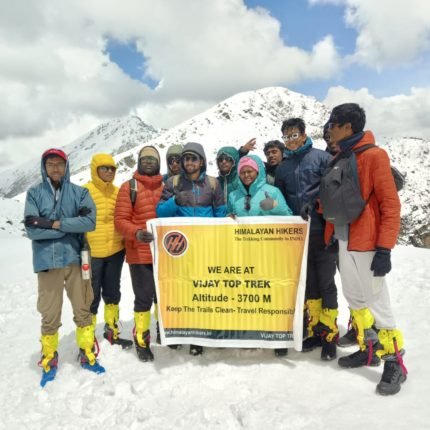
Vijay Top Trek
It’s away from hustle and bustle not known by more people
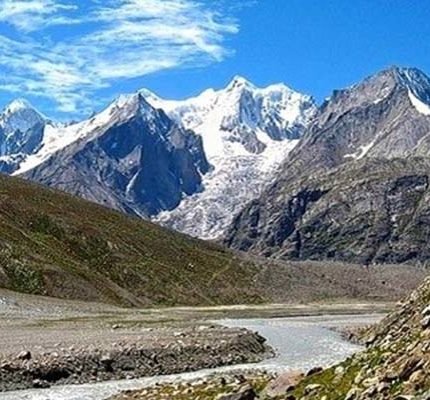
Rumtse to Tso Moriri Trek
Lake Moriri or Tso Moriri trek lies in the Jammu and Kashmir region.
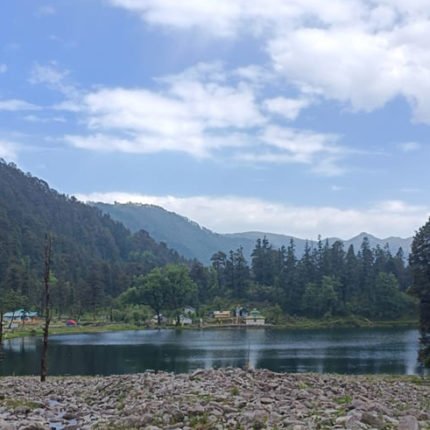
Dayara Bugyal & Dodital Trek
Dayara Bugyal and Dodital Trek follows a similar trek route in Uttarakhand.
Price: ₹ 23,000.00
Book the tour
Book your trek.
- Overview Itinerary Dates Include/Exclude
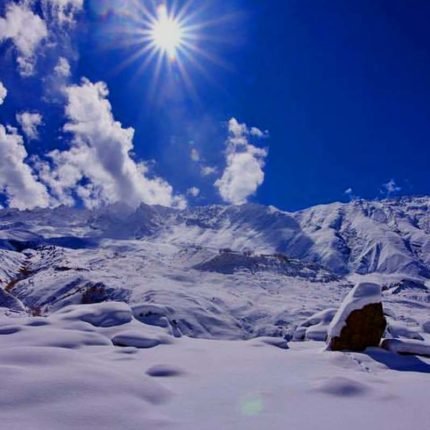

- Best Hikes In The World
- Appalachian Trail
- European Hikes
- Nepal Hikes
- Patagonia Hikes
- See All Hikes
- Mount Kenya
- Mount Kilimanjaro
- Mount Toubkal
- See All Mountains
- South Africa
- New Zealand
- Switzerland
- United Kingdom
- Packing Lists
Chadar Trek – One Of The Most Wild And Beautiful Hikes On The Planet
Asia , India
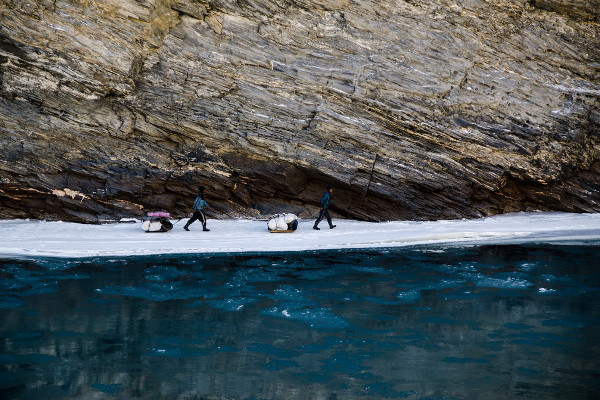
The Chadar Trek, or Zanskar Gorge, is widely known as one of the most difficult treks in the world . If you're an avid trekker, then chances are this wild and challenging trek is on your bucket list.
Chadar Trek Overview
The Chadar Trek is one of the most wild and beautiful hikes on the planet . Frequently covered by the world's top adventure channels and media outlets, the Chadar Trek takes hikers through a frozen river valley into the very heartland of India’s Ladakh region.
The region’s harsh desert environment and towering mountains make the Chadar trek one of the most popular treks in the Ladakh area . Very few treks are as remote as the Chadar and even fewer are conducted in high winter. The trek is not for the lighthearted as temperatures are often lower than -10 degrees celsius in the day and -20 at night.
Cut off entirely from the outside world, the Zanskar river is the only outlet for locals wishing to venture further into the Ladakh region. The trail has been used for nearly a thousand years by the Buddhist monks living in the region. You’ll trek the same route, walking over the frozen river as you cut a path towards Naerak. You will need to have a good level of stamina and fitness to have a really good time.
Accommodation is riverside camping.
Please Note: The Chadar trek is ideally suited to seasoned trekkers looking to experience one of the most remote places on earth.
Regional Map
The Chadar Trek is located in the Zanskar region of Ladakh which is part of the Indian state of Jammu and Kashmir .
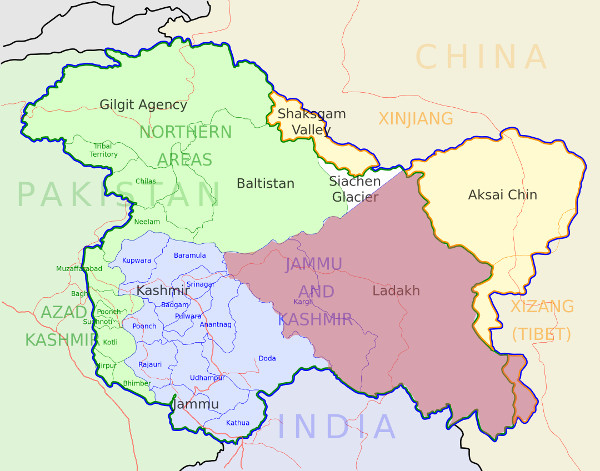
Chadar Hike Itinerary
Below is a detailed Chadar Trek itinerary. Please note that this is a typical itinerary that we would expect many operators to adhere to. However, some tour operators offer variations on this route.
Day 1-2: Arrival in Leh (3500 m)
After taking a flight from Delhi, you will arrive in Leh – the highest airport on earth! Take in the cool mountain air as you explore town before bedding down in your hotel for the night.
Day 3: Drive to Chilling – Hike to Tilad Do (3100 m)
After breakfast, your operator will take you by car to your starting point at Chilling roughly 3 hours away. Along the way, you will no doubt visit the important Buddhist temple of Shanti Stupa. Once in Chilling you will drive a little further to Tildad Do where your hike begins. The drive is fairly high and windy and you’ll need to hold your nerve as the road becomes tighter and more narrow.
You will then trek for several kilometres to reach your first coming ground. Along the path, you will walk for the first time on the river ice and get to grips with the cold weather of the region. Set up your tent quickly before the cold night sets in!
Day 4: Tilad Do to Shingra Koma (3170 m)
Today, you will be walking for almost 12 km as you venture along the valley floor towards your campsite at Shingra Koma. Make sure to follow the lead guide as you will be walking on river ice that can often crack.
As you walk, make sure to take in the incredible rock faces and surrounding snow-capped peaks as you walk in the footsteps of generations before you. The landscape is truly spectacular during winter and very few people get to witness such remote valleys.
Day 5: Shingra Koma to Tib Cave/Tibb (3225 m)
Today, you continue your journey along the river valley taking in the incredible gorges and frozen inlets as you venture towards Tib Cave.
The cave is a huge opening in the rock face in which you will camp for the night to shelter from the snow. Make sure to drink plenty of butter tea to keep your body warm and strong.
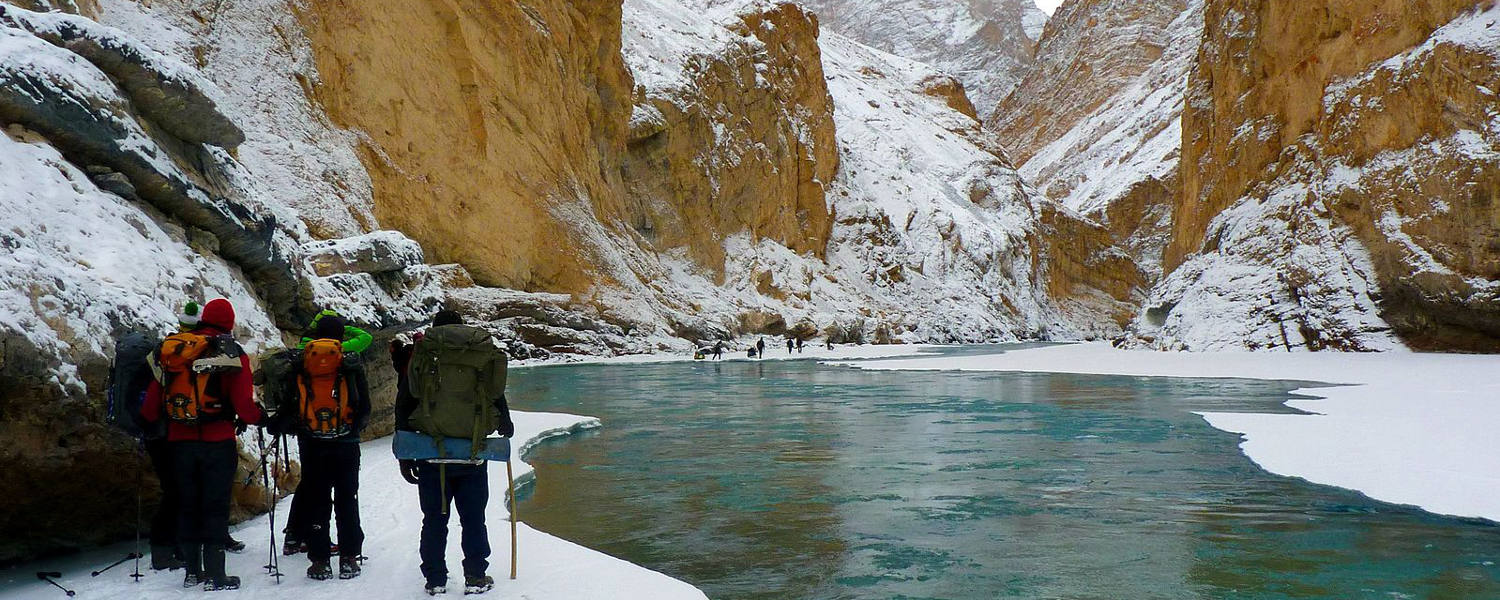
Day 6: Dib Cave/Tibb to Camp at Naerak (3390 m)
Today, you’ll be walking for roughly 10km as you trek the most beautiful section of the valley. Along the route you’ll be dazzled by one of the world's largest frozen waterfalls and large prayer flags fluttering in the cool breeze.
In the late afternoon, you’ll reach the village of Naerak where you have the chance to explore and talk to the locals – maybe share a drink or two!
Day 7: Naerak to Tibb
Today, your return journey begins as you proceed back to Tibb. However, your path may very well be different as the river reacts to the slightest temperature changes. Sections that were frozen may now be running and vice versa. Always follow the steps of your guide.
Day 8: Tibb to Shingra Koma
As you return down the river valley, you’ll have plenty of time to react on the stunning landscape and take pictures to show your relatives and friends back home. Keep a sharp eye out for wildlife including foxes, ibex and the elusive snow leopard. Although rarely spotted, you can be assured the leopards are watching.
Day 9: Shingra Koma to Chilling – Chilling to Leh
This is your last day on the Zanskar River. You’ll trek back to Tilad Do where you will say a final goodbye to the locals before taking a car back to Leh. Relax in a warm and cozy bed for the night to rest your tired muscles.
Day 10: Departure
Today, you say farewell to your crew and depart Leh for Delhi. Here, you will take your international flight home.
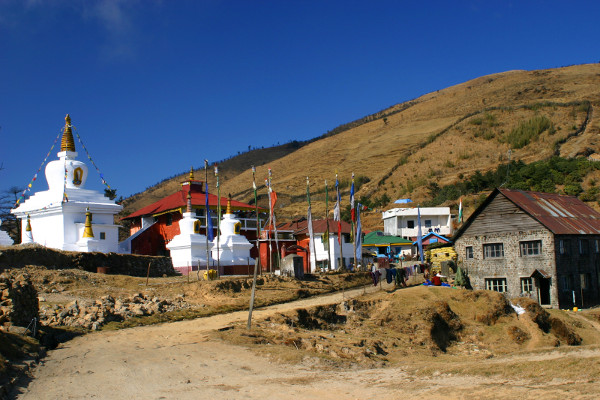
Chadar Trek FAQ
How much does the chadar trek cost.
The cost of the Chadar Trek varies depending on what operator you use. Local agencies often offer a guided trek for as little as US$250 per person (excluding flights). However, for an established western operator, you should look to pay at least double this. The trek can be dangerous and finding the right operator is important as your safety should be paramount.
You will also need to factor in flights, equipment, visas, vaccinations and food and drink. Each operator will offer a slightly varying package when it comes to food and drink on your trek.
- Visa, Vaccinations, Insurance etc: ~$300-$500
- Equipment (buying and hiring): ~$300-$800
- Flights to Leh: ~$1,000
- Tour Agency: ~$250 – 350 for a cheap local agency to ~$500 – 1000 for a Western trekking agency
- Tips: ~$50-$100
- Misc (additional food, unplanned travel / hotels ect): $200
- Total Costs: $2,200 – $4000
Are permits required for the Chadar Trek?
Permits are generally included with your trek costs. However, operators will often ask you to pay around US$50 for a wildlife/environment charge levied by the Indian government.
When is the best time to complete the Chadar Trek?
The best time to trek the Chadar Trek is January and February during the peak winter season . This is when the river is frozen and can be walked on (gently).
The Chadar Trek does not operate at any other point in the year.
Is altitude sickness a risk on the Chadar Trek?
Yes, the entire area is at high-altitude, and you’ll want to make sure you arrive several days before your trek to acclimatise to the thin air.
It is important to have a detailed understanding of the risks associated with high altitude trekking and how the body acclimatises.
We recommend you read our detailed article on Altitude Sickness and Acclimatisation .
How difficult is the Chadar Trek?
The Chadar Trek is considered to be one of the toughest treks in the Ladakh Region. The trail is cold, icy, often steep and always at high altitude.
Only experienced trekkers are recommended for this trek. You will need to be in good physical condition before attempting the route and have a good stamina built up.
The freezing temperatures also make the trek difficult with temperatures often exceeding -20 degrees at night and -10 degrees during the day.
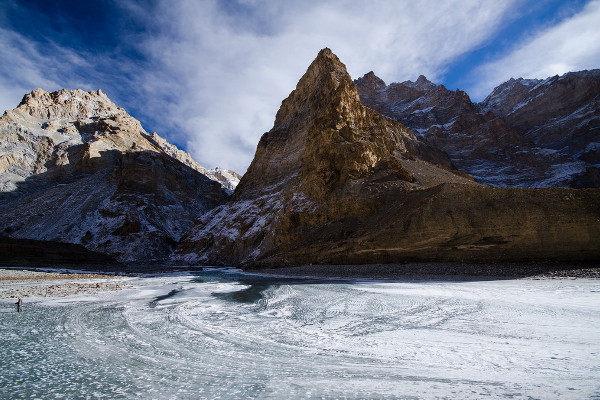
What gear do I need for the Chadar Trek?
Trekking in the Ladakh region requires a number of essential pieces of trekking clothing and equipment. The Chadar trek however requires some cold weather gear that is often not nesscary on the summer treks.
Many pieces of equipment can be rented or bought in Leh, but we recommend bringing the most important pieces of gear with you. The important thing is warmth. You’ll need a winter sleeping bag (may be provided) and good quality thermal gear.
To help you plan and prepare for your trek, we have written a detailed hiking gear list for multi-day treks .
What travel insurance do I need for the Chadar Trek?
Trekking insurance is a must on multi day hikes. This is particularly important on the Chadar Trek which is extremely remote. If an accident should occur that requires medical assistance and evacuation you will definitely want trekking insurance that can cover the costs of air ambulance and treatment.
Moreover, it is prudent to have insurance that covers you for any travel related risks, like lost, stolen, damaged or delayed baggage; flight delays and interruptions; and tour operators default.
Moreover, it is prudent to have insurance that covers you for any travel related risks, like lost, stolen, damaged or delayed baggage; flight delays and interruptions; and tour operators' default.
Are there any recommended guidebooks for the Chadar Trek?
There are a number of excellent guides we recommend for the Chadar Trek. These are:
- Trekking in Ladakh by Radek Kucharski.
- Trekking in the Indian Himalaya by Lonely Planet
- Trekking Guide to the Western Himalayas by Depi Chaudhry
- Ladakh: the Essential Guide: Including Kashmir & Manali by Partha S. Banerjee
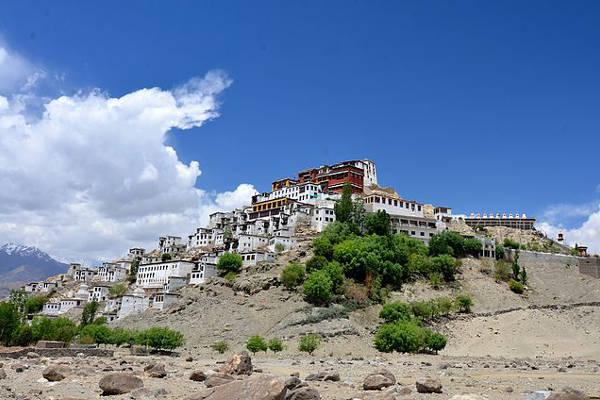
Are there other Indian Hikes besides the Chadar Trek?
Absolutely. We also recommend doing hikes like the Singalila Ridge , Markha Valley and Ladakh for unparallelled sightseeing and experiencing Indian culture and history firsthand.
Continue browsing
See more information on India . Or check out these other Indian Hiking articles:
- Hiking the Himachal Pradesh
- Trekking the Uttarakhand
- Roopkund Hike India
- Arunachal Pradesh India Treks
- Guide to India hikes
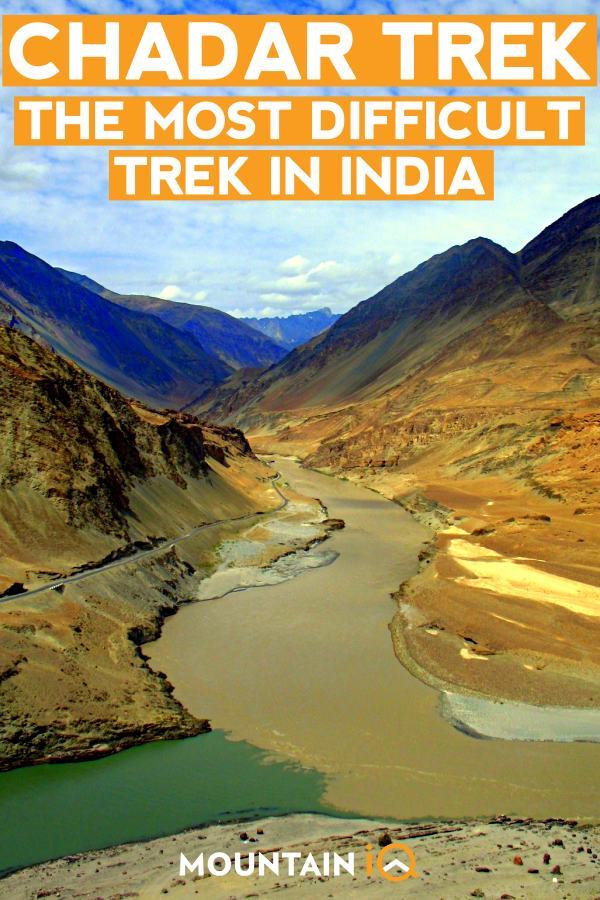
About the author
Mark Whitman
Mark has trekked extensively in Asia, Europe, South America and Africa. He founded Mountain IQ in 2014 with the sole aim to be the best online information portal to some of the most popular mountain destinations around the world. When not writing for Mountain IQ, Mark is out exploring the outdoors with his wife!
Leave a Reply
Your email address will not be published. Required fields are marked
We work with local guides to offer great value adventures at unbeatable prices

- Trekking & Travel Events
- Travel Organizations
- Himalayan Treks
- Maharashtra Treks
- Karnataka Treks
- Travel Guides
- Weekend Getaways
- Trekking Tips & Advice
Chadar Trek: The Ultimate Guide for 2024!
- Trekking Destinations
Embark on a journey across the frozen Zanskar River, amidst snow-clad landscapes and majestic mountains. Welcome to Chadar Trek, the ‘Frozen River Trek’, a thrilling adventure deep within Ladakh’s icy wonderland. This blog post offers comprehensive information about this unique trek, from travel and accommodation to gear, guides, and permits. Read on to unravel the mysteries of the trek.
- Max Altitude: 11,123 Ft. (3,390M)
- Average Trekking Fees: ₹20,000 – ₹25,000
- Distance: 60 – 65 kms
- Difficulty: Difficult
- Duration: 7-8 days
- Ideal For: Experienced Trekkers Only
- Best Season: January - February
- Region: Ladakh
Table of Contents
Introduction to Chadar Trek

Imagine embarking on a journey that takes you across a frozen river blanketed by a sheet of ice, with majestic mountains and snow-covered landscapes as your backdrop. This is the essence of Chadar Trek , one of the most thrilling and unique experiences trekking in India offers.
Known as the ‘Frozen River Trek’, the trek unfolds in Ladakh’s icy wonderland. The Zanskar River, cloaked in a thick layer of ice during winter months, creates an enchanting pathway for trekkers. This extraordinary natural phenomenon, where the river transforms into a frozen highway, is what gives the trek its name – ‘Chadar’ means blanket in Hindi.
The appeal of the trek lies not only in its unique setting but also in its cultural significance. For centuries, this icy path has been used by locals as a trade route during winters when all other paths are blocked by heavy snow. Now, it’s a sought-after adventure for thrill-seekers worldwide, drawn by the combination of physical challenge and breathtaking scenery.
As for timing your trip, the best time to go on the trek is from January to February . It’s during these chilly months that the Zanskar River freezes solid enough to walk on. But brace yourself – temperatures can drop down to -30 degrees Celsius at night !
A word of caution before you pack your bags for this adventure: this trek is not for the faint-hearted! The freezing temperatures, high altitude and challenging terrain require trekkers to be physically fit and mentally prepared. It’s recommended that participants have prior trekking experience and are comfortable with walking 5-6 hours daily on uneven icy terrain.
Ready to conquer the icy expanse? Strap up those trekking boots! The frozen river awaits…
Preparing for Chadar Trek
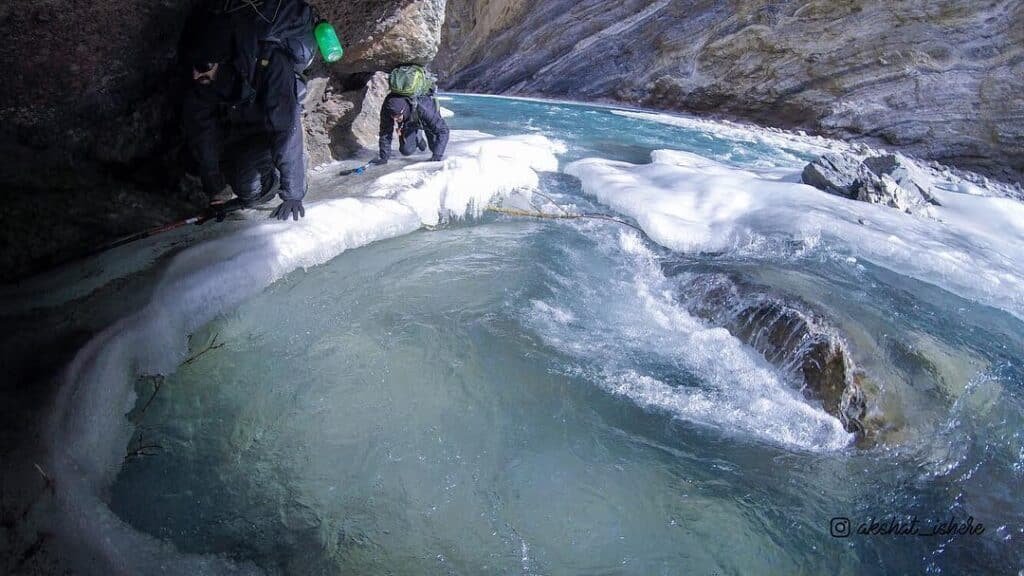
Adventure doesn’t knock on your door, you need to go knocking!
And when you’re knocking on the door of an adventure like the frozen river trek, preparation is key. So let’s dive in!
Physical Fitness Preparation
To conquer the icy path, you need a fair amount of physical fitness. High-altitude trekking is not a walk in the park! You’ll be treading on a frozen river, battling low temperatures and thin air. Regular cardiovascular exercises can be your best ally here. Engaging in activities such as running, cycling or swimming for at least 30 minutes every day, about two months prior to the trek can significantly boost your stamina.
Essential Gear and Equipment
As the saying goes, “There’s no such thing as bad weather, only unsuitable clothing”. For the trek, gear up with winter essentials such as:
- Trekking Shoes: Opt for high ankle waterproof shoes with good grip.
- Insulated Water Bottle: Hydration is crucial at high altitudes.
- Headlamp: Power cuts are frequent in Leh.
Remember to pack light yet smart!
Recommended Clothing
In the brutally cold terrain of Zanskar River valley, your clothing is your lifeline. Layering is the secret sauce to withstand the extreme temperatures.
- Base Layer: Thermal innerwear that traps body heat.
- Middle Layer: Fleece jacket for insulation.
- Outer Layer: Waterproof and windproof jacket.
Don’t forget thermal socks, woollen cap, gloves and sunglasses!
Acclimatization and Altitude Sickness
High altitude equals low oxygen levels. Your body needs time to adjust to this new environment – a process called acclimatization.
Importance of Acclimatization
Acclimatization minimizes the risk of altitude sickness which can turn fatal if ignored. Spending two days in Leh before starting the trek can help your body acclimatize.
Symptoms and Prevention of Altitude Sickness
Watch out for symptoms like headache, nausea or breathlessness. If you notice any of these signs:
- Descend immediately
- Keep yourself hydrated
- Avoid tobacco and alcohol
Tips for Acclimatizing Properly
- Increase altitude gradually
- Maintain a healthy diet
- Stay hydrated
Remember, slow and steady wins the race! Take it easy on the first few days of trekking.
Embarking on this difficult trek demands grit, determination and above all – thorough preparation. With these tips in your toolkit, you’ll be ready to brave the Icy Wonderland! The majestic Zanskar awaits you – tread its frozen path and etch an unforgettable memory into your adventurous hearts!
Getting to the Chadar Trek Base
The journey to the trek begins with an exhilarating travel to Leh, a high-desert city in the Himalayas. Nestled at an altitude of 3500 meters, Leh isn’t just any pitstop. It’s the gateway to your ultimate adventure!
Flights are the most convenient way to reach Leh, with regular services from Delhi. The aerial view of snow-capped mountains is a sight that sets the mood for your trekking expedition. Alternatively, if you’re up for a road trip, there are buses from Manali and Srinagar, but remember these routes are accessible only during summer and not during winter, so the only way to access Leh is via flights during the winter season .
Once you touch down in Leh, don’t rush off to the base camp yet! Your body needs time to adjust to the high altitude. Spend a couple of days exploring Leh’s charming monasteries and bustling markets. This period of acclimatization is crucial for a successful trek ahead.
With lungs full of mountain air and hearts pounding with excitement, it’s time to set off towards the trek base camp located at Chilling. There are shared taxis available from Leh which will take you on a scenic drive along the Indus River till you reach Chilling.
From Chilling, it’s a small hike to Tilad Do, your first encounter with the frozen Zanskar River and your actual starting point of this icy adventure. Be prepared as this is where reality hits – The Chadar Trek is not just another walk in the park!
While the journey to reach Chadar can seem daunting, Nomads of India are here to guide you every step of the way.
As we always say – The journey matters as much as the destination!
Budget & Costing
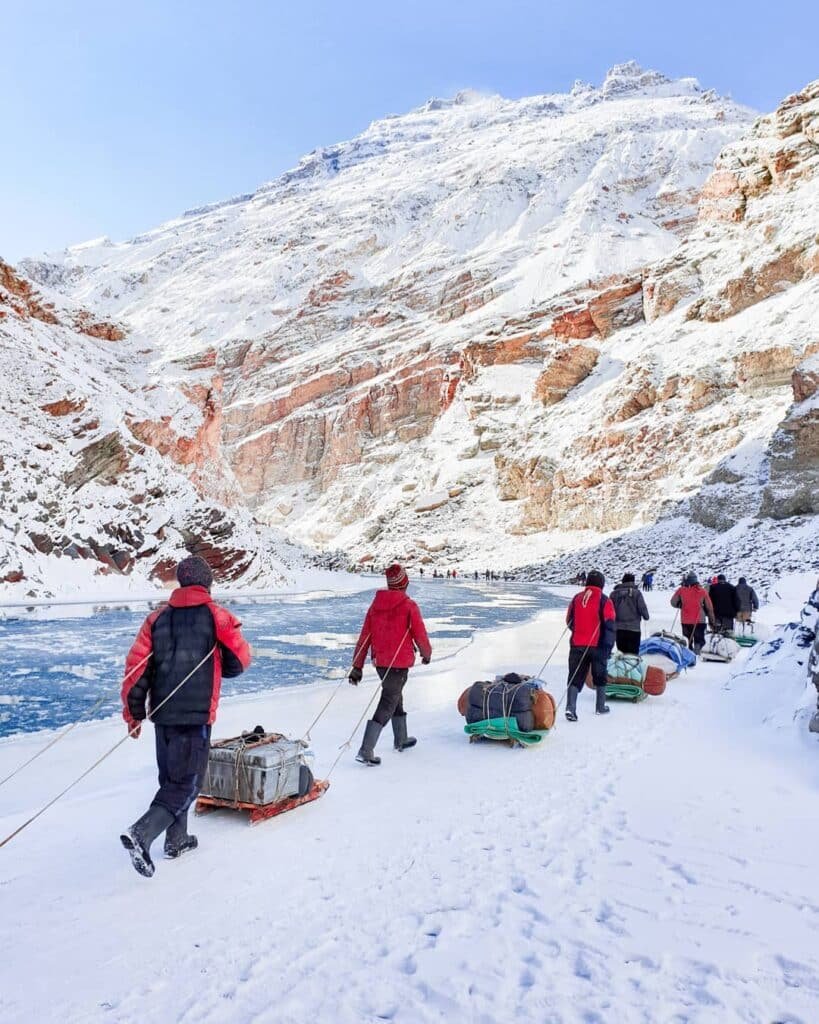
Before embarking on this adveture, it’s essential to plan your budget carefully. The total cost would depend on various factors such as mode of travel, accommodation type, gear and equipment, guides, permits, and other miscellaneous expenses.
Here are some estimated costs for your reference:
- Flights: A round trip flight from Delhi to Leh can range anywhere between ₹10,000 – ₹20,000 depending on when you book.
- Accommodation: Budget hotels in Leh can cost around ₹ 1,000 – 2,000 per night while a more luxurious stay can go up to ₹ 5,000 per night.
- Trekking Gear: Buying new trekking gear can hit your wallet hard. Consider renting equipment like trekking shoes, insulated water bottles and headlamps which can cost around ₹ 1,000 – 2,000 .
- Trek Package: A comprehensive package from a reputed trekking company usually costs between ₹ 20,000 – 25,000 . This generally includes accommodation, meals during the trek, first aid kit, guide charges and permit fees. The group size is usually around 20-25 people
Remember that these are estimated costs and actual expenses may vary. It’s always sensible to carry some extra cash for any unforeseen expenses. Happy budgeting!
But hey, don’t just take our word for it! Pack those bags, lace up those boots and let’s get ready for an unforgettable trip of a lifetime! We’ll continue our trekking story in our next section: Itinerary .
Next Stop: A day-by-day guide through this epic journey…
Chadar Trek Itinerary: Your Daily Dose of Adventure
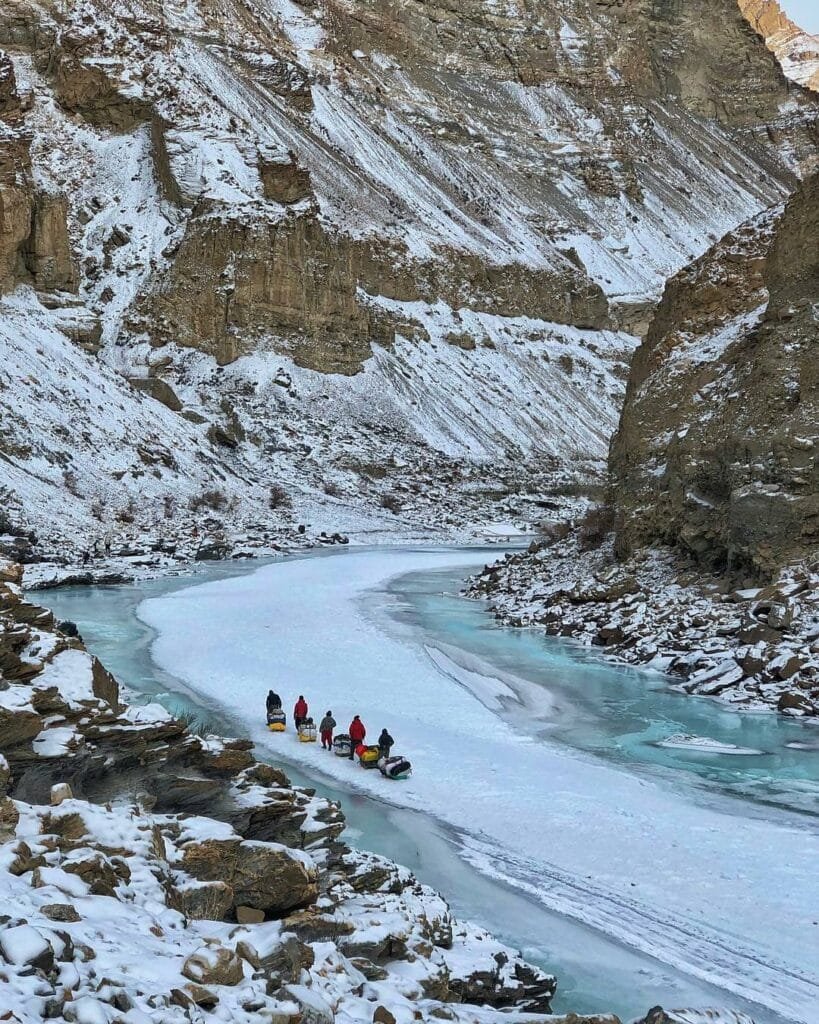
Day 1: Your Arrival in Leh (3,500 M)
Your journey begins in Leh, the gateway to Ladakh with towering peaks. During the winter, the only viable route to Ladakh is by air, and flights from Delhi to Leh provide captivating aerial views of the Himalayas. Make sure to secure a window seat for breathtaking vistas.
Dedicate the first day to acclimatizing to the high altitude. As you transition from sea level, your body will need time to adjust to the mountain environment. While the Leh winters are harsh, this marks just the start of your cold weather experience.
2nd Day: Rest & Acclimatization in Leh (3,500M)
This day focused on helping you adapt to the altitude and climate. Take the opportunity to explore the city market, immerse yourself in the local culture, and visit nearby sites. Gradual movement aids in acclimatization. Also, utilize this time to review your checklist and make any last-minute purchases for the trek. Leh offers an excellent market for trek essentials.
Day 3: Further Acclimatization in Leh (3,500M)
On day three, the process of acclimatization continues. A necessary medical examination at the Tourist Information Centre is planned, playing a vital role in acquiring the required permits from ALTOA and the Wildlife Department for commencing the trek.
4th Day: Trek from Leh (3,500M) to Shingra Koma via Bakula (3,215M)
Distance: 70 km | Duration: 2-3 hours
Today marks the start of your trek as you drive to Bakula, the trek’s starting point. Beginning early, you’ll follow the scenic route along the Indus River, passing the confluence of the Indus and Zanskar Rivers at Nimmu. This picturesque 70 km journey, lasting about 3 hours, treats you to breathtaking views as you navigate narrow hairpin bends. As you approach Bakula, the frozen expanse of Zanskar unfolds before you. Upon transitioning to the Chadar, your trek leaders will guide you in traversing the icy terrain. Embrace the learning curve of walking on this glassy ice using the Penguin Walk technique, and you’ll quickly become adept.
One notable feature of the trek is the consistent, level terrain. There are no steep ascents or descents, and minimal altitude gain reduces the risk of altitude-related issues. Mastering today’s walk signifies adequate acclimatization, boding well for the trek ahead.
The appearance of the Chadar varies with weather conditions. It might be glassy, covered in powdery snow for better traction, or thinly iced in certain sections, requiring navigation through slush or along the riverbank. Safety lies in following the sledge route used by porters.
Depending on your pace, you should reach the next campsite in 3-4 hours. This marks your first night of Chadar camping.
Day 5: Trek from Shingra Koma to Tibb (3,280M)
Distance: 14 km | Duration: 6-7 hours
Waking up to the freezing cold entails leaving the warmth of your sleeping bag and tent. Yet, the hospitable people of Zanskar ensure a comforting start with hot tea and meals. Today’s 14 km journey to the next campsite spans 6-7 hours due to the challenges of Chadar walking. Remember to refill your thermos with warm water, as standard bottles succumb to the cold. Sunlight is a rarity in this gorge, appearing briefly due to the surrounding towering mountains. As you traverse the vast valley, relish the crisp air and the deep blue hue of the Zanskar river, mirroring the sky on clear days. Frozen waterfalls adorn the route. Pause by the river to cook meals and ensure energy levels remain ample. The final stretch to Tibb, about 200 meters, is captivating. Arrival at the campsite is anticipated by late afternoon.
Day 6: Trek from Tibb (3,280M) to Nerak (3,400M)
Distance: 12 km | Duration: 5-6 hours
Day six presents an encounter with the highlight of the trek, Nerak Waterfall. A substantial journey lies ahead, necessitating an early start to reach the waterfall by late afternoon. Amid the Zanskar Valley’s early sun departure, staying active is vital to staying warm. Noteworthy are the broken ice formations in the frozen river, forming captivating geometric patterns. Midway, a unique lunch awaits within a spacious cave. After arriving at the campsite, you’ll visit the awe-inspiring Nerak waterfall, a 30-minute walk away. Keep an eye out for domestic Yaks and relish the sight of the traditional wooden bridge juxtaposed with a modern counterpart. Time spent at Nerak waterfall is followed by dinner back at the campsite.
7th Day: Trek from Nerak (3,400M) to Tibb (3,280M)
Distance: 12 km | Duration: 6-7 hours
Following the exhilarating Nerak waterfall experience, you’ll trace your steps back to the Tibb campsite. The return journey, while familiar, offers a fresh perspective. The ever-changing frozen Zanskar River reacts to temperature fluctuations, transforming its appearance. Listen closely to the evolving sounds underfoot, a captivating aspect of Chadar trekking. Alongside the trail, local porters in traditional attire, called ‘Gonchas,’ demonstrate remarkable ease traversing the icy terrain. Their cheerful greeting of ‘Julley’ resonates – a Ladakhi welcome. Encounters with local songs and their adept sledging add cultural flair. As you penguin-walk to Tibb, the locals effortlessly overtake you.
Day 8: Trek from Tibb (3,280M) to Bakula (3,215M) and Return to Leh (3,500M)
Distance: 12-13 km | Duration: 7-8 hours
The final leg takes you full circle to Bakula, a 7-8 hour trek. From there, a 3-hour drive returns you to Leh, where you’ll spend the night in a hotel.
Day 9: Departure from Leh
The trek concludes. Given the unpredictable high-altitude weather and conditions, allocate buffer days between the trek’s end and your departure to accommodate travel arrangements.
“Every day on Chadar Trek is different, bringing new challenges and experiences!”
Camping & Accommodation
On the trek, your home under the stars changes every day! Camping sites are allocated by authorities based on safety considerations. You’ll be provided with high-quality tents that can withstand harsh weather conditions.
Activities & Attractions
Chadar Trek isn’t just about challenging yourself physically; it’s also about immersing yourself in nature’s beauty. From watching a sunrise over frozen Zanskar, visiting ancient monasteries in Leh, and walking through fascinating ice-formation landscapes, each day promises new sights that will leave you spellbound!
“Chadar Trek isn’t just a journey; it’s an experience that stays with you forever.”
Up Next? A Peek Into The Highlights Of Chadar Trek
But wait! There’s still so much more we haven’t touched upon —like those hypnotic frozen waterfalls or our encounters with local culture! So let’s continue our snowy saga and explore some highlights from this once-in-a-lifetime adventure!
Highlights of Chadar Trek
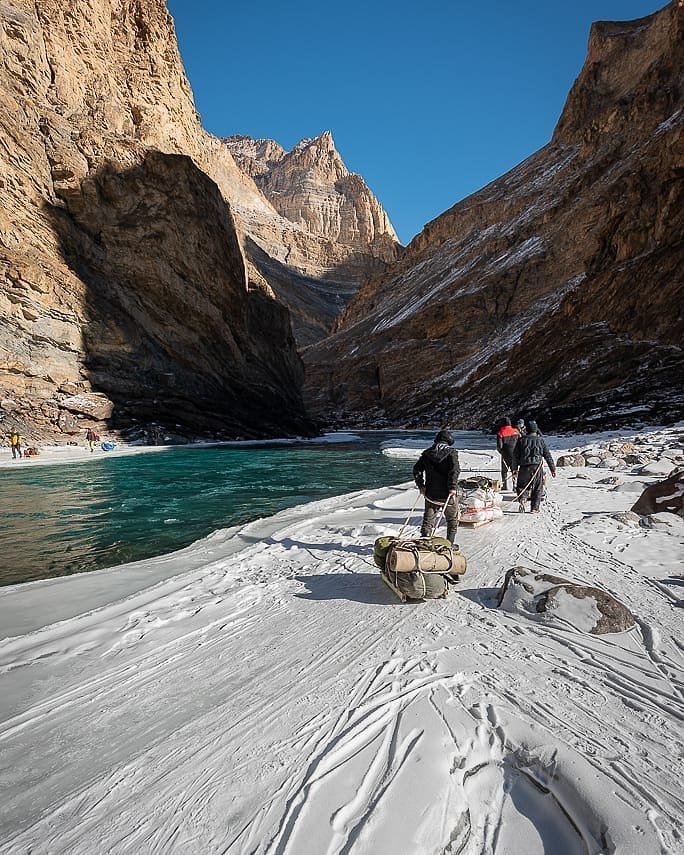
Embark on a journey where each step unveils a new wonder, each turn presents a vista more stunning than the last. Be it the awe-inspiring frozen waterfalls or the tranquil Zanskar River , this trek is replete with unique experiences and unforgettable sights.
Dance with Frozen Waterfalls
Imagine a waterfall, frozen in time, creating a spectacle so surreal that it leaves you breathless. The trek introduces you to such magnificent frozen waterfalls, an ethereal artwork of nature that defies description. It’s akin to walking through a dream, where cascading waters have been paused mid-fall, held captive by the cold winter air.
Surrender to Zanskar’s Charm
Next on the list is the hypnotic allure of the Zanskar River. Dressed in its winter attire, a glossy sheet of ice, it’s truly mesmerizing. The river becomes your constant companion along the trek, its gentle whispers echoing through the silent valleys. As you walk over its icy surface, you’ll be treated to views so enchanting they seem straight out of a fairy tale.
Lose Yourself in Nature’s Artistry
The landscapes here are nothing less than divine poetry etched in snow and ice. Each day breaks to unveil scenic views that can move even the most hardened hearts. The pristine white snow fields contrasted against clear blue skies will leave an indelible impression on your soul.
Immerse in Local Culture
Finally, don’t miss out on embracing the rich local culture of Ladakh. This trek isn’t just about physical endurance; it is also about understanding and appreciating the resilience of locals who thrive in these harsh conditions. Interact with them; their warmth and hospitality will add another layer to this already fulfilling experience.
The Chadar Trek experience ? It’s more than just an adventure. It’s a transformation, a shift in perspective that only the daring ones get to witness. The frozen Zanskar river beneath your feet, the milky way above your head at night, and the adrenaline rush piercing through your veins – it’s an unforgettable journey etched in ice and memories.
Recall those moments of struggle, pushing through physical boundaries, braving extreme conditions. Remember how you emerged stronger, filled with a sense of achievement? That’s personal growth! You didn’t just conquer a trek; you conquered yourself.
“It’s not the mountain we conquer but ourselves.” – Edmund Hillary
And now? Now it’s time to pass on the torch. Encourage others to step out of their comfort zone and embrace this icy adventure. Share your experiences, tell them about the breathtaking views, the thrill of walking on a frozen river, and the silence of the mountains.
Because at the end of the day, it’s not just about reaching the summit or completing a trek. It’s about experiencing something extraordinary, something that makes your heart race and eyes sparkle with wonder.
So go on, and inspire someone today to embark on their own trek adventure. For there is no joy greater than inspiring another soul to explore the beauty of this world.
Don’t forget – every mountain top is within reach if you just keep climbing.
The Chadar trek has not been banned. However, it’s important to note that the status of trekking routes and regulations can change over time. Before planning your trip, it’s advisable to check with local authorities and tour operators for the most up-to-date information on trekking permissions and bans.
The cost of the Chadar trek can vary depending on several factors, including the tour operator you choose, the duration of the trek, the inclusions (such as accommodation, meals, transportation), and any additional activities. On average, the cost could range from approximately ₹20,000 to ₹35,000 or more per person. It’s recommended to compare different tour packages and choose one that aligns with your budget and preferences.
Yes, the Chadar trek is considered to be a challenging and potentially risky adventure due to its extreme weather conditions and the frozen Zanskar River. The temperatures can drop significantly, and the frozen river conditions can change rapidly, leading to cracks or holes in the ice. Trekkers need to be prepared for sub-zero temperatures, altitude-related concerns, and the unpredictable nature of the ice. Proper planning, experienced guides, and appropriate gear are crucial to mitigate the risks associated with this trek.
The Chadar trek is known for its difficulty and harsh conditions, making it less suitable for beginners. It demands a certain level of physical fitness, mental resilience, and prior trekking experience. It’s advisable for individuals attempting the Chadar trek to have some experience in high-altitude treks, cold-weather conditions, and challenging terrains. If you are a beginner, it’s recommended to gain trekking experience on less demanding trails before considering the Chadar trek. Always consult with trekking experts and guides to assess your readiness for such a demanding adventure.
- trekking guides
- No comments yet.
Add a comment
Leave a reply · cancel reply.
Your email address will not be published. Required fields are marked *
This site uses Akismet to reduce spam. Learn how your comment data is processed .
- Share via...
India's Highly Recommended Trekking Company
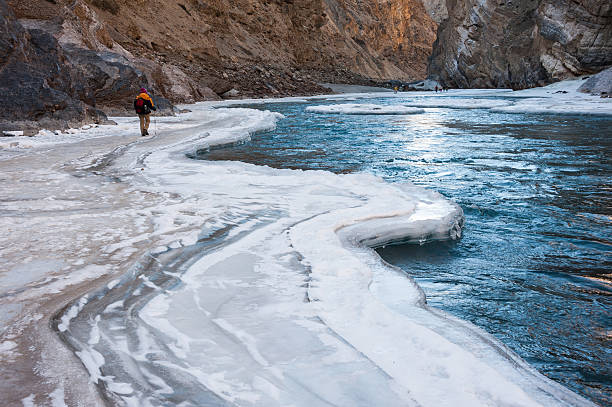
Chadar Trek (Frozen River)
₹35,000 (flat 40% off), ₹ 21,000, (leh hotel to leh hotel), service tax @ 5% (gst), + single tent occupancy: ₹ 2,000, + backpack offloading: ₹ 5,000, batch availability.
- Overview & Itinerary
Chadar Trek in Ladakh is a unique experience, unlike any other trek in the Himalayas. Walking on a frozen river with towering mountains on either side is simply breathtaking. The trek, situated at an altitude of 11,150 feet, feels like a journey to the North Pole with temperatures dropping to -30 degrees. It's an experience of a lifetime that shouldn't be missed by any hiking enthusiast.
The Chadar Trek is an exciting winter trek on the frozen Zanskar River, with sightings of blue sheep, snow leopards, and ibex adding to the adventure. This expedition is one of the most breathtaking experiences on Earth, as you trek across the ice and snow and revel in the beauty of the frozen surroundings. The rewards of this trek are truly unforgettable, and the chance to discover the natural wonders of the Himalayas is something that cannot be missed.
The Chadar Trek in the Leh region of Ladakh is a popular winter trek and one of the longest in the Indian Himalayan region, covering 62 km in 9 days. It is a dream for many trekkers, as it offers magnificent scenery and challenges, such as walking on a frozen river. The trek is a test of endurance and perseverance in extreme weather conditions, but the sense of achievement and the natural beauty of the region make it all worthwhile.
The Chadar Trek offers more than just walking on ice over the Zanskar River, it also attracts adventure seekers with its unique and breathtaking sights along the way. The trek begins at the Magnetic Hill and takes you through fascinating frozen waterfalls, towering cliffs, and stunning landscapes. The experience is truly out-of-this-world, making it a must-try for those seeking an unforgettable adventure.
Best Time to Visit: The optimal time for the Chadar Trek is from mid-January to mid-February as the Zanskar River freezes, and trekkers can traverse unbroken rivers of ice. This period offers a captivating landscape, and the experience will become a cherished memory.
Trek Itinerary
Arriving at Leh airport is a breathtaking experience, with stunning views of snow-capped peaks just before touchdown. Known for its picturesque setting, be sure to keep warm clothes handy as the chilly climate may surprise you. The airport's location in the valley adds to its charm and offers visitors a unique perspective on the surrounding landscape. Don't forget to take in the stunning scenery before heading off to explore the rest of what Leh has to offer.
- Keep your woolen cap and gloves handy at the Airport.
- Airport pickup is not included in the cost.
- Orientation Briefing of the trek at 12:00 noon (Mandatory)
- Check-in Hotel (10:00 am | centrally heated room | attached washroom in running condition | hot water in buckets.
- Bring a copy of your ID proof and 2 photographs. Foreigner, a copy of passport and visa.
- Keep the boarding pass with you, it will be needed for permission on the third day.
- The network is available (only post-paid).
- ATM is available.
- Visiting any very high-altitude place or pass is not advisable.
- Consumption of alcohol and smoking is strictly prohibited.
- Spend the day in the room itself to acclimatize.
New regulations for the Chadar Trek require trekkers to spend at least two days in Leh to acclimate to the weather conditions and prevent altitude sickness. This health problem, commonly known as AMS, has become a concern and should be taken seriously. Strict adherence to this rule is essential to ensure trekkers' safety while enjoying the beauty of the Chadar Trek.
- Rest + Acclimatisation day.
- Sightseeing is included in the cost (Hall of Fame, Shey Monastery, Thiksey Monastery).
- Visit any very high altitude place or pass is not advisable.
- Stay in Hotel | centrally heated room |attached washroom in running condition | hot water in buckets.
Today is a crucial day as it determines the next steps. It's advised to wake up early and head to the Medical Camp promptly to avoid any delay due to the tourist crowd. The tests, though quick, might take longer than anticipated. The afternoon is reserved for finishing any insurance formalities required. This day's outcome will have a significant impact on what's to come, so make sure to be punctual and prepared.
- Wake up early and get ready for medical tests | height & weight, blood pressure, and oxygen level.
- Drive/Walk to the Government Medical camp.
- Get your Oxygen and BP reading (There is a long queue due to the rush of tourists. It may take 3-4 hours depending on the rush).
- Late afternoon insurance formalities.
- Enjoy the evening in Leh.
Today, you will journey towards the first campsite at Tsomo Paldar via Chilling and Shingra Koma. Shingra Koma is a distinctive spot in Chadar, located at a U bend in Zanskar. It offers breathtaking views and is sure to be a highlight of your trip. This will be a highly picturesque drive, allowing you to take in plenty of stunning landscapes along the way.
Walking on the thin layer of Chadar in this region can be challenging, especially with gumboots on. However, the sight of various rock formations along the way provides a mesmerizing view. Identifying the fragile and steady ice surfaces may take time, but with patience, it can be accomplished. Gradually, walkers can understand the ice patterns and know which surface is safe to walk on.
- Breakfast at the hotel included in the cost
- Drive: Shingra Koma 75 km, 3-4 hrs
- Gumboots are mandatory
- Carry two thermos flasks of 1 liter each
- Hot lunch on the way
- Stay in tents | triple sharing
- Drive through Gurudwara Pathar Sahib (3,500 m / 11,500 ft), Magnetic Hill (3,350 m / 11,000 ft), and the confluence of the Zanskar and Indus (3,100 m / 10,200 ft)
Note: When walking in gumboots, expect to slip and fall occasionally. To protect your back during falls, consider bringing a small backpack. Additionally, be prepared for a slower pace than normal.
Chadar trek gradually gains altitude from Tsomo Paldar to Tibb Cave, taking around 6-7 hours to cover a distance of 400 ft. With a starting altitude of 11,400 ft and reaching 11,800 ft, the trek is unique as it does not involve quick successions of altitude gain. Trekker spends a chilly night in the tent at Tsomo Paldar before embarking on the trek. There are frozen waterfalls in the Zanskar region whose origins are unknown, leading to many myths among locals. A hike through this region will allow you to follow the powerful Zanskar River and enjoy its calming emerald-green waters. A midday break for lunch is provided at Tibb Cave.
- Make sure you fill your thermos with warm water before you leave
- Pass through a waterfall that never freezes
- It will be sunny only around 9-10 in the morning
- Hot Lunch on the way
- Visit a small cave, in that cave the local porters rest for the night
The 13 km long trail towards the Nerak campsite is the most anticipated part of the Chadar trek. It leads to the most iconic landmark of the trek- the frozen waterfall, which is a masterpiece of nature and a favorite of trekkers worldwide. The trek will offer a hot lunch break before reaching Nerak. The Nerak will be the coldest campsite on the trek, with temperatures dropping to as low as -30°C at night. It is crucial to layer up with appropriate clothing to withstand the bitter cold. However, if you make it to the waterfall on time, there may be an opportunity for something special.
- Attraction Frozen waterfall
- Nerak is the first village in the Zanskar region
- If we reach Nerak Camp on time, we can go to Nerak village
- Stay in tent | triple sharing
The Chadar trek is notorious for its unpredictable weather patterns, with instances of the ice formations disappearing on the way back from Nerak. Nevertheless, new layers of Chadar may form during the journey. Regardless of the route, the terrain remains challenging and exciting for trekkers willing to explore this unique experience. The trek requires careful attention to the weather conditions and suitable gear for the sub-zero temperatures. Despite the hardships, the trek is a fulfilling and memorable adventure with stunning natural beauty and cultural significance. Chadar Trek is a must-do for any trekking enthusiast. Eight days of walking on a frozen river in the Himalayas will be an unforgettable experience that will leave a lasting impression. These will be some of the best days of your life, and the memories will stay with you forever.
Take the return route to Tibb Cave for one last trip down memory lane. Take in the sights and bid farewell to the locals en route. Savor your final stay in the tents, but be cautious as you do so.
Wake up early to begin a long walk back, but don't think of it as simply retracing steps. Many things could have changed along the way, such as the melting and thinning of the Chadar or the beauty of visible rocks. This is the beauty of the Chadar trek and nature itself. Finally, reach Shingra Koma and prepare yourself for the journey ahead.
- Drive to Leh 70 km, 3-4 hours
- You will reach Leh by the evening
- Stay in a hotel (Centrally heated room) (Running hot water in taps)
After completing your trek in Ladakh, there are plenty of other sights and experiences to enjoy. You could explore the historic Leh Palace, visit the Shanti Stupa for stunning views of the city, or head to Pangong Lake for a peaceful retreat. Additionally, make sure to try delicious local food and immerse yourself in the unique culture of the region. With so much to see and do, your stay in Ladakh is sure to be unforgettable.
The cab will be arranged at an additional cost from Trekkaro Leh Hotel to Leh Airport. (Check-out time: 10:00 AM)
How to reach
The best way to reach Leh is by taking a flight to Kushok Bakula Rimpochi Airport, which is located just 4 km away from the main city. The airport is well connected to Delhi and other major cities in India and also receives flights from Srinagar, Jammu, Chandigarh, and Mumbai. International travelers can also reach Leh via this airport.
Upon arrival at Leh airport, Trekkaro will take responsibility for all your further travel arrangements. Whether you need help booking transportation to your next destination or planning your next outdoor adventure, our team will be there to provide expert guidance and exceptional service. You can sit back and relax, secure in the knowledge that Trekkaro has everything covered. With our local knowledge and vast network of trustworthy partners, we'll make sure your journey is seamless and stress-free from start to finish.
There is no direct or indirect train to Leh.
Due to heavy snowfalls in Ladakh, the Manali-Leh Highway and Srinagar-Leh Highway are not accessible during winter, prohibiting travel by both road routes.
The Manali-Leh and Srinagar-Leh highways usually close by October or November due to heavy snowfall in the region. These highways connect various remote areas in the Northern region of India, including Leh-Ladakh. The closure of these highways leads to a complete cut-off of Leh from the rest of India during the winter season.
Things to carry
- Basic Gears
- Accessories
- Mandatory Documents
• Backpack & Rain Cover (40-60 Litres)
• Trekking Shoes
• Gum Boots
• Trekking Pole
• LED Torch/Headlamp
• Two Water Bottle (one liter each)
• Basic Medications (or prescribed if any)
• Trekking Jacket
• Three (Five in winter) Warm Layers
• Two trek pants (one Wear and one carry)
• Two collared t-shirts
• Thermals
• Sunglasses
• Sunscreen Lotion (SPF 50/70)
• Lip Balm (SPF 30)
• Sun cap
• Synthetic hand gloves
• Two pairs of Socks
• Raincoat/Ponchos
• Daypack (20 liters), if you opt to offload your backpack
• Toiletries
• Cutlery & Lunch Box
• Plastic cover (for wet clothes)
• Original and photocopy of government photo identity card- (Passport, Aadhaar Card, Driving license, or voter ID)
• Passport size 2 photographs
Terms & Conditions
1. Accommodation : (as per itinerary)
- Guest house (centrally heated room)(attached washroom) in Leh on Day 1, Day 2, Day 3 & Day 8 (twin sharing basis, triple in very rare cases).
- Camping during the trek (Day 4 to Day 7)
2. Meals : Day 4 Breakfast to Day 8 Lunch (Veg + Egg)
3. Transportation : (as per the itinerary)
- Leh (Guest house) to trekking point (Day 4)
- Trekking point to Leh (guest house) (Day 8)
4. Leaders & Guides : Trek leaders are assisted by certified and experienced local guides.
5. Trekking Equipment : High-quality tents, sleeping bags, ice axes, ropes, micro spikes, gaiters, etc. as required.
6. Safety Equipment : First aid, medical kit, oxygen cylinders, stretchers, etc. will be available at all the campsites to deal with emergencies.
7. Hot Water :
- Hot water: Hot water in buckets on Day 1, Day 2, Day 3
- Running hot water in taps on Day 8
8. Leh Sightseeing is included in the cost (Hall of Fame, Shey Monastery, Thiksey Monastery).
9. Facility of keeping extra luggage at Leh when leaving for the trek
1. Food in Leh.
2. Any kind of personal expenses.
3. Porter to carry personal luggage.
4. Pre Medical Check-up and Rescue fees, Wildlife/environmental charges, ALTOA NOC, and entry fees up to Rs. 6,000 to Rs. 8,000 will be paid to the authority on the spot.
5. Pick up and drop from Leh airport.
6. Any kind of emergency evacuation charge, hospitalization fee, etc.
7. Any additional cost due to the final decision incurred by the Administrative.
8. Insurance: It is mandatory to take high altitude risk insurance before joining this Expedition (as per the ALTOA guidelines).
9. Anything not specifically mentioned under the head.
Cancellation Policy
Cancellation requests are not taken over the phone.
In case you wish to cancel your trek please e-mail us at [email protected]
1- Cancellations up to 21 days prior to departure date - 70% refund
2- Between 21 days to 14 days prior to departure - 50% refund
3- Between 14 days to 10 days prior to departure- 30% refund
4- Less than 10 days of departure – No refund or you can transfer your trek (same batch date & same trek) to your dear one OR apply for TREKCASH Voucher 1 0 days before your trek date which comes with 2-year validity.
a) Change of trek batch date is dependent on the availability of seats in the batch.
b) In case of transferring a trek to your dear one, he/she should satisfy all the mandatory requirements laid down by Trekkaro.
c) Trekkaro holds the right to change/cancel the policies, without prior notice.
Refund Policy The applicable refund amount will be processed within 10 working days. If we have to cancel/suspend your trek before the date of departure or at the last moment due to a natural calamity/unforeseen circumstances (like rains, earthquake, landslides, strike, curfew, etc.), then you will get the TrekCash Voucher of the total fee you have paid to us and you can redeem it within 2 year on any trek but where this is of a higher price, you will be expected to pay the difference. The TrekCash voucher will be generated within 10 working days and sent to your email address by us.
Note: In the instance of exchanging a TrekCash Voucher for your dear one, he/she ought to fulfill all the obligatory necessities set around Trekkaro.
Trekkaro team will specifically ensure your safety with...
1. Daily oxygen saturation & pulse reading (if required in trek) :- We go on treks that feature a different lifestyle to the one we typically lead. Everyday living generally overlooks healthy habits, yet when it comes to trekking and surviving in an unfamiliar environment for more than a day, our bodies must adapt. Oxygen saturation measures the ratio of oxygen-saturated hemoglobin to total hemoglobin in the bloodstream. To ensure everyone remains in good health, our team will carry out oxygen saturation and pulse readings before we set off. It is important that everyone is conscious of their well-being.
2. Oxygen cylinders and medical kit :- During high-altitude treks, the body does not get enough oxygen. It isn't always that you cannot survive high-altitude treks, but to be safe, we are always prepared with oxygen cylinders in case you are not accustomed to the environment. On the trek, one of our team members carries an oxygen cylinder and all the essential medicines.
To prevent high altitude conditions - Exercise, cycle, and swim more to prevent high altitude conditions. The more you practice, the easier it will be.
3. Stretchers on every campsite :- Even though we are physically and mentally prepared for the environment, accidents or uncertain situations still happen. In those cases, we have stretchers at each campsite, so in case of emergency, porters will drop you safely to base camp where we can do further treatment.
4. High-Quality Trek Equipment :- You can survive in extreme cold with Trekkaro's quality tents and sleeping bags. Our sleeping bags can hold cold up to -5 to -20 degrees Celsius. Tents are always warmer, so Trekkaro can provide you with quality shelter.
In spite of the fact that we are prepared for the storm, you should let us know if anything concerns you regarding safety.
5. Radio (for communication between camps and guides) :- Our camps are a bit far from each other. But they connect through radio, although there is a problem with the network in the hills. If you miss anything, if the weather is bad, or if we require medical help from the base, we can still communicate via radio.
6. Technical team on all snowy slopes All treks come with an adventure. However, safety is an important aspect of all treks. We ensure the turn with our technical team whenever we find risky slopes or areas. We already mentioned that our team is well-trained and knows how to handle hassles in emergencies.
Expectations
When you take an adventurous trek with us, then be assured that whatever we do is more than your expectations. In fact, our wish to excel goes beyond the point where your boots hit the trail – it begins the moment that you get in contact with us, and it never ends. There is nothing more satisfying than hearing from our trekkers that they’ve just had “another trip of a lifetime with Trekkaro ”.
Your Expectations
• Safety, of course, is non-negotiable. Safety is embedded in our business and it’s something that we take very seriously in all our treks. It's the primary reason we're very popular in just a year.
• Personalized Service, Care, and Attention to Detail For some organizations, this is, surprisingly, negotiable. But it isn’t for us. After safety, if we can do one thing right, every time, it’s to ensure that we sweat the small things.
• The Best Guides If you are already trekking with us, then you’d be forgiven for thinking our guides are superhuman. It doesn’t mean a feat to entertain, cook, guide, and facilitate, but our guides, handle it with grace, and all the while the attention is on you.
• The Best Itineraries It takes a lot of refinement to make a perfect trek, from dawn to dusk there are a lot of moving parts and the potential for things to go awry. For the last year, we’ve balanced on the tightrope of offering the right amount of activity, flexibility, and trek time. Whilst utilizing the best lodgings in the most unique places.
• Value We’re not in the business of making money and providing you with nothing. Our treks aren’t expensive, they represent excellent value for money, and for those seeking to maximize their time, there is no better way.
Our Expectations
It may come as a surprise, but the reality is that it is a two-way street (or trail), and you are ultimately responsible for the nature of the experience that you have with us. And not only that, but you also have an influence on the experience of others in your small group.
• Attitude This is your vacation, and the attitude that you bring will set the tone for your experience. We get that at times it’s difficult (we plan to challenge you) and we get that at times it’s a bit uncomfortable (this is not a cruise trip). All we ask you to keep an open mind, a big smile on your face, and readiness for the unexpected.
• Physical preparedness Our treks are designed for everyday people. You definitely don’t have to be an athlete, but to be fair to yourself and your group members, you do need to be ready. Worried about it? Do not stress it, our team is 100% dedicated to helping you pick the right trek, bring the right gear, and be physically and mentally prepared.
• Know who’s in charge As we’ve mentioned, you rightly expect when you join our trek to be in good, safe hands. For us to ensure the entire group’s safety, we suppose you, as our guest, to listen to your lead guide. They are the expert when it comes to decisions made on the trek.
How To Reach
Things to carry, brief description, gallery of this trek, people reviews, short itinerary.
The cab will be arranged at an additional cost from Leh Airport to Trekkaro Leh Hotel.
ATM point and Mobile connectivity
Leh has the last ATM point before you start your trek if you need to withdraw money. Leh is the last place before starting your trek where you’re likely to get a stable mobile signal (only Postpaid). Finish all your important phone calls here and inform anxious family members about limited phone connectivity.
Why trekkaro?
We’ve been the leaders in providing Free Trekking Gear (FTG) on treks for more than 5 years. How’d we get here? By redefining the way, everyone must trek. Check out how we’re creating the future of trekking around the globe.

Trekkaro is the world's only free trekking gear company, providing high-quality gear from the Decathlon brand to trekkers at no cost. Say goodbye to the hassle and expense of buying or renting gear for your next trek. Trekkaro offers everything from trek shoes to jackets rated for temperatures as low as -10 degrees, as well as poles, gaiters, and microspikes. Join Trekkaro today and experience the freedom of trekking without the burden of expensive gear.

Trekkaro offers free cancellation policies for all trekkers. If you need to cancel your trek for any reason, we provide a TrekCash Voucher that is equal to 100% of the amount you paid. This voucher has a 2-year validity, so you can use it towards any future trekking adventure with us. We want to make sure that our trekkers have the flexibility they need to plan their trips with confidence.

Trekkaro is the best trekking company in India, according to its impressive 4.9/5 rating on Facebook and 4.8/5 rating on Google. Customers rave about their experiences with Trekkaro, leaving glowing reviews and recommending the company to others. With such high ratings, it's clear that Trekkaro is a top choice for anyone looking to explore the beautiful landscapes of India through trekking.

We always help keep you safe from the moment you book to the moment you (reluctantly) head home.

No matter the trek difficulty, our treks balance well-planned itineraries with the flexibility to do your own thing and make the experience your own.

When you trek with us, you experience first-hand our commitment to making the trek a force for good in everything we do.

About Chadar Trek in Ladakh – Experience, Guide & FAQs answered
Treks & hikes , Ladakh
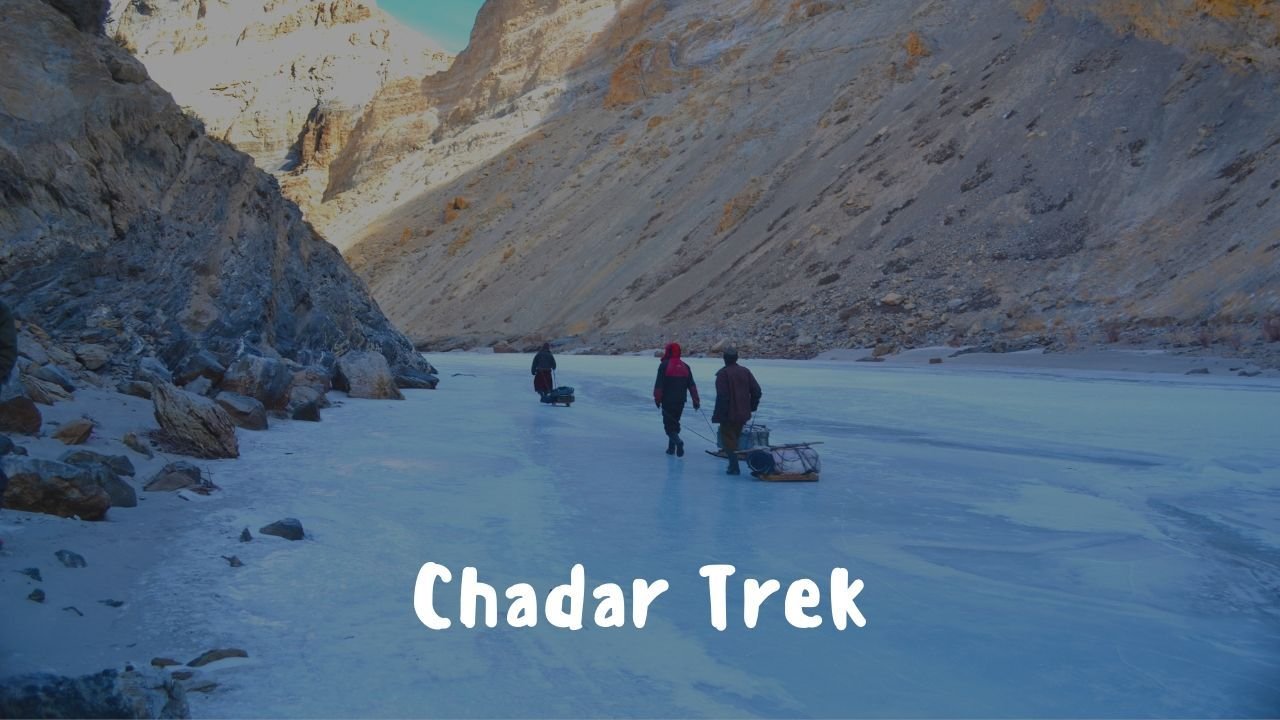
Last Updated on: May 20, 2021
The Chadar Trek is undoubtedly one of our favourite Himalayan treks. The first time we heard about Chadar Frozen River Trek in Ladakh, we were intrigued. When I came to know about the conditions in which we have to trek, I was a bit sceptical. Just imagine walking on a frozen river for almost 8 hours a day at an altitude of almost 11,000 feet. And did I mention the temperature? It is always below zero ranging between -5 to -35 degrees. Not inviting at all! I was finally convinced and we successfully completed the trek; but not without a few hiccups. So here we share our experience on Chadar Trek and a few tips to plan Chadar Trek.

Chadar Frozen River Trek | Chadar Trek
Chadar TrekTrek is considered one of the toughest treks in India. After all, you have to walk over a river, sleep on ice and might even have to wade through knee-deep ice cold water! I will not call it glamorous as many tend to call it; simply because, when Chadar Trek is associated with the word ‘glamorous’, it becomes one that needs to be ticked off the long ‘glamorous’ list. The Chadar Frozen River Trek is an experience, a feeling of wonder. We had done this trek long back in January 2014 – a time when there was not much rush of trekkers at Leh. Chadar Frozen River Trek was our second Himalayan Trek after Roopkund Trek the year before. While Roopkund made us fall in love with trekking, Chadar Trek made us understand the responsibility of being a better trekker or traveller.

What is Chadar Trek?
I always say that Ladakh is a place that never fails to awe its visitors. During the summers, Ladakh is vibrant with all the colours and sound of life. The same place bears a desolate and bleak look during the winter months. It is almost cut off from the rest of the world during this time and almost all the passes connecting Leh are closed due to heavy snowfall. The only way you enter Leh is by flight! Some of the villages become inaccessible during the winters due to snow and one can reach such village by trekking through frozen rivers!!!
The Zanskar River is a wild river gushing through the ravines and treacherous canyons of Ladakh. During the summers, the mighty river flows with all its fervour. But, during the winters, the river freezes and calms down. A blanket of ice forms over the river – thus letting the locals who are trapped in the inaccessible Zanskar villages walk over it and reach towards civilization in case of exigencies. This frozen blanket or “Chadar” (Chadar literally means blanket) is the only way in and out for the Zanskari villagers in winter.
The temperature during this time can be as low as -10 degrees in the morning and -25 to -30 degrees in the evening! A seven to eight days hike in inhospitable conditions over the river would take you from Padum, capital of Zanskar valley to Chilling, near Leh. The Chadar Trek, according to me is not just a trek; it is a symbol of hope and optimism. It signifies the indomitable spirit and courage of the people of the region.
Is Chadar Trek or Chadar Frozen River Trek Difficult?

Chadar Trek, as such, does not have a difficult trail. Yes, I repeat it again – the trail is not difficult , but it is definitely tricky. There are not much ascents and descents as you have in other treks. But, negotiating your way over a thin layer of ice over a fast-flowing blue river is no mean feat. The sub-zero temperature also does not help much. At Chadar, it is a constant fight of willpower to carry on with the trek!
For the trekkers, the Chadar Frozen River trek starts from Chilling, a few kilometres ahead of the Zanskar-Indus Sangam point and leads through the narrow canyons of the Zanskar valley. The trek ends at the Nerak village.
Chadar Trek – an unforgettable experience

Time spent on the Chadar Trek was surely an unforgettable experience. At one time, we were simply awed by the splendour and magnificence of nature. The breathtaking views of golden mountains, frozen waterfalls, hanging icicles the babble of river few inches below our feet simply mesmerized us.
On the other hand, we were also trying hard to cope with the harsh conditions of the terrain. For city folks like us where the temperature in summer goes as high as 40 degrees, trekking at sub-zero temperature is difficult. There were times when we were actually cursing ourselves as to why we are enduring such difficulty!
The first couple of days were really difficult for us. The chilly winds seemed to freeze us to the bones. As long as there was sunshine above us, all was well. As soon as we entered a shadow area, the biting cold returned.
Mornings in Chadar Trek
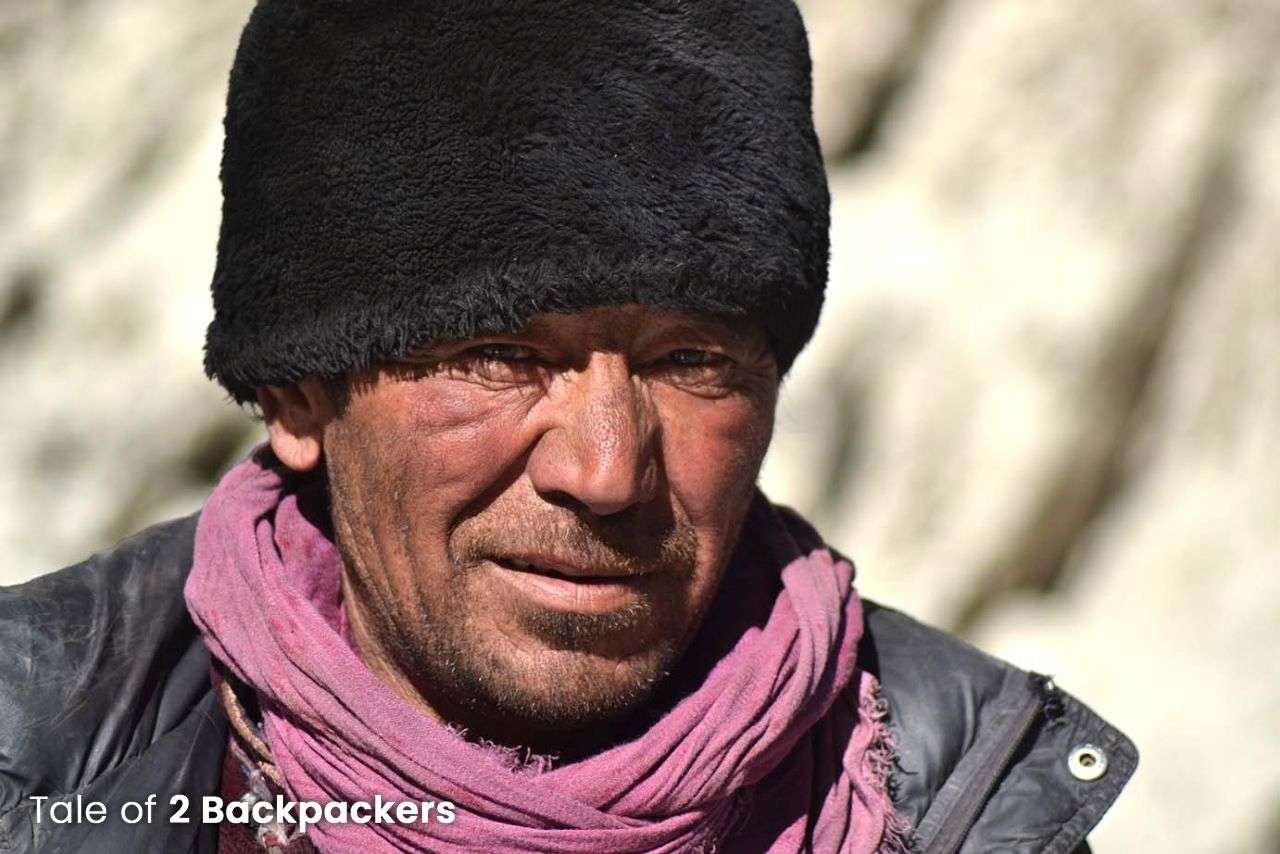
Early morning at the Chadar Trek made us feel that we were inside a refrigerator. At night, we slept inside 2 sleeping bags and covered ourselves fully. I did not cover my nose and mouth while slepping, because I feel nauseated if I do so. When I used to wake up in the morning, I would find ice frozen on my hair and top of my nose. After waking up, my hands and feet used to go numb totally. The only therapy there was to walk and walk fast until our feet responded again. Well, going for daily ablutions was also quite a pain. But this is something that cannot be avoided! So I just used to clench my teeth and go towards the toilet! Phew, it was really some experience.
Gradually, as a couple of days passed, we started getting a hold of the Chadar. We started understanding the place and the terrain. The sound of the flowing rivers underneath our feet sounded like music to our ears. The sound of the flowing river changes according to the thickness of the Chadar or ice blanket. The guides have great knowledge about this and by the sound of the river, they can predict quite accurately whether it is safe to move on that patch of ice. Finally, we also started mastering the technique to walk over the ice. One needs to walk like a penguin-like stance on the ice so as to not slip and fall.
Chadar Trek | Walking over Ice
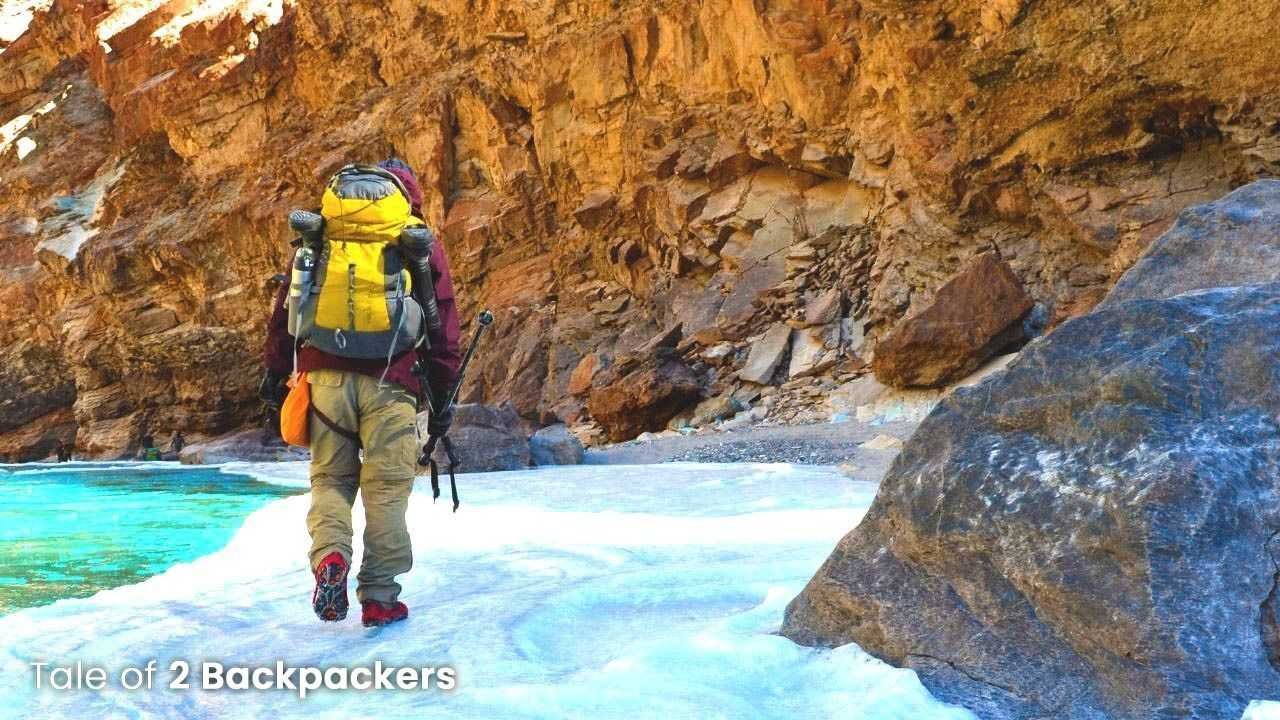
The entire trail path of Chadar Trek might not be uniform. At places, we found fresh snow, while at other places we had to tread on hard ice. Walking on soft snow is relatively easy than walking on hard iceAs I mentioned before, we had to walk slowly in a penguin kind of way. On the first few days, we lost count the number of times we fell down while walking. Gradually, we started walking in the perfect way. Experienced trekkers, as well as the locals, fall down on hard ice. The only thing you do in such situation is to rise again and start walking again with the same zeal and spirit.
You might be given crampons to walk over the ice. It will definitely make your walk easier, but it is not good for the ice blanket. The pressure of the crampons breaks the ice easily.
And at some places, there was no ice blanket at all. It is broken, weak or not formed. The river flowed with all its might!! Here we had only 2 options – either we made our way through the chilling water. Gumboots came handy during this time. Or if the water was quite deep, we had to climb over the mountains to cross the broken Chadar. What an experience it was!
Evening and nights at Chadar Trek was always beside the campfire trying to warm ourselves. We always used to have an early dinner and go off to sleep early. But the campsites below the clear starry skies were a beauty to reckon. Those were some of the best starry skies I had seen.
Chadar Trek campsites
Chadar Trek boasts of some very difficult campsites. The locals usually stay at the caves during the night. If you are going with some trekking agency, you might be provided with tents. Personally, our favourite campsite is the Shingra Koma campsite. It is a big campsite beside a frozen stream. As you walk down the stream exploring, you will encounter a frozen waterfall. The whole place will look as if straight out of some Hollywood movie.
Chadar Frozen River Trek route
Leh is the basecamp of the Chadar Frozen River Trek. Tilat Sumdo is the first campsite for the trek. But once you arrive at Leh, please spend at least 2-3 days for acclimatization. In the winter months, you have to fly into Leh. So acclimatization becomes even more important. Spend these 2-3 days doing nothing. Acclimatization is very very important to prevent AMS.
Chadar Trek starts and ends at the same point. And on the way, we encountered ice sheets, countless frozen waterfalls and all the wonders of nature. The route we followed for the trek:
Leh – Tilat Sumdo – Shingra Koma – Tibb – Nerak – Tibb – Shingra Koma – Tilat Sumdo – Leh
Day 1,2 & 3: Leh (11,400 ft)

After arriving at Leh, we stayed at Leh for 3 days to acclimatize. The first 2 days, we confined ourselves to the hotel and only roamed a little on the streets of Leh. On the third day, we visited the Shanti Stupa in the evening.
This rest for 3 days is required. And I will keep on reiterating this, AMS and acclimatisation throughout this blog.
Day 4: Leh – Tilat Sumdo (10,390 ft)
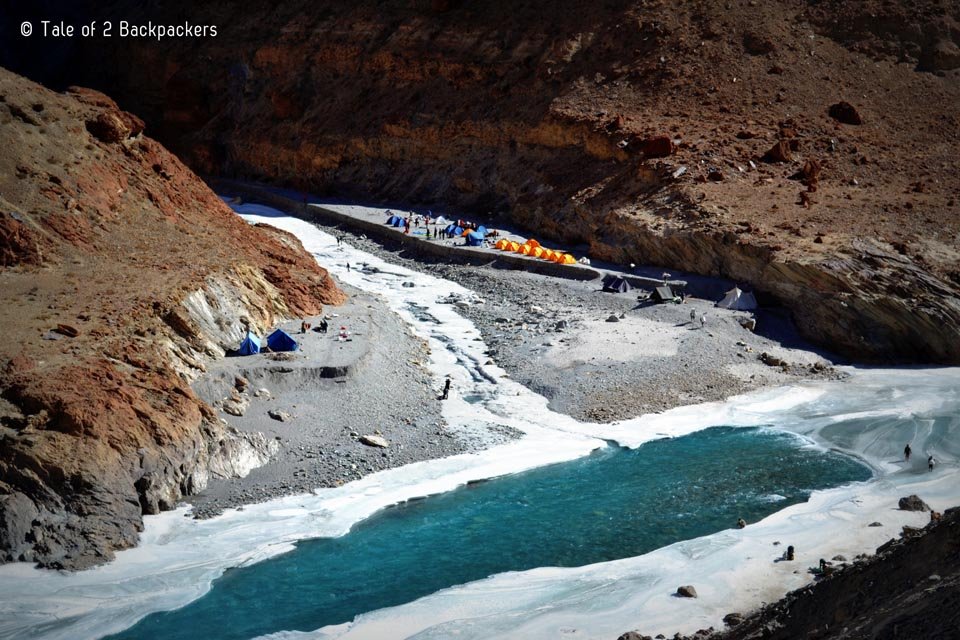
We started from Leh by road and arrived at Chilling. On the way, we stopped at Nimoo, the confluence of the Zanskar and Indus River. The rivers were frozen during this time. It looked so different from the time we had visited earlier during August. From Chilling, we had to climb down to the river bed. The place is known as Tilat Sumdo. It was our campsite for the night.
We reached at Tilat Sumdo in the afternoon. Once we were there, it was the time to get acquainted with our fellow trek mates. Our trek leader briefed us about what lay ahead of us for the next 8-9 days. We also took an acclimatisation walk on the icy river bed. Our trek leader showed us how to walk on thick hard ice. It was difficult for the first time. I kept on falling down. But the others encouraged me to again get up and walk. I guess that day the number of times I fell down in one day exceeded that of my entire life till that day!
After all the fun of walking and falling, our trek leader called it a day early so that we could get a nice rest. “The real fun starts tomorrow”, he grinned at us.
Day 5: Tilat Sumdo – Shingra Koma (10,550 ft, 10 km)

The next day, we started our trek from Tilat Sumdo to Shingra Koma, which is about 10 km away. The walk was not easy. We had to walk in the penguin kind of way. And of course, pay heed to our guides. They know the region the best.
Day 6: Shingra Koma – Tibb (10,760 ft, 14 km)
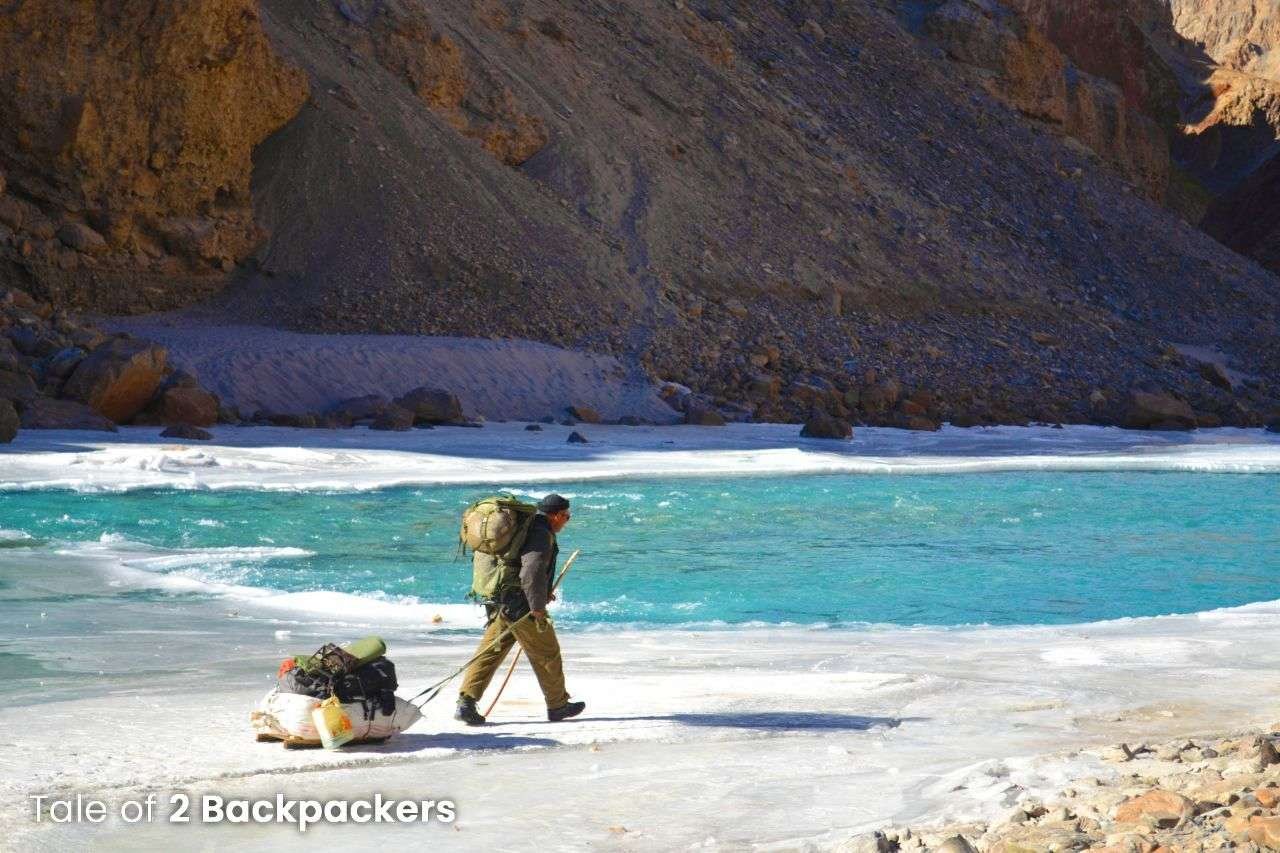
The biggest challenge this day was to wake up early in the morning and get ready for the day’s trek. It was so cold! All my hands and feet were numb. It was actually a great pain to go to the toilet and then get ready for the trek.
It was a long day of the trek and it took us about 6 to 7 hours to reach Tibb. We started by 8 AM and walked over the ice blanket. The sun, as usual, played hide and seek with us. Just as the sun god hid behind the clouds, we could feel the cold. As we trekked, we simply wandered at the splendour of nature all around us. The ochre mountains on both sides looked like canyons and the frozen waterfalls on them left a confound impression on us. It was something that I would never forget. On the way, we even came across the paw marks of snow leopards. Finally, by afternoon we reached our campsite at Tibb. There is a cave there where the locals usually stay for the night. We, however, stayed at tents.
Day 7: Tibb – Nerak (11,150 ft, 12 km) | Which did not happen

Yes, we could not continue our way to Nerak this day, we started as usual after fighting off with the cold. We went along quite a long way when our trek leader stopped us. Apparently, the ice blanket had broken at one of the places and the water was also quite deep. By this time, we already had waded through knee-deep water wearing our gumboots. But here the water was quite deep. After deliberating some time, it was decided that we would climb up the mountain-side and cross the water part.
Well, this was also not an easy task. The mountain trail was gravelly with loose stones and gravels. And it was definitely steep. Just a miscalculation of steps and I would fall deep down in the water. I saw many of my teammates took the trail and went on to the other side. When my turn came, I took the names of all the Gods I remembered. I was scared. Very scared. I did not want to fall down to the water.
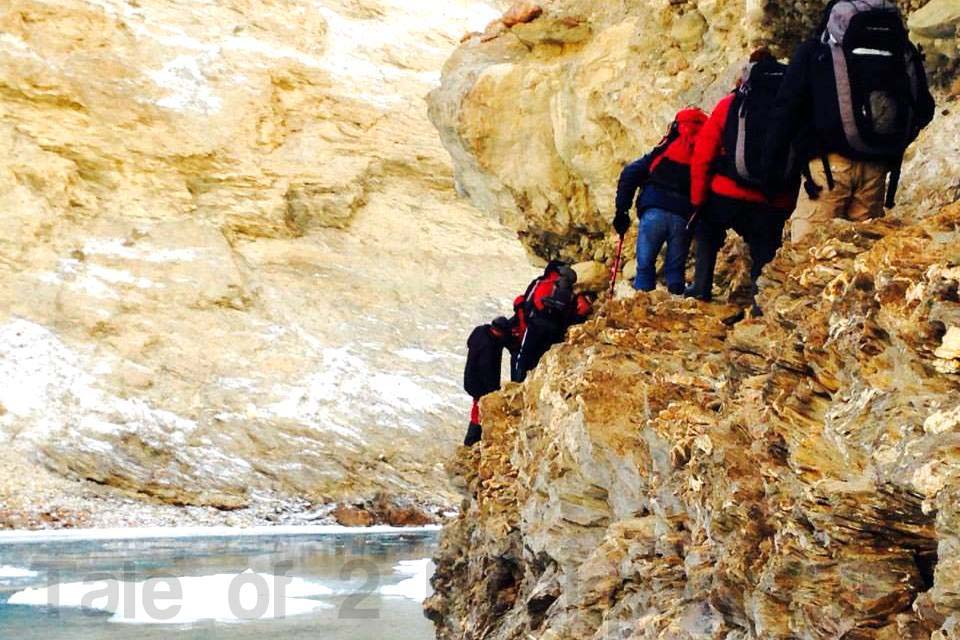
I started slowly treading my way through the trail made for the trekkers. There were tricky parts where Agni and my team leader helped me negotiate. At one moment, I felt that I would simply fall down. But finally I managed to cross the patch. And yes, I was quite happy at the feat. But at the same time, a thought lurked behind my mind. I was now apprehensive about how many such trails we have to cross. Nevertheless, we started again.
After about an hour of trek, we stopped again. This time also, the blanket was broken and the water was too deep to wade through. One of the guides went ahead to see the path ahead. He back with a bad news. He informed us that the path beyond was broken totally. Even if we managed to cross this stretch, we would not be able to do it further.
It was time for a decision. Our team leader decided not to go further and we camped there for the night. It was decided by the guides and our leader that we would wait there for another full day. If the Chadar formed within this time, we would continue. Otherwise, we have to retrace our way. All of us prayed to whichever Gods we believed so that the ice blanket formed again. We did not want to return back after coming so close to the destination.
Day 8: Somewhere in between Tibb and Nerak (The Chadar did not form)
Well, the Chadar did not form even this day. So we used our spare day at the same place. If it did not form the next day, we were to return.
Day 9: To Nerak
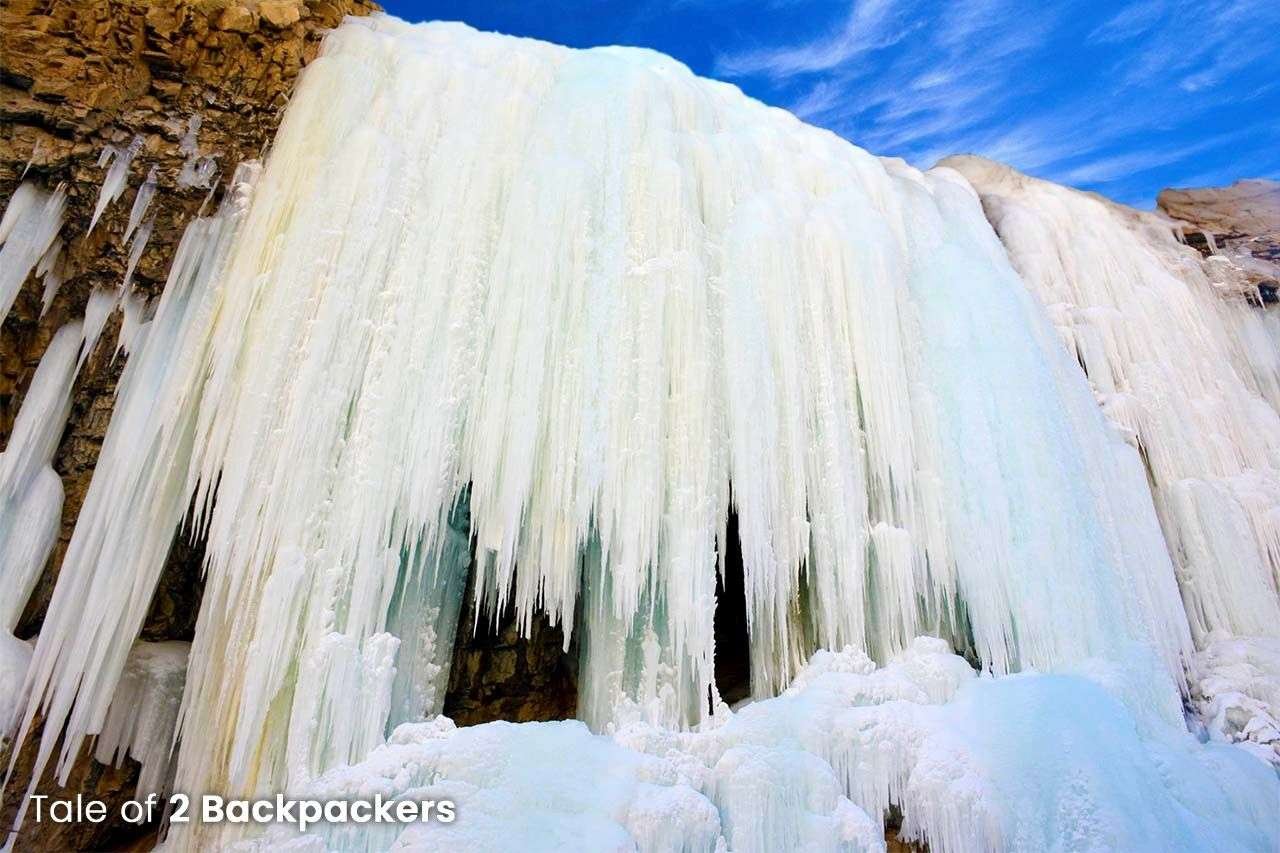
Thankfully, the weather gods took pity on us and listened to our prayers. The ice blanket was formed and we started our trek again. We reached Nerak early. Nerak is known for the huge frozen waterfall. Next to the waterfall is a bridge that takes to Nerak village. We camped at Nerak for the night.
Day 10: Nerak – Tibb
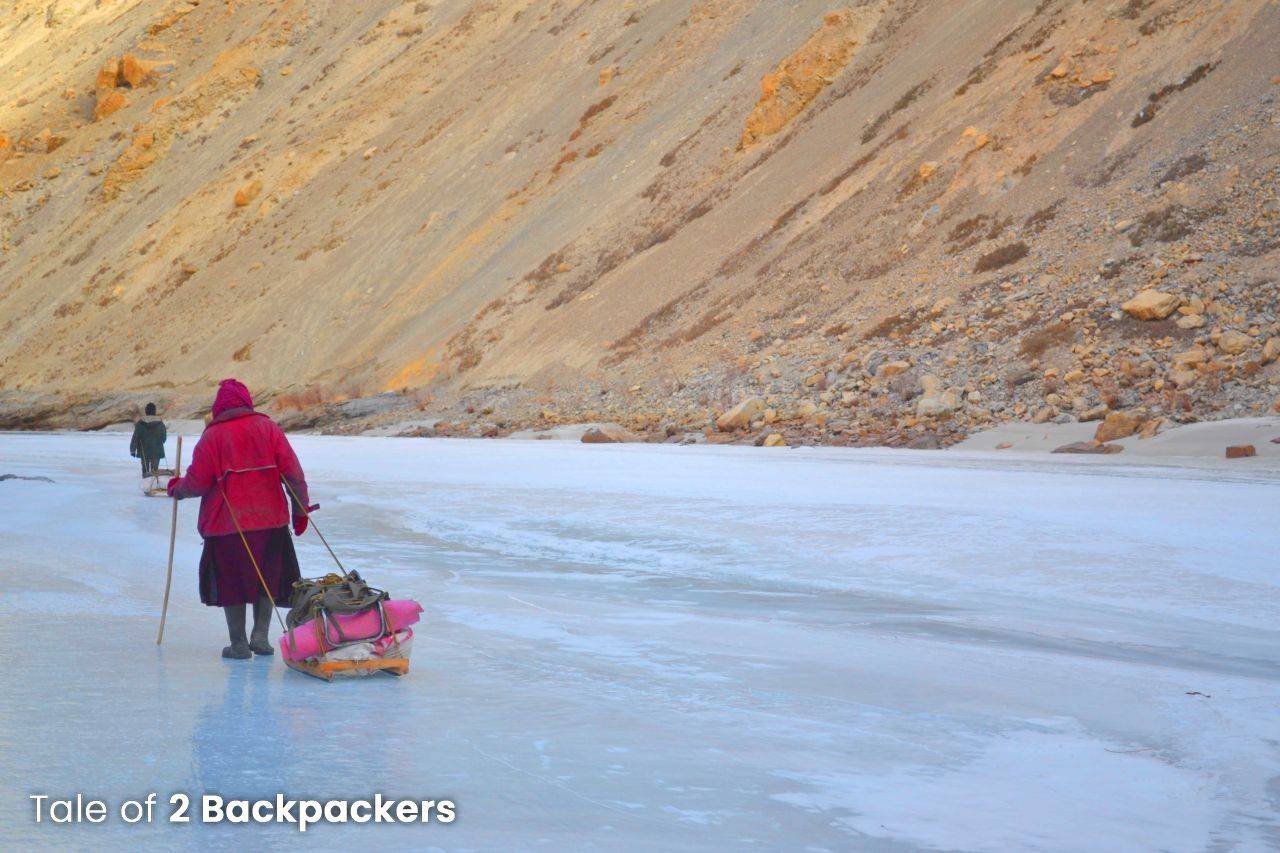
We retraced our steps through the same trail. However, the trail was no longer the same. Well, the mountains were definitely at their place. But the ice blankets, river course changed. It felt as if we were trekking on a different route. That is the beauty of Chadar.
Day 11: Tibb – Shingra Koma
We followed the same way back.
Day 12: Shingra Koma – Tilat Sumdo – Leh
We trekked back to Tilat Sumdo and then returned to Leh by a car.
What is the best time for Chadar Trek?
Chadar trek completely depends on the ice blanket or Chadar formed on the Zanskar River. The best and only time that you can do this trek is between mid-January to mid-February.
Chadar Frozen River Trek | FAQs answered
Is the chadar trek difficult.
Yes, Chadar Trek is definitely a difficult high altitude trek. Physical fitness is absolutely essential for this trek and those suffering from asthma or other chronic diseases should not go for this trek.
What is the experience required for doing the Chadar Frozen River Trek?
You need to have done at least 4-5 Himalayan treks before you decide to do Chadar trek, out of them at least one should be a moderate one. The trekker must also have an experience of trekking more than 2500 m before. The trekking trail is not difficult per se, but the conditions of the trek are quite harsh. We would definitely not recommend first-timers to go for this trek.

When we went for the trek, we had already done 3 high altitude Himalayan treks. But we found that there were a couple of first-time trekkers too in a different group. The trek operators might allow a novice trekker to do Chadar trek for some income, but this is absolutely not the right thing. It is neither good for you and nor for Chadar.
What to pack for Chadar Trek?
Since you will be trekking in sub-zero temperature, clothing is very important. Layering is the mantra at Chadar trek. Wear layers of clothes. We usually wore our thermals inside, then a tee, a fleece and then our windproof jackets. Sometimes, I used to wear t tee-shirts. Here is a list of things that you need to pack for the trek.
- Warm clothes including fleece, heavy jackets and thermals.
- Balaclava and other woollen cap or scarf
- Several pairs of socks
- Good trekking shoes
- Gumboots to wade through the water parts
Other important things to carry for Chadar Trek:
- Trekking Pole
- UV-protected sunglasses
- Water bottles
- Thermal water bottles
- Hot water bags
- Headlamps and torches
- Basic medicine kit and toiletries
- Toilet Paper
How to reach Leh?
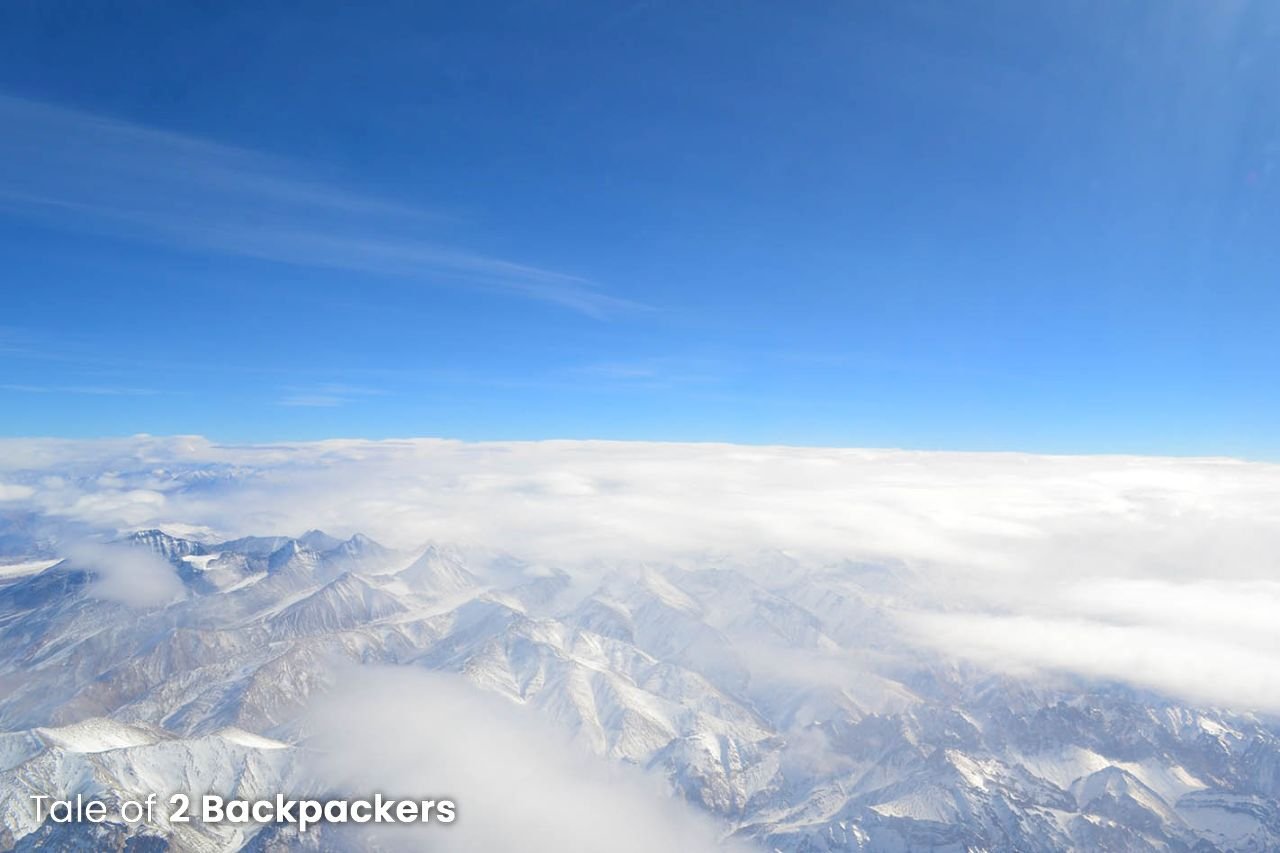
The only way to reach Leh during the winter is by flight. Leh Airport is connected with all the major airports of India. While on the flight, you can see the snow-covered mountain ranges and the Zanskar river from a height.
How will be mobile connectivity in the trek?
You will get BSNL connectivity in Leh. There will be no mobile connectivity during the trek.
How many days are required for the trek?
A total of 8-9 days are required for the trek. You will need 1 day to acclimatize and then another day for the medical checkup at the Government check-up centre. We would always recommend you to spend atleast 2 days for acclimatization to prevent AMS.

What is AMS?
AMS or Acute Mountain Sickness is actually the effect on the body at a higher altitude environment. AMS is quite common in higher altitudes, usually above 8000 ft. the occurrence of AMS depends on the altitude, the rate of ascent and individual susceptibility.
The symptoms of AMS are headache, dizziness, fatigue, shortness of breath, loss of appetite, nausea, disturbed sleep, and a general feeling of malaise. While trekking it is extremely important to look for the symptoms of AMS. And if you feel any of the above discomfort, you should immediately report to someone and see a doctor.
AMS can hit anyone at any time. Severe AMS has even taken life of even fit persons. So acclimatization is very important while you are in Leh, even if you come for a Ladakh trip.
If you experience the symptoms of AMS on your trek, please let others know. Do not ignore them. At such conditions, do not ascend further with the symptoms. Often Diamox is suggested as a preventive to AMS. Please consult with a physician before if you want to take it. Also, remember, Diamox is a preventive and not a curative drug. So you have to take it from before the start of the trek. There is no point in taking Diamox after you have AMS. There can be certain side effects of taking Diamox like frequent urination and tingling sensation in hand.
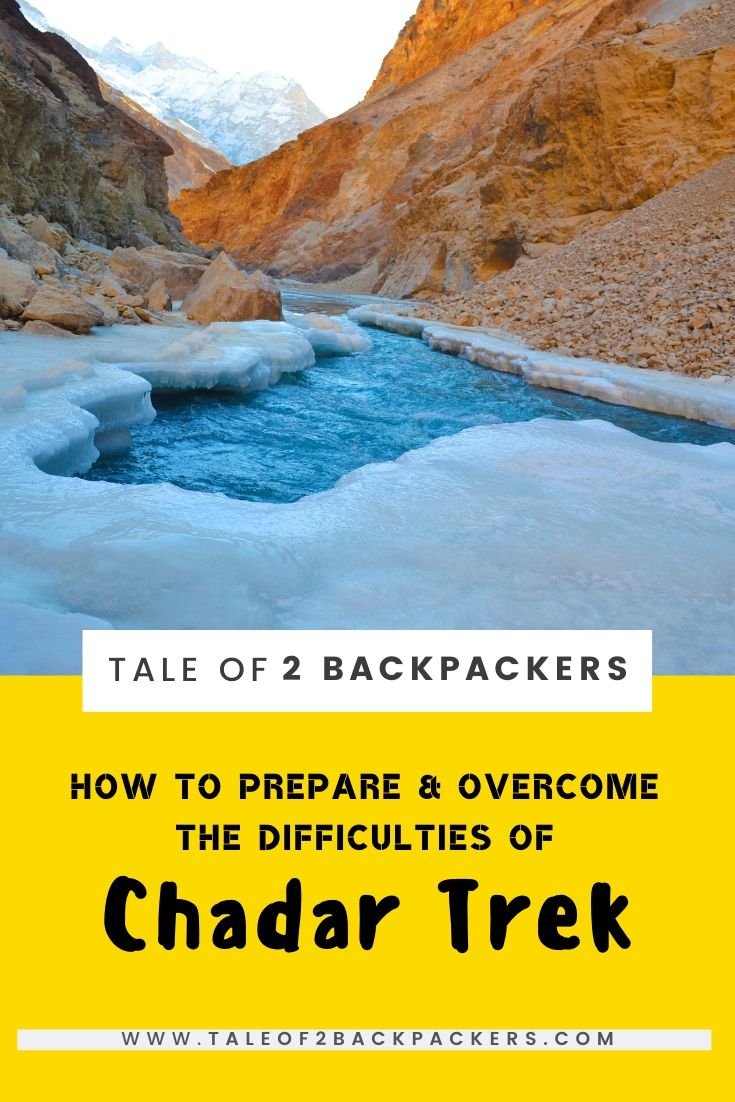
What is acclimatization?
During the peak season, when you can enter Leh by road, you can stop a night at a lower altitude (Kargil is usually suggested as a stop for the night before entering Leh). But during the winter months, you will be coming to Leh directly by flight. Delhi is at an altitude of 709 ft while Leh is 11,480 feet. There is such a gain in altitude within just a couple of hours. The body needs time to adjust to this change in altitude and so it is very important to stay at Leh for at least 2 days doing simply nothing. This process is known as acclimatization.
Responsible trekking at Chadar Trek

By now, you must have understood that the region has an extremely fragile environment and ecosystem.
The frozen Zanskar River offered a lifeline to the Zanskari villages to reach Leh, when snow closes all the land routes. The Chadar trek was their winter lifestyle. But with the popularity of this trek, also came a threat. During the last few years, the number of trekkers in Chadar increased exponentially. It had an adverse effect on the Chadar trail. With more trekkers walking on the ice blankets, it is creating a pressure on them and the blankets are broken.
Also the trekkers, guides and porters think little before littering the ice with garbage. Defecation also creates a problem in the higher altitudes. The normal decomposition process is already slower in the high altitudes. So it is not rocket science to understand that with so many trekkers, the toilet pits will become the breeding grounds of bacteria, which would ultimately contaminate the soil and water. Because of this irresponsible human activity leading to plastic waste, human waste and other harmful wastes, we heard that the Chadar trek is going to be banned in the future. While we do not agree that banning can be a solution to these problems, but we definitely urge all the trekkers to be more sensitive and understanding of the local and ecological issues.
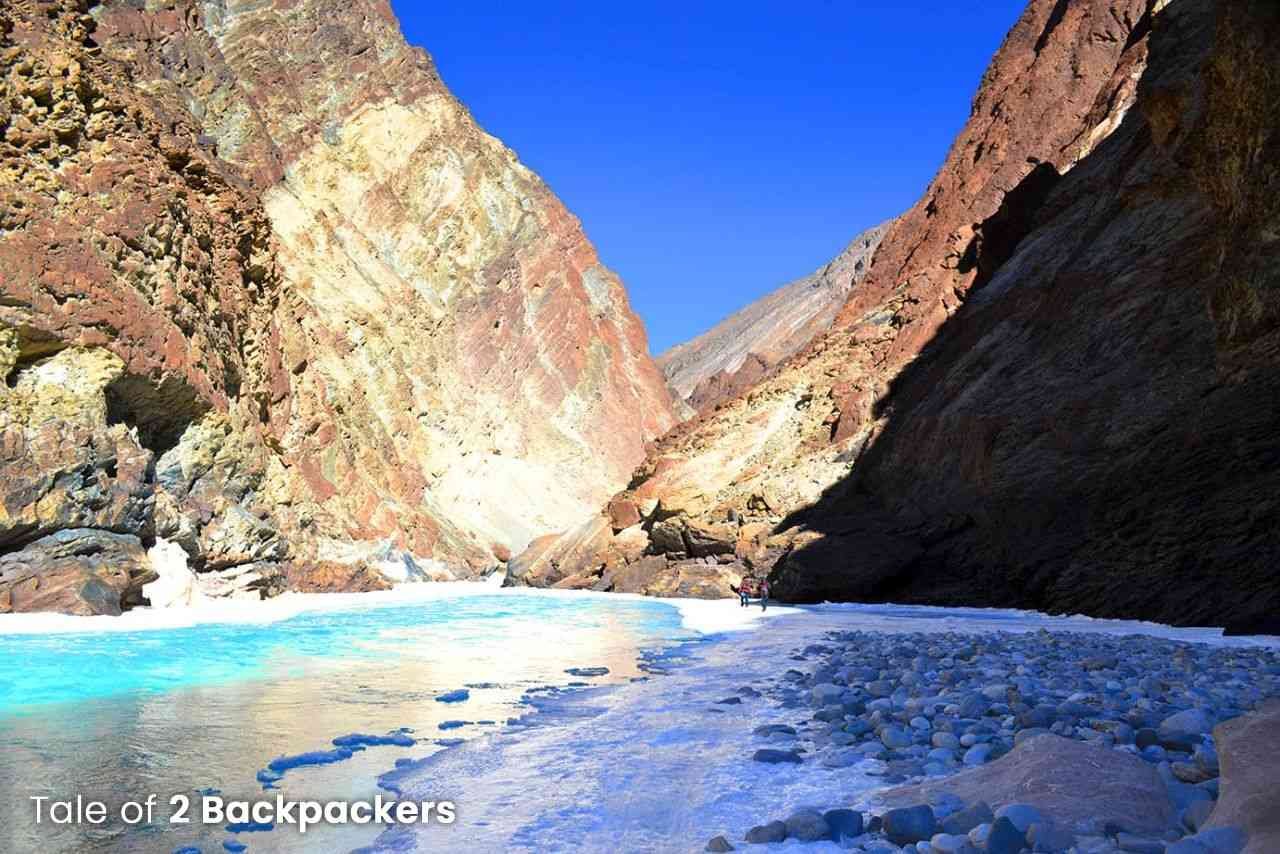
Some Tips to help you with Chadar Trek
- Acclimatise. Acclimatise. Acclimatise. This is the first tip that we would give you. Yes, we are repeating it every now and then, but this is most important. Spend at least 2-3 days in Leh doing nothing to get yourself acclimatized.
- Carry sufficient warm clothes as the temperature can be really harsh. And keep extra socks. They can be really helpful.
- Keep your backpack light and pack well. You would not like to get burdened with a heavy backpack on your trek!
- Drink water at regular intervals.
- Do not skip your meals.
- Absolutely refrain from alcohol and smoking. Not even a swig of brandy for tackling the cold. It will do more harm.
- Listen to your guide. Do not challenge them. They know the area much better. So follow their words religiously.
- Do not carry plastic items and please do not litter the trail.
- Do not use soap and shampoos in the waterfalls (if it is not frozen) and the open water sources. The locals use this water as their drinking water.
- For relieving yourself, please go to the designated area for the toilet.
- Keep buffer days while planning your trek. You never know when you get stuck in the trail.
- Avoid wearing crampons or microspikes. It is not good for the ice blanket. Initially, you will find it difficult to walk on ice, but you will definitely get a hold of it soon. You might fall down, but let that not deter you from walking.
- Be careful with your camera and other equipment. A guy in our group slipped while taking photographs and his camera fell in the river and was carried away!
Finally, enjoy and appreciate Chadar Trek with all its challenges. And while you do that, respect the nature, the landscape and the locals. While you definitely get the bragging rights of completing the Chadar Trek, but that should not deter you from doing your bit and being responsible.
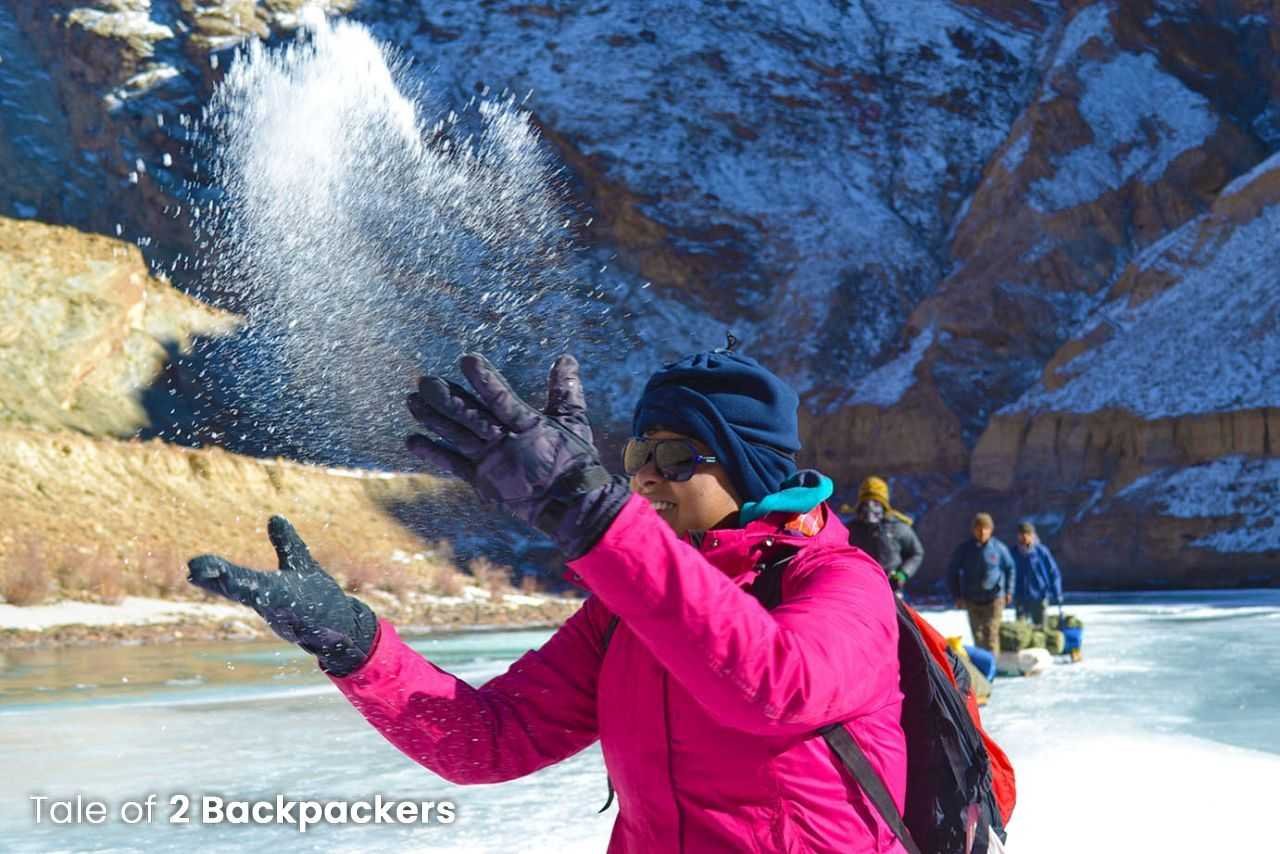
Chadar Trek was a changing point in a number of ways for me. The first thing that I realized on the trek was that we take nature around us so casually. We all are responsible in some ways or the other for environmental issues, either by using plastics or by our lifestyle or by some other reason. We might not be able to rectify all, but we can do whatever there is in our hands. Chadar Trek made me realize the importance of a responsible traveller, a responsible human being.
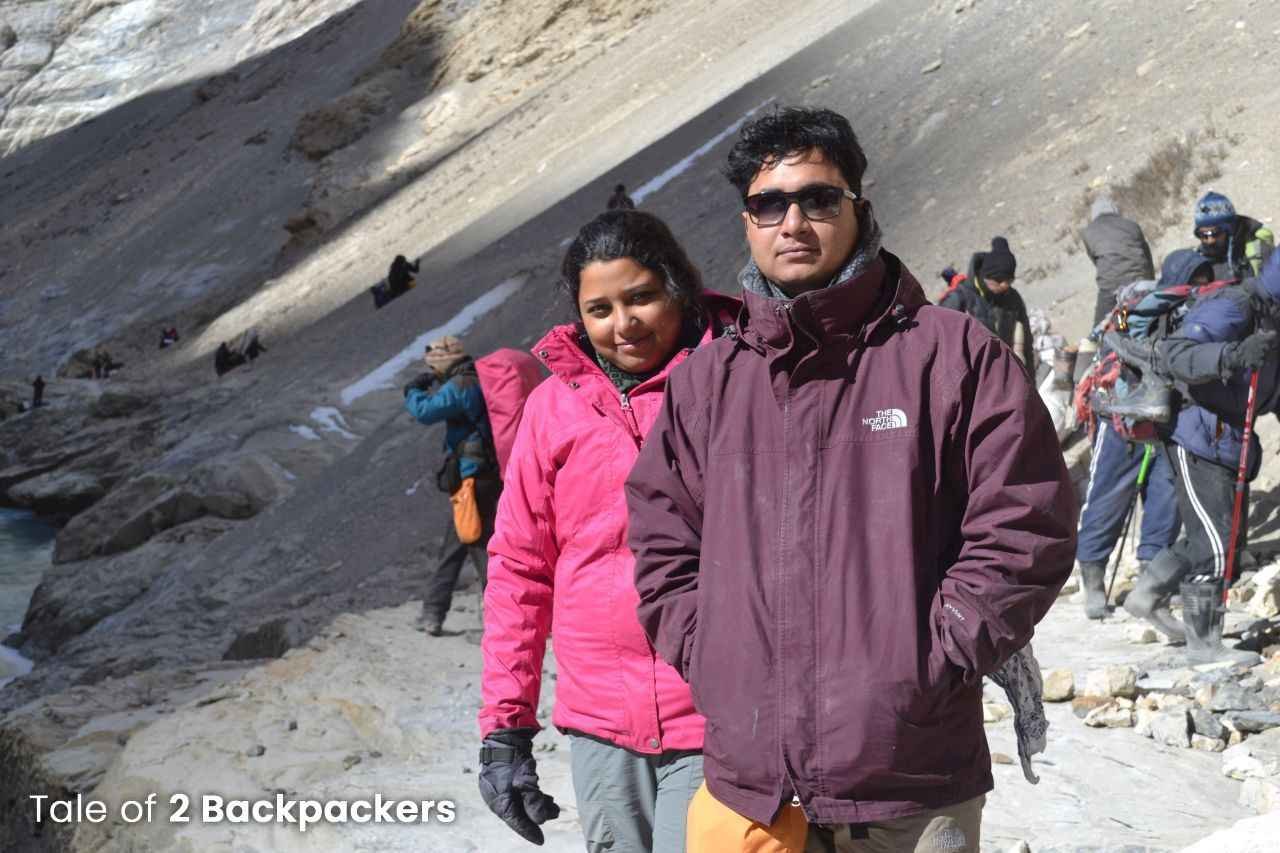
Chadar brought out the best and worst in me. In such harsh conditions, I found out my worst qualities as well as realized what I am capable of.
And the most important lesson that Chadar trek taught me is that everything in the world is ephemeral. Nothing lasts forever. Just as the Chadar is dynamic, changing its shape and course all the time, life too is not meant to be lived confined. Challenges are a part of life and are meant to be met with a smile on face and determination in the heart.
Have you done the Chadar Trek? How was your experience? Let us know in comments below. If you want to know anything else about the trek, please ask in comments below or send us a mail.
Pin this for a later read!
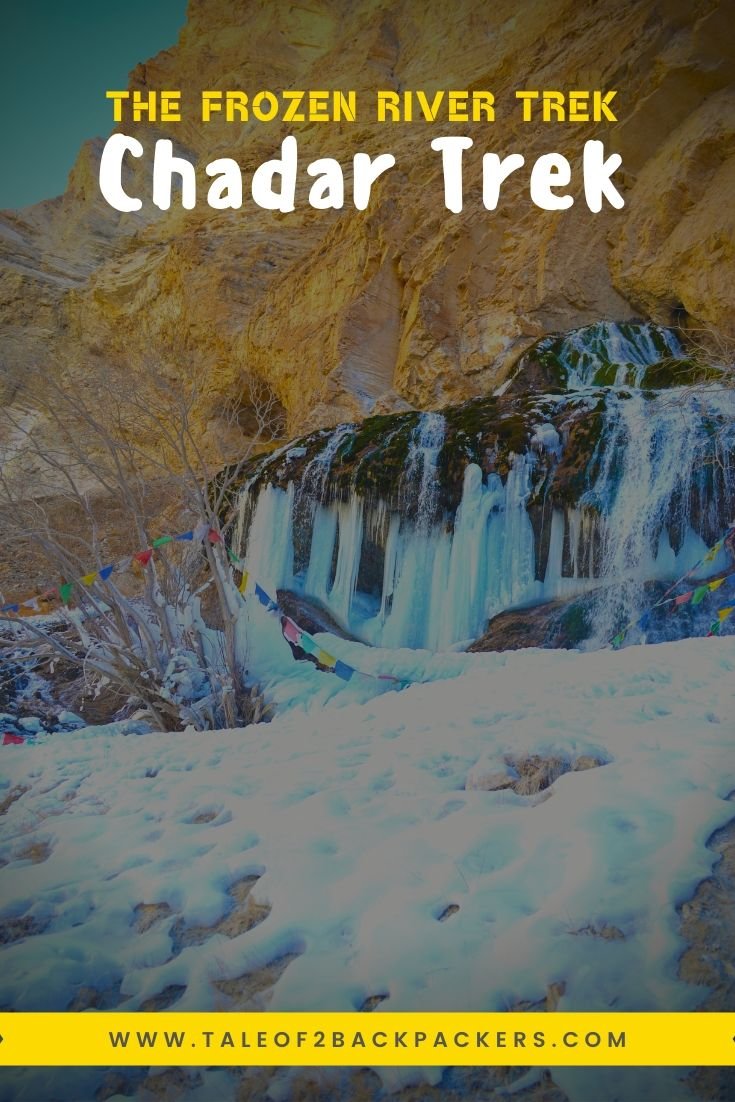
Agni Amrita
Related posts.

Hunderman – Ghost Village near Kargil with Museum of Memories
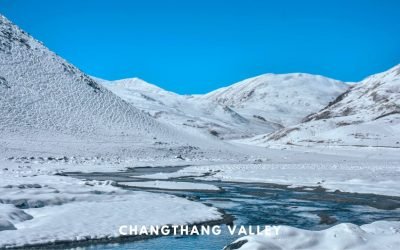
A Trip to Changthang Valley in Ladakh and a Failed one to Tso Moriri
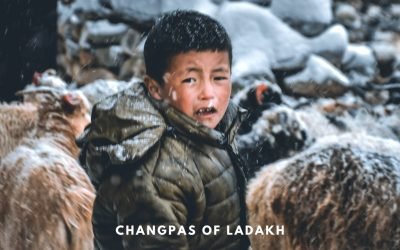
Changpa Tribe of Changthang, Ladakh – The Story of Pashminas
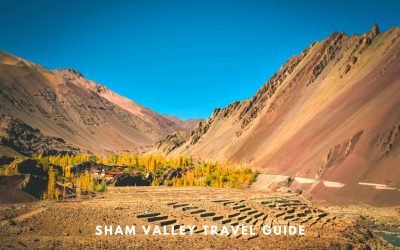
Sham Valley in Ladakh – A Complete Travel Guide
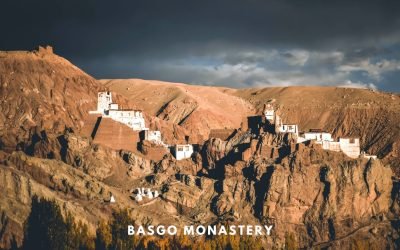
Basgo Monastery, Ladakh – Ruins of Palace and Fort
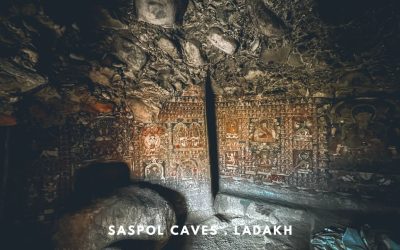
Saspol Caves – Best-kept Secret of Sham Valley, Ladakh
28 comments.
Really loved your honest and fantastic narration of the Chader trek. I have been waiting to do this since a couple of years and I am finally planning to do this in Jan 2024. I will be traveling solo, and wanted to ask you about any good trekking group which cater for women trekkers as well, cause there are so many, and it’s difficult to understand which ones are actually good. Many thanks for this lovely post I really enjoyed reading it.
Thank you so much! We are so glad that you are doing the Chadar Trek. It is a lifetime experience for sure. You can do the trek from any reputed trekking companies in India. We did it with Indiahikes. Thanks again.
I am planning to do the trek in Jan 2022 and just happened to check your post today. Ideally, how many months should one book this trek in advance ? it is just the beginning of winter so would it be fine to book now or one should wait for some more time and then go ahead based on the winter conditions on leh. what do you suggest ?
Assuming that you are trek fit, you can book the trek even 15 days before. But please be sure of your fitness and learn about winter conditions in Ladakh if you plan to do this trek. email us if you have any more queries. Thanks and have a great trekking experience.
Fantastic post. Your narration was so beautiful. Do we have a satellite phone facility during the trek?
Thank you so much. Glad that you liked the article. Yes, there will be satellite phones with your trek leaders.
Wow that trek looks very intense. I love hiking and have done many multi day treks but nothing like that. I am not a fan of the cold and I can’t imagine hiking in those temperatures!! Your pictures though are amazing and it is certainly a challenge I could be tempted to do one day!!
Thank you Clare. The trek was a test to my perseverance and will power!
Just reading the first para about the altitude and temperature and time, it already sounds exhausting. So, super congratulations for completing the trek inspite of these harsh realities!!! You’ve been to Roopkund already? Whoa! Hats off to you!!!! //Ice frozen on the hair on my nose// – What???? OMG! That’s brrrrrrrrrrrrrrrr cold! I have never walked on thin ice or frozen river so far, and I can’t imagine how would it be to do it all day long for days together! The frozen waterfalls of Nerak looks so so so splendid!
Haha! I liked the way you described the experience about ice on hair and nose! Chadar Trek is a really an experience.
The thought of walking on a frozen river at almost 11,000ft for about 8 hours a day would intimidate me too! After reading your post I believe you that the Chadar Frozen River Trek is the most challenging in India. I bet you feel so accomplished now! I love reading about difficult hikes like this, but they are not for me! Waking up with ice on my nose, no thanks….lol.
Thank you Elizabeth. Yes, Chadar Trek is one of the most challenging treks in India. I would not say the most challenging!
Amrita, I am overwhelmed with admiration for your perseverance, fortitude, and endurance! I was near tears just reading about your Chadar Trek experience in Ladakh and the many challenges you faced. I cannot imagine waking up with ice on my face and hair and slogging through frigid water, let alone navigating the mountain ledges. You must feel so accomplished and now have yet another amazing experience in your memory to draw should you ever face difficult times. (If you can do this, I believe you can do anything.) I am in awe of you.
I would love to have seen snow leopard tracks and that beautiful frozen waterful first hand. While you provided really important tips for anyone attempting this trek, I am grateful to have seen both wonders–along with many other natural beauties–through your eyes.
Thank you so much Jackie for your words. This means a lot to me as I am one of your admirers. Thanks again.
I am enjoying reading all about your hikes in the Himalayan Mountains. I may never get to do these myself. So it is interesting to read about ones like the Chadar Trek. Even as a Canadian I am a winter wimp. So walking on a frozen river at such cold temperatures would not be my kind of thing. Although I can see why the beauty would drive you to want to visit. What an adventure you had!
Thanks Linda. I am also not particularly fond of very cold. But Chadar trek experience was totally out of the world.
I can not even imagine walking on a frozen lake for 8 hours. AND it isn’t completely frozen. Isn’t there some rule about it needing to be completely frozen to a certain depth before walking on it? And having ice frozen on your nose when you wake up cannot be healthy. I obviously have anxiety issues, I would have been scared too. All that being said, it is beautiful. And you didn’t die. And this is a huge accomplishment!!!
I can totally understand your anxiety. I too was scared before going for the trek. But it went on well and we were back all hale and hearty.Yes there are rules about walking on frozen rivers. The guides look after that.
What a great post! I admire your strength for being able to do this trek! As a Canadian, I understand how cold those temperatures can feel and cannot even imagine trekking and sleeping outside in those conditions. I’m very impressed! Nerak looks so beautiful and would be the place I would be most excited to visit. I also appreciate that you pointed gave tips on how to be a responsible traveller and not abuse the natural landscape!
Thank you Erica.
This adventure looks so cold! And amazing! I haven’t done a trekking adventure yet and I’m not sure it is on my bucket list. I am more into long distance cycling!
Yes, it was cold! But was also beautiful.
I love reading your final thoughts after the trek that everything in the world doesn’t last forever and I totally agree with you. Thats why we should appericate everything we have and try not to ruin it. Also I would love to do this trek, it looks amazing (and a bit cold). 🙂 I would seriously consider doing is trek if I was in the Leh area, it is on the plans but I havent chosen which hiking trails I would like to do. My time will come.
Thank you Danik. It was really cold there. 🙂
I really enjoy to read your Chadar Trek diary, it also encouraging me to do this trek in the future.
Thank you so much. Glad that we could inspire you!
Your pictures bring your experience alive. Have heard so much about Chadar and after seeing your post, want to head there now.
Thanks Ami… Chadar is definitely an experience…
Submit a Comment Cancel reply
Your email address will not be published. Required fields are marked *
Submit Comment
This site uses Akismet to reduce spam. Learn how your comment data is processed .
Pin It on Pinterest
Chadar Trek
🗓 Best Time To Visit: January to February
⏰ Open Hours: N/A
🏞 Things To Do: Trekking, Photography, Camping, Nature Walks
💰 Budget: INR 15,000 - 25,000 per person
🧳 Traveller Types: Adventure Seekers, Nature Lovers, Photographers
🔍 Known For: Unique frozen river trek, Beautiful landscapes, Leh Palace, Zanskar River
📍 Distances: Leh Airport - 9 km, Srinagar Railway Station - 421 km, Leh Town - 5 km
🥾 Trek Difficulty: Moderate to Difficult
🧣 Essential Gears: Thermal Clothes, Trekking Shoes, Trekking Pole, Sunglasses, Sunscreen, Medicines
📜 Permit: Mandatory Ladakh Autonomous Hill Development Council (LAHDC) permit
🔺 Altitude: 3,850 meters
Have you ever dreamed of walking on a frozen river, surrounded by snow-capped mountains and stunning scenery? If yes, then you should definitely try the chadar trek, one of the most unique and adventurous treks in the world. The chadar trek is a winter trek that takes you along the frozen Zanskar river in Ladakh, a region in the northern part of India. The chadar trek is not for the faint-hearted, as it involves braving the extreme cold, the slippery ice, the unpredictable weather, and the remote wilderness. But if you are up for the challenge, the chadar trek will reward you with an unforgettable experience, a sense of achievement, and a glimpse into the culture and lifestyle of the local people who have been using this route for centuries.
In this article, we will tell you everything you need to know about the chadar trek, from what it is, why you should do it, how to reach it, when to go, what to expect, what to prepare, and how to book it.
What is Chadar Trek?
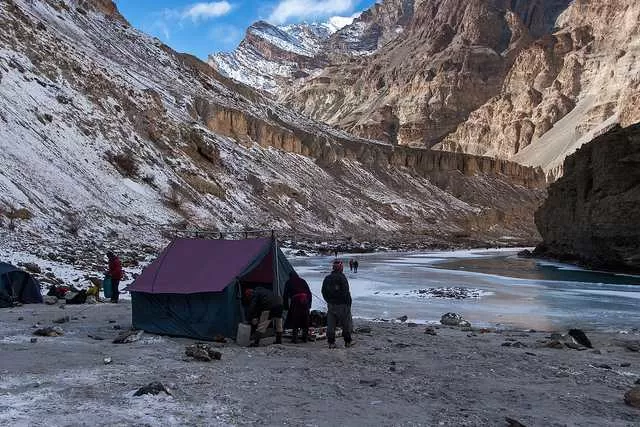
The word chadar means blanket in Hindi, and it refers to the thick layer of ice that covers the Zanskar river during the winter months. The Zanskar river is a tributary of the Indus river, and it flows through a deep and narrow gorge in the Zanskar valley, which is part of the Greater Himalayas. The chadar trek is a trek that follows the frozen river for about 105 km, from Chilling to Naerak and back. The chadar trek is also known as the frozen river trek or the Zanskar trek. The chadar trek is one of the oldest and most traditional routes in Ladakh, as it was used by the local people, especially the Zanskari people, to trade and communicate with the outside world when the road access was blocked by snow.
Why Chadar Trek?
The chadar trek is not just a trek, it is an adventure, a challenge, and a learning experience. Here are some of the reasons why you should do the chadar trek:
1. The chadar trek is a unique and rare trek, as it is one of the few places in the world where you can walk on a frozen river. The chadar trek is also a seasonal and unpredictable trek , as it depends on the weather and the river conditions, which can change anytime. The chadar trek is also a dynamic and diverse trek, as it offers different landscapes, terrains, and views, depending on the time of the day, the angle of the sun, and the thickness of the ice.
2. The chadar trek is a thrilling and exciting trek, as it involves walking, sliding, crawling , and sometimes even swimming on the frozen river. The chadar trek is also a challenging and demanding trek, as it requires a high level of fitness, stamina, endurance, and mental strength. The chadar trek is also a risky and adventurous trek, as it exposes you to the extreme cold, the slippery ice, the unpredictable weather, and the remote wilderness.
3. The chadar trek is a cultural and educational trek, as it introduces you to the culture and lifestyle of the local people , especially the Zanskari people, who have been living in this harsh and isolated environment for centuries. The chadar trek is also a spiritual and inspirational trek, as it passes by many ancient and sacred sites, such as monasteries, shrines, and caves, that are revered by the Buddhists. The chadar trek is also a social and fun trek, as it allows you to meet and interact with other trekkers, guides, porters, and locals, who share your passion and enthusiasm for the chadar trek.
Best Time to Go for Chadar Trek
The best time to go for the chadar trek is from mid-January to mid-February , when the Zanskar river is frozen enough to support the weight of the trekkers. The chadar trek is not possible before or after this period, as the river is either too thin or too thick to walk on. The chadar trek is also not possible during the summer months, when the river is flowing and not frozen.
The best time to go for the chadar trek also depends on the weather, the river condition, the availability, and the preference of the trekkers. The weather in Ladakh during the winter months is very cold, dry, and windy, with temperatures ranging from -5°C to -25°C.
How to Reach Chadar Trek
The chadar trek starts and ends at Chilling , a small village in the Zanskar valley, which is about 65 km from Leh, the capital of Ladakh. To reach the chadar trek, you need to first reach Leh, and then take a taxi or a bus to Chilling. To reach Leh, you have two options: by air or by road.
By air , you can take a flight from Delhi, Mumbai, Bangalore, or other major cities in India, to Leh, which is the nearest airport to the chadar trek.
By road , you can take a bus or a car from Manali, Srinagar, or other nearby towns in Himachal Pradesh or Jammu and Kashmir, to Leh, which is the nearest road head to the chadar trek. The road distance is about 475 km from Manali, and about 420 km from Srinagar, and the road duration is about two days, with a night halt at Keylong or Kargil, respectively.
The best way to reach the chadar trek is by air, as it is faster, easier, and more reliable than by road. However, you need to be prepared for any changes or cancellations, and acclimatize yourself to the high altitude and low oxygen level in Leh, before starting the chadar trek.
The chadar trek is a unique and adventurous trek that takes you along the frozen Zanskar river in Ladakh, a region in the northern part of India. The chadar trek is a winter trek that is only possible for a few weeks in the year, when the river is frozen enough to support the weight of the trekkers.
The chadar trek is a challenging and rewarding trek that requires a high level of fitness, stamina, endurance, and mental strength. The chadar trek is also a cultural and spiritual trek that introduces you to the culture and lifestyle of the local people, especially the Zanskari people, who have been using this route for centuries.
The chadar trek is also a scenic and beautiful trek that showcases the natural beauty and splendor of the Zanskar valley, the Himalayas, and the Ladakh region. The chadar trek is a once-in-a-lifetime opportunity, as it is threatened by the effects of climate change, global warming, and tourism, which may alter or melt the ice in the future.
Chadar Trek Reviews
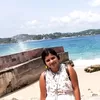
Places To Visit In Leh Ladakh
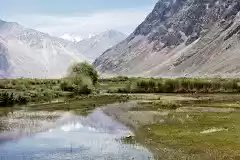
Travel Blogs for Chadar Trek - Trekking In Ladakh - Frozen River Trekking In Ladakh
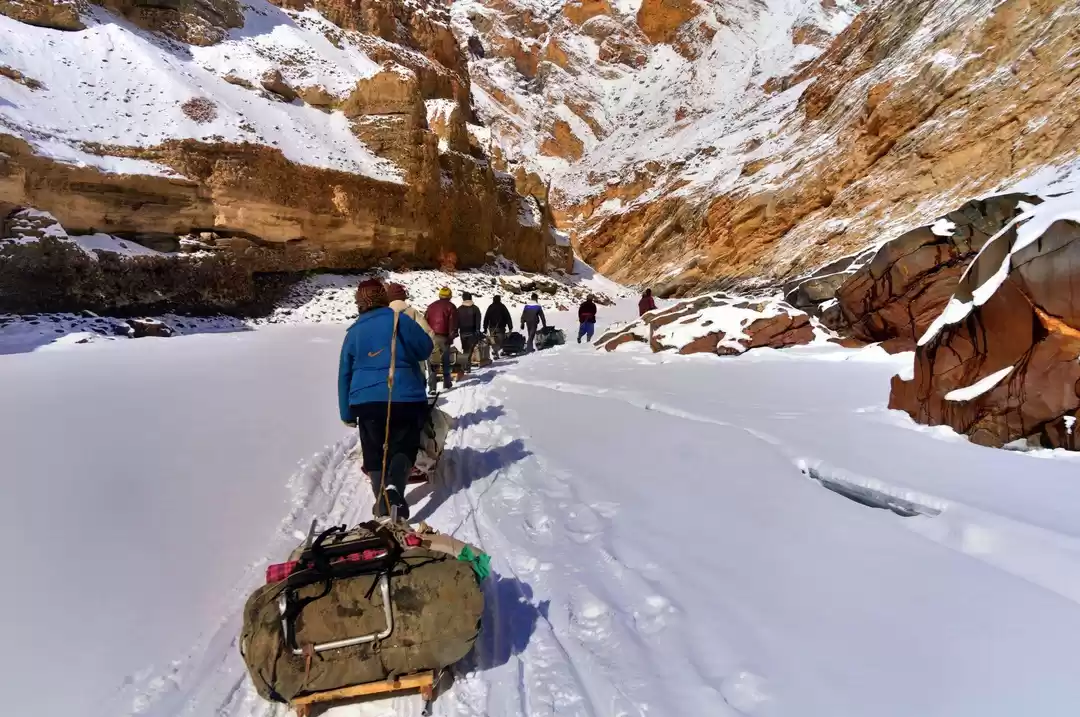
Phone : +91 99587 16176 (Tours) , +91 97118 77111 | Email : [email protected]
Guide for Chadar Trek or Frozen River Trek - Backpackclan
Call Us Today! +91 99587 16176
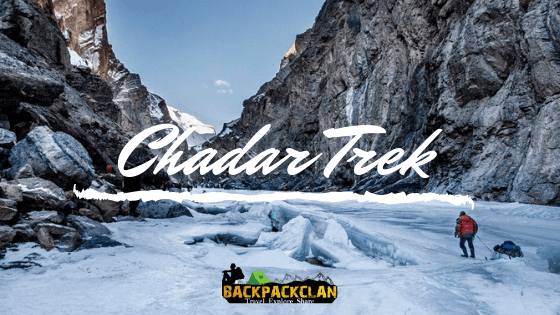
Chadar Trek Information
Ever fancied strolling over the frozen river with the super cold water running beneath your feet and snow-capped dramatic mountains on both sides. If yes, then a trek over the frozen Zanskar river or Chadar Trek is certainly going to fulfill your fantasy. The Chadar Trek or the Zanskar Gorge is a winter trail in the Zanskar region of Ladakh, in the Indian state of Jammu and Kashmir.
Its walls are near vertical cliffs which are up to 600 m high and the Zanskar River which is a tributary of the Indus is only 5 meters (16 ft) in places. The overall distance of the trek is approximately 105 kilometers. An average trekker walks 16 kilometers per day, so roughly the trek can be completed in about 9 days. The best time to do the Chadar trek is January to February when the temperature during the winters drops sometimes to -30 to -35 degrees and the ice is in its most stable state. The trek is graded as difficult and it begins from a small village of Chilling from where the Zanskar river actually begins to freeze.
Detailed Information About Chadar Trek
The complete list of places on this trek is as follows:
- Leh ->Tsomo Paldar via Chilling & Tilad do
- Tsomo Paldar->Tibb Cave
- Tibb Cave-> Nerak
- Nerak->Tibb Cave
- Tibb Cave->Gyalpo
- Gyalpo ->Tilad do
- Tilad do->Leh
There are other variations of the trek which go till Lingshed while if you opt to stay more then a bigger version will take you to Padum over almost 14 days.
Who can go?
- The trekker must have an experience of at least one trek before starting off with the Chadar Trek
- The climber must not have a heart problem, high blood pressure, asthma, and epilepsy because these problems cannot be pacified on the mission.
- The climber should be capable enough to carry a 10 kg backpack.
- The climber ought to be fit and should have the required amount of stamina for trekking at least 5kms in 45 minutes.
Things to keep in mind
The trekker should be aware of the climatic conditions of the place and what all essentials are to be carried while trekking and also there are several factors that count for ensuring you a safe journey. The precautions that are to be taken on the footing choices seeing the ice conditions there are:
- There may be cracks in the ice, which the trekker should avoid while walking over it.
- The moment you encounter any sort of cracks under your feet it is advisable to just run and move to a solid place immediately
- Slippery ice can be found at many spots and ought to careful while walking.
- Places that have a coating of snow are the best ones to walk upon normally.
- Ice is definitely not a trekker’s friend so a trekker must be wise enough in choosing the camping spot.
- Trekking gear if brought from home is preferable as there might not be many supplies available during winters in Leh.
- One should always carry ready-to-eat food items like instant noodles with them as these prove out to be an excellent food option.
- Ice picks, trekking boots, and layers of extra warm clothing are mandatory in such conditions.
- Tents are highly recommended as you are non-local. But at times you can also easily camp in caves like the locals who journey across the river.
Solo/Group Travel
At times there are many people who don’t want to be a part of a group and wish to enjoy their own company hence want to travel solo. But Chadar Trek is considered one of the most difficult treks, thus traveling solo on this can be both thrilling and difficult at times. Take a look at the points mentioned below:
- If you are traveling in groups with a good tour operator, they will take care of all your basic amenities, like food will be provided to you during the trek, you also don’t have to worry about the accommodation as tour organizers will take care of that for you.
- Chadar Trek is considered one of the toughest trek in India so you need to take care of all the safety measures like oxygen cylinders, first aid kits, food, etc. Arranging all these things to ensure your safety is certainly a hard task if you wish to travel solo.
Traveling solo undoubtedly can be adventurous but there is no harm if you are assured safety along with fun (group travel with tour operators).
Regulations & SOP to be followed for Chadar Trek
The new district administration of Ladakh has taken various steps to protect the ecology of Ladakh. A comprehensive set of rules and guidelines has been published by the administration for all the trekkers and tour organizers going for Chadar Trek.
- All tourists going for Chadar Trek must spend at least three nights in Leh at a minimum for acclimatization.
- For tourists who will not undergo three days of rest in Leh, any permissions and permits for Chadar trek 2019 will not be issued to them.
- Tourists will have to keep the boarding pass to prove their date of arrival in Leh before beginning the Chadar trek and whether they have spent the required three days time within Leh.
- The boarding pass will be verified at the time of Pre Medical Check-up in Leh, so please make sure you keep them safe with you
- On Day 3, tourists must undergo a compulsory medical check-up in Leh which will provide clearance for undertaking the Chadar trek. Tourists who are found medically unfit will not be allowed to go the trek.
- Once the tourists will clear this medical test, they will have to apply for adventure travel insurance for Chadar trek from authorized insurance providers.
- After getting the approval for the medical test and buying the adventure travel insurance, tourists need to apply for the permit for the Chadar trek from the Wildlife Department in Leh.
- Finally, tourists have to get a NOC (No Objection Certificate) from ALTOA (All Ladakh Tour Operator Association) to go for Chadar Trek.
- In order to save the environment, all authorized tour operators for the Chadar trek must provide the list of rations and food items to the Wildlife Department. This is required to ensure whether the group has brought back the trash or not including tins, plastic bottles, and other plastic materials. The local tour guide of the group for the Chadar trek is responsible for ensuring that it gets done and will also be held responsible for any littering.
- The wildlife department will provide the green bags for the trash and will collect a security deposit from the local guide. The security amount will be refunded to the guide after the completion of the Chadar trek and verifying whether all the required trash has been brought back from the trek or not.
Most of you must be wondering after reading this as to what rubbish is all this, but frankly speaking, if the government is working so hard and putting so many efforts into bringing out a clean and eco-friendly place for you then why can’t you do your bit, after all, all this is being done so that you (the tourists) can enjoy their journey on clean paths and without any hassle and disturbing the ecology.
The Tourist Information Center in Leh main market opposite of J&K Bank will be set up for a single clearance window for the entire process of the Chadar trek. At this window only, the tourists will
- Register at this window for the Chadar trek,
- Complete the pre-medical test,
- Get the adventure travel insurance,
- Get the permits for Chadar trek from the Wildlife department,
- Get the approval NOC from ALTOA (All Ladakh Tour Operator Association)
If you are doing the Chadar trek through a local tour operator, they will assist you throughout the process.
How to obtain Permits for Chadar Trek?
Now, that you understand the rules and regulations to be followed for the Chadar trek, let’s look at how to get permits for the Chadar trek .
- You should completely fill the registration form provided by your tour operator or you can get this Chadar trek registration form at TIC Leh.
- On the third day after your arrival in Leh, you should submit your duly filled registration form, original boarding pass, and a copy of your photo ID proof. Valid ID proofs are a Driving License, Aadhar Card, Passport, or Voter Id Card.
- Next, you should check with your tour operator about the time slots for a medical check-up at TIC and issuing the adventure travel insurance. You should get the registration form for pre-registration from your tour operator to avoid a last-minute rush.
- Once you are finished with registration, you will undergo a pre-medical checkup.
- After the doctors provide you the medical clearance, they will provide you an ASC360 Adventure Travel Insurance and a Medical Rescue Card.
- After obtaining both Medical Clearance / Rescue Card and Adventure Travel Insurance, you need to apply for Wildlife Permits for Chadar trek and the NOC letter from ALTOA.
- Either you can ask your tour operator of Chadar trek to make the payments or you can yourself make these payments on the spot at TIC too.
- Finally, before you start the actual trekking for Chadar trek, you will need to present your Medical Rescue Card and the permits at the check post at Phyang or Chilling.
Estimated Cost for your trip
- Typically a Chadar Trek package from a tour company costs between 20k-35k depending upon the luxury options chosen, this will include your food, accommodation, and transportation in Leh.
- This cost totally depends on you whether you wish to travel by air or by road. For eg: If you wish to travel by air like from Delhi->Leh and Leh->Delhi you can get your tickets done between 8-10k.
- Followed by this if you are going trekking for the first time you need to have trekking gear with you and that could cost you around 10k.
- Don’t forget to carry extra cash for personal expenses like 15-20k for emergency purposes.
On whole, the trip can be done in between 35k-70k depending upon the luxury options chosen.
Don’t forget to keep all the points mentioned above be it rules, guidelines, and things to carry, at the top of your mind while you are traveling for Chadar Trek. Chadar Trek is one of the toughest treks in India so for all those who want to have that adrenaline rush amidst those magical and majestic mountains on both sides, Frozen river below your feet, and cool breeze gushing on your cheeks, you should definitely go for Chadar Trek . Happy Trekking.
Leave a Reply Cancel Reply
You must be logged in to post a comment.
Quick Links
- Partner With Us
- Terms & Conditions
Trip Categories
- Motorbike Expedition
- Backpacking Trips
- International Road Trips
- Short Tours
- Adventure Activities
Trip Destinations
Where we are.
Head Office : 507, Padma Tower 2, Rajendra Place, Delhi - 110008
Phone : +91 99587 16176
Email : [email protected]
Working Hours : 10:30am - 07:30pm (Monday to Sunday)
Select Tour Plan Date
Best Time to Visit Chadar Trek: The Frozen Zanskar Lake
Nowadays trekking has become an astonishing activity for both good and bad reasons. If you are a mountain lover then it is a good chance of witnessing the romantic side of the mountains with the stunning beauty and difficult terrains. It is one of the best ways to escape from the mundane activities of daily life, which makes people tired. Chadar frozen river trek of 62km is one of the best trekking routes in the valley of Ladakh. However, as it is associated with the most dangerous roads in the whole world. People who love adventure and exploration of hidden places can survive here. It is a mesmerizing trek accompanied by gorgeous deserted valleys and a thrilling Zanskar river.
About Chadar Trek
Leh-Ladakh is such a place in the country that is accompanied by rugged beauty and pleasant scenery. There are endless hidden places to discover here. Among them, the Zanskar winter trek of Ladakh is the most electrifying exploration for adventure seekers in 11483 feet. It captivates frozen rivers with fascinating hills all around them. The stunning mountains of Ladakh are completely different from the other Indian cities filled with luxury, culture, and cuisines. Chadar frozen river trek is a dream come true for many trekkers where the most exciting thing is walking on a frozen lake.
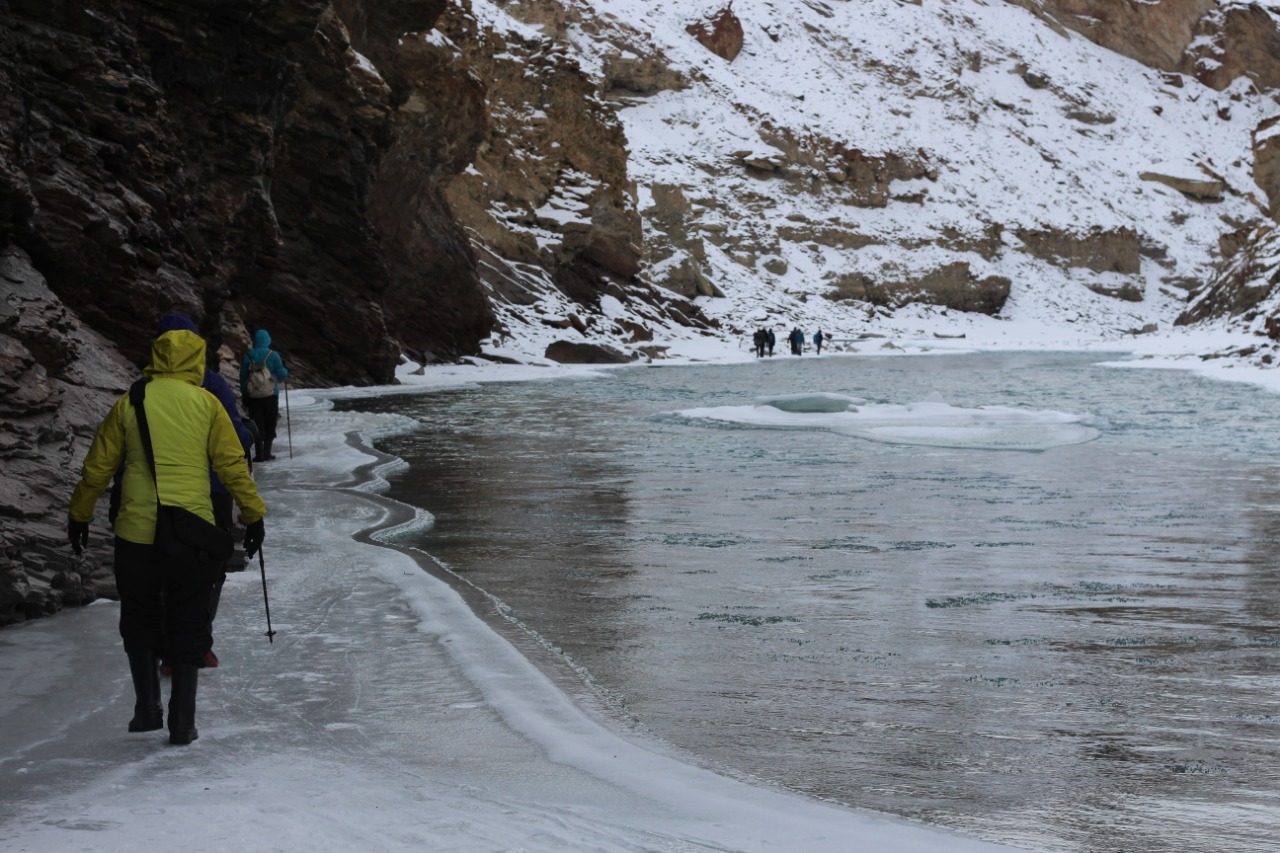
Zanskar winter trek located in Ladakh is home to dazzling wonder especially the gorgeous valleys and harsh terrains. It is difficult for the trekkers to survive in zero temperature among the inhabitable regions of the country. The frozen waterfalls give a mesmerizing view of the place. The trek is called the Chadar because the lake acts as a reflection of the sky where it becomes frozen during the winter season. It looks like a Chadar or a sheet of ice that time.
The exquisite caves and blazing bonfires give a natural touch to the entire surrounding in the freezing temperature. The Zanskar winter trek is extremely dangerous. However, it has some startling views. The Chadar Lake is located in the lap of nature making it one of the adventurous treks in the country. It is equipped with snow-capped mountains and mesmerizing valleys in the foothills of the Himalayas. It is one of the popular winter treks stretching over 60 kilometers around the snowbound villages.
Also Check: Kedarkantha Winter Trek
Also Check: Top 5 Winter Trekking tips
Best time to visit Chadar frozen river trek
Chadar trek in january.
The Chadar trek temperature in January drops down to -30 degree Celsius. The Chadar trek best time is mid of January as the lake is completely frozen. As the ice sheet does not become solid at the beginning of the month, it is not a good idea for trekkers. If the trekker has more weight then it is a risk for trekkers.
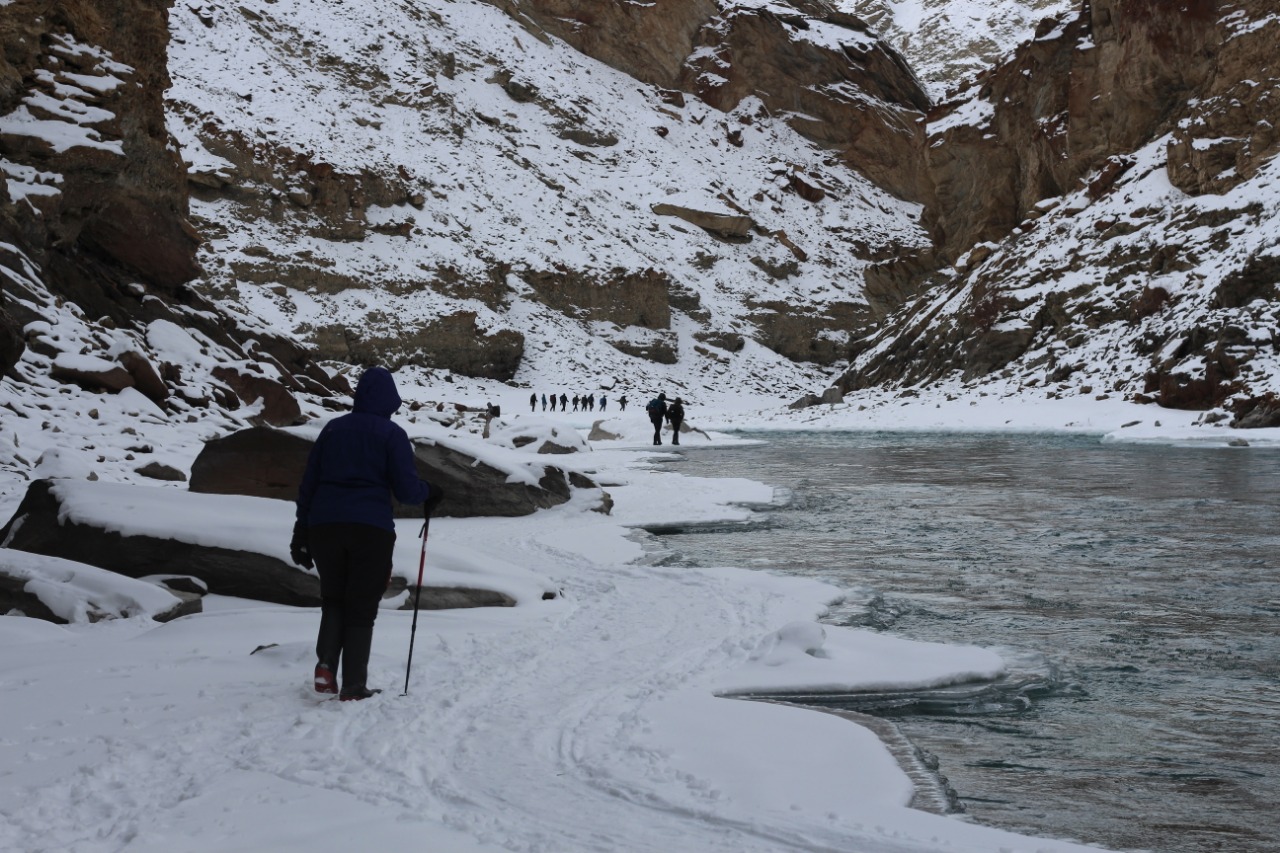
During this time of the year trekkers, get an opportunity to walk on the solid sheet of ice, which is up to 6 feet deep. The frozen river is covered with colorful pebbles and stones underneath. The weather fluctuates a lot in January where it is calm on one side and snowstorm on the other. Most of the trekking companies take groups of people to the frozen river trek in this time. During end of the month with proper clothing and essential items, people can accomplish the trekking.
Chadar Trek in February
At the beginning of February, the Zanskar River is completely frozen. It is an ideal time to go on the Chadar trek because the temperature drops down to -25 degrees Celsius. There are fluctuations of Chadar trek temperature throughout the day across the thrilling terrains of the world. Try to complete frozen river trek by the middle of February because after that the solid ice sheet melts to normal water.
It is considered the best time to visit Chadar trek because when the lake gets frozen you easily cover the distance of valleys. After that trekkers need to climb high passes and terrains to reach main Leh valley. Take guidance from proper trekkers and travel companies to fulfill the trek. When the river starts melting it is a threat for the trekkers as they goes missing. The chilled water of the lake can easily block the heart of people preventing them to breathe again.
Chadar Lake Weather and Temperature
As the Zanskar river is located at a high altitude the temperature fluctuates a lot due to direct sun rays. Sometimes the thick layer of snow on the river is melted and again freezes at night. It can become 5 to -25 degrees Chadar trek temperature at night. During the daytime temperature can rise and trekkers may feel hot. However, at nighttime, the temperature becomes chilling and almost froze.
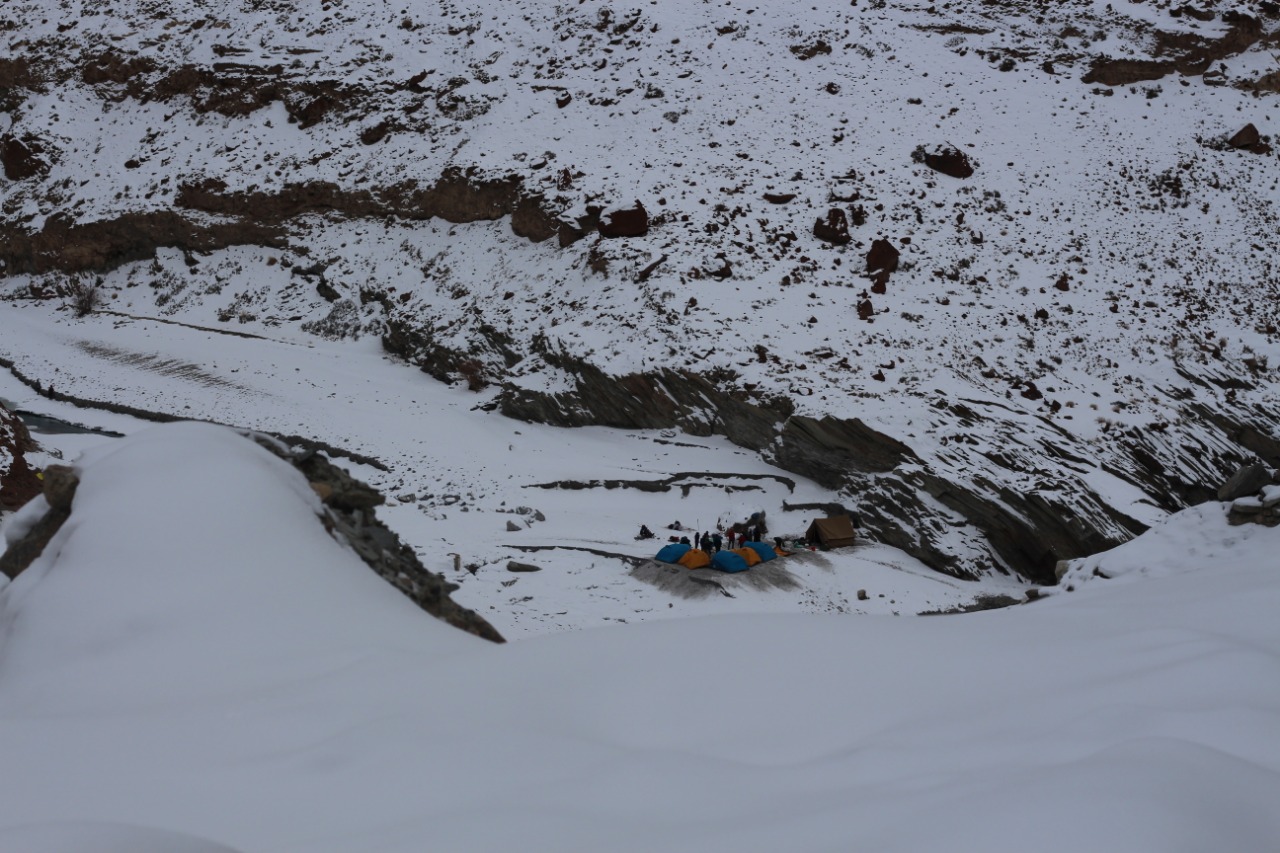
Some people can even be attacked by hypothermia in the chilling temperature if they do not take precautions beforehand. In Chadar frozen river trek, all the trekkers should undergo medical checkups and fitness tests before visiting the place. The entire journey is covered with fluctuating weather conditions and temperatures that require everyone in the Zanskar winter trek to remain fit and fine.
How to prepare for the Chadar trek?
About Chadar trek preparation, the Zanskar River is situated at an altitude that is impossible for every person to accomplish. For this reason, the government of Jammu and Kashmir, and Ladakh government authorities recommend everyone to undergo a physical fitness test that starts 2 days before the trekking journey. Everyone has to pass the test to start their journey.
Besides physical training, preparation of mental training is also required. Try to invest proper adequate time for planning before starting your journey. It helps in preparing your mental fitness before going to high altitudes. This process is useful in coming out of the comfort zone and seeing the rest of the world. Therefore, how can you prepare for the trek? List out all the things required for Chadar trek preparation. In this way, you will not miss any points.
Try to practice walking for at least half an hour per day before going on a trek. In the Zanskar trek minimum of 6 hours of walking is required each day, which is why it is a good idea to get a habit beforehand. Include some cardiovascular exercises and cross-fit training in the schedule. It helps to record the heart rate and monitor oxygen level. In high altitudes, maximum trekkers face problems regarding breathing and respiratory diseases. Indulging into these habits makes your trekking journey easier. Trekkers need to captivate lots of strength to cover at least 16km by foot per day in Chadar trek. It helps in surviving through chilling temperature. As trekking involves carrying bags throughout the journey try to practice walking with that. This will habituate your shoulder to carry weight every day.
Acclimatization
This is very essential before starting the thrilling trek to frozen river. Trekkers need to adapt to the negative temperature before the journey. You will experience sudden change of humidity, climate and pH level. Your body can get dehydrated easily and result in headaches and illness. Try to stay in Leh for at least 3 days and get sufficient sleep there. Eat nutritious food before the trek and avoid roaming in the evening.
Mental preparation
Apart from exercising and increase endurance, mental preparation should be given utmost importance. It is highly required for this Zanskar river trek. It will help you to keep moving and achieve the impossible. As the frozen river trek lasts for at least 8 days trekkers need a lot of enthusiasm. Be prepared for the challenges and hardships all over the trek. Situations can become worse at any point because of fluctuating weather. Though the cold is unbearable with sheer determination and courage, the journey can be achieved.
Why you should go for Chadar trek?
Walking on the frozen lake of Zanskar is one of the fascinating things you can do in winter. The ice sheet is thrilling to watch in the foothills of the Himalayas. It is a great way to take a break from the regular monotonous life. Frozen river trek is the most startling trekking journey that you will ever experience. However, there are some listed reasons for going on the trek.
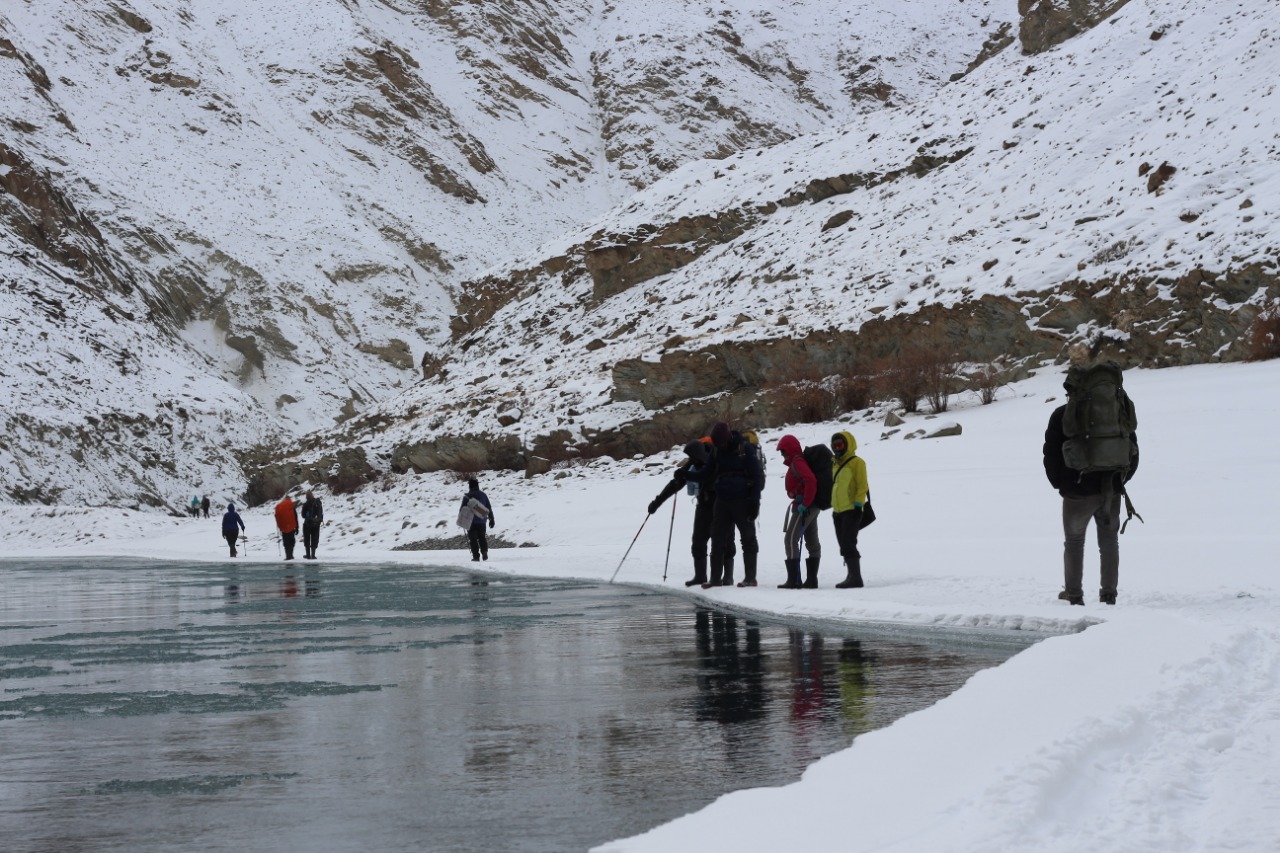
Distinctive Landscape of Chadar Trek
The Rocky Mountains and rough terrains that cross every person's mind surround the trekking to Chadar Lake in Leh. Harsh weather conditions and fluctuating temperatures due to high elevation accompany it. You can enjoy the frozen lake at a minimum of -30 degrees Celsius, which is sensational. A total 62 km trek to Chadar Lake will give you the largest experience in your life. There is no climbing in the hills because trekkers walk on the plain surface of the lake.
Amazing journey over the frozen lake
Snow-capped mountains and ice sheets of the lake surround the view. Trekkers feel chilled temperature throughout the journey. Frozen river trek is located at such a place where habitat is quite impossible. People cannot survive here due to a lack of oxygen and high altitude. However, trekkers are expected to cross the snows with all stamina. Your body will get heated up due to a large amount of walking. Pack all the necessary items carefully so that you do not miss any. The raging river of frozen river trek will ignite your stamina and boost your energy throughout the journey. Keep warmers handy for emergencies.
Camera shots: Memories
The whole journey of the Zanskar trek will let you capture splendid shots. It is all about fascinating mountains and the thrilling Zanskar River. After facing a chilled temperature of -5degree every day people get accustomed to it and it should end with joy of celebration. The 62 km trekking journey is bound to leave you speechless. Try to make every other trekker a part of the journey. The enthralling expedition is the most loved trek across the world.
Chadar trek itinerary
- Day 1: Arrive at Leh
Leh is located at an altitude of 11400 feet surrounded by snowcapped Himalayan Mountains with a long stretch of fascinating valleys. There is a drastic change of temperature in this region when you will wake up from sleep. The region is covered by only a few shops for the tourist equipped with very less quantity food. This Day is kept for rest and adapt to the changing temperature. Try to hydrate yourself by drinking enough water and the night is spent in a Homestay or guesthouse.
- Day 2: Acclamatization/Rest Day
The second day is kept for acclimatizing. Trekkers mainly spent the day at Leh market. Try to get adapted to the changing temperature because the weather will get harsh as you go up to the Zanskar trek. Make sure to check all the essential things before going to get and after waking up in the morning.
- Day 3: Body check-up at Leh
This day is for medical checkups and to get the wildcard that exists. The Jammu and Kashmir Government conducts the medical checkup and trekkers are only allowed to visit for the trek after passing the test. Insurance, permission, and important documents of Identity are required for permission. If you think that the Frozen river trek will be a dangerous route at this time then you can opt-out from the Zanskar trek and go on to a city tour of Ladakh without any extra cost.
- Day 4: Leh to Shingra Koma to Tsomo Paldar
Start your journey from Leh to Tsomo paldar via Shingra Koma. This route is trekking from 11480 to 10500 feet. Trekkers need to drive for 3-4hours to cover 75kms followed by 3kms trek route to the starting point. This is the most scenic place in the entire region of Ladakh. There is a variety of tourist spots in this region like Gurudwara Pathar Sahib and Magnetic Hill. You will reach Tsomo Paldar after traveling through the Zanskar River. This is the point where the actual Zanskar trek begins. Change your shoes at this point, as fragile terrains will begin from here. You can take a walking stick before beginning your journey. The first camp for the day is done at Tsomo Paldar. This place has below zero degree temperature at night.
- Day 5: Tsomo Paldar to Tibba cave
Travel from Tsomo Paldar to Tibba cave at 10800 feet. Frozen river trek is a kind of trek where the altitude does not raise in the first chance. You will reach 300ft up here by walking for 6 hours approx. Beautiful waterfalls and breathtaking mountain ranges accompany the cave. The rock patterns inside the cave glitter the morning sunshine all over the place. This is the campsite of the Zanskar river trek for the day.
- Day 6: Tibba Cave to Nevak
Travel from Tibba cave to Nevak camp at 11100 feet by walking for 7 hours. Complete your breakfast and then you will reach the frozen waterfall of the Zanskar river trek. Frozen river trek is an electrifying tourist spot for trekkers across the world. Trekkers are served with hot lunch on the way to Nevak. Here the temperature can drop down to the minimum of -30degrees Celsius. Try to reach the waterfall on time so that the village can be covered before sunset. Camping for the day is done almost 20minutes away from the frozen waterfall.
- Day 7: Nevak to Tibba Cave back
Travel from Nevak to Tibba Cave at 10800 feet by walking for 6 hours straight. After having breakfast, the return journey of the Zanskar river trek starts from here. Returning is not easy as it seems because the temperature here fluctuates a lot. Zanskar River witnesses a change of weather at any point in time. It is almost impossible to reach Tibba cave under a snowstorm. You can purchase traditional woolen clothes from here near Leh monastery. Camping for the day is at Tibba cave.
- Day 8: Tibba cave to Shingra koma to Leh
Travel from Shingra Yokma to Leh via Tibba Cave at 11400 feet. Leh is reached by car for traveling 8 hours. There are footprints of snow leopards, foxes in the Zanskar river trek. Trekkers who are starting the frozen river trek may ask you about the experience here. You will reach Leh by 6 pm. You can book the flight on this day but it is recommended to keep some extra time in hand and plan it for the second day. Spend the time in a nice cozy hotel at Leh and catch early morning flight.
Deals And Offer
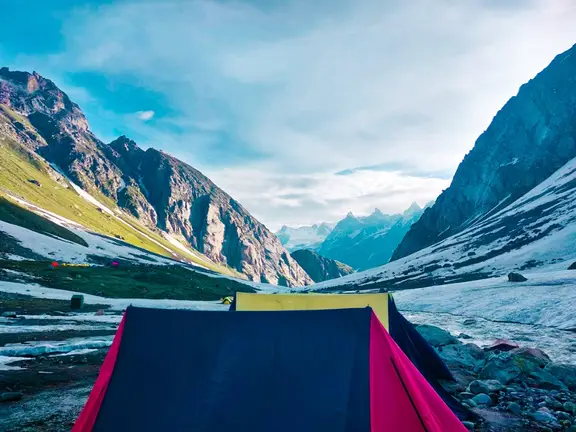
Hampta Pass Trek
4.87 ( 438 ), hampta pass trek 2024 - chandratal lake trek | moxtain, free cancellation till 30 days prior trek, rental & gear available on rent, book with 20% initial amount.
See Dates / Book Now
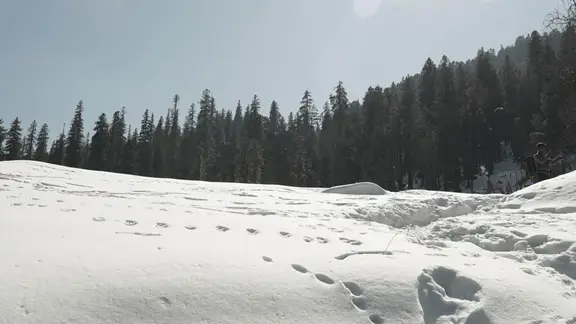
Dayara Bugyal Trek
4.85 ( 398 ), dayara bugyal trek 2024 - 6 days trek | moxtain.
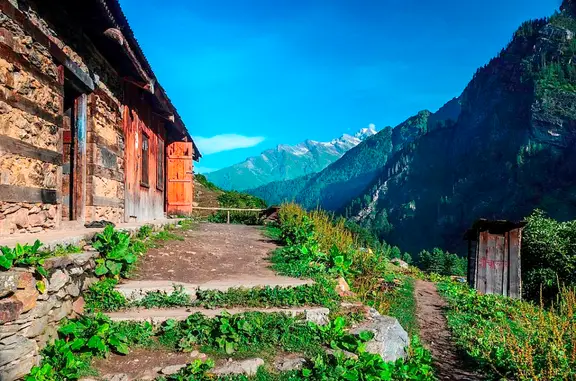
Kasol-Kheerganga-Tosh-Malana-Trek
4.56 ( 24 ), similar blogs.
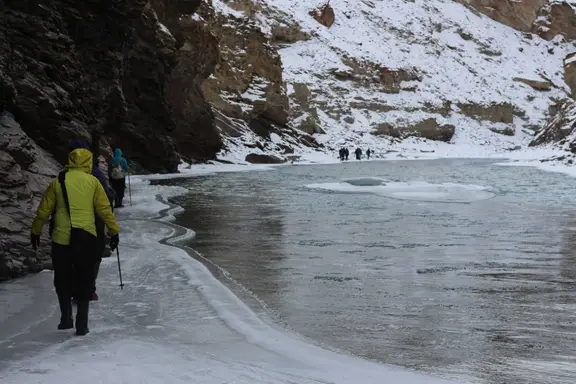
How To Maintain Personal Hygiene While On A Trek?
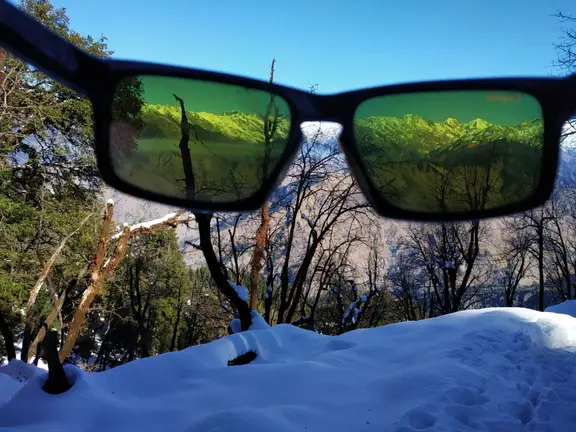
How to wear sunglasses with spectacles while trekking?
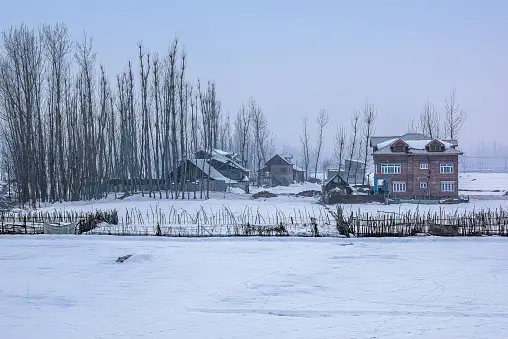
5 Best adventure activities in Pahalgam and in Sonmarg
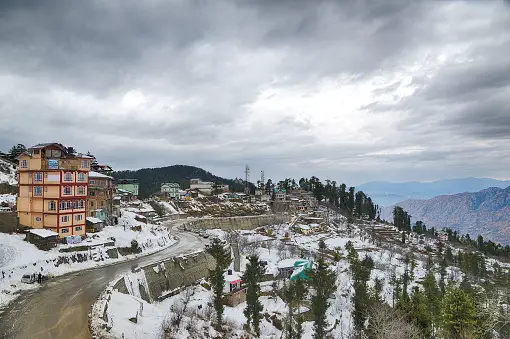
Top 9 Things to do in Kufri Valley and Best Time to Visit Kufri | Complete Guide
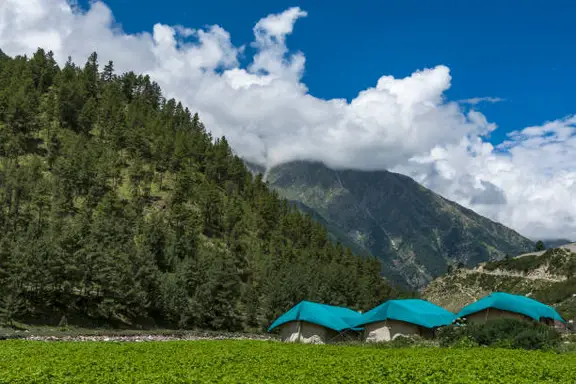
11 Best Short Trekking Routes In and Around Shimla
Similar trips, stok kangri, mayali pass, everest base camp trek, annapurna base camp trek, goechala trek, nag tibba trek, deoriatal chandrashila, bara bhangal, sandakphu phalut trek.

RoamingIndian
Where Travellers Connect
Chadar Trek
Chadar trek distance, chadar trek height, trek difficulty, why choose chadar trek.
Chadar Trek: “Winter Trail on Frozen Zanskar River”
Chadar,” a term that translates to “sheet of ice,” marvelously captures the transformation of the Zanskar River during winter. This natural wonder sees the swift river turning into a pristine white expanse, resembling a glassy quilt ranging from shades of bluish tinge to golden yellow under the sunlight, and a serene milky white in the moon’s gentle glow. This trekking adventure is truly unparalleled.
The Chadar trek forms a vital lifeline, connecting remote villages nestled deep within the Zanskar mountains with Chilling, situated along the frozen Zanskar River . This age-old route, historically employed for trade and transportation, is at its most reliable in February when the ice attains optimal stability.
Embarking on the Chadar trek is not just a journey; it’s an odyssey into the heart of nature’s frozen wonders. The frozen riverbed serves as a canvas for an unforgettable experience, offering trekkers a unique blend of challenge and awe-inspiring beauty. Witnessing the Zanskar River’s metamorphosis into a surreal ice sheet is an adventure that leaves an indelible mark on the soul, making it a must-experience trek for every avid adventurer.
- Certified Trek Leader
- Transparent Pricing, Zero Surprises - ( No hidden costs )
- Our mission is your memorable journey
Highlights of Chadar Trek
- Experience the Zanskar River transforming into a captivating sheet of ice, creating a surreal landscape.
- Trek on the frozen riverbed, navigating through icy terrains and breathtaking gorges, offering an unatched challenge.
- Explore remote villages along the route, interacting with the warm-hearted locals and understanding their traditional way of life.
- Follow the ancient trade route used for centuries, connecting isolated mountain villages with the outside world.
- Overcome the challenges of trekking on icy surfaces, making the journey immensely rewarding and memorable.
Chadar Trek Available Dates
Fixed Departures Every Week.
Call 8090993036 for more information for group treks.
Chadar Trek Itinerary
Arrival in Leh, nestled at an altitude of 3500 meters (11,400 ft), where you will be accommodated in a comfortable Guest House.
Acclimatization stroll in Leh at an altitude of 11,400 ft, followed by a relaxing stay in a cozy Guest House.
Undergoing a medical examination at SNM Hospital, located at an altitude of 11,400 ft, followed by a comfortable stay in a nearby Guest House.
Descending from Lower Shingra to Somo Paldar, transitioning from 11,400 ft to 10,390 ft. The journey includes a 75 km drive and an 8 km trek, culminating in a night's stay in tents.
Trekking to Dib Cave/Tibb, navigating an altitude range from 10,550 ft to 10,760 ft. Covering a distance of 15 km on foot, the trek concludes with an overnight stay in tents.
Continuing the journey from Dib Cave/Tibb to the Camp at Naerak, the trek spans an altitude from 10,760 ft to 11,150 ft, covering a distance of 12.5 km. Experience the mesmerizing surroundings before resting for the night in tents.
Trekking from Naerak to Tibb/Gaylpo, the route covers an altitude range from 11,150 ft to 10,760 ft, spanning a distance of 14.5 km. Rest for the night in comfortable tents amidst the serene wilderness.
Embarking on the final leg of the journey, trek from Tibb to Shingra Koma, covering altitudes ranging from 10,390 ft to 11,400 ft, spanning 8.5 km. After the trek, enjoy a scenic 75 km drive back to Leh. Rest and unwind in the comforts of a guest house.
Check-out from the guesthouse in the morning and depart from Leh airport.
Trek Inclusions
- Accommodation in tents during the trek and in a hotel in Leh on days 1, 2, 3, and 8 as per the itinerary.
- Vegetarian meals during the trek.
- Trekking equipment.
- First aid medical kits and oxygen cylinder.
- Expert trek leader, guide, and support staff for assistance.
- Transportation from Leh to the road head and back.
- Transportation from Base Camp Leh to Leh as per the provided itinerary.
Trek Exclusions
- Meals in Leh, available at Leh Hotel/Guest House at Rs.250/- per meal.
- Personal expenses of any kind.
- Local fees such as Environmental Fee, Wildlife Fee, ALTOA, LAHDC, etc., ranging between Rs.300/- to Rs.2500/-* (subject to variation).
- Porter service for personal luggage, available at Rs.3750/- per day (5 days) for up to 10kg baggage.
- Anything not explicitly mentioned under 'Inclusions'.
Photo Gallery
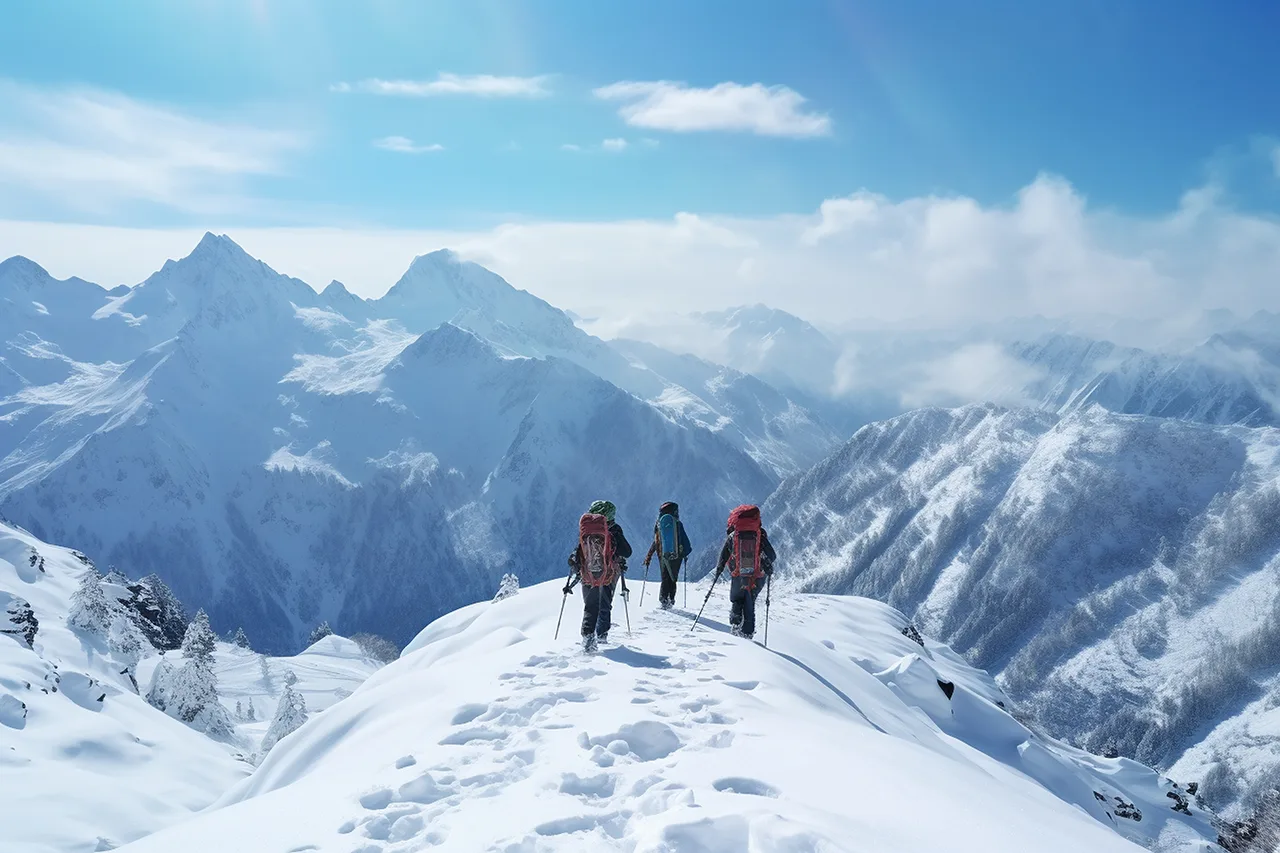
Chadar Trek Detailed Itinerary
Arrival in Leh (3500 m) Leh, situated over 3500 meters above sea level, ranks as the second-largest district in the country. During winter, when most passes leading to Leh are inaccessible, you’ll be flown to the Leh airport, the world’s highest airport. As you touch down, the dry, cold air welcomes you, but the breathtaking sight of snow-capped mountains steals the show. Complete arrival formalities, grab your luggage, and head to the pre-arranged hotel. Enjoy an overnight stay.
Acclimatization Walk in Leh Rise early for an acclimatization walk at high altitude. Head to Shanti Stupa, a sacred Buddhist stupa, offering a stunning sunrise view and a panoramic sight of Leh. Stay hydrated as you acclimate to the altitude on your first day in Leh.
Medical Check-up at SNM Hospital Due to the trek’s challenging nature, a medical certification is mandatory. Undergo a medical check-up at Sonam Narbu Hospital to obtain a clearance certificate, ensuring fitness and acclimatization for the trek.
Shingra Koma and Somo Paldar Enjoy breakfast and embark on a journey to Shingra Koma. The thrilling drive involves bumpy roads and hairpin bends, offering awe-inspiring views of the surrounding high mountains. Disembark and trek to the Somo Paldar campsite, marking the start of your Chadar trek.
Trek to Dib Cave/Tibb Embark on a trek to Dib Cave/Tibb, surrounded by breathtaking ravines and gorges. The steep cliffs limit sunlight, creating a unique atmosphere. Reach Dib, a large cave, where you’ll halt for the night. Experience butter tea and relish an overnight stay.
Dib Cave/Tibb to Camp at Naerak Trek through the scenic region, witnessing the largest frozen waterfall and prayer flags. Visit the village of Naerak, interacting with locals and immersing yourself in their way of life. Enjoy a comfortable overnight stay in the village camp.
Naerak to Tibb Embark on the return trip, trekking towards Tibb. Admire the changing beauty of the frozen river and interact with locals along the way. Relax at Dib Cave and stay overnight at the campsite.
Tibb to Shingra Koma & Back To Leh Depart Tibb for Shingra Koma, crossing Gyalpo. Witness high mountains and wildlife pugmarks, possibly spotting snow leopards and ibex. Return to Leh in the evening, staying overnight at the hotel.
Departure from Leh Your remarkable journey through this scenic destination concludes. Check-out from the guesthouse in the morning and depart from Leh airport, carrying the unforgettable experiences of this adventure.

What Mountains Teach Us About Life
In the embrace of the mountains, we discover not just the peaks and valleys of nature but also the heights within ourselves. Our journeys, whether planned or spontaneous, trek us through uncharted terrains and unpredictable weather, mirroring the challenges and triumphs of life itself.
Packing Essentials for Chadar Trek
- 2 pairs of synthetic track pants (wear one over the other for added warmth)
- 2 full-sleeve tees with collar
- Fleece jacket (avoid sweaters)
- Full-sleeve thick jacket
- 4 pairs of undergarments
- 2 pairs of thermal inners
- 2 pairs of sports socks and 2 pairs of woolen socks
- Woolen monkey cap/balaclava
- Woolen hand gloves + synthetic gloves (waterproof)
- Hot water bottle/bag (available at medical stores)
- Sunglasses with 100% UV protection
- Gumboot (if not purchased from Leh)
- Backpack (55 – 65 L) with sturdy straps and supporting frame
- Daypack (20 L) if offloading your backpack (inform in advance)
- Trekking shoes (good standard trekking shoes or gumboot recommended)
- Trekking pole (mandatory)
- Woolen head-scarf or muffler
- Light towel (thin, quick-drying)
- Chapstick or lip balm
- Cold cream and sunscreen lotion (SPF 40+)
- 2 water bottles (1 L each)
- Personal medicine kit
- Personal toilet kit and toilet paper
- LED torch with extra set of cells (headlamps preferred)
- Small repair kit (safety pins, needle, thread, and string)
- Camera, memory cards, batteries
- Plastic bags for compartmentalizing and carrying wet clothes
The Big NO:
- No denim or jeans
- No snacks, colas, alcohol, or personal food
- Keep the weight of your gear in the range of 8-10 kg
- Avoid carrying non-biodegradable materials
Mandatory Documents:
- Govt. Identity Card
- Medical Certificate
- Self Declaration
- Passport Size Photograph
Please click here to download the forms
Submit your inquiry using the form below
Cancellation policy.
In case, you are unable to travel or willing to cancel the trip, you can transfer the trip to any of your friends/known persons. Please note that this feature is applicable only when the status of the Booking is “Paid” and there are at least 5 days remaining before the departure date (departure date minus 5). Drop an email to [email protected]
Please note that the replacement would not be applicable to any Volvo/Train transport booked for the original participant. The same would be automatically canceled. This is simply because the seats booked in such transport mediums are not transferable.
The Refund of the amount will be processed as per deduction guidelines outlined below:
* If cancellations are made 30 days before the start date of the trip, 10% of the total tour cost will be charged as cancellation fees or get the full amount of the RoamingIndian trek voucher, which can be used later to book another trek.
* If cancellations are made 15-30 days before the start date of the trip, 40% of the total tour cost will be charged as cancellation fees.
* If cancellations are made within 0-15 days before the start date of the trip, 100% of the total tour cost will be charged as cancellation fees or get a RoamingIndian trek voucher of 50% of the amount.
Treks in Uttarakhand
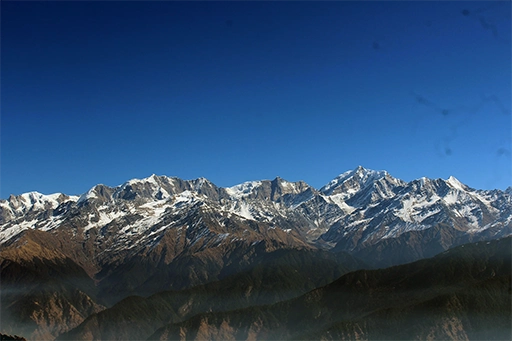
Dayara Bugyal Trek
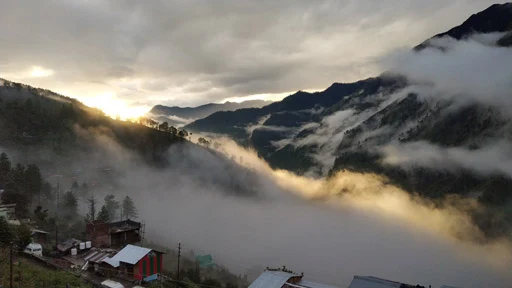
Har Ki Dun Trek
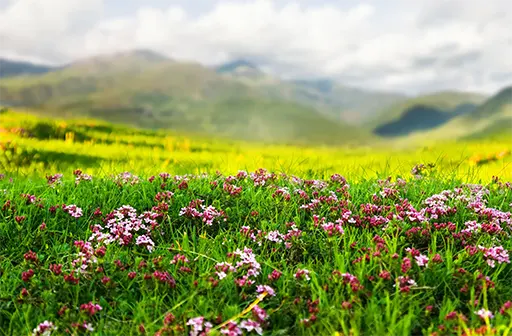
Valley of Flowers Trek
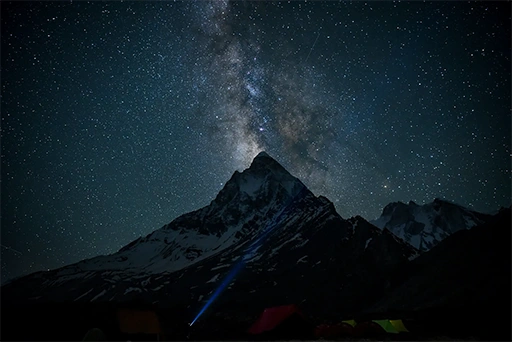
Gaumukh Tapovan Trek

Chadar Trek Ladakh: Your Ultimate Wonderland Expedition Guide
- Updated on April 2, 2023

The Chadar Trek is one of the world’s most challenging and exciting treks. It provides the ideal opportunity to discover a completely new environment in the Zanskar Valley. The Chadar Trek, also known as the Zanskar Gorge, is a winter trek that rises 11,123 feet above sea level. Throughout the summer, people flock to the lower region of this valley for river rafting excursions. During wintertime, the Zanskar River freezes, and hikers flock to this area to appreciate the scenery.
As part of the ‘Chadar’ (ice sheet) trek across the frozen river, visitors and trekkers from around the world enjoy the spectacular scenery and surprises it offers.
Table of Contents
What is the ideal time to plan your trek to Chadar?
January and February are the best months to go on this beautiful trekking excursion. Specifically, if you schedule your trip between the 15th of January and the end of February, you will be able to appreciate the unparalleled splendor of Zanskar Valley. The river freezes into a gleaming sheet of ice, and the valleys create a pure white track for trekking adventures. Furthermore, the snow-capped mountains that accompany you all the way shimmer and sparkle in the first rays of the light.
During the day, the temperature in Leh varies between -10 & 0 degrees Celsius. At night, the average temperature is about -25 degree celsius. So, we suggest trekkers carry extra woolen clothing to be warm in this chilly weather.
Chadar Trek: How Difficult Is It?

According to the Chadar trek guide, this is among the country’s most challenging and toughest treks. During the winter, the Zanskar River freezes into a frozen sheet. Zanskar Valley can only be reached by the Chadar Trek. Due to snowfall, all mountain passes are closed, leaving the Chadar or the frozen Zanskar River as the sole options for travel.
January and February are perfect for this walk because the rushing river is harnessed in the bounds of blocks of ice, and the surroundings are all coated in the pure white splendor of snow.
The temperatures are extremely low all day and drop to extremely cold temperatures at night.
Cold weather and challenging camping conditions should be expected during the Zanskar trek. The walk covers around 105 kilometers, most of which is covered on foot. It is also possible that the trekkers will be needed to climb cold rocks and stones.
Because the evenings are spent in caves near the ice river, all participants should bring warm jackets, sturdy shoes, and sleeping bags.
What should you do before your Chadar Trek?

If you plan to do the Chadar Trek, here are a few things you must consider. That will contribute to your pleasure and make your winter trip to Ladakh unforgettable.
There is usually an experienced trekker known as the alpha. This individual takes on the role of trek leader, and you should always follow them. They are acquainted with the entire walk and are also provided with technical expertise that can help other trekkers.
Make sure your loved ones and family members are aware of the itinerary ahead of time. It is usually beneficial to have some company on this journey. If you decide to travel alone, make some friends along the way, so you don’t feel left out.
You must eat nutritious food most of the time so that your body can create the necessary warmth throughout the Chadar Trek. It is essential that you maintain your body hydrated throughout the trip.
To start, a fleece jacket and water-resistant sneakers are recommended. If your clothes become wet, move to a dry location as quickly as possible. Do not rely on others for support; instead, carry a first-aid kit before commencing your lovely winter adventure.
- 8 Days Ladakh Tour Package
- Pangong Kahrdungla Trip 5 Days
- 5 Nights 6 Days Ladakh Travel
- Ladakh With Turtuk Tour 7 Days
- Ladakh Kargil Nubra Pangong Trip
- 12 Days Kashmir Ladakh Manali Package
- Srinagar Ladakh Manali 11 Days Tour
What should you not do on your trek to Chadar?
There are several do’s and don’ts that you must follow during your Chadar Trek. You should not leave any of your food packets in the valley. Keep all food packages in your bag to be a responsible traveler. Do not litter in any way. You should avoid stepping out alone or without telling others.
Make sure you are healthy, so whatever the reason, don’t skip meals or stop sipping water from time to time. Each of these factors is important during the Chadar trek. In any circumstances, never panic. If you believe your body can’t handle it any longer, take a break and then get back to walking. So keep your body comfortable and don’t overdo it. Eat light food on your trek.
Day by Day Itinerary for Chadar Trek in Ladakh:
1st day: reach leh.
After you arrive in Leh, you will be transported to the assigned accommodation. The initial day will be dedicated to acclimatizing to the high altitude while staying indoors. This will be important in the coming days. You can stay in a hotel for a night.
2nd Day: Acclimatization
The next day, one may go sightseeing and experience the local highlights of Leh or simply rest at the hotel. Spend the night in a hotel.
3rd Day: Full Body Checkup
You will be escorted to the local hospital in Leh for a health checkup today. It is mandatory to take a medical certificate before starting your Chadar Trek. In addition, following the medical assessment, one must obtain a clearance certificate from the hospital.
This certificate will be provided only if the participant is considered suitable and acclimatized for the trek. Then you can rest at the hotel overnight.
4th Day: Leh to Shingrayokma to Tsomopaldar
Following breakfast, you can drive to the magnificent valleys and see the Indus and Zanskar rivers, which meet at the Nimoo confluence. From Nimoo, you may begin the trip towards the Shingra Yokma road.
At this point, you will disembark and begin your hike to the TsomoPaldar campground; then, you can spend your night in a tent.
5th Day: Tsomo Paldar to Dibb Cave
On day 5, you can begin your journey to the Dibb cave. Going into the deep canyons of the Zanskar valley, you can see towering cliffs on all sides and unspoiled snow.
At the end of the day, you must have arrived in the cave, which is a popular site for locals to explore. Then a camp will be set up for the night here.
6th Day: Dibb Cave to Nyerak
After breakfast, you will pass the picturesque gorges to Nyerak village. The journey will take you through a big ice waterfall that acts as a rest stop for rafting expeditions that take place between August and September.
The tent for today will be put up in Nyerak village so that you can tour the area in the evening. Stay in the tents for the night.
7th Day: Nyerak to Hotang
Today you’ll follow the same route you followed yesterday from Nyerak to Hotang. Enjoy an overnight stay in the tents at the end of the day.
8th Day: Hotang to Shingra Yokma
This is the final day of the hike, and you will leave after breakfast for Shingra Yokma. The expedition will take 9 hours of walking over the hard ice, including a short stop. After the trek, you will be returned to Leh and spend the night at a hotel.
9th Day: Departure from Leh
On the final day of your journey, you will be taken to the airport, where you will begin your travel to your following location.
What types of foods are offered?
The food supplied throughout the expedition is carefully selected and prepared. On the journey, Indian vegetarian and egg meals are typically offered. It is essential that the participants’ food requirements are addressed throughout the walk. The region’s climatic conditions are harsh and distinct from those on the mainland.
Hence, to keep all trekkers in excellent health & energized for the journey ahead, well-cooked veggies and eggs are served. Throughout the walk, and especially when preparing the food, hygiene, and safety are top priorities. As a result, great attention is given when preparing food for the guests.
What items should be included in the Chadar Trek checklist?
Apart from everything else, creating a checklist is essential. Before you go, ensure you have everything in your backpack. Keep in mind that the entire journey takes around eight days. All of the items listed below should be on your Chadar Trek checklist.
- Spiked trekking boots
- Bottles of water
- A fleece jacket to keep you warm
- Sunscreen and lip balm
- Hand Sanitizers
- A first-aid kit
- Bags for trash
- AMS medications
- Bars of chocolate
- Warm clothes
- Warm gloves
- UV-protection goggles
- Little Snacks
If you’re the type of explorer who ensures everything is noticed, the chadar trek should be on your bucket list. It is not only one of the most incredible winter treks in India, but it is also a fun thing to do. The things stated above should be considered while planning your vacation.
We hope that this comprehensive guide to the magnificent winter trek- Chadar- assists you in remembering all of the necessary details.
Similar Content:
- Popular Places in Ladakh to Visit in July 2023
- Ladakh Tour in May 2023 For Famous Places
- Famous Honeymoon Places in Ladakh
- June Visit in Ladakh for Popular Destinations
- 7 Most Popular Restaurants in Ladakh
- Ladakh Tourist Places to See in August
- Top 10 Trekking Destinations in Ladakh
- Visit Ladakh Destinations Travel in September
- Most Popular Offbeat Places in Ladakh
- Ladakh 6th Siachen Folk Festival in Nubra Valley
- Now Fly and Explore Ladakh in a Helicopter
- Best Time to Visit Leh Ladakh via Manali – Month-by-Month Guide for Road Trip
- Nubra Valley is to be upgraded and the Sumoor desert developed in Ladakh
Tusk Travel Team
Tusk Travel is dedicated to delivering precise, genuine, and reliable travel guides through a dynamic team of writers, editors, and destination experts. We aim to provide comprehensive information in its simplest form, sharing insights to influence perspectives nationwide.
Related Posts

10 Best Places to Visit Ladakh in May 2024

Ladakh in April 2024: Guide to Top Destinations and Trip Planning

Travel Guide to Leh Airport (IXL) – Kushok Bakula Rimpochee Airport

Ladakh Galdan Namchot: A Luminous Celebration of Life and Culture

Ladakh’s Grand Festival: Join the Celebration from September 21-24

World’s New Highest Road to Rise in Ladakh, Surpassing Umling La
Leave a reply cancel reply.
Your email address will not be published. Required fields are marked *
Name *
Email *
Add Comment *
Save my name, email, and website in this browser for the next time I comment.
Post Comment
- Group Enquiry? NEW
- A Complete Guide to Chadar Trek
- Jammu And Kashmir
Guide to Chadar Trek, one of the most adventurous and thrilling treks in the world, offers the best chance to explore a whole new world in the Zanskar Valley. This Guide will help the trekkers to beat all the challenges while trekking through the frozen Zanskar River, unfolding the mystery of the Himalayas.Embark on this unforgettable adventure as part of your Leh Ladakh holiday packages .
The lower sections of this gorge are extremely popular in summers with tourists trooping in for river rafting expeditions. In winters the Zanskar River freezes and trekking enthusiasts flock to this region to enjoy hiking expeditions.
During the winters, the road to Zanskar Valley is closed due to snowfall and this makes the frozen river the only way to access the valley. The trek across the frozen river is called the ‘Chadar’ (ice sheet) trek and it holds many surprises and scenes of breathtaking beauty, which attracts tourists and trekkers from all over the country and the world.
Quick Navigation
What is chadar trek.
The Zanskar River freezes in the winters. The entire river looks like a sheet of ice and hence is referred to, in the local language, as Chadar. From a tourism point of view, this trek has been popularized as the frozen river expedition and draws in several amateur and professional trekkers from different parts of the country and the world.
Chadar trek in the beautiful landscape of Ladakh is one of the most adventurous and most difficult treks in the country. The distance that is covered on foot is approximately 105 km and on an average, a trekker covers 15 to 17 km every day. The temperatures are usually 15 to 20 degrees during the day time and plummet to -25 to -35 degrees during the night in this region.
As per the chadar trek guide, while most of the trek is completed by walking, trekkers may even have to climb icy rocks and boulders during the journey. During the journey, the trekkers will walk on the sheet of ice to cover the distance and will rest in caves during the night time.
Due to the extremely cold conditions that a person has to face during this expedition, it is advisable that every aspirant fully understands the conditions that he will face ahead and prepare accordingly. A person should be acquainted with walking long distances and be prepared for tough camping situations. It is advisable that every trekker carries warm clothes, a sleeping bag and sturdy shoes for the trek.
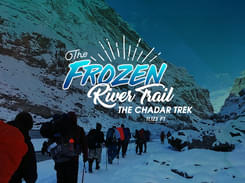
Best Offers on Himalayan Treks: Enquire Now
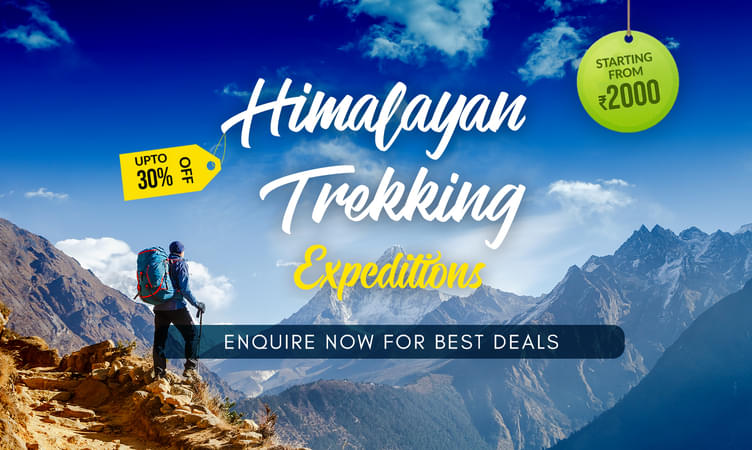
Why Chadar Trek?
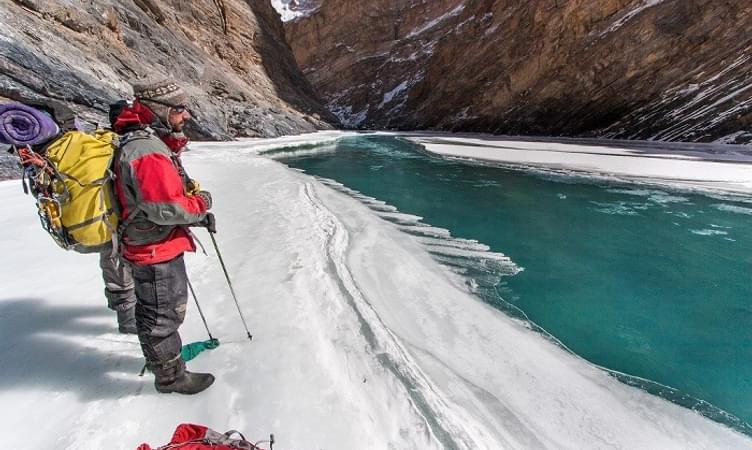
For adventure enthusiasts, trekking is not just an expedition. Trekking is a mode to relieve oneself of the worries of day to day life, revive the spirit of adventure and excitement by undertaking tough challenges and winning them. This trek is not just any other trekking experience.
Trekkers have to face the toughest of challenges, tread through chilly weather and landscape and sleep in caves during this expedition. According to the chadar trek guide, this trek holds the secrets of the beautiful Himalayas and enables a person to enjoy the mesmeric beauty of the snow-clad mountains and beautiful city of Leh.
For every person who seeks adventure and is ready to face the harshest conditions and take up the most challenging tasks, this Guide to Chadar Trek is a must. The excitement of walking on ice and climbing on icy rocks is unbeatable and matchless. This trek is an absolute must-do for those who have a flair for high altitude trekking and taking on challenges as they come in life.
When is the Best Time?
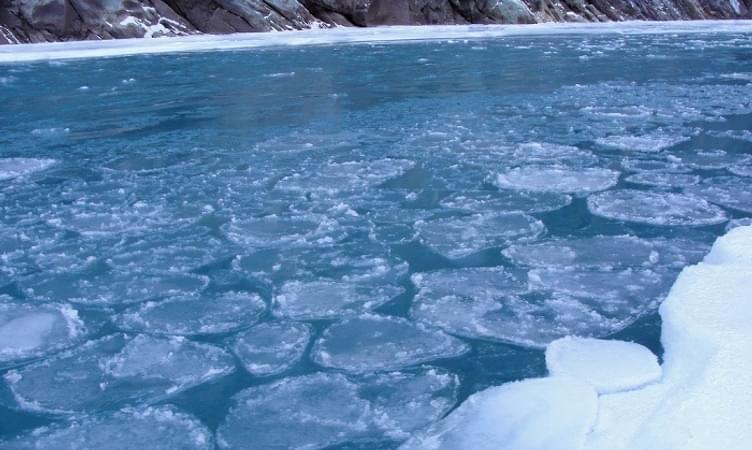
The best time to take the trek is in January and February. Precisely, from January 15 to the end of February is just the right time to set out on this wonderful and adventurous trek. The river freezes into a beautiful sheet of ice and the surroundings are clad in snow presenting a pristine white trail for hiking expeditions.
The snow clad mountain peaks that will accompany you all along your way to your destination glisten and gleam in the morning rays of the Sun. This is a breathtaking view to watch and the trek is incomplete without being able to enjoy such mesmeric beauty.
The beauty of the landscape is the most rewarding part of the trek. Although the trek itself is quite arduous and tasking, the beauty that opens up before the trekkers compensates for the all the trouble and effort put in.
The frozen river trek is the most rewarding trekking trails in the country and will test your physical stamina and mental focus before opening up its secrets to you. Although the summers attract a large number of water sports enthusiasts from all over the country, this trek in the winters still remains the most popular activity in Leh.
How Difficult is Chadar Trek?

As per the Chadar trek guide, this trek is one of the most difficult and challenging treks in the country . The Zanskar River freezes into a sheet of ice and is the only route to access the Zanskar Valley during the winters. All mountain passes are shut down due to snowfall, leaving the Chadar or the frozen Zanskar River as the only route for passage.
The ideal or best time for this trek is in the months of January and February as the swift river is harnessed in the bounds of blocks of ice and the surroundings are all covered in the pristine white beauty of snow. The temperatures are incredibly low during the day time and plummet to uncomfortably freezing temperatures during the night time. Trekkers who want to explore the Zanskar trek must be prepared for facing unsettling temperatures and harsh camping conditions. The total distance covered in the trek is around 105 km, most of which is covered on foot. There might also be instances wherein the trekkers are required to climb icy rocks and boulders. The nights are spent in caves near the frozen river and hence all participants should come prepared with the warmest jackets, sleeping bags and sturdy shoes. The camping conditions, unlike in other trekking expeditions, are extremely tough and hence each participant should be mentally and physically prepared for the challenges ahead.
How Cold Does it Get?
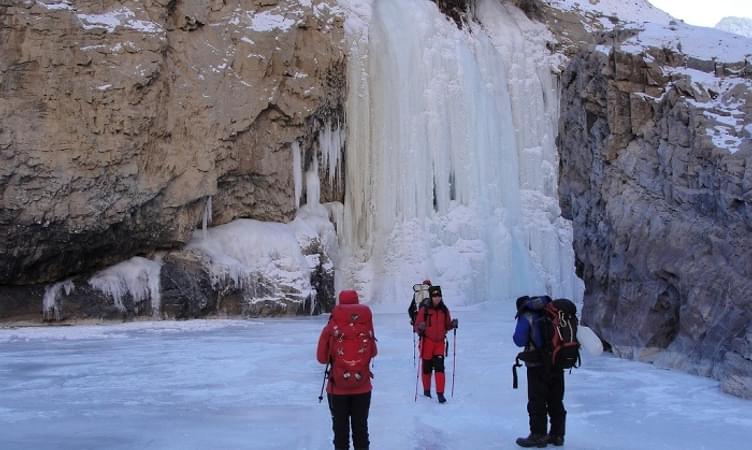
The Chadar trek expedition is conducted in the winters. The best time to set out on this expedition is in January and February. The swift and steady River Zanskar lies harnessed in bindings of ice and everything around is covered in pristine white snow.
The temperatures are amazingly low during the day time and hover between 15 to 20 degrees while they plummet further to -25 to -35 degrees during the night time. The climatic conditions of this region are quite harsh and extremely cold. So for any visitor who wishes to explore the Zanskar trek, it is extremely important that he is physically and mentally prepared for the trek
The total distance covered during the trek is around 105 km and most of it is covered by walking through these extreme conditions. You may also be required to climb icy rocks and boulders during the journey which makes it extremely essential for you to be physically and mentally fit.
The journey is arduous and tasking, especially because of the extremely cold temperatures. Furthermore, while during the day time you will have to walk over the chilly sheet of ice or the frozen Zanskar River, during the night time, you will have to sleep in caves near the frozen river.
How Long Do We Walk Each Day During the Trek?

The total distance covered along the trek is 105 km. Trekkers will be required to walk around 15 to 17 km a day to complete the trek. The trail is along the frozen River Zanskar which lies harnessed and bound in its icy bindings and the snow-clad surroundings are a treat to watch.
The most rewarding aspect of this tough and challenging trek is that it rewards everyone with the secrets hidden in the snow-covered slopes of the Himalayas and opens up a vista of breathtaking Himalayan beauty to its visitors. During this guide to the Chadar trek, you will be required to walk along the length of the frozen River Zanskar and also, at times, climb icy rocks and boulders.
The temperatures are unsettlingly low and every aspirant must be physically and mentally prepared for the tough camping conditions. The Chadar is the only connecting route during winters into the Zanskar Valley and the Ladakhis and Zanskaris use this route twice a year. The climatic conditions may not be exactly favorable but the adventure and challenges that the trek has in store for the adventurous make it one of the most popular high altitude trekking trails in the country.
Most of the journey is covered on foot by walking on the pristine white solid sheet of ice and a little bit of climbing and maneuvering. The nights are spent in chilly caves near the frozen river, which makes it mandatory for every trekker to carry along the warmest of jackets, sleeping bags, and sturdy yet warm shoes.
Trek Itinerary

The journey begins at New Delhi from where participants interested in the Chadar Trek will be transported to Leh. This is followed by a visit to nearby monasteries or any local festivals that are happening at the time.
On the third day you will be taken on a full day tour of Phyang, Liker and Alchi for sightseeing.
On day four, you will proceed from Leh to Chilling to Zaribago and cover the distance over five hours of trekking. You will spend the night in a camp at Zaribago and proceed for the next destination in the morning. On the fifth day, you will move from Zaribago to Deepyokma which is a four hour trek on foot.
The evening is spent in Deepyokma and the next morning i.e. on the sixth day you will trek to Nyrakpulu. This distance is covered in four or five hours of trekking. The next morning you will trek for one hour from Nyrakpulu to Lingshed. You will spend the eight day in Linghshed relaxing, sightseeing and preparing for the next day’s trip.
From Linghshed you start trekking on the Chadar. On the ninth day, you will trek through the icy surroundings of Linghshed. After spending a day in the beautiful environs of the Himalayas and the mystical Zanskar River, you trek on for four hours to Tsomopaldar.
The next day i.e, on the 11th day you move from Tsomopaldar to Tilatdo in a five hour trek. On day 12, you undertake a five hour trek from Titado to Chilling. On day 13, you are transported back from Leh to New Delhi . The entire journey is of 13 days and is one of the most amazing experiences that you can have.
How Big are the Groups?
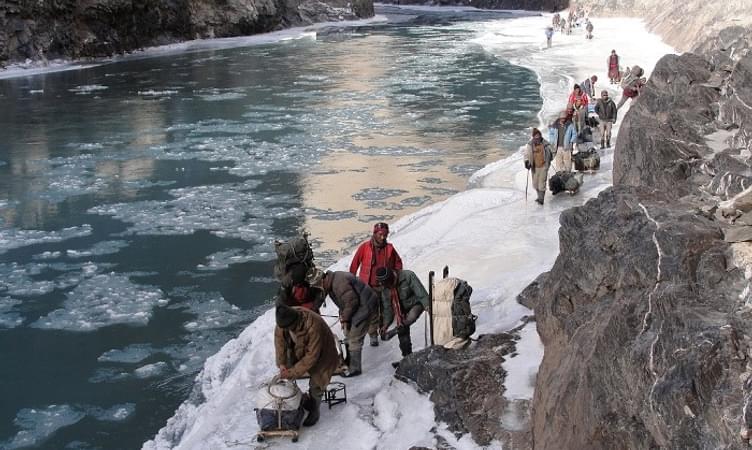
Ladakh Trekking with a group of friends is definitely an enjoyable experience. You can set out on this expedition with your friends, colleagues or family. Usually, at least six persons are required for the expedition. However, as many as 15 or 18 persons can be included in the group. Usually, a large group does not exceed this number.
The objective of keeping the groups relatively small is to ensure good management and also make sure that all guests have a wonderful and memorable experience. Usually, the groups consist of like-minded people who can enjoy and relish the beauty of the region in spite of the harsh conditions.
The groups usually consist of both men and women. To ensure the safety of women during the trek, the guides and other support crew are carefully selected for the trips. The trek is usually led on by a professional trekker who has completed the basic and advanced mountaineering course and certified in the first-aid course.
The team will be accompanied by a local guide, a cook, a helper, a porter and other staff. Complete care is taken to ensure the comfort and safety of all participants during the arduous trek on the frozen Zanskaar River.
Accommodation Arrangement for the Trekkers

In the mainland, all accommodation is made in A Class hotels with all meals included in the package. Comfortable accommodation will be arranged for trekkers. Usually tents are used while camping and persons are generally accommodated in a two man tent. However, due to the harsh and extremely cold climate, trekkers are advised to get some essential items such as steam crossing sandals, insulating fleece jacket, rain proof jackets, insulating gloves, warm sleeping bags etc to protect themselves.
During the trek on the Chadar, the campsites will be set up in caves in the area and hence having all these warm clothes and items is mandatory. Before setting out for the trip, every participant must be fully aware of the conditions that he will have to face during the trek and prepare accordingly.
During the Chadar trek, care will be taken to ensure safety of all participants. However, trekkers will also have to take a few measures for their own safety and health. The trek is usually conducted in groups of at least six persons and is led by a professional trekker who has completed his Basic and Advanced Mountaineering course.
In addition, these lead trekkers are also certified in Wilderness ‘First Aid’ in order to ensure quick medical help during the expedition. Furthermore, other staff such as porters, cooks, helpers and local guides is also sent along on the expedition to ensure successful and fruitful completion of the trip.Trekkers can also enjoy bike trip to Srinagar .
Type of Food Being Served
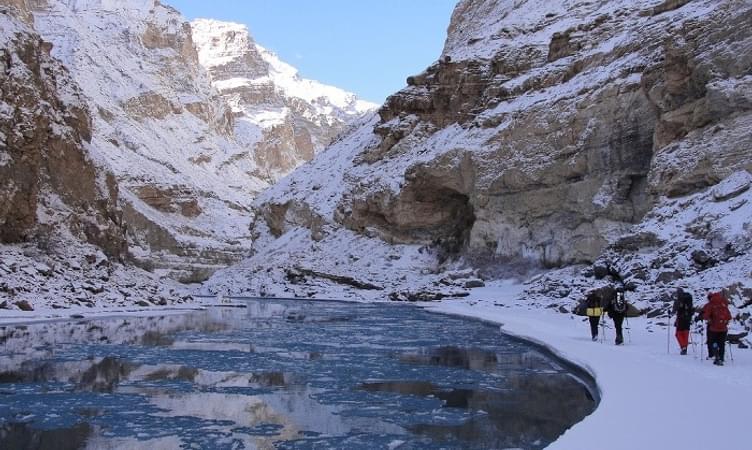
The food that is served during the expedition is decided and cooked carefully. Usually Indian vegetarian dishes and egg dishes are served during the trek. It is important that the dietary needs of the participants are met during the duration of the trek. The climatic conditions of the region are very extreme and different from those in the mainlands.
So in order to keep all trekkers in good health and energised for the journey ahead, well cooked vegetables and eggs are provided in order to keep them fit and healthy for the journey. Hygiene and safety are a priority during the trek and especially while cooking the food. So utmost care is taken while preparing the food for the guests.
The trek covers a journey of about 105 km and most of the distance is covered on foot. For this reason, it is very important that is no mistake or shortcoming in meeting the dietary needs of the trekkers. So a high protein content diet is chosen for the trekkers and this is met by choosing the best vegetables and eggs.
The trek is extremely tough and occasionally requires climbing on icy rocks and boulders. Furthermore, the temperatures of the region hover between 15 to 20 degrees during the day time and -25 to -35 degrees in the night time, which makes it essential for the trekkers to remain energised and high on metabolic heat. Camping in Ladakh will also be one of the perks of this trekks.
How to Get Safe Drinking Water During the Trek?
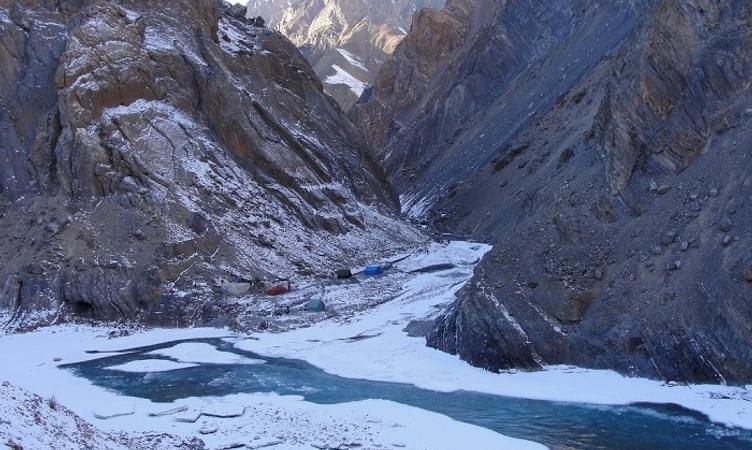
Himalayan water is generally considered safe and pure enough to be consumed directly. However, since the participants or trekkers are from different parts of the country, it is advisable to check with the lead trekker about filling stations. Usually, during the trek, water from the region is purified by boiling with chlorine tablets and then made available for drinking.
It is always best to check with the lead trainer about such arrangements before you start trekking and understand his plan of action. Do not consume water from any source without first checking with your leader. As the region would be new to you, it is always best to consult someone who is well-acquainted with the region.
The journey begins from Chilling in Leh and continues till you reach the Chadar. The distance is about 105 km and the temperatures will vary from 20 degrees to -25 degrees. It is essential that you carry warm sleeping bags, sturdy shoes and warm jackets with you in order to face the harsh conditions of the region.
The frozen river trek does sound difficult but it is one of the most enjoyable and adventurous trekking expeditions you can have in India. With the gain in altitude, the temperatures drop dramatically and blankets of white snow greet you into the mystical land of the Himalayas. To stay safe and fit for the journey, prepare yourself mentally and physically and arrange for all supplies beforehand.
Ground Transportation
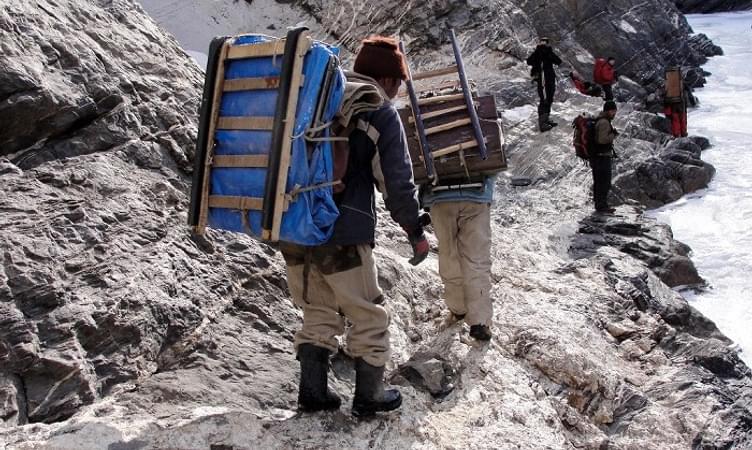
Your journey to the trek will begin from Leh. All ground transportation is done in the best of vehicles that suit the terrain. You will be taken from your source in Toyota Qualis, an Innova or a Scorpio. These vehicles are the best to travel in this rugged region and hence these vehicles are used for all ground transportation of guests. Special care is taken that all guests have a comfortable transportation before the trek begins so as to ensure that they are not worn out or tired before the trek begins.
The journey into the beautiful Himalayan ranges is one of the most sought after experiences among trekkers all around the globe. The mysteries of the Zanskar Valley and the snow clad Himalayas have time and again attracted professional and amateur trekkers and mountaineers from all over the world.
The trekking expedition into the Chadar is one of the toughest and most challenging trails in the country. Nevertheless, more and more trekkers participate in the this trek every year before of the spectacular beauty of the Himalayas that can be enjoyed during the trek.
The Ladakh trek begins from Chilling and continues till the beautiful white blanket of snow which is actually the River Zanskar in a frozen state. The trek involves long distance walking and trekking and hence it is essential for the participants to be fit and healthy. Also the temperatures of the region are incredibly low which make it mandatory for every trekker to carry warm clothes and supplements.
Medical Evacuations/Emergencies
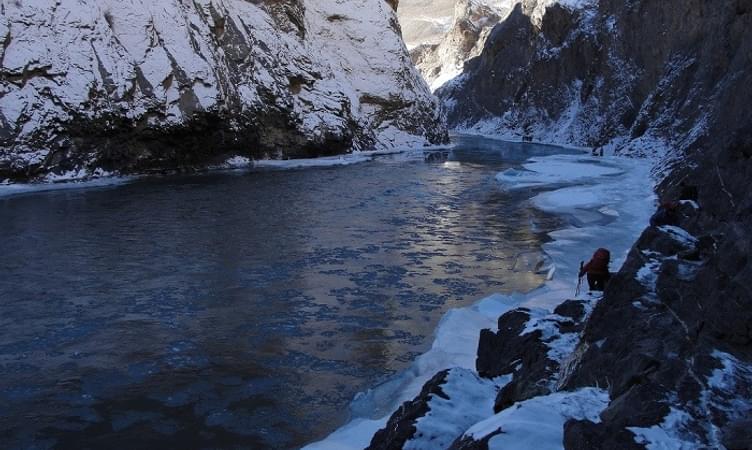
Safety is a priority during trekking trips and Thrillophilia takes measures to ensure that all its guests can enjoy the trip in safety. Although there will be no doctors accompanying the troupe that goes out on the expedition, the lead trekker is usually trained in Wilderness First Aid course, which ensures that primary medical aid is always at hand.
Furthermore, the lead trekker is trained in the basic and advanced courses of mountaineering and trekking and he ensures that all safety guidelines are followed and all trekkers are able to enjoy the beauty of the region by avoiding untoward incidents.
In case you are on any kind of medication or undergoing treatment, consult your physician before deciding to set out on this expedition. Although the beauty and charm of the Himalayan ranges are almost impossible to resist, it is important that you are physically and medically fit for the expedition.
If you need personal trail medications, carry them with you. If you are in doubt about your fitness level for the expedition, consult your physician or a professional trekker for advice. It is important that you gauge your fitness level well ahead and plan your expedition accordingly. If you are declared unfit, do not venture out for the expedition.You must be well aware of Ladakh Weather to avoid medical emergencies.
Other Facts You Should Know
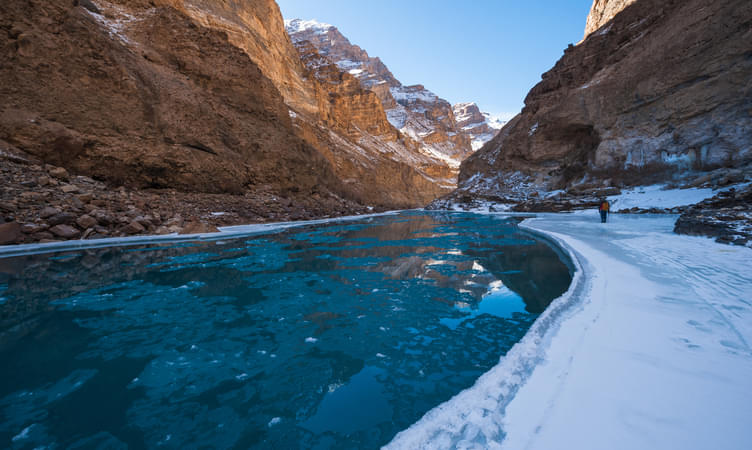
This trek is one of the toughest and most challenging treks in the Himalayan region. The frozen Zanskar River is the only means of communication for the Ladakhis and the Zanskaris in winters. This route is popularly used by trekking enthusiasts in the winters. However, this route will soon be shut down after the road from Chilling to Padum is completed.There are lot of Ladakh tours you can choose from us.
Things You Must Carry
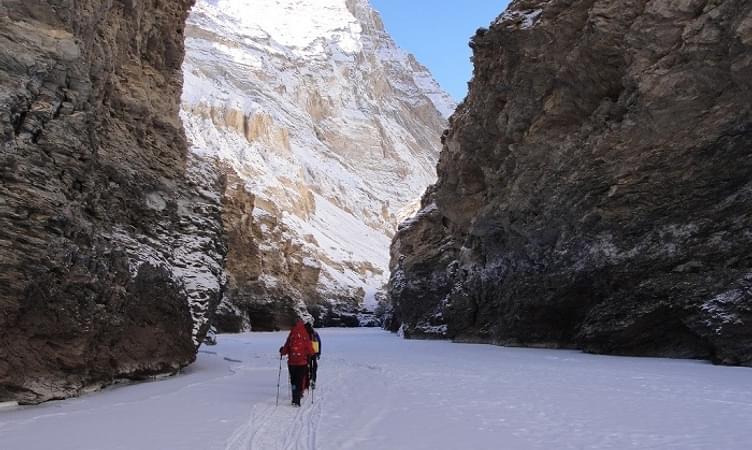
Thrillophilia arranges for ground transportation, accommodation, tents, kitchen and dining tents, kitchen equipments, stools, tables and mattresses, food (vegetarian and non-vegetarian items), cooks, helpers, porters and guides. Furthermore, Thrillophilia will also include the charges of monument entrances, wild life fees and camping charges in your registration fees.
Apart from all this, you will have to carry with you-
In case you do not already own these things, you can hire it from Thrillophilia. You can rent sleeping bags, trekking shoes and clothing etc. The package charges do not include the cost of any kinds of personal expenses such as tips, insurance, laundry and phone call charges, any kinds of beverages or any other cost incidental to any change in the itinerary.
While setting out for the trek, it is essential that you are dressed in long sleeve, hiking shirt; long quick dry hiking pants. You can also carry a hat with a retention cord on windy days.
Your duffel bag can carry your sleeping bag, your complete set of spare clothing, long and regular underwear, inner and outer socks, a pair of fleece sweaters, insulating hats, a pair of running shoes, your toilet kit, your toothbrush, soap, towel etc.
Fitness Required
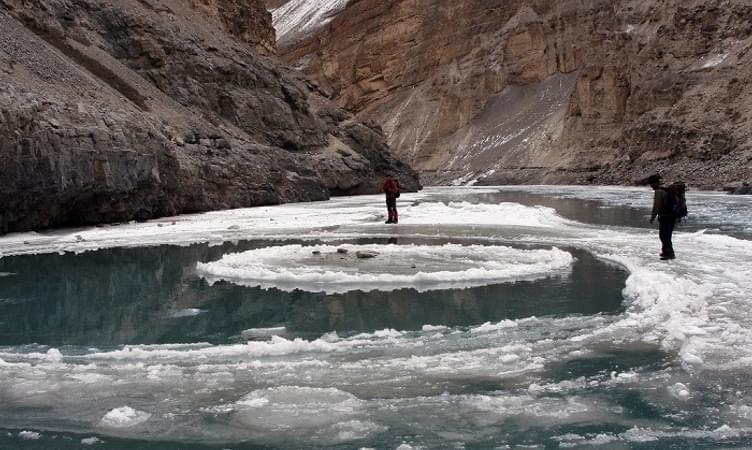
The trek to Chadar is extremely arduous and tasking. Not only does it test your physical stamina but also your medical health. It is essential that you are in the best of health before you set out for this expedition. Usually, the lead trekker is a trained professional in the basic and advanced courses of trekking and mountaineering and also trained in Wilderness first aid.
But to avoid any critical or untoward situation in terms of health and fitness, it is best that you consult a professional or a physician and get yourself checked before participating in the Chadar trek. In case you are on medications, make sure you carry your medicines with you while venturing out for the trek.
The climatic conditions that trekkers have to face during a trip to Chadar are extremely harsh and cold. It is essential that you are physically and medically fit to take up this challenge. The temperatures hover between 15 and 20 degrees during the day time and between -25 and-35 degrees during the night. The nights are usually spent in caves near the frozen Zanskar River in extremely cold conditions.
Hence, it is mandatory that you understand the challenges that lie before you completely and fully before stepping out for the expedition and prepare yourself accordingly. Carry warm clothes, warm bedding and food supplements to keep you energised during the trek. Also, carry chlorine or other water purifying tablets to filter and clean your water before drinking.Special care must be taken during Trekking in Ladakh in Winters.
Approximate Cost
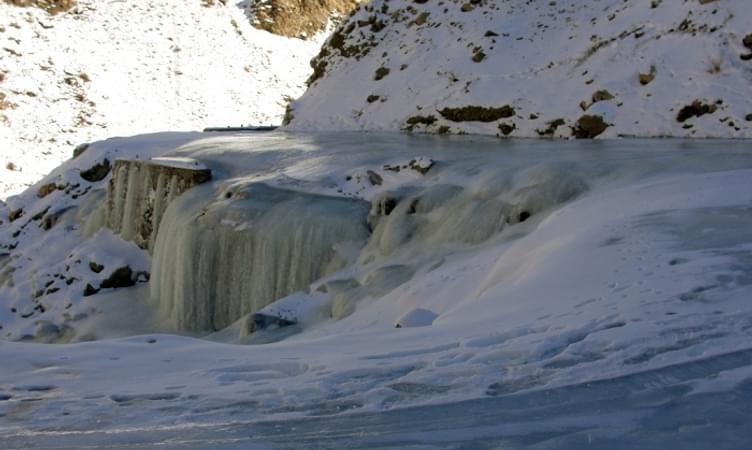
The approximate cost for the expedition of 13 days and 12 nights starts at about Rs 52,000 per adult. The cost may vary from individual to individual depending on the type of accommodation chosen or available, number of people travelling, activities possible and availability, changes in government fee on entry or taxes, credit card fee as per payment gateway charges etc.
The total cost includes the cost of ground transportation using Toyota Qualis, Scorpio or Innova, accommodation in A class hotels including all meals, tents, kitchen equipments, stool, tables and mattresses, meals, support staff and entry fees to monuments, wildlife areas and camping fees.
This package charge excludes the cost of sleeping bags, trekking shoes and clothing, any kind of personal expenses, tips, laundry, insurance and phone calls, any kind of drinks and cost incidental to change in itinerary etc.
Apart from this, you will have to bear the expenses of hiring or buying the equipments and essential items required for the trek such as day size packs, trekking boots, stream crossing sandals, water bottles, fleece jackets, rain proof jackets, insulating gloves, sunscreens, sunglasses, emergency first aid kit etc.
These items are vital for survival during the trek and hence must be carried by everyone participating in the expedition. You will also need special clothes such as long sleeve hiking shirts, long quick dry hiking pants, hiking socks, trekking poles etc. Some of these items can also be purchased from Leh if you do not own them yourself. Apart from Trekking you can also enjoy Bike trip in Leh Ladakh.
How to Plan a Cost-Effective Trek

Planning is very important to make a trek cost-effective. If you wish to cut down unnecessary costs, you need to plan your trip in detail. Just packing a ruck sack and heading for the Himalayas isn’t enough when it comes to planning a trekking trip.
You will need to plan things such as time of the programme, choice of the route and route details, choose the route type, check your capacity, capability and experience of your team members, collect information, plan for food, take gear and equipment, medicines, making the budget etc. For your personal expenses, take account of factors such as items to be packed, guide, porter, cook, check your physical and medical fitness, use of food and dos and don’ts at the campsite.
By planning out all these things beforehand, you can cut down a lot of unnecessary expenses during your trip. Prepare a checklist and tick out everything you have arranged. An organised approach to planning a trip is the best way to make your trip fruitful and cost-effective.
Before you set out for the trek or decide on going trekking, do a little homework by researching on the destination, the geographical and climatic conditions, on the things that you will need to carry and the things that will be provided to you from the agency that will facilitate your travel and then prepare a checklist. With an itemised checklist, you cut down the chances of missing out anything and hence the cost of buying an item or renting it last minute. You can also do budget Jeep Safari in Ladakh that will give you sight to breathtaking views.
Common Trekking Mistakes

1) Lack of Physical Fitness: Get yourself physically checked and only when you have been given a clean chit by the physician should you plan a trekking trip in high altitudes. High altitude trekking requires a lot of physical stamina, strength and endurance and for this reason it is highly essential that you are in the best of form. Persons suffering from heart diseases, high blood pressure, diabetes etc should refrain from trekking in high altitude regions.
2) Poor Packing: While setting out on a trekking expedition in the Himalayas, it is important that you pack all your stuff wisely. Remember that when you are climbing uphill, each and every gram in your rucksack will weigh heavy and hence wise packing is absolutely necessary.
So if you are a beginner, consult an experienced trekker before packing. If you are experienced, prepare a checklist and then pack only the most essential items.
3) Dehydration: Many people avoid drinking water in chilly conditions. This results in dehydration. So keep your water bottles close and drink in as much as you can. This will allow your body to maintain its water balance. By not drinking enough water during trekking, you aid in your body’s dehydration and make it weak and tired during the trek.
4) Wrong Outfit: Dressing up right is not just for parties and night outs. It is important that you are dressed in the right clothes and gear to enjoy your trekking experience at high altitudes. Do not wear flowy or frilly clothes that will make navigation difficult. Make sure you wear warm woollen and polyester clothes that suit the weather and help you trek easily.
5) Trekking at Night: You may feel adventurous enough to trek at night, but the best way to avoid trouble while trekking in the Himalayas is - avoid trekking at night. The slopes are slippery and there are no lights to show the way. If you venture out at night, you are sure to invite serious trouble.
6) Wearing the Wrong Shoes: Since you will be spending most of your time walking, it is best that you choose the right shoes for yourself. Strong and sturdy shoes with metal spikes are perfect for walking in the snow. There are different types of shoes for different terrains and you should choose your shoes carefully if you want to make your trekking experience enjoyable. A wrong set of shoes or even socks in the wrong terrain can spoil all the fun in your expedition.
7) Skipping Food: Eat well when you are on an expedition such as the frozen river trek. Many people skip their food not realising that this can cause a lot of problems. While on such a tough task, it is important that you give your body all the energy and nutrition you can to make it strong and sturdy enough to face harsh conditions. By skipping food, you make your body weak and less resistant to the severe conditions of the region.
8) Avoiding Weather Report: Do not forget to check the weather report before you start trekking. Neglecting or avoiding the weather report can land you in serious trouble, especially at such high altitude regions. Check for websites that offer such information and keep yourself updated before setting out for the adventure.
Is the Trip Customisable?

Yes, the trip is customisable and can be designed to suit your preferences. Himalayan expeditions are carried out in different time frames depending on the weather and climatic conditions. If you wish to travel independently, you can choose your time frame and preferred group size.
The charges will depend on the number of people in your group, trek area, trek style and duration of the trek. Before going on a trekking expedition in the Himalayas, it is best that you take a few things into account such as the geographical and climatic conditions of the region, the things you will require, common trekking mistakes that people make while trekking in such a terrain etc.
Also, plan your journey well ahead of time. Use a very organised approach to plan your travel. Do your homework by researching well on the region, the climatic conditions, the trek route, the different trek styles, the best season to trek in the region etc to make your expedition fruitful and enjoyable.
Armed with this information, you can plan your trip wisely and make it an enjoyable and memorable experience. Most people overlook such matters considering it to be trivial and are in for a big mess when they start trekking.You can also do rafting in Ladakh.
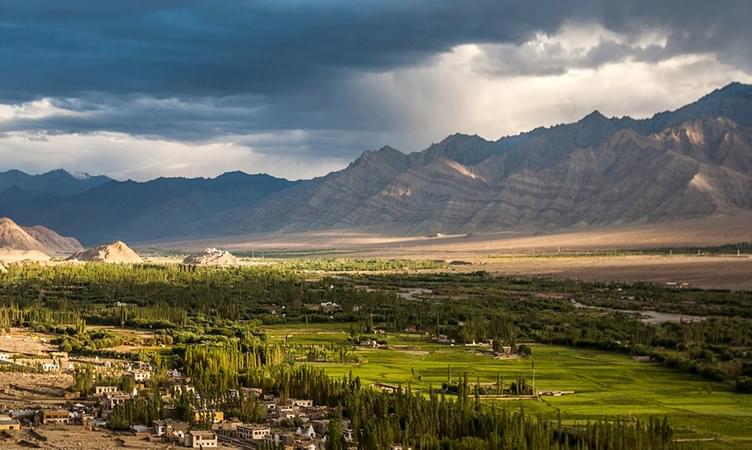
Best of Leh

People Also Ask About Ladakh
Is chadar trek for beginners, is chadar trek dangerous, how long is chadar trek, can chadar trek be done solo, what is the best time to go for chadar trek.
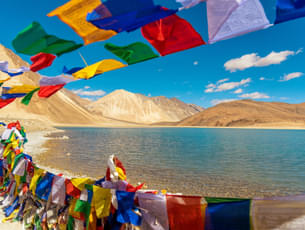
Trending in Ladakh
Trekking in ladakh.
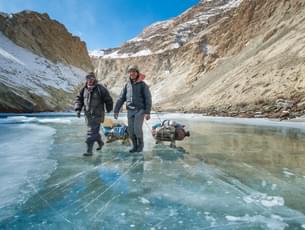
Ladakh Top Attractions

Heaven, Peace, Silence, and Tranquility at one place? Come and spend a few hours at Pangong Lake in Ladakh! A pristine place in Ladakh marked by subtle to high peaks around, crystal blue waters and the vast expansion catches the eye so much, so long as if a magic is happening right in front of the eyes. Let our Ladakh holiday packages transport you to this mesmerizing destination, where nature's grandeur unfolds in every corner.Pangong Lake, also known as Pangong Tso, lies calmly at a breathtaking elevation of 14,270 feet. Interestingly, the lake is 12 km long and marks itself between the laps of India and China. Rather, 60% of the portion is stretching in the neighboring nation and this excites every traveler to be here.The surreal clean blue waters are actually brackish or salty in nature and this feature doesn’t let any aquatic life survive in the same. Moreover, the temperature range between -30 to -10 degrees make even this salty lake freeze with thick ice sheets, which is quite opposite in case of salt ridden water bodies.This picturesque landscape location enhances its beauty with the arrival of migrating birds every year and attracts many travelers in search of adventure, photographs, bird-watching and chilling experience. Pangong has another unique and catchy feature; when it acts like a chameleon and changes its color from blue to green to even grey at times. The brackish water of Pangong attracts the migratory birds every year during winters in Ladakh.
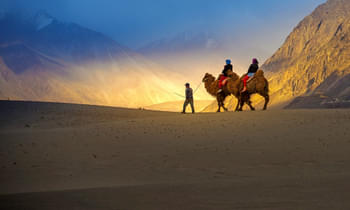
One of the most beautiful parts of the moonscapes of Ladakh, Nubra Valley is a deep-cut gorge created by the combined effects of Shyok and Nubra (Siachen) rivers. A high altitude cold desert, Nubra Valley is actually an extension of the Tibetan Plateau (Qing-Zang Plateau) that starts in China and extends up to Ladakh. This valley in the plateau separates the Ladakh Range from the Karakoram Range. But more than anything, Nubra Valley is the most beautiful region in all of Ladakh. Home to wonders like the Diskit Monastery,Hunder Sand Dunes, Samstanling Gompa, Yarab Tso Lake, and the villages of Turtuk and Panamik.Located about 160 km from Leh, the capital of Ladakh, Nubra Valley is a great attraction to all those who come here. The gateway to the upper reaches of the country, especially Siachen, Nubra Valley has an oasis of a town in the heart, Diskit, making a great place to stop you and reflect at the beauty around. And while you are at it, take a short detour to the famous white sand dunes of Hunder. The shapes and forms that these dunes take during different times of the year mesmerize every visitor who comes here. To make it further interesting, there are the double-humped Bactrian Camels, offering rides through the dunes.And when it turns dusky, head to the Diskit Monastery and visit the towering statue of Maitreya Buddha which looks over the entire valley and blesses it for another day to come.Planning a Trip to Ladakh, Experience of Chadar Trek - The Frozen River Trek
More Ladakh Attractions
Ladakh travel guides.
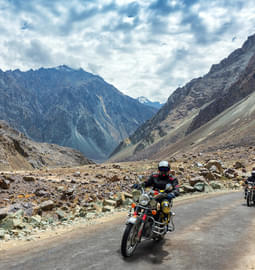
Ladakh Reviews

Popular Nearby Places Around Ladakh
More things to do in ladakh, more on ladakh tourism, popular related destinations.
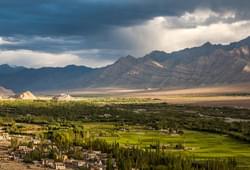
Best Domestic Packages
Best international packages, domestic honeymoon packages, international honeymoon packages, places to visit in india, international places to visit, things to do in india, international things to do, popular on thrillophilia.
- We assure the privacy of your contact data.
- This data will only be used by our team to contact you and no other purposes.
Your enquiry has been received successfully. Our destination expert will reach out to you soon!

Wandering Boots
Chadar Trek
- Trip Type Trekking
- Activities No Activities
- Group Size 12 Max
- Location Ladakh (Trans Himalayas)
- Dates Jan 6, 2024 - Jan 14, 2024
- Trek Overview
- Inclusions / Exclusions
Chadar is a trek that needs little introduction. It has gained fame internationally as one of the treks you have to put as on your bucket list– after all, the trek is entirely on a frozen river. The Zanskar river, which incidentally is a rafting destination in summer, comes to a standstill in the winters and becomes a route that connects Zanskaris to rest of Ladakh. No day on the frozen Zanskar, called the Chadar meaning “blanket”, is the same. Sometimes the ice you walk on is a thick sheet of white, sometimes it is a transparent and you see the frozen bubbles rising to the surface. And sometimes the ice curves around the gorge and the electric blue river gasps to life in middle. This trek is an experience. Couple it with the seclusion of Ladakh in winters and you have yourself a unique winter experience!
Ladakh is bordered by the Greater Himalayas in the west and south, the Karakoram in the north and the Tibetan Plateau in the east. These ranges form a natural barrier and does not allow clouds to enter this valley making it a rain shadow region and thus a cold desert. The term Ladakh translates to land of high passes. Some of the highest motorable roads in the world are here.In winters Leh isn’t accessible by road and most tourist places are shut barring a few hotels and a few sightseeing places.
How are we different from others?
We take smaller groups. We camp in non common places where we will have limited crowd and we take our trekkers for lots of exploration hikes after reaching the camp.
We also make sure you get a taste of the local culture, local cuisine, and winters in a Himalayan household!
Expected Weather
- Snow/Snowfall on trail – Very likely
- Minimum Temperatures – The temperature is a lot cooler in Leh as compared to other areas in the Himalayas. Afternoon upto -5 degrees Nights – Around -30 degrees (extreme)
DISCLAIMER FOR CHADAR TREK: Over the recent years the Chadar trek has become very unpredictable. Due to the changing weather patterns the Chadar does not form as it used to earlier. Additionally, the Government and police authorities too have gotten involved in the running of the Chadar trek which results in added complications. They come up with last minute regulations, at times they cancel the entire Chadar expedition, not allowing any trekkers to go on the Chadar due to the unpredictability of its forming.
Keeping into account all of the above, in the likelihood of the Chadar trek being cancelled (by the government/police authorities or it not being formed), we will take the participants on an alternate trip in Ladakh. This trip will include trekking in and around Ladakh, maybe snow leopard spotting hike. The itinerary for this trip will be shared in case when Chadar trek gets cancelled.
Kindly note, we will not be issuing a refund or a voucher if the Chadar trek gets cancelled. We will be taking all the participants on an alternate trek/trip in Ladakh itself.
Things to Get – Chadar
- Good Sturdy Backpack: Prefer a trekking pack over a backpacking one. The size of the backpack depends upon the participant. Normally for a 5-6 day treka 40-50 litre pack should
- Shoes : For chadar, it is best to trek in Gumboots. Gumboots are water proof and grip well on the ice.Gumboots are available in the Leh market for 400 INR.You will need warm camp shoes too. Your normal trekking shoes can work as camp shoes.
- Socks: 3 pair cottons and 4 pairs of woolens. (You get very good woolen socks in Leh market. I’d recommend you buy from there)
- Trek pants (Ideally Water Resistant) : They are very important and help you a great deal on your trek. You can get two trek pants on this trek both should be slightly thick, winter trekking pants. If you don’t have a trek pants you can replace it with Thick Gym Track pants too. Don’t trek in Jeans/Pants. You get quality trekking pants in leh for 800 INR
- T shirt/Base layer: One can get 2 T shirts/trekking base layer on the trek, both of which should be thick and full sleeve. Avoid cotton and prefer dry fit. https://www.decathlon.in/p/8369745_mens-warm-long-sleeve-snow-hiking-t-shirt-sh100-black.html
- Fleece/ Sweater/ Good quality Hoodie : Onecan get 2 fleece jacket or sweater (Prefer fleece over sweater and Hoodies)if they are not sure about their down jacket else get only one. Fleece is preferred over sweater as it is lightweight and easy to carry.Sweaters and Jackets can be heavier than Fleece for the warmth they offe If ( https://www.decathlon.in/p/8505196_mens-fleece-mh520-black.html )
- Down / Padded Jacket – Down/Padded jacket (Upto -20 degress capacity) is a must for Chadar. If you are not sure about the quality of your padded/Down jacket or your resistance to cold get an extra ( https://www.decathlon.in/p/8373600_men-s-mountain-trekking-down-jacket-trek-900-black.html )
- Thick track pants for camp – These are specifically for cold evenings at the campsite.This can be ignored if you are comfortable wearing your thick trekking pants in the camp.You get good camp pants in Leh market for 500 INR. These can be substituted by thick Pyjamas too.
- Thermals : 2 pair. We wear thermals on top only upon reaching the campsite not while trekking. If you don’t want to invest a too much you get resonably good thermals in Leh market. You can wear one into Leh and purchase one from Leh.
- Windproof Jacket: All rain proof can be used as Wind proofs. Required as an additional layer during trekking in windy conditions. Avoid if you have a rain proof jacket.
Option A – Rain set –
One Waterproof jacket (3000 mm waterproofing), Rain proof pants and Bag cover
Option two – Poncho
Covers your body and bag completely.
I ideally recommend Option 1 as poncho makes trekking difficult.
- Woolen Cap/ Balaclava: ( 2 ) To cover your ears and head. Get a thick fleece lining one. Can be purchased from Leh market for 100 INR
- Neck Warmer/ Scarf (1): For evenings. Can be purchased from Leh market for 100 INR
- Gloves: 2 gloves out of which 1 can be water proof and one woollen. The waterproof one has to bepadded ( https://www.decathlon.in/p/8398722_adult-downhill-skiing-gloves-100-black.html )and a size larger than you normally use so that you can wear both your gloves together if required.
- Sunglasses – 1(carry an extra if you want)
- Toiletries – Also include sunscreen, moisturizer and lip-cream
- Headlamp/Torch (Prefer a head lamp) -1with extra batteries.
- 2 water bottles (1 litre each) – One has to bethermas Flask. Avoid hydration packs.
- Camp shoes/Flip flops – Prefer your normal trekking shoes
- Plastic covers for inside the backpack to keep your clothes dry
- Daypack – Required if you have a summit days climb.Preferably one that can be compressed.
- Documents: 2 passport sized photograph, Address and Photo proof (Driving License or Aadhar card), Doctor’s Medical certificate saying that you are fit for the trek (I reserve the right to not take you on the trek, if you fail to produce this).
- Boarding pass : We need your boarding pass for the medical check up. Without this you wont be allowed on the trek
- Day 1: Arrive at Leh (3300 mts) Evening hike to Shanti Stupa for Acclimatization. Overnight stay in a Hotel
- Day 2: Acclimatization day at Leh You can devote today for local sightseeing. A vehicle can be arranged for you at an additional cost. Trek briefing in the evening. Overnight stay in a Hotel
- Day 3: Mandatory medical check up at SNM Hospital According to the new rule laid out by ALTO(All Ladakh tour operators association),trekkers attempting Chadar are supposed to undergo a mandatory medical check up at SNM hospital on the 3rd day after arrival. Trekkers failing to do this will be not allowed to go on the trek. Overnight stay in a Hotel
- Day 4: Drive to Shingra Yokma from Leh via Chilling and trek to Tsomo Paldar Drive 65 kms Trek Distance - 3Kms, Trek Time - 2 Hours Overnight at campsite on Chadar
- Day 5: Trek from Tsomo Paldar to Tibb Cave Trek Distance -10 Kms, Trek Time -6-7 hours Overnight at campsite on Chadar
- Day 6: Trek from Tibb cave to Nerak via Hotong Trek Distance -18 kms , Trek Time - 6-7 hours Overnight at campsite at Hotong on Chadar
- Day 7: Trek from Hotong to Yokmado Trek Distance - 13 kms, Trek Time - 6-7 hours Overnight at campsite on Chadar
- Day 8: Trek from Yokmado to Shingra Yokma Trek Distance - 10 kms, Trek Time -5 hours, Drive 3 hours Overnight stay in a Hotel
- Day 9: Trek ends today Drop arranged for airport
Trip Includes
- Complete Food (except lunches in Leh)
- Complete accommodation (Twin/Triple sharing basis) for the entire trek
- Hotel stay in Leh
- Airport Pickup and Drop. (On trek specific dates only. Note you have to manage your travel yourself if you come early or leave later)
- Rentals for all common gear provided to you like tent, sleeping bags, crampons etc.
- Technical gear provided to you like Ropes, harness, carabiners and crampons
- Camping charges
- Guide and expertise charges
Trip Excludes
- Meals or drinks purchased by participants during the travel or trek (example biscuits, fruits etc)
- Rentals for personal gear (Refer things to get section)
- Trek Insurance – Insurance is available at ₹2000 at Leh for the duration of stay.
- Medical checkup cost on day 3 – ₹500/- approximately (payment to be made at the checkup post directly)
- ALTOA (ALL LADAKH TOUR OPERATORS ASSOSIATION ) Fees to facilitate medical check up – ₹1200/- approximately (payment to be made at the checkup post directly)
- Forest entry permission – The forest department charges ₹2500/- approximately per trekker as forest entry fees only after you clear the medical checkup on day 3 (payment to be made at the checkup post directly)
- Any extra government charges.
- Flight/Train/Bus ticket till Leh.
- Backpack offloading charges. You are expected to carry your own backpack. Trekkers unable to do so can opt for a porterage service at 600/day
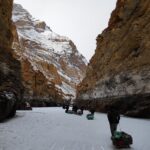
How does one reach Leh in winters?
Leh is only accessible by flight in winters. It is advised you book your flight tickets as early as possible.
Is local sightseeing (Shey, Thiksey, Hemis Monastery , Magnetic hill and Gurudwara) possible on Day 2?
Yes, one can go to these places providing you are acclimatizing well. We can arrange a cab at an additional cost for all the participants that are interested.
Can I go to Khardungla on day 2?
It is not advisable to go to that altitude on your second day at Leh. You can visit it after the trek.
Are the restaurants open in Leh in the winters?
Yes. A lot of trekkers visit leh in the winters and so many hotels are open around that time of the year.
Who will accompany us on the trek?
A certified trek leader, a naturalist, cook & porters will accompany you during the trek
Can I consume alcohol or smoke during this trek?
The common perception is that alcohol makes you feel warmer, however it also dehydrates you & dehydration can be fatal while trekking. Hence consumption of alcohol is prohibited. Smoking in camps is not allowed.
Will there be wild animals around the camp?
Wild animals do not frequent camps. They tend to stay away.
Is trekking safe for girls?
We've been organizing treks for over two years and have had many female trekkers on our treks. In fact, a lot of them come solo for treks. There has never been a complaint about the atmosphere of a trek, about other trekkers or our professionalism. They have all been kind enough to leave a review on our website
Will boys and girls have seperate accomodations?
What about toilets.
In all the camps where the accommodation is in guest houses/home stays, there will be proper toilets. On the day of camping, we will have toilet tents, the standard, most hygienic way of answering nature’s call. A deep pit will be dug in the ground and once you’re done, you will have to use a shovel & throw in some dirt from a mound of dirt kept nearby. These will be dry toilets with no water hence please carry tissue roll for the toilet tent (refrain from using wet wipes as they are not bio degradable), for the rest of the days, you can carry rolls as per your convenience.
Am I expected to carry my backpack? What if I am unable to carry my backpack?
Yes, you are ideally expected to carry your backpack. But you do have an option of offloading your bags on a mule for an additional cost. The cost will be 600/ per day per bag. One is expected to inform us about offloading 1 month prior to the trek
I have never trekked before. Can I do this trek?
This is not a very difficult trek as you hardly gain altitude. On most occasions it is just a plain walk, so one doesn’t require a great deal of physical preparation. The cold is a bigger challenge. First timers can do this trek, provided they have good personal gear that keeps them warm.
Related Trips
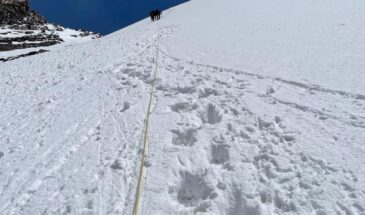
Deo Tibba Expedition (6001 mts) with Norbu peak (5226 mts)
ABOUT THE PEAK Explore the majestic Mt. Deo Tibba, standing at 6,001 meters in Himachal Pradesh’s Kullu Valley. Known as the assembly point for gods,Tour Details
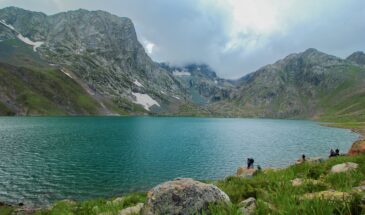
Great Lakes of Kashmir (Relaxed Itinerary)
About the trek – Great Lakes of Kashmir is an absolute visual marvel with its alpine lakes, lush green meadows, and exquisite campsites. The views onTour Details
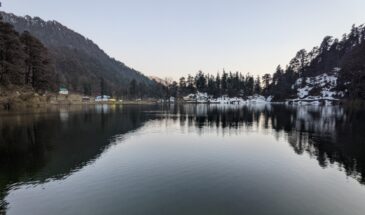
Dodital Darwa Pass
Dodital trek is popular among trekkers for the pristine beauty of the Dodital lake, nestled among mountains at an altitude of 3310 mts above seaTour Details
Book your slot in 3 simple steps!
Step 1. Register yourself – Click on this link and fill the Registration form
https://forms.gle/LFy2MRjadMLFaJPFA
Step 2. Make an advance payment –
Make a payment of 50% of the Trek fee to this account
Bank details
RBL Bank Account Number -409000968477 Name – Adventum Escapade private limited Ifsc – RATN0000159 Current account
Send a screenshot of the transfer made to us on WhatsApp 9041139949 or Email [email protected]
Congratulations! You have booked your slot!
For assistance you could contact us on the contact info given in step 3.

Spituk Stok Trek – A 3-Day Adventure through Scenic Ladakh
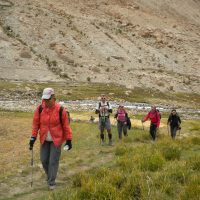
Saboo to Khalsar Trek: A 6-Day Himalayan Escape
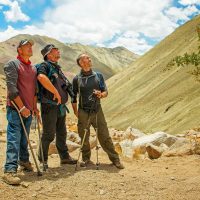
Phiyang to Hunder Trek: A 7-Day Himalayan Journey
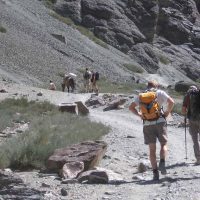
Markha Valley Trek: An 8-Day Himalayan Adventure
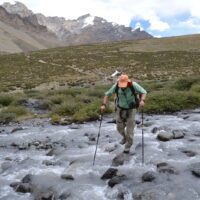
Lamayuru to Alchi via Tarla Trek: A 4-Day Himalayan Escape
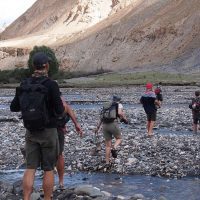
Lamayuru Chiling Trek: A 6-Day Himalayan Escape
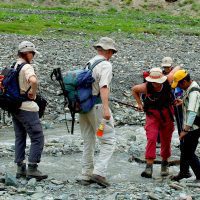
Kulum Leh Trek: An 8-Day Himalayan Hike
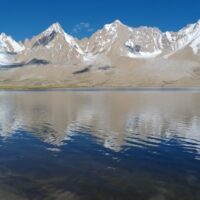
Unveiling the SKO Valley Trek 10 Days : Harmony on the Trails
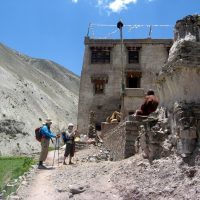
Shang to Stok Trek: A 10-Day Himalayan Adventure
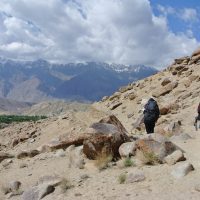
Sham Trek & Monastery Discovery: 10 Days of Ladakh’s Best
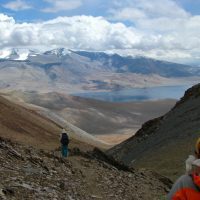
Rumtse to Tsomoriri Trek: A 10-Day Himalayan Adventure
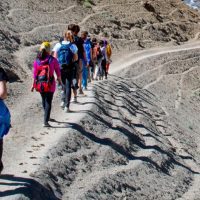
Padum to Leh Expedition via Charcha La: A 10-Day Himalayan Journey
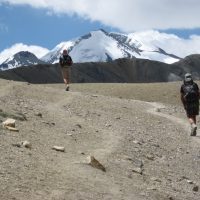
Likir to Khaltse Trek: A 9-Day Himalayan Exploration
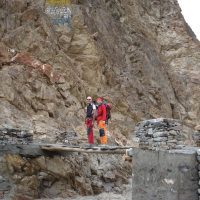
Lamayuru to Hemis Trek: A 12-Day Himalayan Expedition
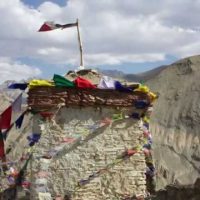
Hemis to Padum via Charchar La: A 12-Day Himalayan Expedition
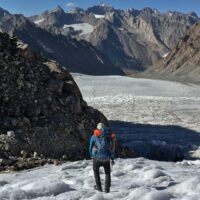
Trans-Himalayan Odyssey: Conquer Kang La and Enter the Kingdoms of Zanskar and Ladakh 14 Days
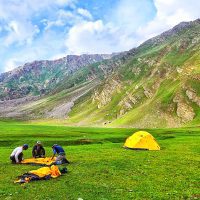
Rangdum to Padum Trek: A 14-Day Himalayan Expedition
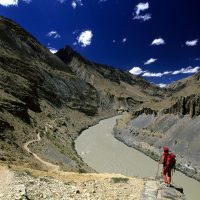
Padum to Lamayuru Trek: A 13-Day Himalayan Expedition

Padum to Darcha Trek: A 13-Day Himalayan Adventure

Lamayuru to Rupsho-Tsokar Lake Trek: A 17-Day Himalayan Odyssey
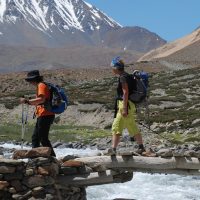
Lamayuru to Darcha Trek: A 20-Day Himalayan Expedition
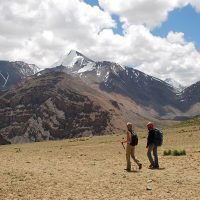
Kibber Trek: An 18-Day Himalayan Trekking Adventure
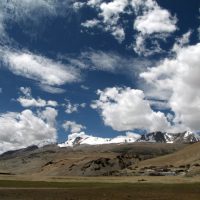
Darcha to Sarchu Trek: A 20-Day Himalayan Odyssey

Chadar Tibb Gyalpo Trek: Conquer The Frozen Majesty 9 Days
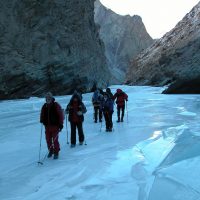
Chadar Markha via Charchar-La Trek: 26 Days of High Himalayan Exploration
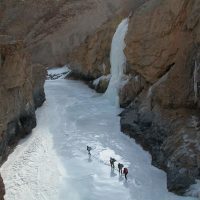
Chadar Lingshed-Chilling Trek: 11 Days of Himalayan Thrills
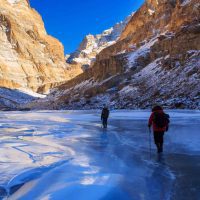
Chadar Lingshed to Tongday Trek: 20 Days of Himalayan Expedition

Chadar Karsha Trek Odyssey: 22 Days of Himalayan Adventure
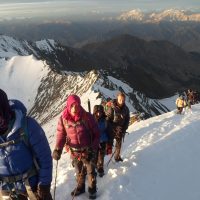
Stok Kangri Summit: A 9-Day Himalayan Expedition
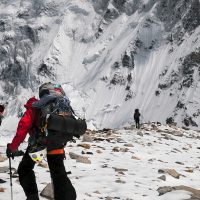
Nun Kun Tour: A 14-Day Journey through Himalayan Majesty
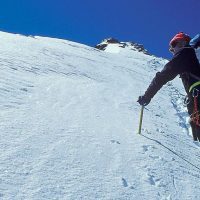
Menthok Kangri Summit: Conquer Peaks of Adventure 5 days

Kang Yartse Adventure: An 11-Day Expedition into Himalaya
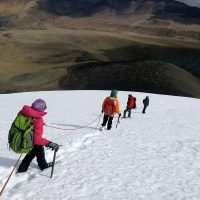
Conquer Kang Yatse 2: Majestic Ladakh Summit Adventure
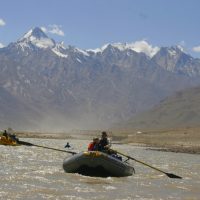
Zanskar River Rafting Expedition: 12 Days of Thrills and Rapids
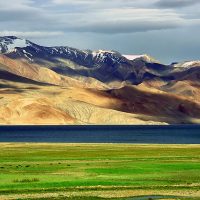
Wonder of Ladakh: An 8-Day Journey into Tranquility
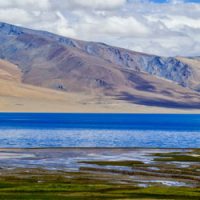
Unveiling Tranquil Beauty: Tso Moriri and Tso Kar Tour 2 Days
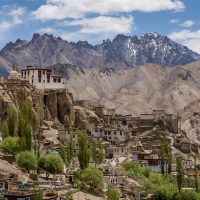
Sham Monasteries Tour 2 Days : A Tranquil Journey Unveiled
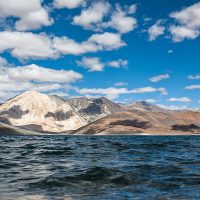
Pangong Tso Tour: A Mesmerizing Journey Beyond Borders 2 Days
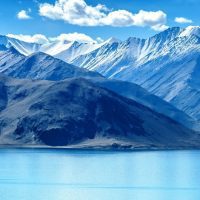
Pangong Tso Expedition: 8 Days of Ladakh Bliss
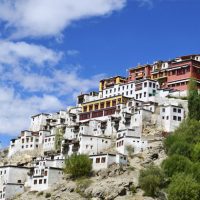
Monastery Marvels: Thiksey Hemis Matho Chemrey Tour Day 1
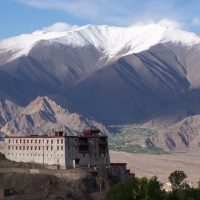
Lakes Monasteries Tour – 9 Days : Uncover the Jewels of Ladakh
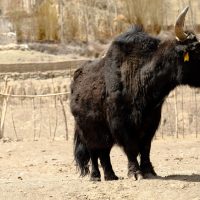
Ladakh Wonders Unveiled: A 5-Day Expedition
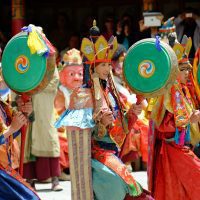
Ladakh Monasteries Odyssey: 6-Day Spiritual Expedition
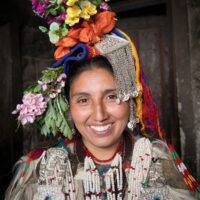
Hidden Gems Of Ladakh: Dah Hanu Alchi Lamayuru Unveiled 2 Days
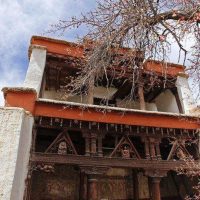
Enchanting Day Tour: Discover the Wonders of Sham Monasteries
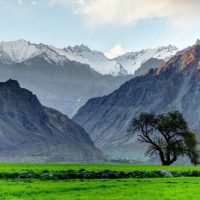
Discover Turtuk Magic 3-Day Nubra Valley Adventure
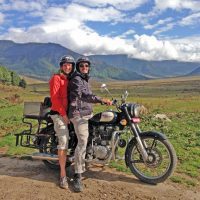
Epic 10-Day Manali to Leh Motor Bike Expedition

Serenity Sprint: Yoga and Meditation Escape in the Himalayas
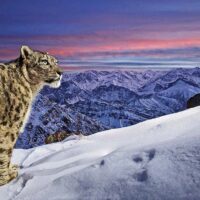
Ladakh Wilderness Photo Expedition: Capturing Nature’s Essence
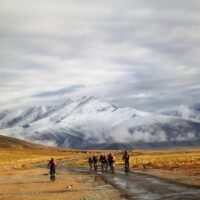
Ladakh Panorama Pedal: Scenic Cycling Odyssey with Bike Transfers
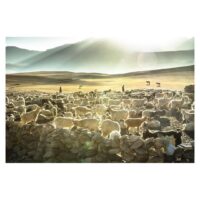
Ladakh Nomadic Odyssey: Unconventional Expedition into the Highlands
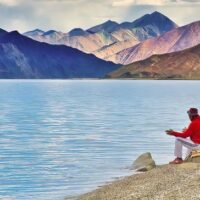
Ladakh Harmony Drive: Meditation and Yoga Expedition

Ladakh Express: Yoga, Meditation, and Trek Retreat
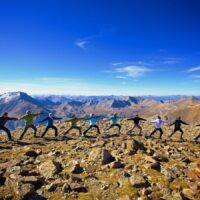
Ladakh Elements Quest: Elemental Immersion and Adventure Retreat

Ladakh Eco-Quest Extended: Immersive Ecological Exploration

Ladakh Cultural Exchange Journey: Bridging Traditions and Connections
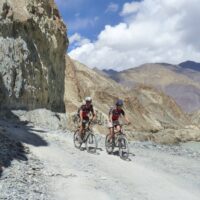
Ladakh Beyond Trails: Unique Cycling Expedition with Bike Transfers
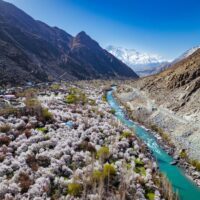
Ladakh Apricot Blossom Expedition: Embark on a Mesmerizing Journey Through Orchards and Villages
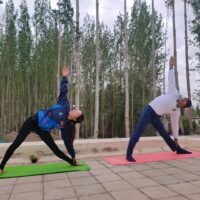
Embark on a Transformative Journey: Ladakh Adventure, Meditation, and Yoga Extravaganza
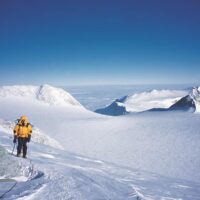
Vinson Massif Adventure in Antarctica
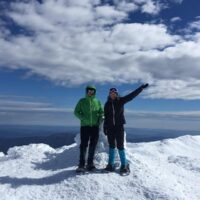
Mt. Kosciuszko Peak Adventure
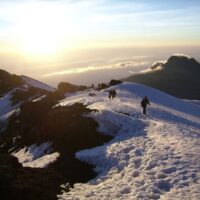
Mount Kilimanjaro Experience the Trek
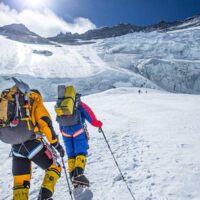
Mount Everest Expedition Southwest Nepal

Mount Elbrus: Exploration of the Summit
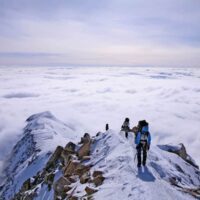
Denali Mountain Climbing Adventure
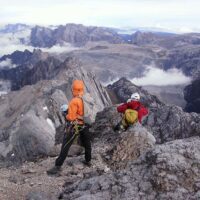
Carstensz Pyramid(Mount Puncak Jaya) Summit Adventure

Aconcagua Summit : A Majestic Mountain

2019 Ice Hockey Camp (Japanese University Student Coach)
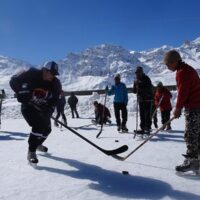
2018 Ice Hockey Skills Camp (Japanese Coach)
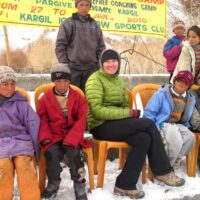
2010 Kargil Development Camp
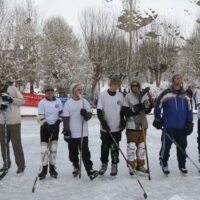
2009 Kargil Open Ice Hockey & Skating Championship / Pargive Kargil Ladakh
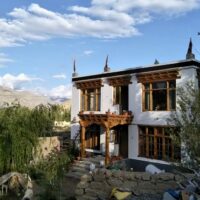
Discover Tranquility at Abapa House: Your Choglamsar Homestay Haven
- Ladakh: Discovering Us
Explore our latest Blog

Pets: Empowering Owners to Provide Comfort in Final Moments
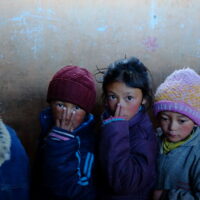
Exploring the Majestic Chantan Plateau: Embracing Nomadic Culture and Inspiring Resilience
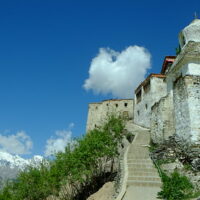
Ladakh: A Majestic Journey Through Nature

Bicycles and Economy: The CEO’s Surprising Revelation on the Positive Impact of Healthy Lifestyles

Empowering Relationships: Navigating Life’s Challenges with Positive Connections and Prayers
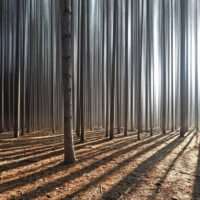
Psychology Unveiled: Unlocking Mysteries and Discovering Your True Self

Dreams Unleashed: Empowering Transformations from Late Starts to Success
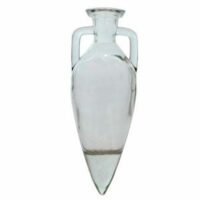
Powerful Amphorae: Efficient Design for Liquid Transport with Minimal Damage
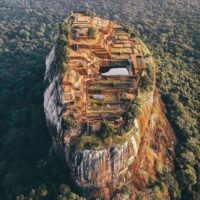
Sigiriya: Unraveling the Mysteries of Ancient Builders’ Ingenious Feats

Reclaim Lost Splendor: Nostalgic Reflections

Death Awareness: If You Knew Death Awaited, What Would You Do?
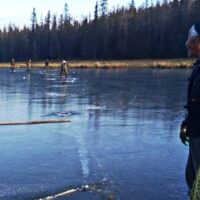
Sakha Republic’s Resilience: Unveiling the Positive Impact of Climate Change Amid Thawing Challenges

Use the form below to contact us directly.
Please complete all required fields.
Booking details
Submit booking, confirmation, booking info.
First name:
Special requirements:
Total price:
We wish you a pleasant trip your LIFE on the PLANET LADAKH team
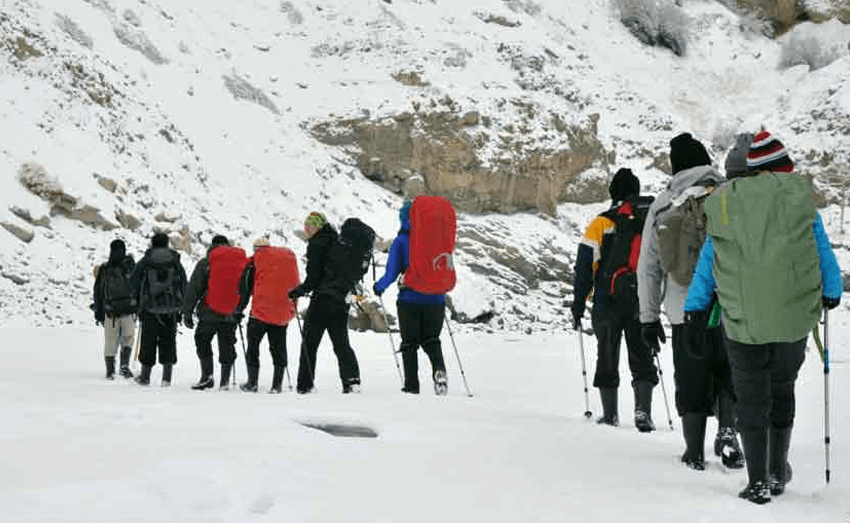
Day 01: Arrive in Leh and Explore the Town
As you fly over the snow-capped mountains of Ladakh, you'll understand why it's impossible to reach this region by road in the winter months. Landing at the Leh airport, one of the highest in the world, you'll be greeted with crisp, fresh air and a significant drop in temperature.
Although the town is just awakening from its winter slumber, you can take a stroll through the Leh market to find a few shops and eateries open for last-minute trek shopping. However, the chill in the air will only give you a preview of the freezing temperatures you'll face during your winter trek. You'll spend the night in a cozy guest house.
Day 02: Drive to Tilad Do via Chilling
Start your morning by witnessing the sunrise from the Shanti Stupa, offering a panoramic view of Leh and its surroundings, including Stok Kangri peak. But today's agenda involves a thrilling long-drive to Chilling, offering picturesque views along the Indus to the village of Nimu, where Zanskar converges into Indus.
After stopping at this confluence point to take in the view, the road begins to descend right into the river valley. Brace yourself for some heart-stopping moments as the vehicle navigates steep hairpin bends over snow-covered roads. The road goes past Chilling to Tilad Do, where you'll cross the frozen Zanskar to reach your campsite.
As you take your first steps on the Chadar, it takes a while to get a hang of walking on the ice sheet. After reaching the campsite, you can climb nearby mountains and get a good look at the frozen river. As the sun sets, the temperature drops, and the warm sleeping bags in your tent become quite inviting.
Day 03: Tilad Do to Gyalpokyalzos
The biggest challenge of this day and the remaining days is to get out of the warm sleeping bags and go out into the freezing outdoors. However, the steaming cups of tea being served provide ample motivation.
Today, you'll embark on a long walking session, about 12 km, on the Chadar. The trek leaders from LIFE on the PLANET LADAKH give a briefing about the day and give tips on how to walk on the Chadar. Depending on the weather, the Chadar can assume various forms, such as a slippery ice surface or a dusting of snow over it, providing a good grip.
The ice can be thick or thin, and it's best to keep closely following the guide. Locals have a sixth sense as to where to step on the Chadar. At times, it might be necessary to wade through ankle-deep water or climb the cliffs at the side of the river.
As you walk on the Chadar, you'll get used to it, and it will feel like a cross between gliding and skating. Midway to Gyalpo, the porter-cum-cooks will prepare hot bowlfuls of soupy noodles for lunch. It's important to keep up a decent level of fluid intake to help you adapt to the conditions faster.
After passing Shingra Koma, you'll reach the campsite for the day at Gyalpo, where the tents have already been pitched by the porters. The Gyalpo campsite is at a bend in the river, surrounded by high peaks and walls of rock-faces that almost look man-made. Soak in the views, have an early dinner, and call it a day.
Day 04. Gyalpo kyalzos to Tibb Cave
Wake up early to enjoy a cup of tea before breakfast at 8 am, followed by a quick-march at 8:30 am. Be sure to have a good breakfast, as today is the longest walk of the trek at almost 14 km. But don't worry, the walking will keep you incredibly warm.
Today's trek takes you through the deep ravines of the Zanskar, with sublime mountain walls on either side of the river that keep the sunlight away for most of the day. You'll see numerous caves, big and small, as well as frozen waterfalls, some of which are higher than others.
Legend has it that centuries ago, local villagers faced a water shortage and went to Tibet to plead for water. They were given a box that they were to open once they reached the village, but curiosity got the better of them, and two fishes jumped out of the box, creating two huge waterfalls. One of those waterfalls, miraculously, is not iced-up even in such freezing cold.
At Tibb, you'll find a big cave that serves as the dwelling for all the porters. They welcome you warmly and invite you to share a cup of butter-tea with them, the highlight of the day.
Day 05. Tibb Cave to Naerak
Today is the most spectacular day of the trek. Walking on the river, you'll cross deep gorges and reach a point where Juniper trees are covered with prayer flags. The porters will give you a twig of this tree tied with a piece of prayer flag as a badge of good-luck and good-health.
A few steps away stands the mother-of-all frozen waterfalls, a huge instance of suspended animation several feet tall and equally wide. You can see dozens of colors in this enormous ice structure as sunlight plays off its surface. Right next to the waterfall is a bridge across the river that is part of the summer-time road from Zanskar to Leh.
The Naerak village lies several feet above the river, and a vigorous hour-long trek can take you there if you want to see the life of a Zanskari. The camp is set up close to the river, so you can enjoy the serene sound of the flowing water as you relax and take in the breathtaking surroundings.
Day 06. Return Journey to Tibb
Today, we begin the return journey to Tibb cave, but don't expect to be retracing the exact same path back to Chilling.
The Zanskar River is constantly changing due to temperature fluctuations, and the Chadar takes on a completely new form.
You'll see locals wearing traditional woolen Gonchas, including monks hiking from Lingshed Monastery to Leh, and young students with their parents returning to school after winter vacation.
Observe the locals as they expertly navigate the Chadar, seemingly unfazed by the sub-zero temperature and biting cold winds.
Day 07. Tibb to Gyalpo
Today's trek takes us from Tibb to Gyalpo, passing by castle-like walls of mountains rising on both sides of the river.
Keep an eye out for footprints belonging to foxes, ibex, or even snow leopards, which are known to inhabit the area.
While it's rare to spot a snow leopard, it's highly likely that they're watching you from afar.
Day 08. Gyalpo to Tilad Do and Departure
On this last day of trekking on the Chadar, take in the beauty of the frozen river before bidding farewell to Zanskar and the friendly Zanskari people.
Once you reach Tilad Do, our team and porters will take care of you before driving back to Leh, where you'll spend the night in a cozy guesthouse.
Day 09. Departure from Leh
Depart from Leh, reflecting on your incredible adventure trekking on the frozen Zanskar River and the unique culture and traditions of the Zanskari people.
View route map for Chadar Tipp Gyalpo Trek on plotaroute.com
Embarking on a Chadar Tibb Gyalpo Trek Unveiled: Discovering the Path to Inner Peace
What is a chadar tibb gyalpo trek .
In the hustle and bustle of our modern lives, finding inner peace can sometimes feel like a distant dream. We are constantly bombarded with stress, distractions, and responsibilities that pull us in all directions, leaving us feeling overwhelmed and disconnected from ourselves. But what if I told you that there is a path to inner peace, a Chadar Tibb Gyalpo Trek that can help you find serenity amidst the chaos? In this article, we will explore what a Chadar Tibb Gyalpo Trek entails and how it can uncover the path to inner peace.
A Chadar Tibb Gyalpo Trek is a personal voyage of self-discovery and growth, where we consciously seek to cultivate inner peace and serenity. It is a deliberate choice to embark on a path that allows us to find solace within ourselves, regardless of external circumstances. This journey involves exploring various practices and techniques that can help us connect with our inner selves, find balance, and achieve a state of tranquility. It is about slowing down, being present, and finding harmony in our thoughts, emotions, and actions.
The importance of inner peace
Inner peace is not just a lofty ideal or a luxury Chadar Tibb Gyalpo Trek; it is a fundamental need for our overall well-being and happiness. When we lack inner peace, we become more susceptible to stress, anxiety, and other negative emotions that can take a toll on our mental and physical health Chadar Tibb Gyalpo Trek. Inner peace, on the other hand, is like an anchor that keeps us grounded and resilient in the face of challenges. It allows us to navigate through life’s ups and downs with grace and equanimity.
Moreover, inner peace is not just beneficial for ourselves; it also has a positive ripple effect on those around us. When we are at peace within ourselves, we radiate a calm and positive energy that can inspire and uplift others. Our relationships become more harmonious, and our interactions become more compassionate and understanding. Inner peace is, therefore, not a selfish pursuit but a gift that we can offer to ourselves and the world.
The benefits of embarking on a Chadar Tibb Gyalpo Trek
Embarking on a Chadar Tibb Gyalpo Trek can bring forth a multitude of benefits that extend beyond just inner peace. As we delve deeper into our journey, we begin to develop a heightened self-awareness, gaining a clearer understanding of our thoughts, emotions, and patterns of behavior. This self-awareness allows us to make conscious choices and break free from negative habits and conditioning that no longer serve us.
Additionally, a Chadar Tibb Gyalpo Trek helps us cultivate resilience and emotional intelligence. It equips us with the tools and techniques to navigate through life’s challenges with grace and ease. We become more adaptable and less reactive to external circumstances, allowing us to maintain our inner equilibrium even in the midst of chaos.
Moreover, a Chadar Tibb Gyalpo Trek fosters personal growth and self-acceptance. As we connect with our inner selves, we begin to uncover our true passions, values, and purpose in life. We gain the clarity and confidence to pursue our dreams and live authentically. This journey also enables us to embrace our imperfections and love ourselves unconditionally, fostering a deep sense of self-worth and fulfillment.
Exploring different paths to inner peace Chadar Tibb Gyalpo Trek
There are many paths that can lead us to inner peace, and it is important to find the ones that resonate with us personally. One such path is through mindfulness and meditation practices. Mindfulness involves being fully present in the moment, observing our thoughts and emotions without judgment. It helps us cultivate a sense of inner calm and clarity, allowing us to let go of worries about the past or future.
Meditation, on the other hand, is a practice that involves training the mind to focus and redirect our thoughts. It can be as simple as sitting in silence and focusing on our breath or engaging in guided meditation exercises. Regular meditation practice has been proven to reduce stress, improve concentration, and promote emotional well-being.
Another path to inner peace is through connecting with nature. Spending time in nature can have a profound impact on our mental and emotional well-being. It allows us to disconnect from the noise and distractions of daily life and reconnect with the beauty and stillness of the natural world. Whether it’s a hike in the mountains, a walk on the beach, or simply sitting in a park, immersing ourselves in nature can restore our sense of balance and tranquility.
Mindfulness and meditation techniques for inner peace Chadar Tibb Gyalpo Trek
Mindfulness and meditation are powerful tools that can help us cultivate inner peace. Here are a few techniques to incorporate into your daily routine:
Body scan meditation : Find a quiet and comfortable space. Close your eyes and bring your attention to different parts of your body, starting from your toes and moving up to your head. Notice any sensations or tension, and consciously release any tension you feel.

Walking meditation : Take a slow and mindful walk, paying attention to each step and the sensations in your body. Notice the sounds, smells, and sights around you, fully immersing yourself in the present moment.
Remember, the key to mindfulness and meditation is consistency. Set aside a few minutes each day to practice, and gradually increase the duration as you become more comfortable.
Connecting with nature for a Chadar Tibb Gyalpo Trek
Nature has a way of soothing our souls and reconnecting us with our true essence. Here are some ways to connect with nature and enhance your Chadar Tibb Gyalpo Trek:
Practice forest bathing : Forest bathing, also known as shinrin-yoku, is a Japanese practice that involves immersing oneself in the healing atmosphere of a forest. Simply spend time in a forested area, engaging all your senses and allowing the sights, sounds, and smells of nature to rejuvenate your spirit.
Exploring Different Paths to Inner Peace
There are myriad paths to inner peace, and what works for one person may not work for another. It is essential to explore different practices and techniques to find what resonates with us personally. Some people find solace in mindfulness and meditation, while others may find peace through engaging in creative activities such as painting or writing.
Mindfulness and Meditation Techniques for Inner Peace
Mindfulness and meditation are powerful practices that can lead us towards inner peace. Mindfulness involves paying attention to the present moment without judgment, cultivating a state of non-reactive awareness. By practicing mindfulness, we can train our minds to focus on the present and let go of worries about the past or future. This practice allows us to develop a sense of inner calm and tranquility.
Meditation, on the other hand, involves intentionally focusing our attention and eliminating the stream of thoughts that often clutter our minds. Through meditation, we can cultivate a sense of inner stillness and peace. Regular meditation practice has been shown to reduce stress, improve concentration, and enhance overall well-being.
Connecting with Nature for a Chadar Tibb Gyalpo Trek
Nature has a profound impact on our well-being and can be a powerful catalyst for inner peace. Spending time in nature allows us to disconnect from the demands of modern life and reconnect with our true selves. Whether it’s taking a walk in the forest, sitting by the ocean, or simply gazing at the stars, nature has a way of soothing our souls and reminding us of the beauty and interconnectedness of all things.
Cultivating Gratitude and Positivity on Your Journey
Gratitude and positivity are essential qualities to cultivate on our Chadar Tibb Gyalpo Trek. By practicing gratitude, we shift our focus from what is lacking in our lives to what we already have. This shift in perspective can bring about a sense of contentment and appreciation for the present moment. Positivity, on the other hand, involves consciously choosing to see the good in every situation and maintaining an optimistic outlook on life. These practices can help us cultivate inner peace and foster a mindset of abundance and joy.
Finding Balance and Harmony in Your Life
Finding balance and harmony is crucial for inner peace. It involves aligning our actions, values, and priorities with our innermost desires and aspirations. This may require making conscious choices to simplify our lives, set healthy boundaries, and prioritize self-care. By finding a balance between work, relationships, and personal well-being, we create a fertile ground for inner peace to flourish.
Cultivating gratitude and positivity on your journey
Gratitude and positivity are essential ingredients for a Chadar Tibb Gyalpo Trek. By cultivating an attitude of gratitude, we shift our focus from what is lacking in our lives to what we already have. This shift in perspective allows us to appreciate the present moment and find joy in the simple things.
One way to cultivate gratitude is to keep a gratitude journal. Each day, write down three things you are grateful for. They can be as simple as a warm cup of tea in the morning or a kind word from a friend. By consistently practicing gratitude, we train our minds to notice the positive aspects of our lives, which in turn enhances our overall sense of well-being.
In addition to gratitude, nurturing a positive mindset is crucial for inner peace. Positive affirmations, visualization exercises, and surrounding ourselves with uplifting and supportive individuals can help cultivate positivity. Practice self-compassion and treat yourself with kindness and understanding, just as you would a dear friend.
Finding balance and harmony in your life
In our fast-paced and demanding world, finding balance and harmony is essential for our well-being. Here are a few tips to help you find balance on your Chadar Tibb Gyalpo Trek:
Create a daily routine : Establishing a daily routine can provide a sense of structure and stability. Include activities that promote self-care, mindfulness, and relaxation in your routine. This will help you create a sense of balance and ensure that you prioritize your well-being.
Embracing self-care practices for inner peace
Self-care is a vital aspect of our Chadar Tibb Gyalpo Trek. It is about nourishing ourselves physically, mentally, and emotionally. Here are some self-care practices to incorporate into your daily life:
Nurture your mind : Engage in activities that stimulate your mind and promote mental well-being. This can include reading books, engaging in creative hobbies, or learning something new. Take breaks from technology and spend time in quiet reflection or journaling.
Cultivate emotional well-being : Allow yourself to feel and express your emotions in healthy ways. This can include talking to a trusted friend or therapist, practicing self-compassion, and engaging in activities that bring you joy and relaxation Chadar Tibb Gyalpo Trek.
Conclusion: Embrace the path to inner peace and embark on your Chadar Tibb Gyalpo Trek
Embarking on a Chadar Tibb Gyalpo Trek is a profound and transformative experience. It is a commitment to nurturing your inner self, finding balance, and cultivating inner peace. Remember that this journey is unique to you, and there is no right or wrong way to embark on it. Explore different paths, experiment with various practices, and find what resonates with you.
By embracing the path to inner peace, you open yourself up to a world of growth, self-discovery, and serenity. So take the first step today and embark on your Chadar Tibb Gyalpo Trek. Embrace the beauty of the present moment, cultivate gratitude and positivity, and nurture yourself with self-care. The path to inner peace awaits you.
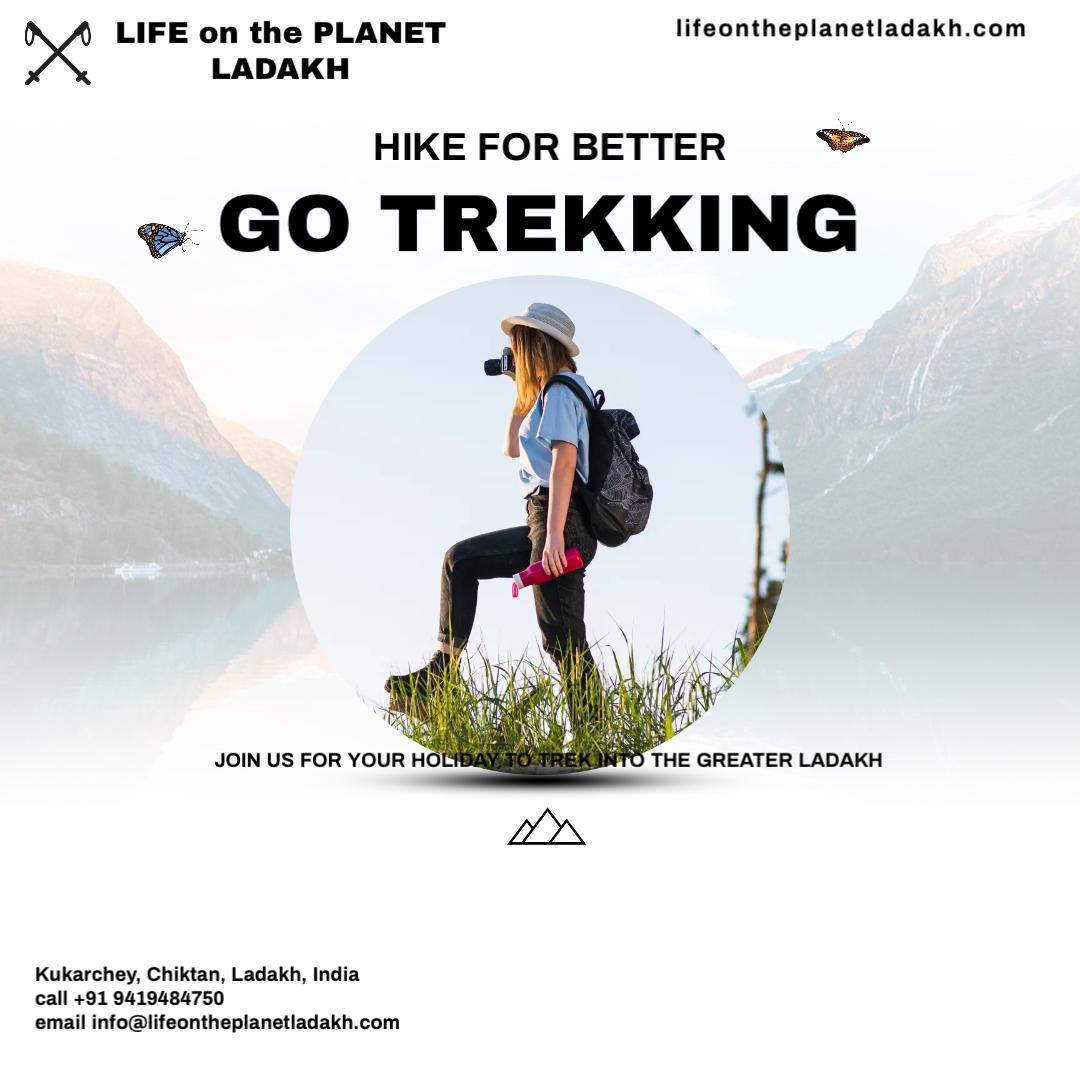

The Chadar Trek – India’s Frozen River
Chadar Trek, known as Zanskar Gorge or The Frozen River, is the most thrilling hike in the Himalayas, and there is no other like it. Chadar means “white sheet,” hence the name.
The Chadar Trek is one of India’s most unique and challenging treks. The multiday Chadar hike across the frozen Zanskar River in Ladakh occurs from late January to late February or sometime in March, depending on the weather. Walking on the thick glass of an icy river with great mountains on either side is a once-in-a-lifetime experience.
Photo Credit: Sumita Roy Dutta Wikimedia Commons
Coming in at 11,150 feet, the Chadar Trek almost feels like an expedition to the North Pole. Temperatures drop to 30 degrees at night, all food and drink are transported on sleds, and you must find refuge in caves. By all accounts, taking on The Chadar Trek is on many people’s bucket lists – especially thrill-seekers that enjoy challenging hikes. The area’s local people are known as Zanskari, whose main occupation is cattle-rearing and farming.
This post may contain affiliate links. Please read our disclosure and privacy policy for more information.
Reasons To Take On The Chadar Trek
The Chadar Trek is one of the unique treks in the world. You are hiking the surface of a frozen river. Other hikes in India are through hills and mountains that pass through passes and caves, ancient forts, and valleys. This one meanders along the Zanskar route, where the ice is thick enough to walk on.
A Whole New World Visiting The Chadar Trek
The Chadar Trek will force you out of your comfort zone. Far from civilization, you will be cold most of the time. Try butter tea (which not everyone likes), and be at the mercy of nature, but only for a few days. You will get a new understanding of life far away from the cities and be one with nature.
You will learn a lot about Ladakhen and its challenges. It is a humbling experience, and you will develop a deeper appreciation for the comforts and privileges of your daily life.
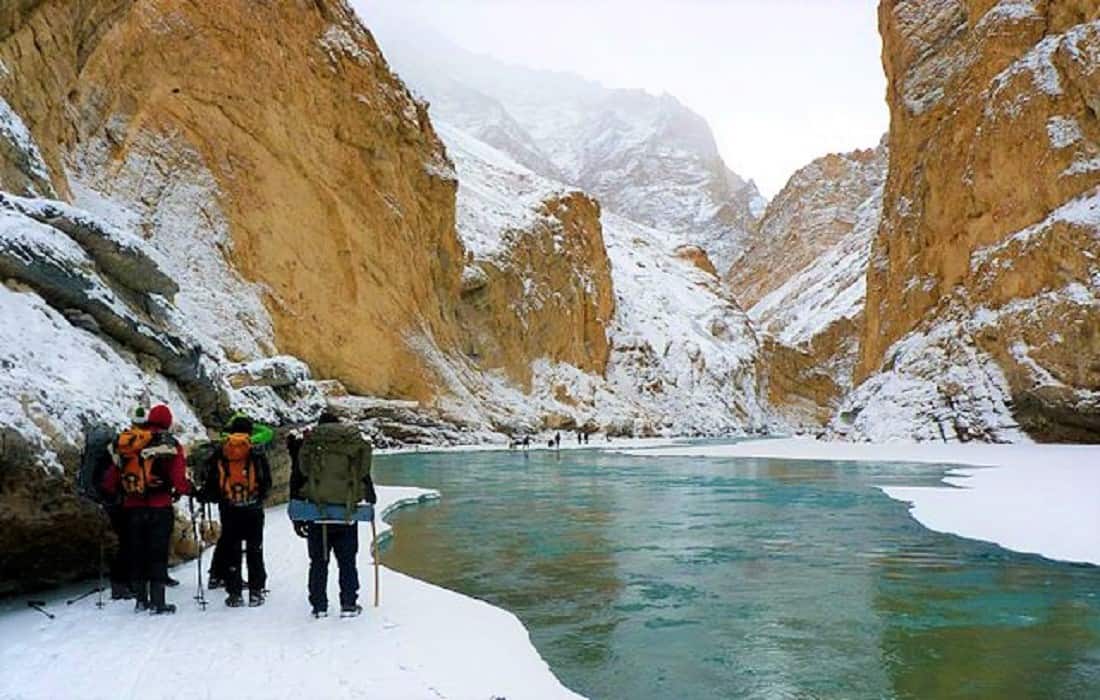
Photo Credit: Sumita Roy Dutta Wikimedia Commons
See Places You Have Never Seen Before During The Chadar Trek
Winter brings dramatic changes to the Ladakh landscape. This high-altitude desert offers the most spectacular views thanks to the Zanskar River, especially in the valley.
Experience waterfalls that have frozen over and form icicle walls that tower over your head. You will see air bubbles from the river frozen under the ice. On some trek sections, you hike on a thick layer of ice under which the river swirls. Around them, the Chadar changes daily.
If the temperature rises by just a few degrees, the ice melts, breaks, and freezes. You can see mountain goats navigating the steep slopes if you are lucky. The surrounding trees are leafless, and their branches, blackened by the weather, stand out in stark contrast to the surrounding white landscape.
There Is No Other Trek In India Like The Chadar Trek
The Chadar Trek is unique because it takes place on the surface of a frozen river. Other treks in India go through hills and mountains, passes and caves, and ancient forts and valleys. This trek meanders along the Zanskar River. Where the ice is thick enough, you will walk on it. Where the guides think the ice is too thin, you will hike on the frozen banks of the river. You will stop to camp and enjoy the calm river and the starry sky above.
You can see the bonfires of other trekking groups downstream. Enjoy singing lessons and devour hot meals that will make the chilly night less daunting.
One of the Chadar Trek highlights is Tibb Cave , an ancient cave that is becoming popular for all hikers.

The soot from decades of campfires has blackened the cave walls. Someone is constantly stirring a large container of hot and cold soup at any time of the day. Here, you will be offered more tea. The feeling of camaraderie is calming, and you will feel like a true adventurer sharing your experience with fellow hikers.
Tibb Cave Temperature
The temperature is twenty degrees below the freezing point and sometimes even colder!
Bragging Rights
The Chadar Trek hike is not challenging – assuming you are physically fit enough. There are no steep slopes, and no technical training is required. However, it should not be taken lightly. The weather and altitude make this trek challenging. The harsh conditions can put your life at risk if you don’t listen to your guide.
Remember: There is a fast, icy river swirling beneath your feet at all times. But that’s what makes it so special, not everyone daretake up the challenge of the Chadar.
When you return, you will feel stronger and more confident than ever.
Something about an adventure like this makes you feel better about yourself – more accomplished! And when the Chadar hike is over, you will join an elite community of trekkers from Tschadar who have faced everything. Be prepared for shocking looks and many questions as you become the hero of your circle.
Chadar Trek Facts
- Chadar Trek duration: Typically 9 Days and 8 Nights (but it can vary)
- Start and End Point: Guest House in Leh
- Maximum Altitude: 11,123 feet
- Chadar Trek Distance: 62 km
- Level of difficulty: Difficult Chadar Trek
- Temperature: 5 to 15 degrees (daytime) and 15-25 degrees (overnight )
- Last ATM: Leh Market and Airport.
Permits & Rules for the Chadar Trek
To ensure that trekkers are safe and abide by the rules, the Leh Government instituted regulations and permits that you will need to follow & get upon arrival in Leh.
All trekkers must:
- Acclimated in Leh for two days post-arrival & before departing for the trek
- Go through a medical check-up and get a medical certificate from a local medical board in Leh that states that you have acclimated to the altitude and are physically fit to take the trek.
- Mandatorily have trek & personal accident insurance for the trek
- Get a permit from ALTOA post submission of NOC & medical certificate
Nerak Waterfall
One of the Zanskar river hikes highlights a grand waterfall that is completely frozen over from top to bottom – The Nerak Waterfall.
The thick ice sheets forming the Zanskar River resemble a white sheet called “Chadar.” The Zanskar River is best known as the Chadar Trek. While it may seem like a challenging hike, it is not the most difficult. It is a flat hike along the Chadar with minimal inclines. You are in good hands if you can hike for a couple of hours without much stress.
Regarding trekking in India, Chadar is the most glamorous and arduous trek.
In 2019, the local administration required all Chadar Trek participants to undergo a medical examination at the SNM Hospital, Leh post, to receive a fitness certificate.
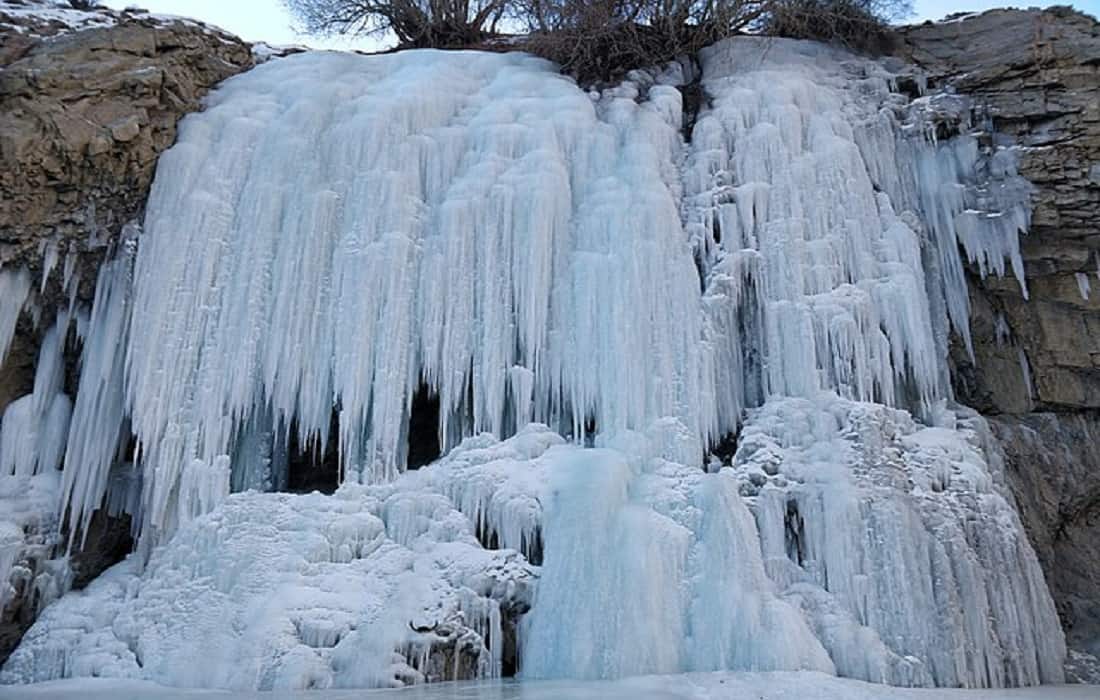
Photo Credit: SukeerthaKrishna Wikimedia Commons
How To Reach The Chadar Trek
Air : The nearest airport to Chadar Trek is Kushok Bakula Rimpochee Airport (IXL), located in Leh. This airport is connected to major international airports in India like Delhi, Mumbai, Chennai, etc.
By Train : Take the New Delhi Jammu Tawi Rajdhani Express, which leaves Delhi at 8:40 pm. and arrives in Jammu at 5:45 am. You can take a bus from Jammu to Srinagar; from Srinagar, there are regular buses to Leh. It is recommended to fly from Delhi to Leh and rent a taxi to Chilling the next day after acclimatization.
By Road : Delhi to Leh is 1,266 km via the NH1. It is 64 km from Leh to Chilling. To get to the Chadar Trek, one has to go to Leh. From Leh, the journey begins and leads to the freezing Zanskar River.
From Leh, it takes about 65 to 70 km to reach the trek base camp via Tiled.
Book Your Excursion
Things you need to do the chadar trek:.
- Woolen cap, socks, mittens & scarf
- Warm clothes
- Toilet paper & wipes
- Walking stick
- Day pack (20-30l)
- Water bottle
- Extra pair of socks
- Backpack with waterproof linings
- Fleece jackets and thermals
- Led torch (with extra batteries)
- Lightweight quilt or blanket
- Mosquito & insect repellent
- Waterproof windcheater
Best Time To Visit The Chadar Trek:
The Zanskar River freezes completely at the beginning of January and remains frozen for two months. The best time to do Chadar Trek is from mid-January to early February.
Difficulty Level Of The Chadar Trek:
The Chadar Trek is a unique experience, but the adverse conditions and an astonishing height of 11,123 meters make it a difficult journey. In such a situation, physical fitness becomes critical. A physically healthy person can complete the trek; however, many precautions must be taken.
Places To Visit Near The Chadar Trek
- Tilat Sumdo is a campsite for the Chadar trek where you can view the Himalayas.
- Shinra Koma is 10 km from Tilat sumdo, which has scenic beauty and spellbound tourists.
- Tibb- Tibb offers a beautiful waterfall and cave.
- Nerak- Nerak is the base camp for the trek and is a spot for sunset, which is fantastic.
- Gyalpo – Gyalpo is a campsite located at a bend in the Zanskar River and is imposed by peaks and walls of rock faces that look artificial.
- Diploma – Dibyokma is again a campsite that offers breathtaking views of the Himalayas.
- Lingshed – It is one of Ladakh’s oldest villages and boasts awe-inspiring natural exquisiteness. This region is famous for the Lingshed Monastery, one of Ladakh’s oldest monasteries.
FAQs About The Chadar Trek
As a newbie to trekking, you might wonder whether you can do the Chadar trek as a beginner. As long as you prepare correctly, you can do it . Formerly, the Chadar Trek was considered a challenging hike reserved only for experienced hikers.
India’s most challenging trek is this one. You will cover approximately 105 kilometers on foot during the trek. Daytime temperatures range from -15 to -20 degrees, while nighttime temperatures dip to -25 degrees. Almost all of the trek must be completed on foot.
As a result of the rising threat and fear around the new Covid -19 Omicron variant, the Ladakh administration has decided to suspend the famous Chadar Trek in 2022. Leh district authorities have also agreed to suspend snow leopard sighting expeditions and other winter tourism activities.
It is 65 miles long.
Closing Thoughts
Most people will not think of India when trekking a frozen river. Most will think of Iceland or Patagonia – maybe even Antarctica. And, as stunning and elite as these other locations are, don’t rule out what India has to offer in terms of challenging and unique treks.
Have you done the Chadar Trek? Please share your experience with us here.
Looking For More Travel Inspiration? Start Here?
- Budget Hiking Destinations In Europe – The Best 15!
- Cordelia Cruises – The Only Way To Cruise in India
- Must-Have Camping Gear You Can’t Afford to Miss This Camping Season
- The Gates Of Heaven Bali At Lempuyang Temple
- The Hello Kitty Flight – What To Expect
- Travel To India From USA – 8 Reasons Why You Should!
- Top 15 Things To Do In Bali
- Trekking in the Himalayan Mountains
We participate in the Amazon Services LLC Associates Program, an affiliate advertising program designed to provide a means for us to earn fees by linking to Amazon.com and affiliated sites.
Share with others!
Nikki Webster is a travel writer who covers how to travel while grinding a day job without breaking the bank. Nikki is always in search of off-the-beaten-track experiences and unique stays. She is particularly fond of Florida and writes extensively about the state. She flies around 60,000 miles annually and has visited 74 countries, 50 states, and six continents. You can read all about her travels at www.britonthemove.com or follow along on Facebook, Pinterest, and Instagram.
Similar Posts

Palatka Florida – Discover The Top Activities and Attractions
Heading to Florida for the weekend? Be sure to visit Palatka then! The city is situated on the western bank of the picturesque St. John’s River. With a population of approximately 10,500, Palatka, Florida, is located between Jacksonville on the northeast and Orlando on the south. This small town has a super interesting history and…

How to Explore Dubai – The Complete Guide
Dubai is a beautiful city with the newest, trendiest, and oldest of so if you’re gearing up for a visit here, this exclusive “How to Explore Dubai” travel guide that covers almost everything you need to know about the destination, including the recent COVID-19 guidelines. This post may contain affiliate links. Please read our disclosure and…
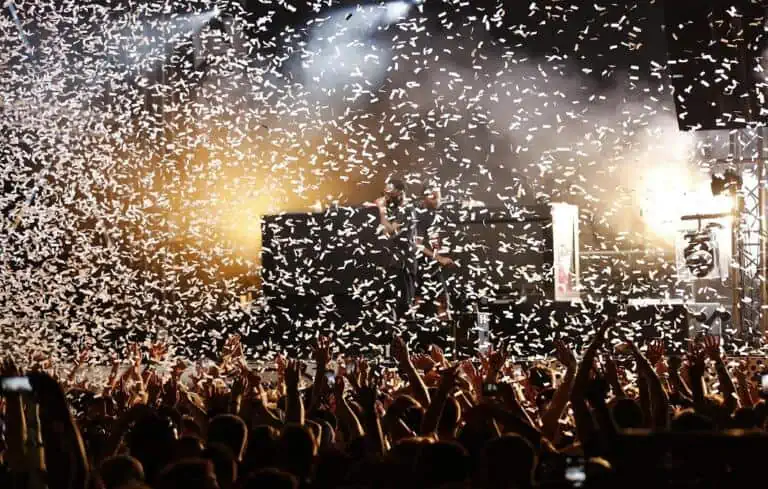
10 Best Ibiza Clubs – The 2023 Guide
People go to Ibiza for many reasons—to lay on the beach, enjoy good food, and explore the history and architecture of Old Town. But everyone knows that what makes Ibiza so unique and famous worldwide is the nightlife. People visit from all corners of the globe to party all night in storied clubs, with favorite…

Castle Howard – Yorkshires Brideshead Revisited
Located in York, northern England is Castle Howard. Despite its name, it is not a traditional castle. Castles are fortified structures to defend against attacks, but the term “castle” is often part of an English estate home’s name. Likewise, when a building sits on a prior castle site, the term castle is common. Castle Howard…

Peppa Pig Theme Park – A Certified Autism Center
A British animated series “Peppa Pig” hit kids worldwide in 2004. Soon after the launch of the series, it became famous worldwide. This humanlike pig and her family have been experiencing adventures with her friends for over 300 episodes, all the while teaching crucial social and emotional skills. And now, there’s a Peppa Pig Theme…

7 Best Ways To See Behind The Scenes On A Cruise Ship
Do you ever wonder what goes on behind the scenes on a cruise ship? Cruise operations are more than just the ‘front of the house” or what you see. On a cruise ship, the real work happens at the ‘back of the house.’ Only a few passengers ever get to see behind the scenes. Few…
Exploring the Chadar Trek through your guide feels like embarking on a thrilling icy odyssey across India’s frozen river. Your vivid descriptions and practical insights create a compelling narrative, making this frozen adventure come alive for readers. Well done!
I really enjoyed your post, saw the Trek and it was breathtaking.
nice article on chadar trek The Chadar Trek or Zanskar frozen river trek is a winter trek in Zanskar Valley, Ladakh. The trek starts from Leh going through Shingra Koma, Tibb Cave, Naerak Camp concluding back in Leh. The 105 Km trek provides trekkers and hikers an amazing opportunity to trek on a frozen sheet of ice in subzero temperatures. The trek is operational during the months of January and February when the Zanskar river freezes into a solid sheet of ice.
Beneficial information about the treck
What A Great Article.There Are So Many Different Places To Trek.
Leave a Reply Cancel reply
Your email address will not be published. Required fields are marked *
Save my name, email, and website in this browser for the next time I comment.

Your local forecast office is

Severe Thunderstorms and Flash Flooding Across the Gulf Coast; Blizzard Conditions in Southwest Alaska
Strong to severe thunderstorms capable of producing a few tornadoes, heavy rain and damaging winds will continue through tonight across the Southeast. Heavy to excessive rainfall may lead to flash, urban and minor to moderate river flooding especially along the Florida Panhandle. In Alaska, a strong Bering storm will continue to produce blizzard conditions across the Southwest through Thursday. Read More >

Muscatine (KMUT)

More Information:
Local Forecast Office More Local Wx 3 Day History Mobile Weather Hourly Weather Forecast

Mostly Cloudy
Low: 48 °F
Slight Chance Showers then Chance Showers and Breezy
High: 62 °F
Thursday Night

Chance Rain and Breezy
Low: 44 °F

Sunny and Breezy
High: 63 °F
Friday Night

Low: 39 °F

High: 75 °F
Saturday Night

Partly Cloudy
Low: 58 °F

High: 83 °F
Sunday Night

Mostly Clear
Low: 56 °F
Detailed Forecast
Additional forecasts and information.
Zone Area Forecast for Muscatine County, IA
- Forecast Discussion
- Printable Forecast
- Text Only Forecast
Hourly Weather Forecast
- Tabular Forecast
- Quick Forecast
- Air Quality Forecasts
- International System of Units
- Hazardous Weather Outlook
- Public Information Statement
- Past Weather Information
Additional Resources
Radar & satellite image.

National Digital Forecast Database
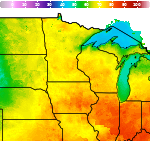
High Temperature

Chance of Precipitation
Elyektrostal', Moscow
Elyektrostal'
Around the Globe
Hurricane tracker.
Severe Weather
Radar & Maps
News & features.
Orange Warning for Rain-Flood
2:00 PM Tuesday - 12:00 PM Thursday
4:00 AM Thursday - 1:00 PM Thursday
Orange Warning for High Temperature
4:00 AM Thursday - 9:00 PM Friday
Wind SE 5 mph
Air Quality Fair
Wind Gusts 9 mph
Humidity 88%
Indoor Humidity 52% (Ideal Humidity)
Dew Point 50° F
Cloud Cover 98%
Visibility 6 mi
Cloud Ceiling 30000 ft
RealFeel Shade™ 54°
Wind SE 6 mph
Max UV Index 0 Low
Wind Gusts 12 mph
Humidity 82%
Cloud Cover 100%
Visibility 7 mi
RealFeel Shade™ 55°
Wind SW 8 mph
Max UV Index 1 Low
Wind Gusts 18 mph
Humidity 74%
Cloud Ceiling 24100 ft
RealFeel Shade™ 59°
Wind SW 9 mph
Wind Gusts 20 mph
Humidity 67%
RealFeel Shade™ 60°
Wind SW 10 mph
Wind Gusts 21 mph
Humidity 63%
Indoor Humidity 53% (Ideal Humidity)
RealFeel Shade™ 62°
Wind WSW 12 mph
Max UV Index 2 Low
Wind Gusts 22 mph
Humidity 60%
Indoor Humidity 54% (Ideal Humidity)
Dew Point 51° F
Wind W 15 mph
Wind Gusts 23 mph
Humidity 59%
Indoor Humidity 56% (Ideal Humidity)
Dew Point 52° F
Cloud Ceiling 24000 ft
RealFeel Shade™ 64°
Wind W 17 mph
Wind Gusts 24 mph
Humidity 57%
RealFeel Shade™ 63°
Wind W 16 mph
Wind Gusts 27 mph
Humidity 56%
Cloud Cover 97%
Visibility 10 mi
2:00 PM Thursday - 12:00 PM Saturday
Wind W 14 mph
Wind Gusts 28 mph
Humidity 51%
Indoor Humidity 48% (Ideal Humidity)
Dew Point 48° F
Cloud Cover 94%
RealFeel Shade™ 61°
Wind W 13 mph
Wind Gusts 30 mph
Humidity 48%
Indoor Humidity 43% (Ideal Humidity)
Dew Point 45° F
Cloud Cover 92%
Wind Gusts 25 mph
Humidity 45%
Indoor Humidity 39% (Ideal Humidity)
Dew Point 42° F
Cloud Cover 61%
RealFeel Shade™ 58°
Humidity 43%
Indoor Humidity 35% (Slightly Dry)
Dew Point 40° F
Cloud Cover 31%
Indoor Humidity 32% (Slightly Dry)
Dew Point 37° F
Cloud Cover 0%
RealFeel Shade™ 53°
Indoor Humidity 31% (Slightly Dry)
Dew Point 36° F
Wind WNW 12 mph
Wind WNW 10 mph
Wind Gusts 17 mph
Humidity 53%
Wind W 9 mph
Wind Gusts 16 mph
Humidity 58%
Wind Gusts 15 mph
Humidity 62%
Indoor Humidity 30% (Slightly Dry)
Further Ahead
Top Stories
Damaging wind, tornado threat high as severe weather rattles South

'Worst case scenario': tornadoes and flooding across Louisiana
Torrential rain unleashes significant flooding in southern US

Severe storm causes warnings across the south-central US
Severe thunderstorms to ignite in parts of Northeast, Midwest
5 hours ago

Featured Stories
March 2024 hottest on record, EU climate service says
13 hours ago

Weather News
Colombia’s capital to ration water as El Niño adds to drought
12 hours ago

Cicadas to swarm US in first double-brood emergence in 200 years

Taiwan’s Taroko National Park closed indefinitely following earthquake

Why caddies wear white jumpsuits at the Masters

Weather Near Elyektrostal':
- Balashikha , Moscow
- Khimki , Moscow
- Moscow , Moscow
We have updated our Privacy Policy and Cookie Policy .
Get AccuWeather alerts as they happen with our browser notifications.
Notifications Enabled
Thanks! We’ll keep you informed.
See how the eclipse transformed America, city by city

For weeks, if not months, those who have seen one repeated to anyone who would listen: There’s nothing like experiencing the totality of a solar eclipse.
For some of them, this was a second time in six and a half years experiencing the eerie calm when the moon passes in front of the sun, at least for a few minutes. And yet, they were just as awestruck.
For others, it was a likely last opportunity to witness such a celestial phenomenon for two decades. It inspired gasps and smiles, solemnity and excitement.
Here is how it looked as the moon’s shadow crossed three countries and 13 U.S. states, with the time of totality in Eastern time.
El Salto, MX
2:10 — 2:14 p.m.
Uvalde, tex., 2:29 — 2:33 p.m., russellville, ark., 2:50 — 2:54 p.m., carbondale, ill., 2:59 — 3:03 p.m., bloomington, ind., 3:04 — 3:08 p.m., tiffin, ohio, 3:11 — 3:15 p.m., littleton, maine, 3:32 — 3:35 p.m..

Time of totality
El salto, mexico.
A group of professors and students traveled from the United States to El Salto to conduct the most thorough experiment ever using an eclipse to test Albert Einstein’s theory of relativity. Einstein’s idea held that the massive sun would bend the light of surrounding stars more than previously estimated, proving that matter can pull and warp space and time.
The researchers used five telescopes to measure that effect more closely than ever, measuring stars that appear so close to the sun’s edge they can only be viewed during an eclipse.
After a countdown in Spanish, the sun darkened, and the data collection began. “TOTALITY,” yelled Sam Jeffe, a third-year physics major at Willamette University as it appeared in the telescopes’ lenses. “And it’s clear!”
Researchers will feed the data into the computer program, which will analyze the position of the stars and determine how the sun bent the light around them. But, for now, more than half the battle was done.

2:27 — 2:31 p.m.
Eagle pass, tex..
On U.S. soil, totality first came into view in the border city of Eagle Pass, Tex., where a crowd gathered at a football field erupted into cheers as the skies darkened above them.
A singer crooned, “I’m walking on sunshine!” People put on protective glasses and craned their necks toward the sky. Many began to clap.
Vita Garza Flores, 76, traveled from Northern California to see the eclipse in the city where she was born. She brought her daughter and brother along with her.
She grabbed her eclipse glasses, positioning them across her sunglasses: “Wow!”

Students from Uvalde High School were also among the citizen scientists using the eclipse to learn more about the sun and its effects on Earth.
They joined Southwest Texas Junior College’s STEM club in participating in a program known as the Citizen Continental-America Telescope Eclipse. Called Citizen CATE, it will combine short videos of the eclipse taken via telescope into an hour-long movie that NASA says will detail magnetic structure within the sun’s corona and reveal its density. That will help scientists to measure the strength of the solar wind — charged particles that can disrupt electricity grids and produce auroras when they reach Earth.

In Russellville, NASA gathered scientists and broadcast the eclipse’s progress live online. Tourists gathered there, too, wearing T-shirts that declared, “I got mooned at the eclipse.”
A jazz band from Arkansas Tech University played. NASA hosted workshops and Q&A sessions with scientists, at least one of whom has been to space: Among the visitors were Mike Massimino, a veteran of NASA space flight missions to upgrade the Hubble Space Telescope in 2002 and 2009.

Carbondale, Ill., earned the title of “eclipse crossroads of America,” having fallen in the path of totality for a 2017 solar eclipse as well as the event on Monday. This time, at least, the skies were clear for totality, and a full stadium of eclipse fans burst into collective screams when the moment came.
“This is so much better than 2017,” a one commentator on NASA’s live broadcast noted. “It’s so much darker than 2017.”

To many of those who experienced it, the eclipse was a spiritual event. In Bloomington, Buddhist monks marked it with a puja ceremony, a “ritual honoring and promoting inner and planetary healing,” according to the Tibetan Mongolian Buddhist Cultural Center.
Eclipse watchers flocked to Yellowwood Lake where they could experience the eclipse in nature.

When the last pulses of the sun’s rays make their way to Earth before an eclipse enters totality, they appear like a brilliant diamond set on a golden ring. In Tiffin, that meant a chance for some “unforgettable” weddings at an event called “Elope at the Eclipse.”

3:18 — 3:21 p.m.
Niagara falls, n.y..
Crowds flocked to landmarks across the path of totality for a memorable view. At Niagara Falls, despite a thick blanket of clouds, people gathered on the banks of the Niagara River and trained their phone cameras toward the sky. Streetlights turned on, if only briefly, when darkness descended.

The moon’s shadow reached North America at the beaches of Mazatlan, Mexico, just after 2:07 p.m. Eastern time. Just about 90 minutes later, it crossed the wilderness of northern Maine, on its way toward Canada, and then, the North Atlantic.
A total solar eclipse will next dim communities in the contiguous United States in 2044, but only in parts of Montana and the Dakotas. The country will have to wait one more year for the next coast-to-coast phenomenon, a total eclipse that will stretch from California to Florida on Aug. 12, 2045. It will be a Saturday.
About this story
Design and development by Stephanie Hays. Photo editing by Olivier Laurent. Design editing by Chloe Meister and Matt Callahan. Text editing by Katie Zezima. Graphics by Emily Eng. Video editing by John Farrell and Josh Carroll. Text by Scott Dance, Kasha Patel, Arelis R. Hernández and Joel Achenbach.
- Grand Rapids/Muskegon
- Saginaw/Bay City
- All Michigan
‘Star Trek’ fans, beam your way to this film screening with live orchestra
- Updated: Apr. 09, 2024, 2:17 p.m. |
- Published: Apr. 09, 2024, 2:00 p.m.

Fouad Fakhouri stands on the staircase in the lobby at the Temple Theatre in 2015. He is the Saginaw Bay Symphony Orchestra's conductor. The Saginaw News | MLive.com
- Justin Engel | [email protected]
SAGINAW, MI — The Saginaw Bay Symphony Orchestra’s 88th season will hit warp speed later this month with a performance set to accompany a screening of the 2009 “Star Trek” film.
“Star Trek: Live in Concert” will feature the orchestra playing the score of the J.J. Abrams-directed movie starring Chris Pine as Captain James T. Kirk as the film plays on the big screen of downtown Saginaw’s historic Temple Theatre.

Most Popular Stories by Justin Engel
- Houston, meet Hemlock. Michigan’s FIRST Robotics champs advance to nationals
- Charlie Berens to bring his Midwest stand-up comedy act to Saginaw
- Bay City wants residents to weigh in on housing, jobs and parks plan
If you purchase a product or register for an account through a link on our site, we may receive compensation. By using this site, you consent to our User Agreement and agree that your clicks, interactions, and personal information may be collected, recorded, and/or stored by us and social media and other third-party partners in accordance with our Privacy Policy.

IMAGES
COMMENTS
Experience the Chadar Trek Frozen River with Trek The Himalayas, India's Trusted Adventure Provider. Award-Winning Excellence, 4.8 Google Rating, 5400+ Reviews. ... In the rare event that TTH shifts a trek: We would like to emphasize that weather conditions in high-altitude areas are highly unpredictable and can undergo sudden changes at any ...
The temperature on the Chadar trek drops to as low as -30 degrees Celsius, and thin air keeps flattering your skin at every inch of your walk. Chadar trek is unique as it is a complete surprise package of slippery ice sheets, occasional cave stays, unusual campsites, and brisk-changing weather conditions.
Altitude we are going to cover in Chadar Trek. Leh - 3500 Meters Tsomo Paldar camp - 3200 Meters. Tibb Cave camp - 3300 Meters. Nerak camp - 3400 meters. The temperatures during the Chadar Trek. The temperatures during the Chadar Trek can be quite cold, as it takes place during the winter months when the region is covered in snow and ice.
The Chadar Trek is one of the most wild and beautiful hikes on the planet. Frequently covered by the world's top adventure channels and media outlets, the Chadar Trek takes hikers through a frozen river valley into the very heartland of India's Ladakh region. The region's harsh desert environment and towering mountains make the Chadar trek ...
One notable feature of the trek is the consistent, level terrain. There are no steep ascents or descents, and minimal altitude gain reduces the risk of altitude-related issues. Mastering today's walk signifies adequate acclimatization, boding well for the trek ahead. The appearance of the Chadar varies with weather conditions.
The Chadar trek is a challenging and remote trek in the Himalayan region, with unpredictable weather conditions and difficult terrain. Trekking with a proper organization ensures safety and security, as they provide experienced guides, necessary equipment, and emergency support.
Maintaining a good fitness level is essential to tackle the extreme conditions of Chadar Trek. It is recommended to incorporate regular jogging or equivalent workouts for 3-4 km daily for 1-2 months before the trek to prepare your body. In addition, you should also prepare your body for the cold by avoiding hot water, wearing warm clothes, and ...
The Chadar Trek is undoubtedly one of our favourite Himalayan treks. The first time we heard about Chadar Frozen River Trek in Ladakh, we were intrigued. When I came to know about the conditions in which we have to trek, I was a bit sceptical. Just imagine walking on a frozen river for almost 8 hours a day at an altitude of almost 11,000 feet.
The chadar trek is also a risky and adventurous trek, as it exposes you to the extreme cold, the slippery ice, the unpredictable weather, and the remote wilderness. 3. The chadar trek is a cultural and educational trek, as it introduces you to the culture and lifestyle of the local people , especially the Zanskari people, who have been living ...
The best time to do the Chadar trek is January to February when the temperature during the winters drops sometimes to -30 to -35 degrees and the ice is in its most stable state. The trek is graded as difficult and it begins from a small village of Chilling from where the Zanskar river actually begins to freeze. Detailed Information About Chadar ...
Chadar Lake Weather and Temperature. As the Zanskar river is located at a high altitude the temperature fluctuates a lot due to direct sun rays. Sometimes the thick layer of snow on the river is melted and again freezes at night. It can become 5 to -25 degrees Chadar trek temperature at night.
The Chadar trek forms a vital lifeline, connecting remote villages nestled deep within the Zanskar ... within ourselves. Our journeys, whether planned or spontaneous, trek us through uncharted terrains and unpredictable weather, mirroring the challenges and triumphs of life itself. Packing Essentials for Chadar Trek. Clothing: 2 pairs of ...
The Chadar Trek is one of the world's most challenging and exciting treks. It provides the ideal opportunity to discover a completely new environment in the Zanskar Valley. The Chadar Trek, also known as the Zanskar Gorge, is a winter trek that rises 11,123 feet above sea level. ... Cold weather and challenging camping conditions should be ...
It is a 6-day trek in inhospitable conditions. It is a trek over a frozen river in Ladakh. The average mean temperature during the day is minus 10. At the night, temperatures fall to minus 20 and 25. Ice forms break and change colour on the river every few hours. In places, the Chadar (or ice) does not form over the river.
Chadar trek in the beautiful landscape of Ladakh is one of the most adventurous and most difficult treks in the country. The distance that is covered on foot is approximately 105 km and on an average, a trekker covers 15 to 17 km every day. The temperatures are usually 15 to 20 degrees during the day time and plummet to -25 to -35 degrees ...
Expected Weather. Snow/Snowfall on trail - Very likely; Minimum Temperatures - The temperature is a lot cooler in Leh as compared to other areas in the Himalayas. Afternoon upto -5 degrees Nights - Around -30 degrees (extreme) DISCLAIMER FOR CHADAR TREK: Over the recent years the Chadar trek has become very unpredictable. Due to the ...
The trek leaders from LIFE on the PLANET LADAKH give a briefing about the day and give tips on how to walk on the Chadar. Depending on the weather, the Chadar can assume various forms, such as a slippery ice surface or a dusting of snow over it, providing a good grip. The ice can be thick or thin, and it's best to keep closely following the ...
The Chadar Trek is one of India's most unique and challenging treks. The multiday Chadar hike across the frozen Zanskar River in Ladakh occurs from late January to late February or sometime in March, depending on the weather. Walking on the thick glass of an icy river with great mountains on either side is a once-in-a-lifetime experience.
Detailed Forecast. Patchy fog after 4am. Otherwise, mostly clear, with a low around 52. Northeast wind around 5 mph becoming calm after midnight. Patchy fog before 9am. Otherwise, sunny, with a high near 80. Calm wind becoming northeast around 5 mph in the afternoon. Mostly clear, with a low around 55.
Be prepared with the most accurate 10-day forecast for Noginsk, Moscow Oblast, Russia with highs, lows, chance of precipitation from The Weather Channel and Weather.com
Get the Elyektrostal', Moscow, Russia local hourly forecast including temperature, RealFeel, and chance of precipitation. Everything you need to be ready to step out prepared.
Elektrostal Weather Forecasts. Weather Underground provides local & long-range weather forecasts, weatherreports, maps & tropical weather conditions for the Elektrostal area.
Here is how it looked as the moon's shadow crossed three countries and 13 U.S. states, with the time of totality in Eastern time.
SAGINAW, MI — The Saginaw Bay Symphony Orchestra's 88th season will hit warp speed later this month with a performance set to accompany a screening of the 2009 "Star Trek" film.
A rare total solar eclipse, the first in seven years and the last in two decades over the continental United States, completed its trek Monday across parts of Mexico, 15 states and eastern Canada.